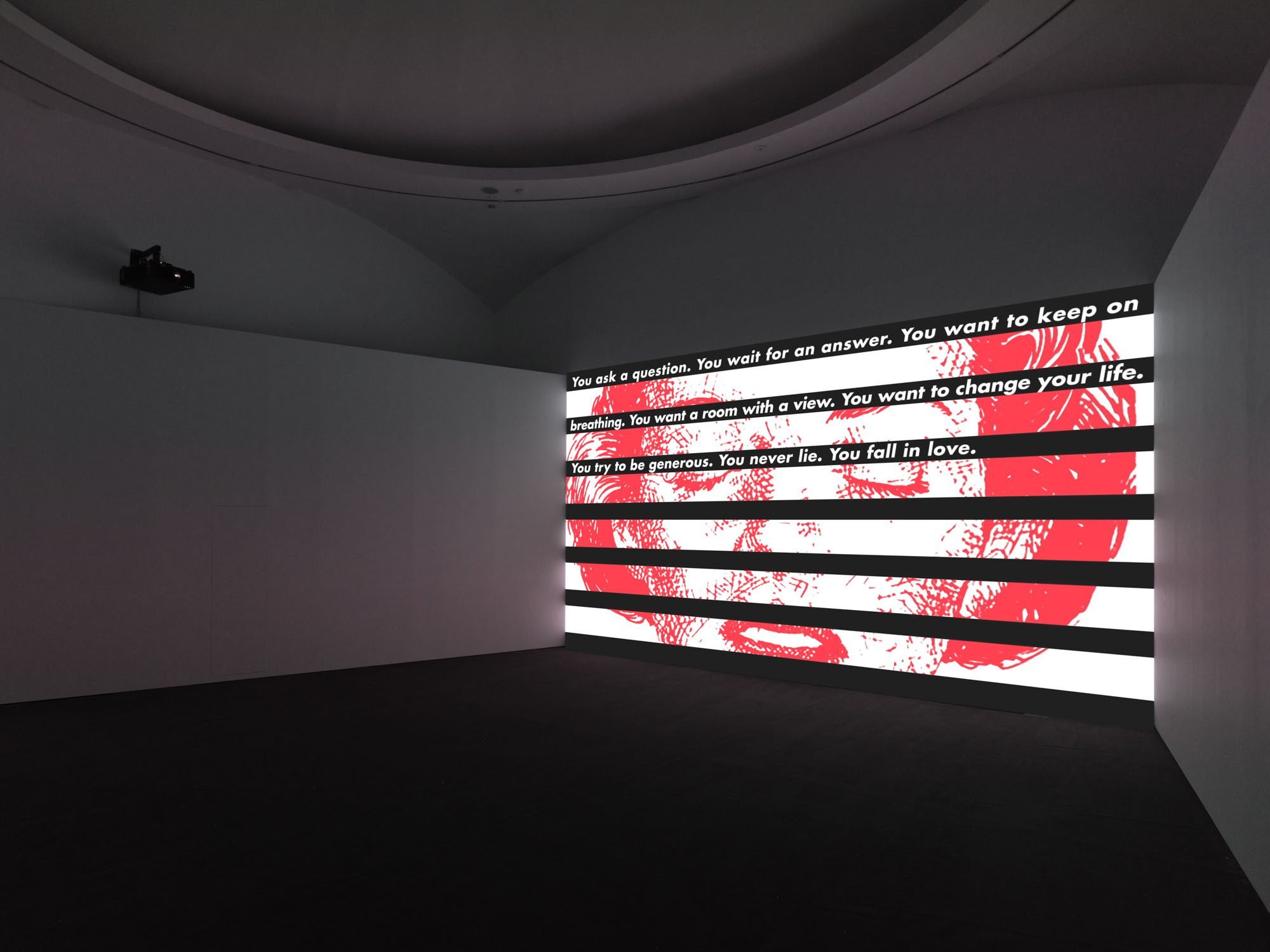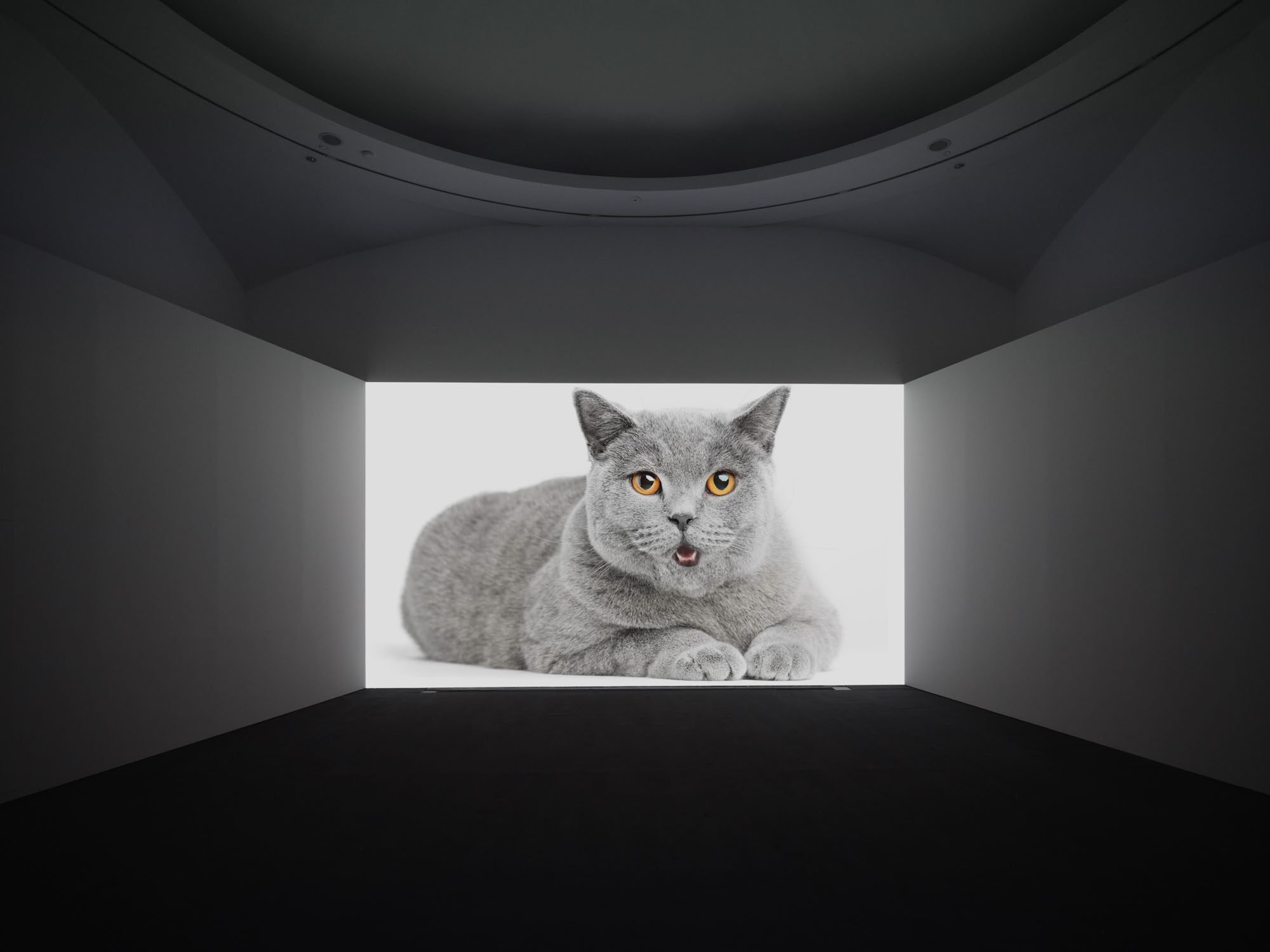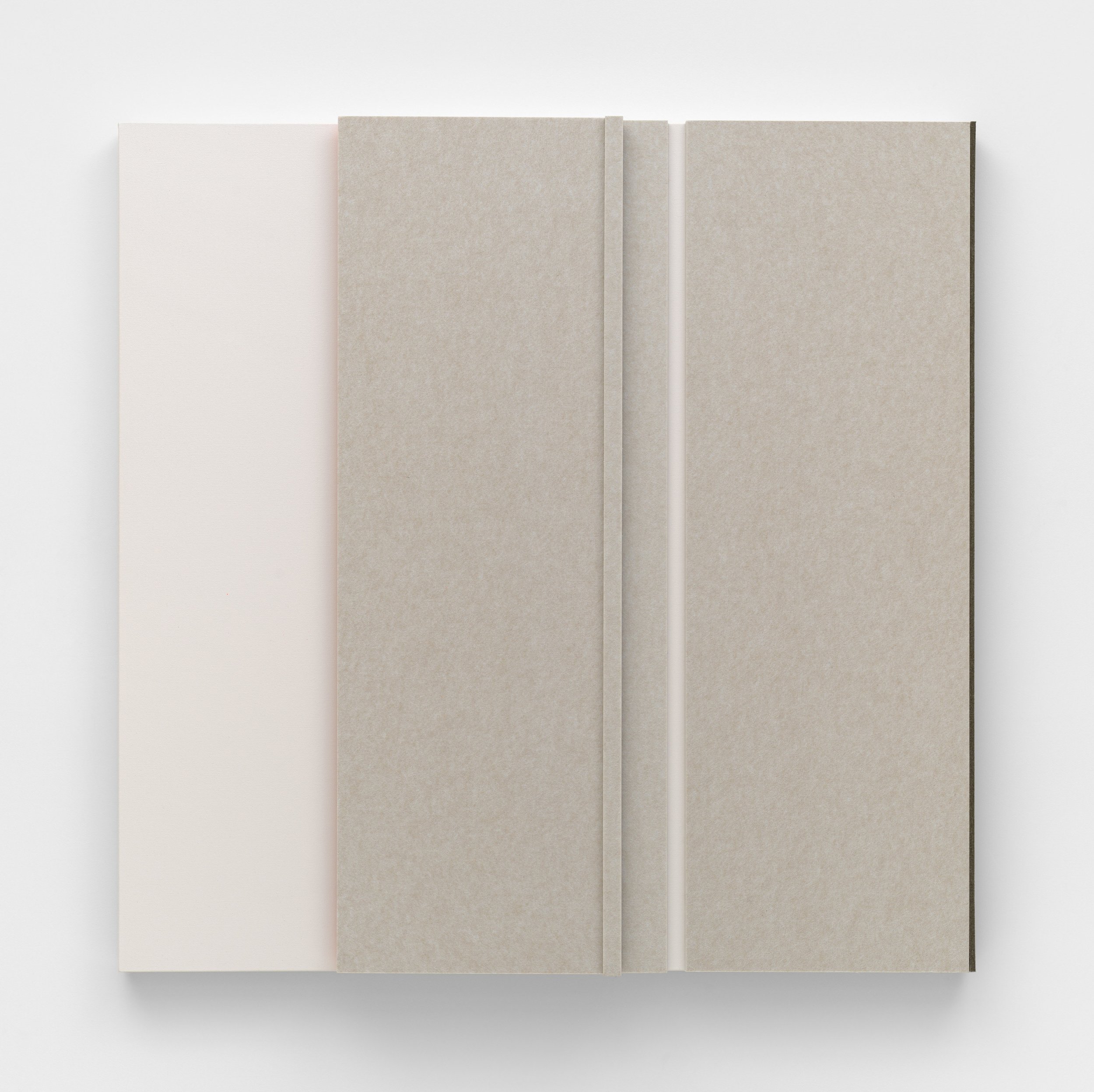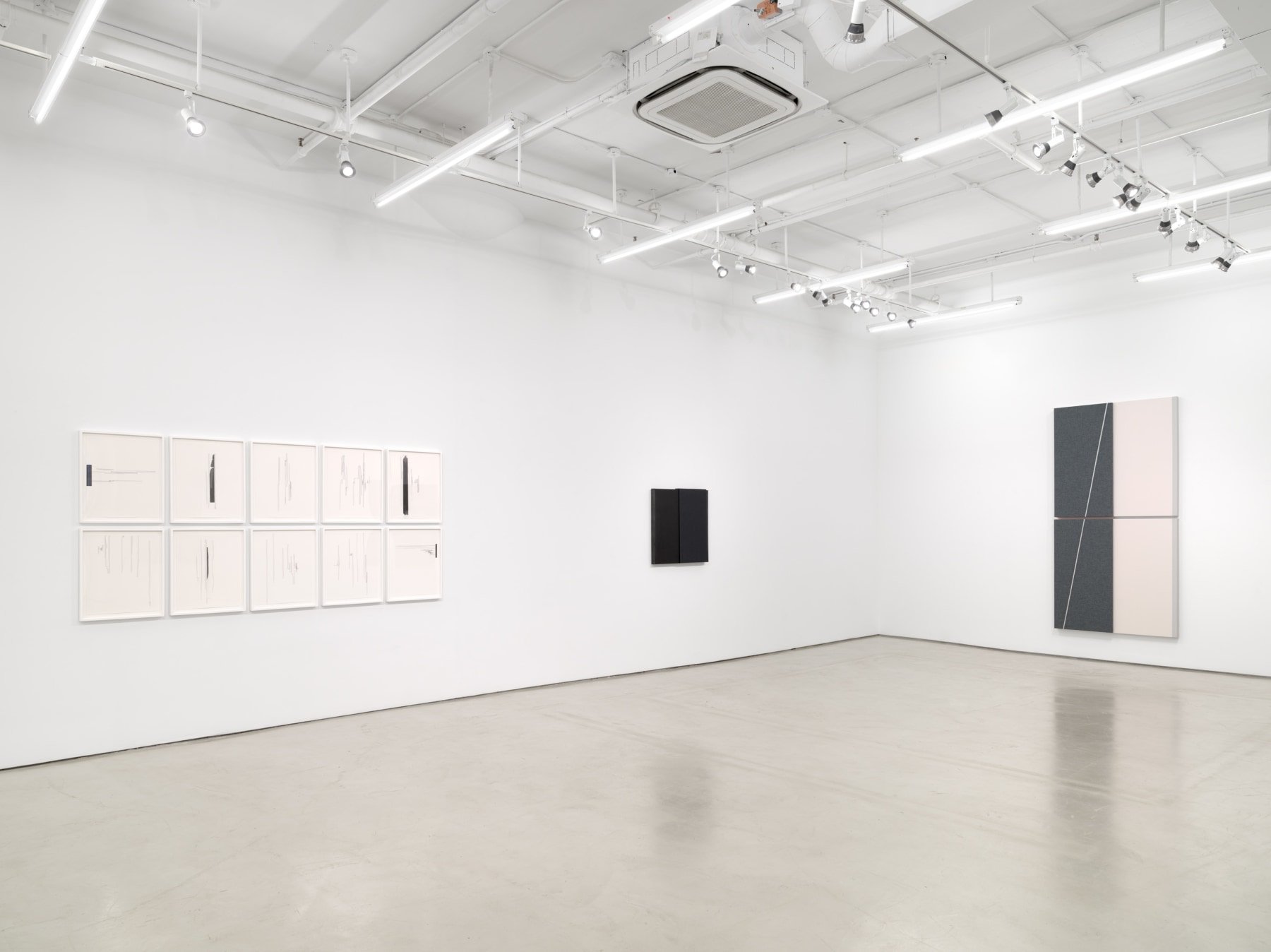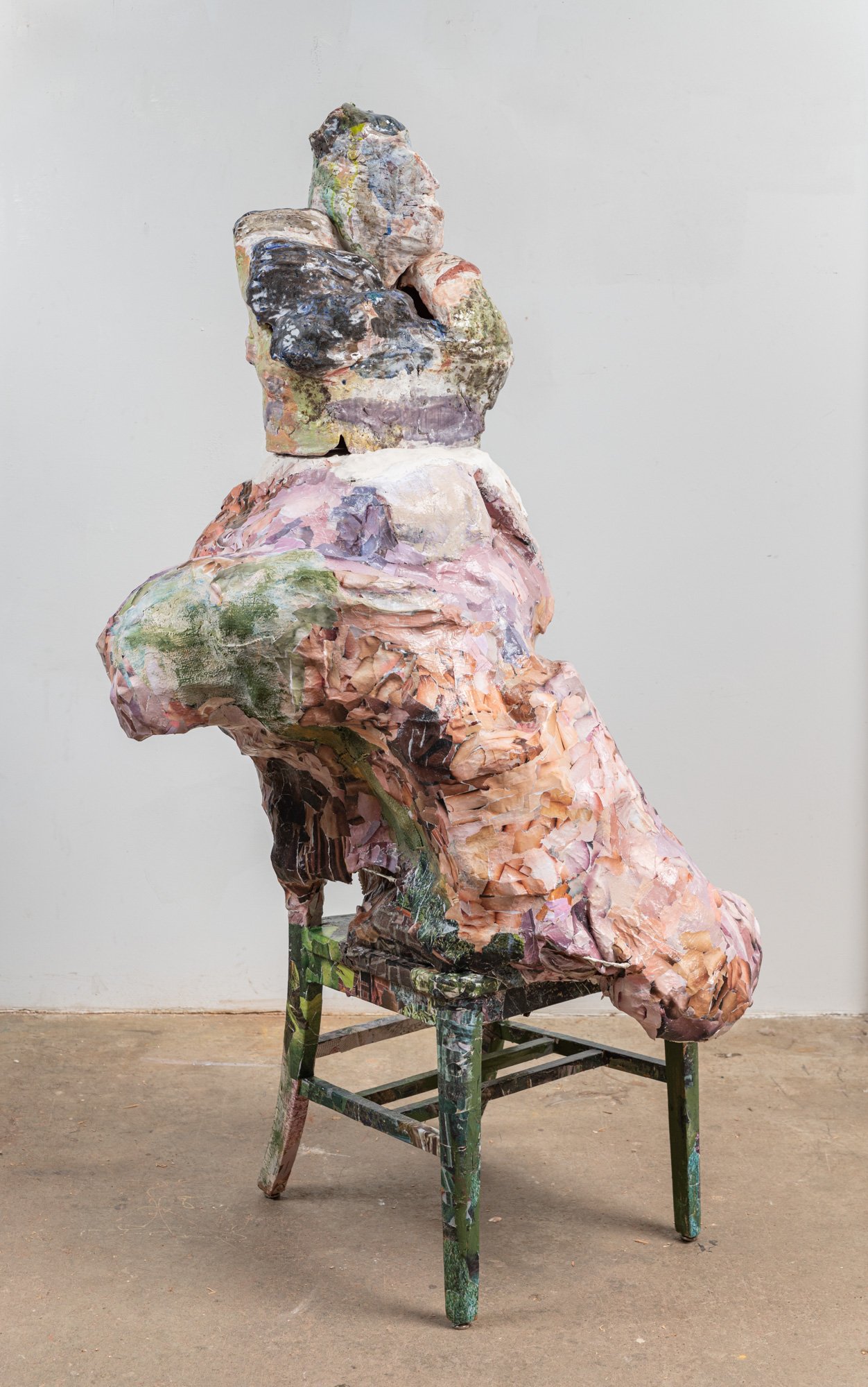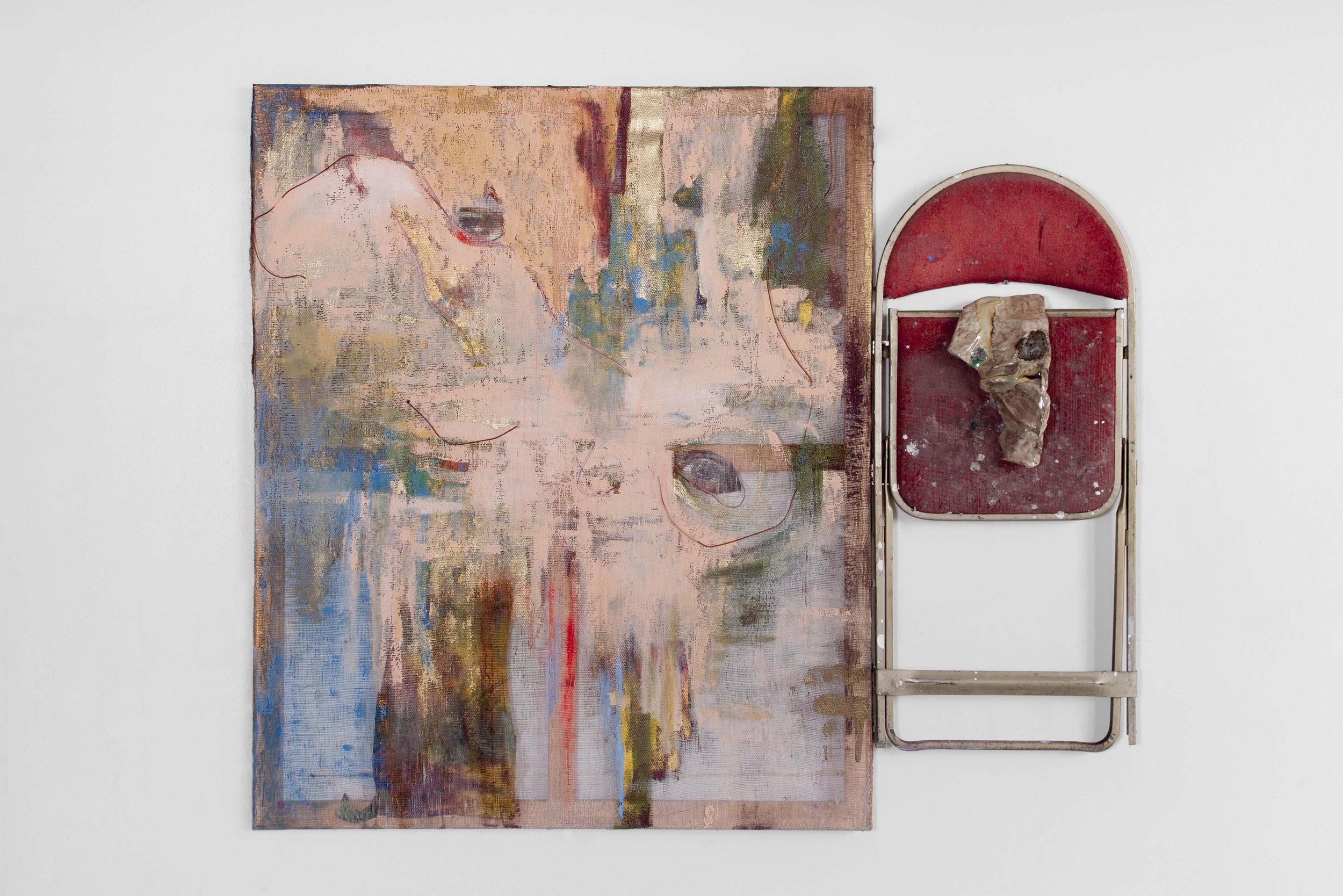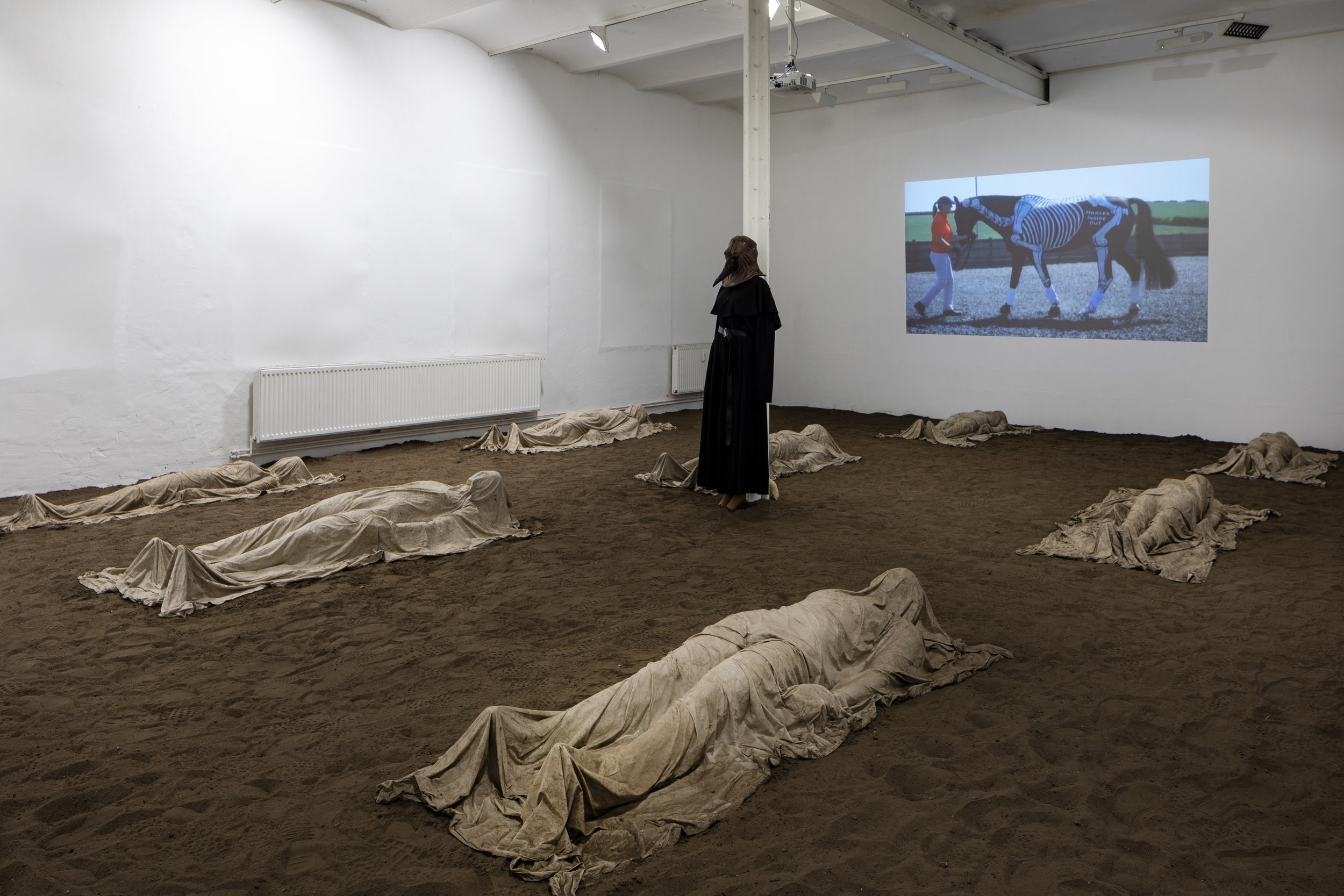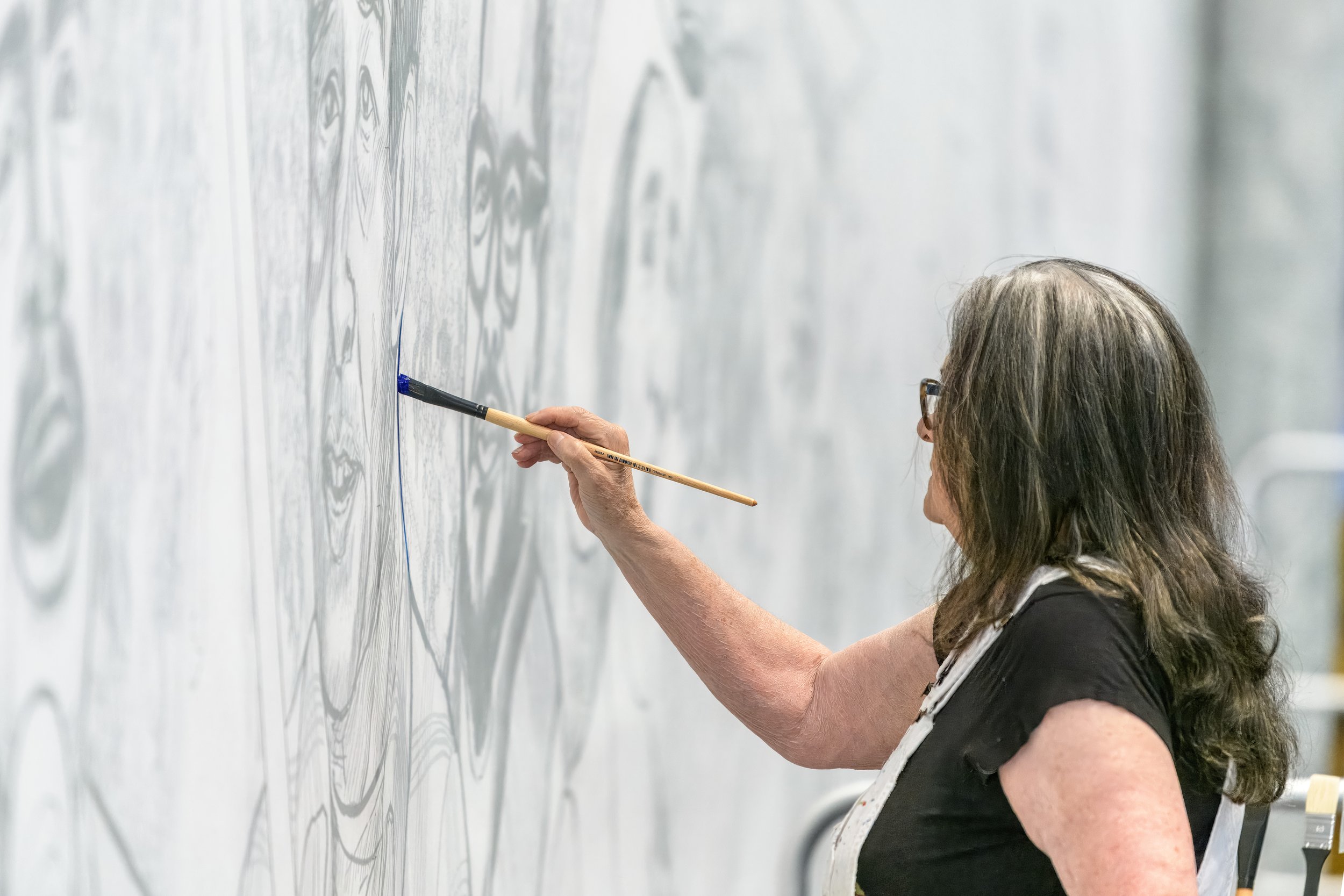Lee Mingwei: Rituals of Care
Our Peaceable Kingdom, 2020–present 40 framed paintings, each 17 3/8 x 23 5/8 in. (44 x 60 cm), easels TKR Installation dimensions variable
Courtesy of Lee Studio Photo Courtesy of Gropius Bau, photo by Laura Fiorio
Inspired by personal experiences and world events, Lee Mingwei (b. 1964) creates interactive installations and performances. Asking how art can encourage social connection and healing in a time of so much trauma and loss, the exhibition features projects made between 1995 and 2024 that place the visitor at the center of radical acts of generosity and care. The Letter Writing Project (1998–present) invites visitors to sit and write a letter they have always meant to send but never did. Guernica in Sand (2006–present), a temporary reinterpretation of Picasso’s famous painting in sand that is then erased, meditates on the cyclical nature of creation and destruction. Transforming ordinary actions like writing, sweeping, mending, or breathing into rituals of care, Lee Mingwei’s works encourage us to find beauty and solace in the small acts that define everyday life.
In-depth
Conceived in 1995 as part of Lee Mingwei’s graduate school application, 100 Days with Lily anticipated several themes of his practice since: the creation of interactive experiences that encourage social connection and care. Five photographs of the artist engaged in mundane activities with a planted lily are overlaid with 100 lines of text, 20 per photograph, describing how he incorporated the flower into his daily routine as a memorial for his maternal grandmother.
The Letter Writing Project, 1998-present Mixed media interactive installation Wooden booth, writing paper, envelopes 3 pieces, 290 x 170 x 231 cm each Photo Courtesy of Mori Art Museum, photo by Yoshitsugu Fuminari
The Letter Writing Project (1998–present) arose from the artist’s need to continue communication with his maternal grandmother after her death. Visitors are invited to sit and write the letter they have always meant to send but never took the time to write. Lee Mingwei leaves it up to each person whether to address their letter and have the Museums mail it or leave it unsealed for other visitors to read.
The Mending Project, 2009–present Table, two chairs, spools of thread, and fabric items provided by visitors, dimensions variable Collection of Rudy Tseng Photo Courtesy of Mori Art Museum, photo by Yoshitsugu Fuminari
In The Mending Project (2009–present), Lee Mingwei uses the simple act of sewing as a means to connect and share an experience. Visitors are invited to bring items of clothing in need of repair that Lee Mingwei or his designated host will mend and embellish. The mending is done with the idea of celebrating and commemorating the act of repair. This conscious embrace and highlighting of the fabric’s scar(s) speaks to the emotional work of mending as a means to deal with trauma and loss. Select garments will be chosen and added to a growing installation of items connected by thread to spools on the wall.
In Sonic Blossom (2013–present), a singer approaches visitors with the offer of a song selected from the Schubert lieder (songs written for one voice). Lee Mingwei listened to this music with his mother while caring for her after heart surgery in 2012. If a visitor accepts this offer of beauty and solace, the singer then serenades them with a song of their choice.
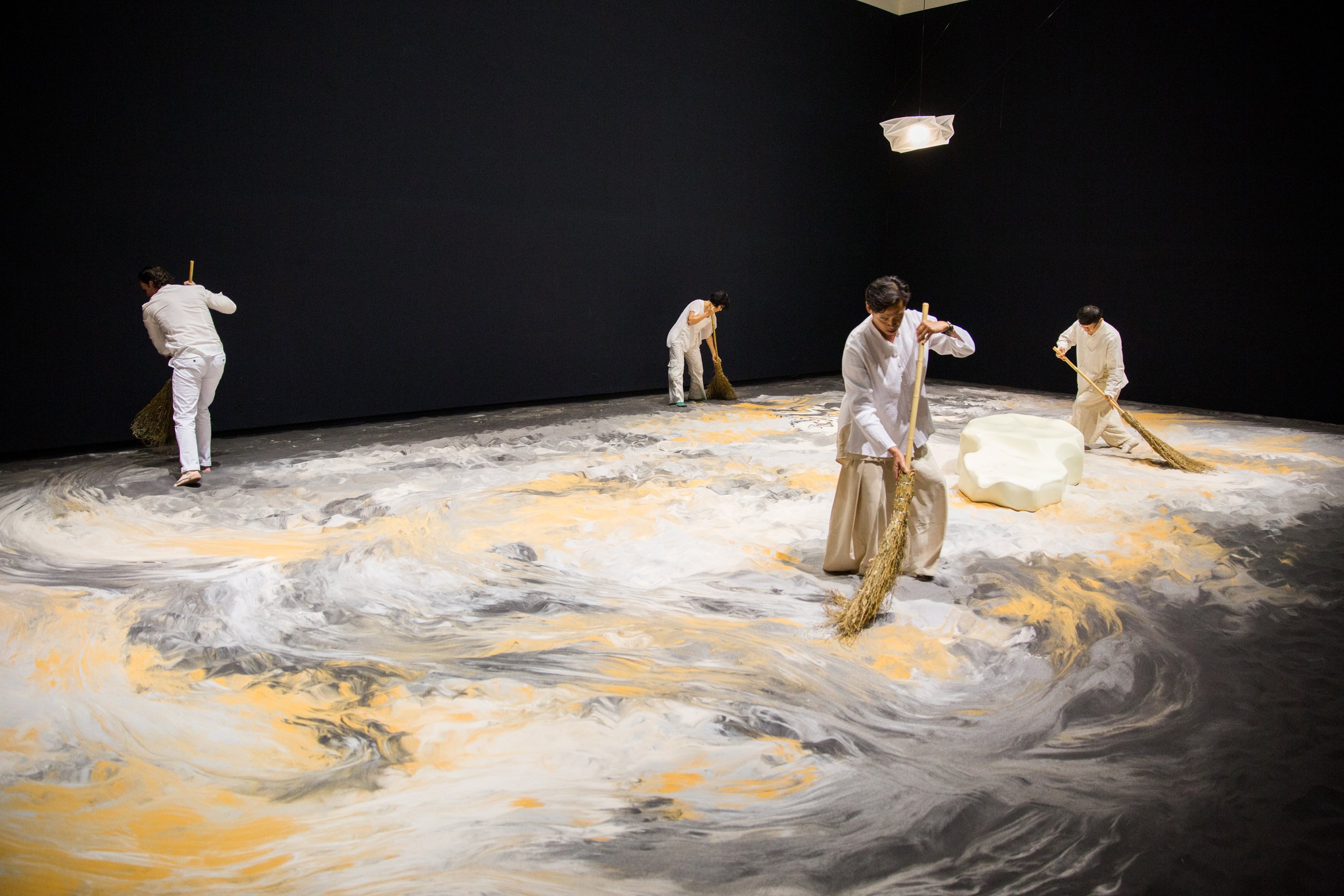
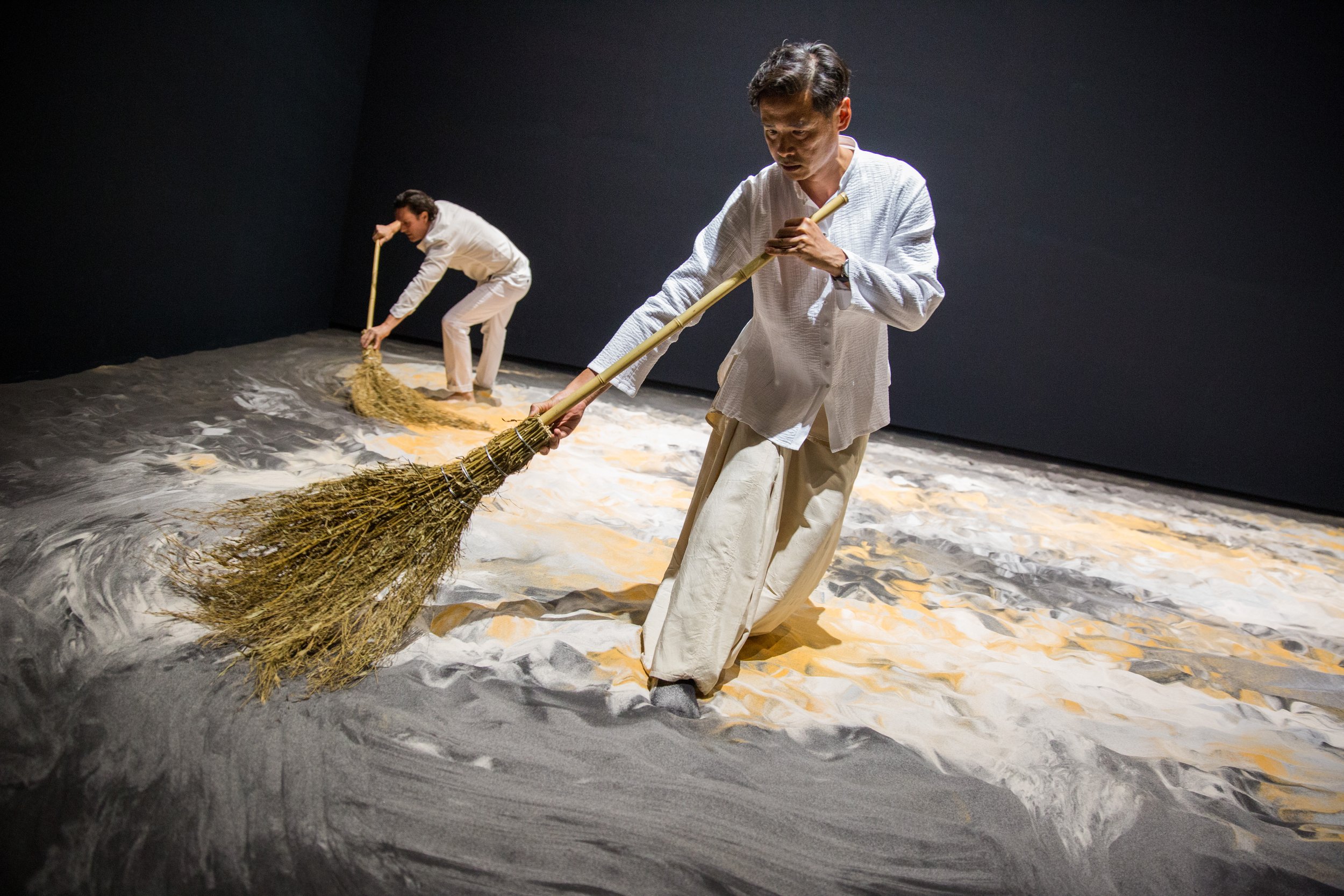
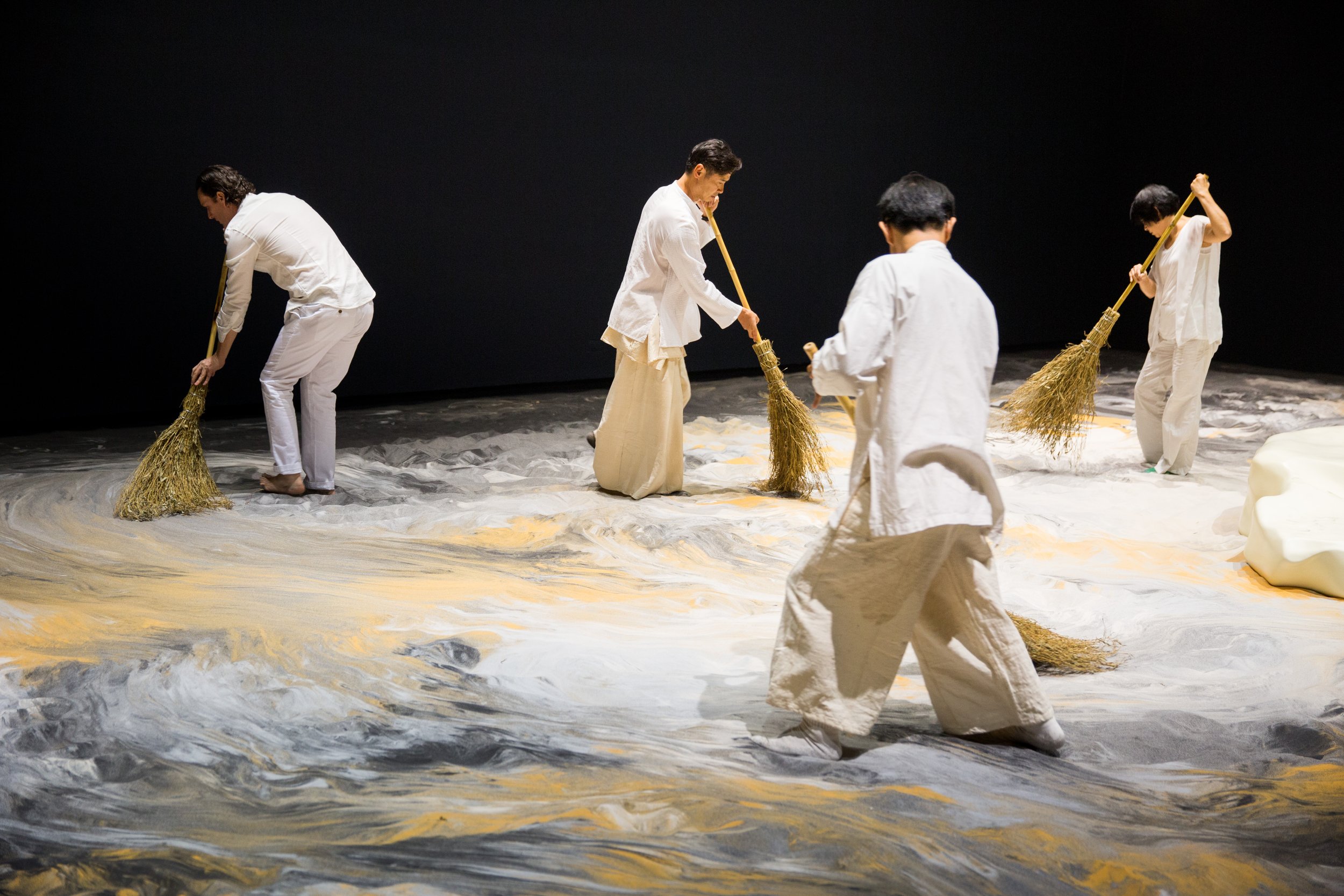
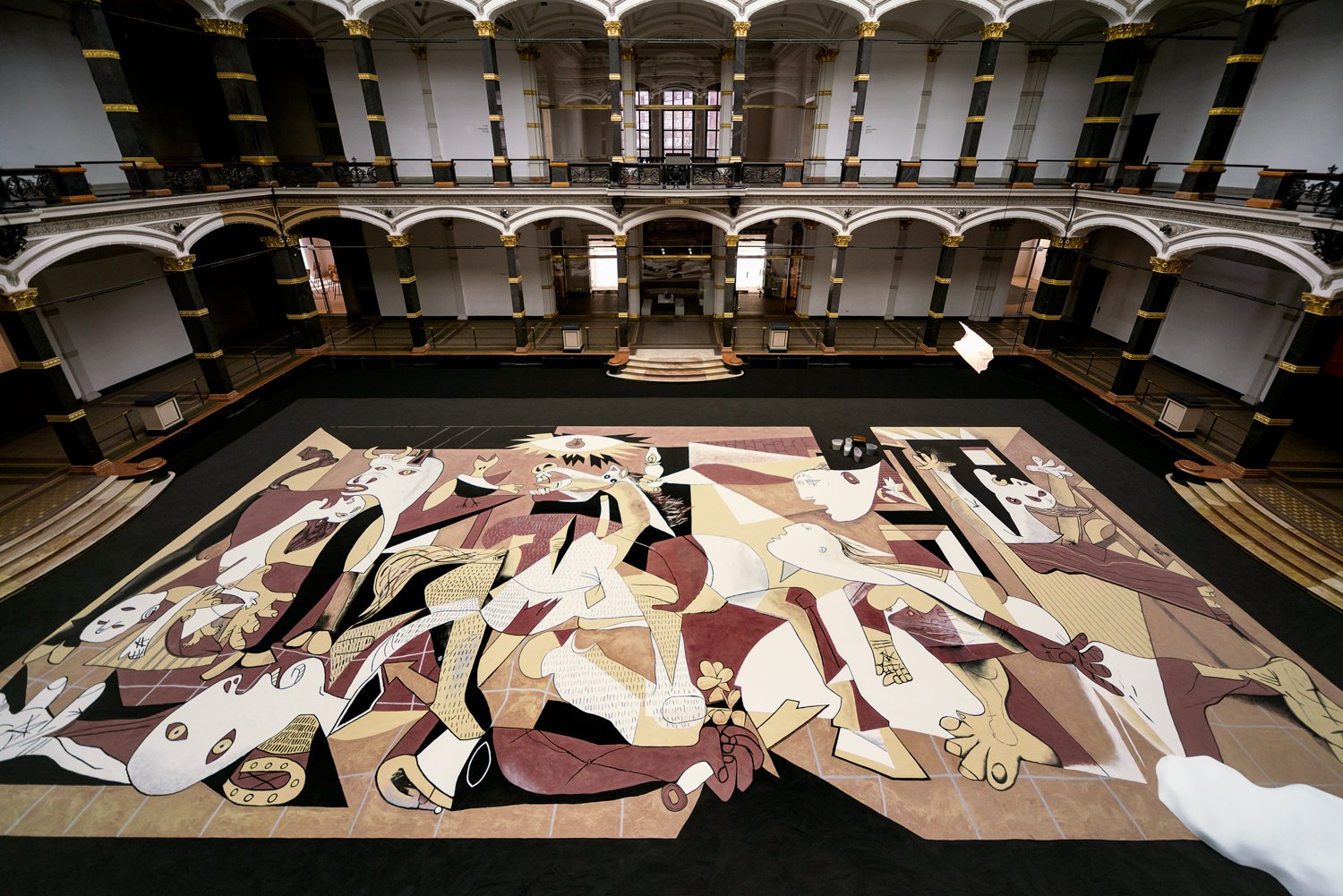
Guernica in Sand, 2006-present Mixed media interactive installation Sand, wooden island, lighting 1300 x 643 cm
Photo Courtesy of Taipei Fine Arts Museum
During the Iraq War, Lee Mingwei revisited Pablo Picasso’s iconic painting Guernica (1937). The experience resulted in the work Guernica in Sand (2006–present): a sand painting that partially recreates Picasso’s original. A meditation on impermanence and transformation, the work will be both completed and erased in a performance in March, and left in an unrecognizable state for another week. The work points toward both the weight of history and the persistence of hope through change.
Our Peaceable Kingdom (2020–present) unites a group of paintings that reinterpret the 1833 painting by Edward Hicks in the collection of the Worcester Museum of Art in Massachusetts. It is one of 62 works bearing the title Peaceable Kingdom that Hicks created between 1820 and 1849, a version of which is in our collection and on view at the de Young. Based on an Isaian prophecy appealing to Hick’s Quaker beliefs, it depicts animals, children, Lenape, and Quakers peacefully coexisting. Lee Mingwei invited 11 artists to reinterpret Hicks’s painting, then asked each to choose two other artists to do the same, thus creating “a family tree of copies with multiple descendants.” For the de Young, he asked artist Chelsea Ryoko Wong to create her version of peace; she in turn invited Emily Fromm and Emilio Villalba.
Chaque souffle une danse (Each Breath a Dance, 2024) reflects on the physical and social threats that the simple act of breathing has come to embody since the onset of the COVID-19 pandemic and George Floyd’s murder. For this artwork, Lee Mingwei concluded his daily meditation practice by placing a few droplets of sumi ink on an alabaster slate as the sun set, spreading the ink over the surface with several contemplative breaths. This work will be presented at the de Young as a video beginning in April, as well as a physical installation at Minnesota Street Project.
The exhibition opened on February 17th, 2024 and will conclude on July 7th of, 2024. Also Rituals of Care the catalogue can be purchased here. For more information about this exhibition and others at de Young/Legion of Honor and the fine arts museums of San Francisco, please visit here. The museum can also be found on Instagram, on Facebook, and YouTube.
.
Refik Anadol: Echoes of the Earth: Living Archive
Refik Anadol, Artificial Realities: Coral, 2023. Courtesy Refik Anadol Studios
Serpentine is thrilled to present Echoes of the Earth: Living Archive, an exhibition of new and recent works by internationally renowned artist, technologist, and pioneer in artificial intelligence arts, Refik Anadol.. Anadol, a pioneer in AI Arts presented his largest institutional solo exhibition in the UK, featuring new and recent works which opened on February 16th and will end on April 7th 2024.
Known for his digital works and large-scale public installations that present real-time generative environments, Anadol’s collaborative creative process with AI plays on human perception. Echoes of the Earth: Living Archive presents years-long experimentation with visual data of underwater landscapes and rainforests.
Refik Anadol, Artificial Realities: Coral, 2023. Courtesy Refik Anadol Studios
The exhibition features Artificial Realities: Coral (2023), an immersive installation enveloping viewers in an AI's imagination of underwater landscapes. For this artwork, Refik Anadol Studio trained a unique AI model with approximately 135 million images of corals openly accessible online. Generating abstracted coral images, the AI constructs new visuals and colour combinations based on the dataset.
Anadol’s solo exhibition also features the UK premiere of Living Archive: Large NatureModel a new site-specific installation which was first introduced at the World Economic Forum 2024 in Davos, Switzerland. At Serpentine North, the installation transforms the gallery into the AI model’s interpretation of a rainforest. It is the first installation in a growing body of work that is created employing The Large Nature Model, the world’s first open- source generative AI model dedicated to nature. For this ongoing research, the artist worked with the data of major institutions, including the Smithsonian Institution and London’s Natural History Museum. As additional data partners, such as universities, museums, foundations, government entities and libraries join the effort, the model, centred around archival images of fauna, flora and fungi, will expand over the coming years.
Refik Anadol said: “I am thrilled to bring our Studio's most ambitious AI Art projects to date to Serpentine this year. A ground-breaking initiative that we call the Large Nature Model, developed by our Studio, stands as the world’s first open-source, generative AI multimodal focused on nature, trained on an extensive and ethically sourced dataset of the natural world. Echoes of the Earth: Living Archive displays multisensory artworks derived from this model, featuring visuals and sound. Collaborating on such a significant project with my long-time mentor, Hans Ulrich Obrist, with whom I've shared many stages discussing the future of AI art, is an immense privilege.”
Refik Anadol, Echoes of the Earth: Living Archive, 2024. Installation view, Serpentine North. Photo: Hugo Glendinning. Courtesy Refik Anadol Studio and Serpentine.
Bettina Korek, CEO, and Hans Ulrich Obrist, Artistic Director, Serpentine, said: “Refik Anadol brings art, science and technology together to create generative, immersive environments that fascinate, educate and enchant audiences. This show kicks off a year of research and projects by the Serpentine Arts Technologies department focused on AI, and we could not be more pleased than to collaborate with him.”
Taking the data that surrounds us as primary material, and using a neural network, amethod of AI that is inspired by the human brain, as a collaborator, Anadol creates compelling visualisations of our digitised memories and expands the possibilities of interdisciplinary arts. His work explores the meaning of humanity in the era of artificial intelligence as well as the challenges that ubiquitous computing has brought forth. He investigates the profound ways in which the dominance of technology in our daily lives alters our perception and experience of time and space.
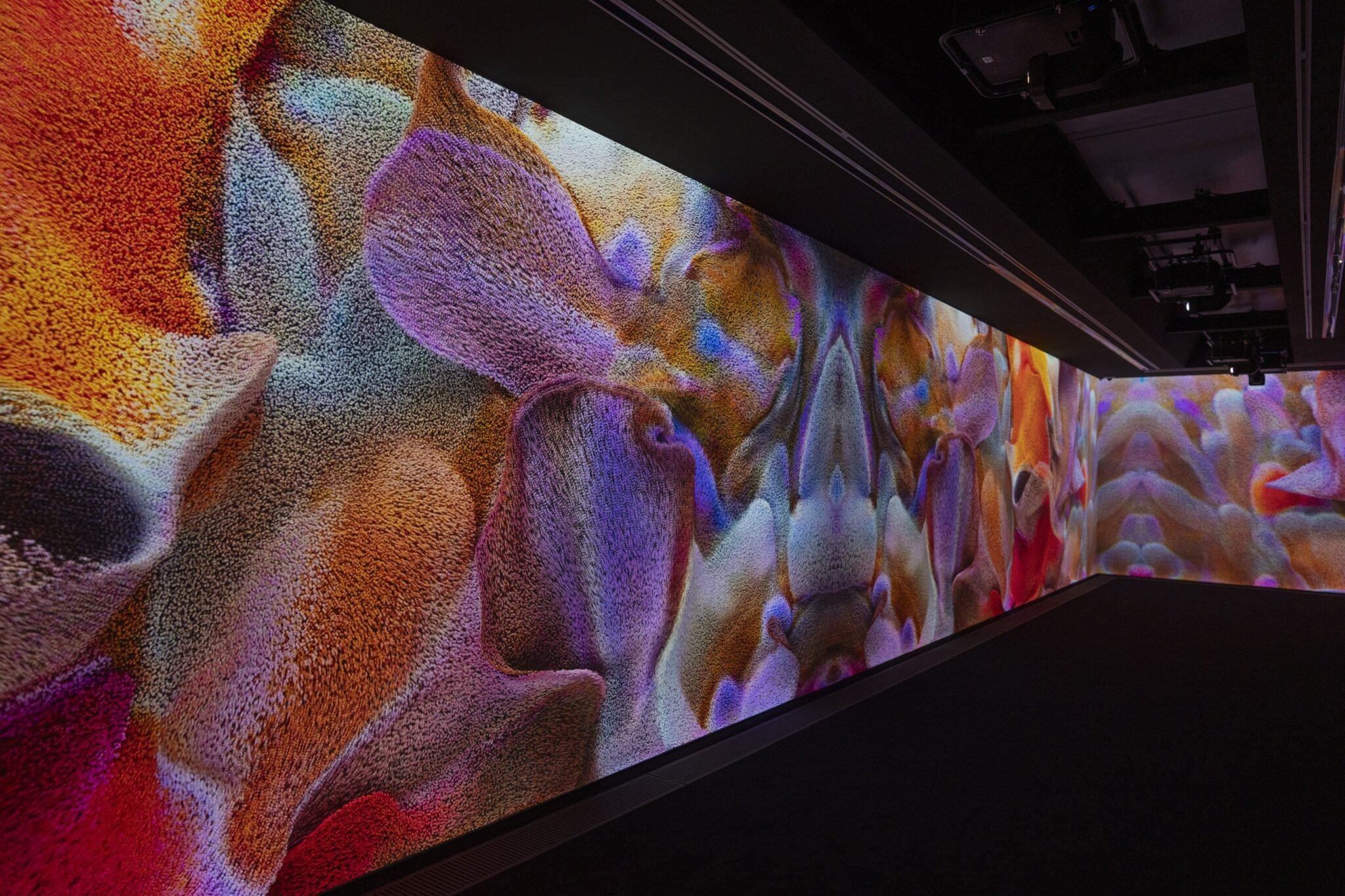
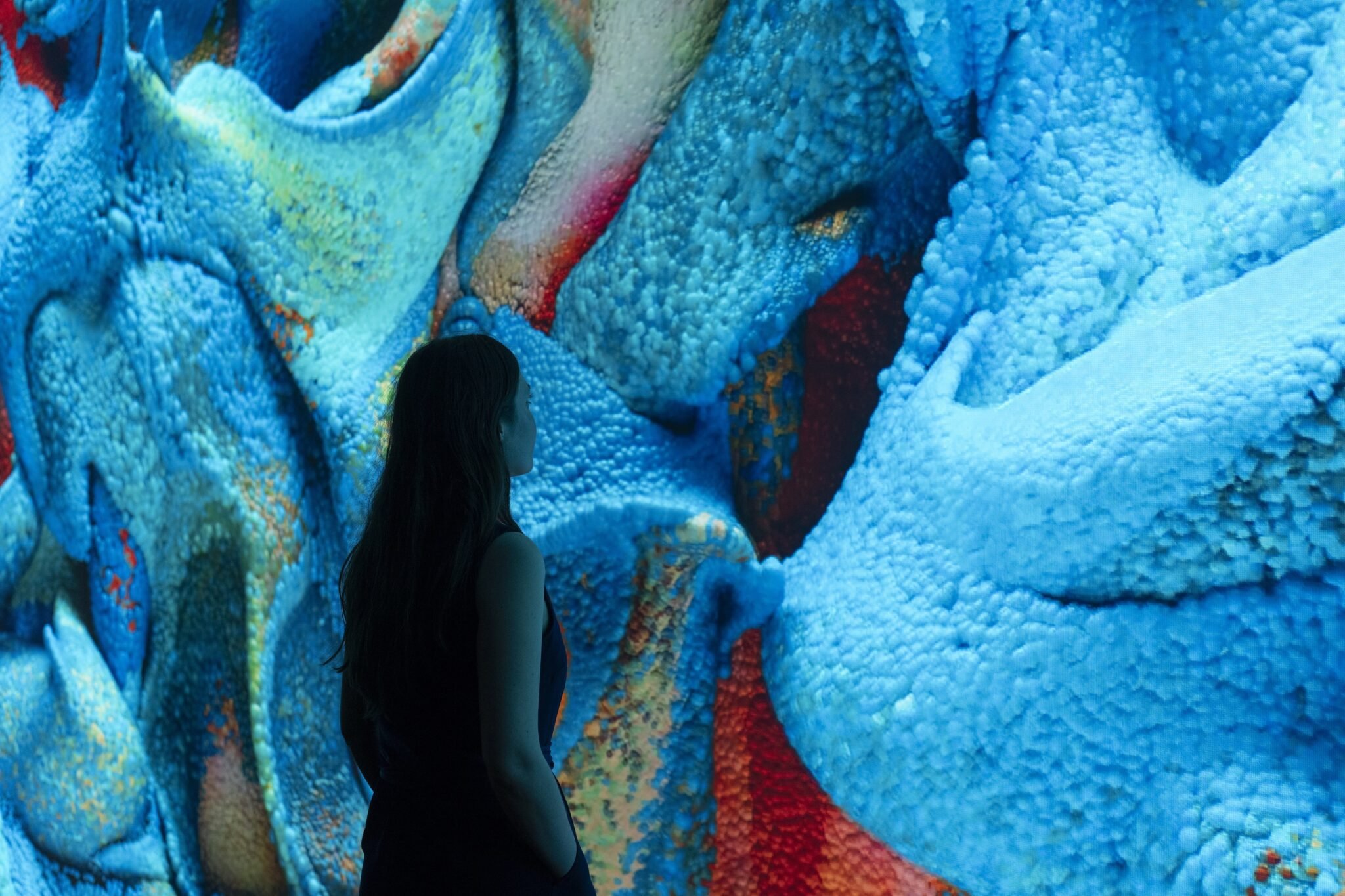
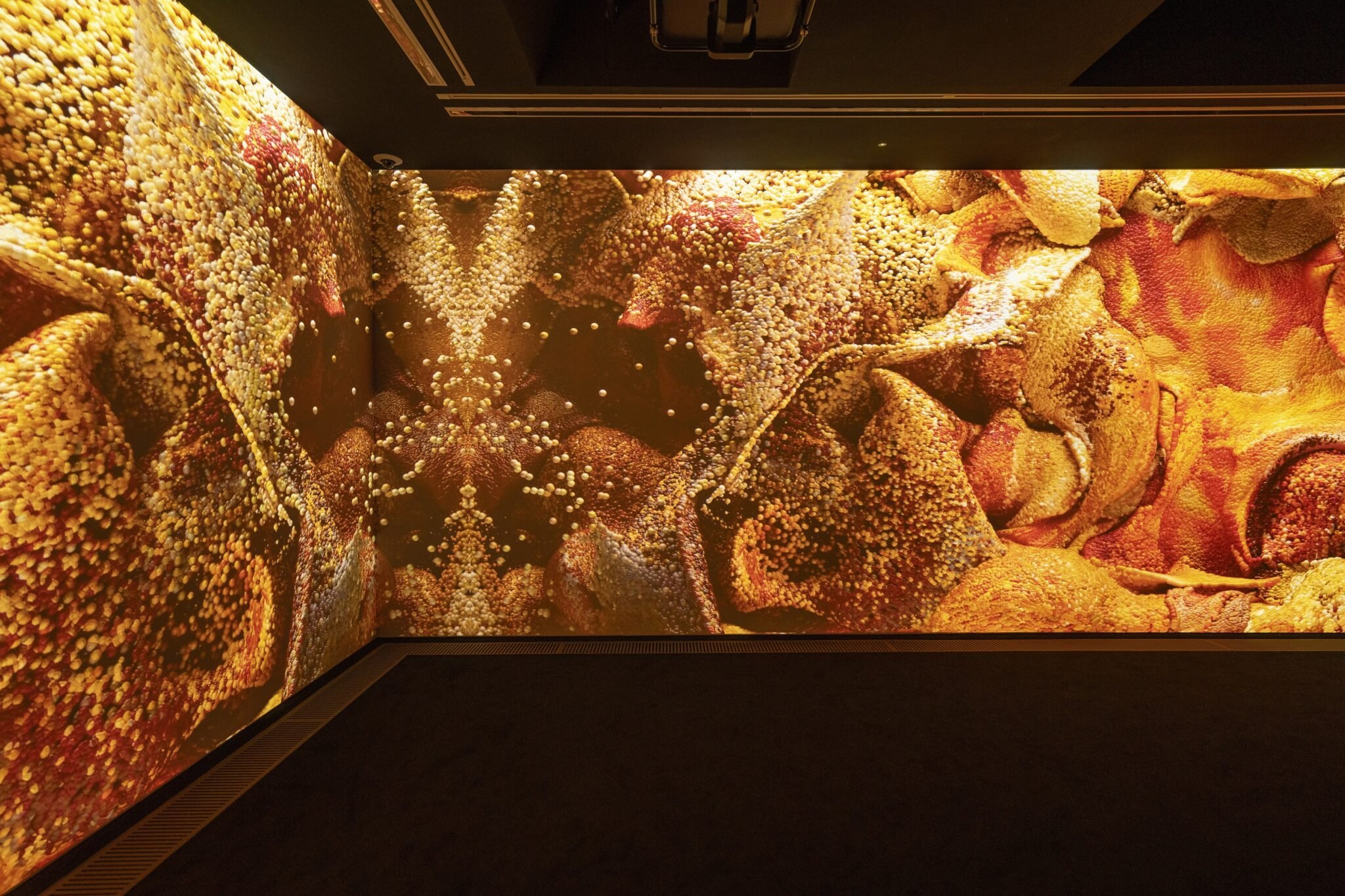
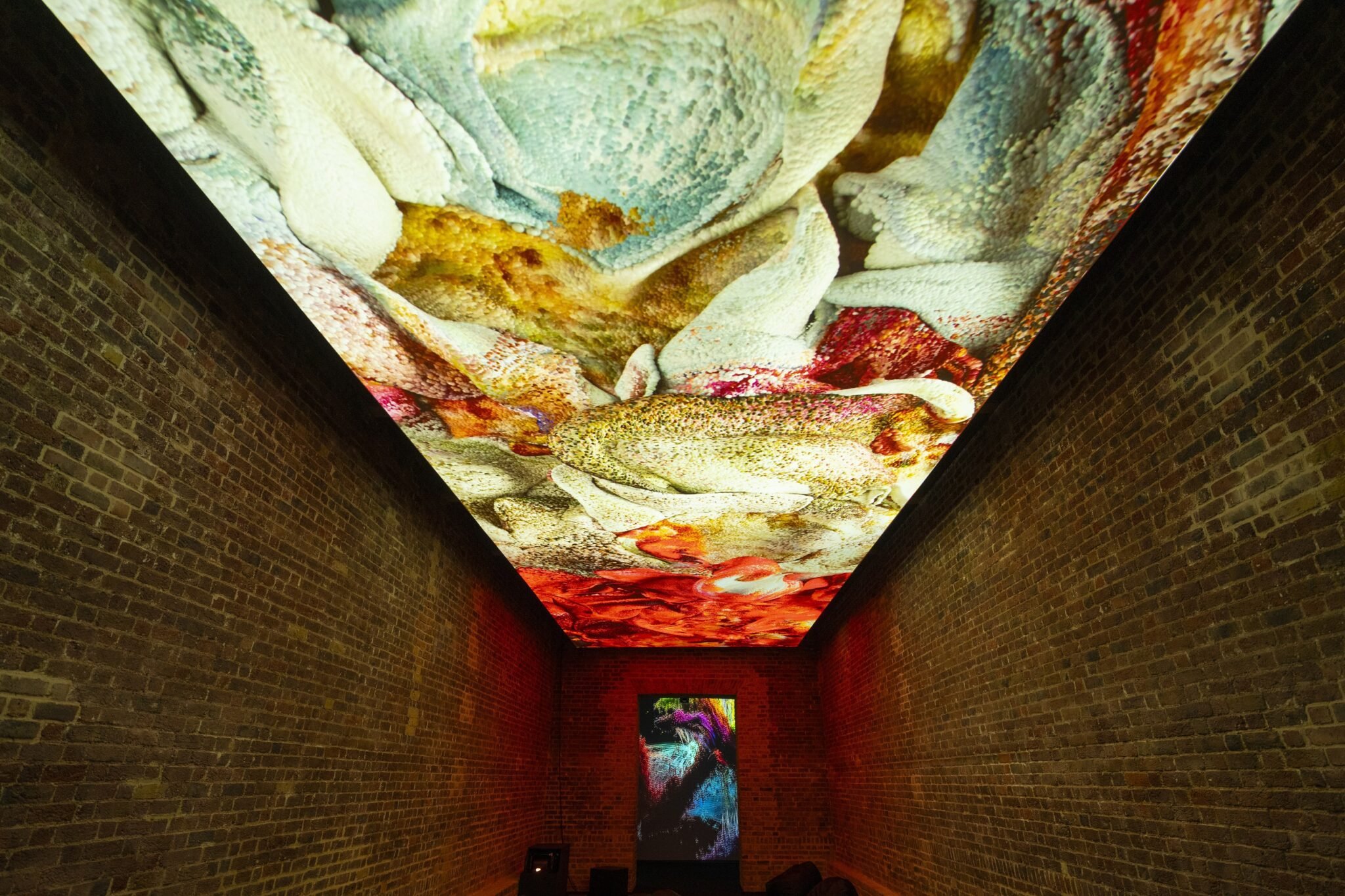
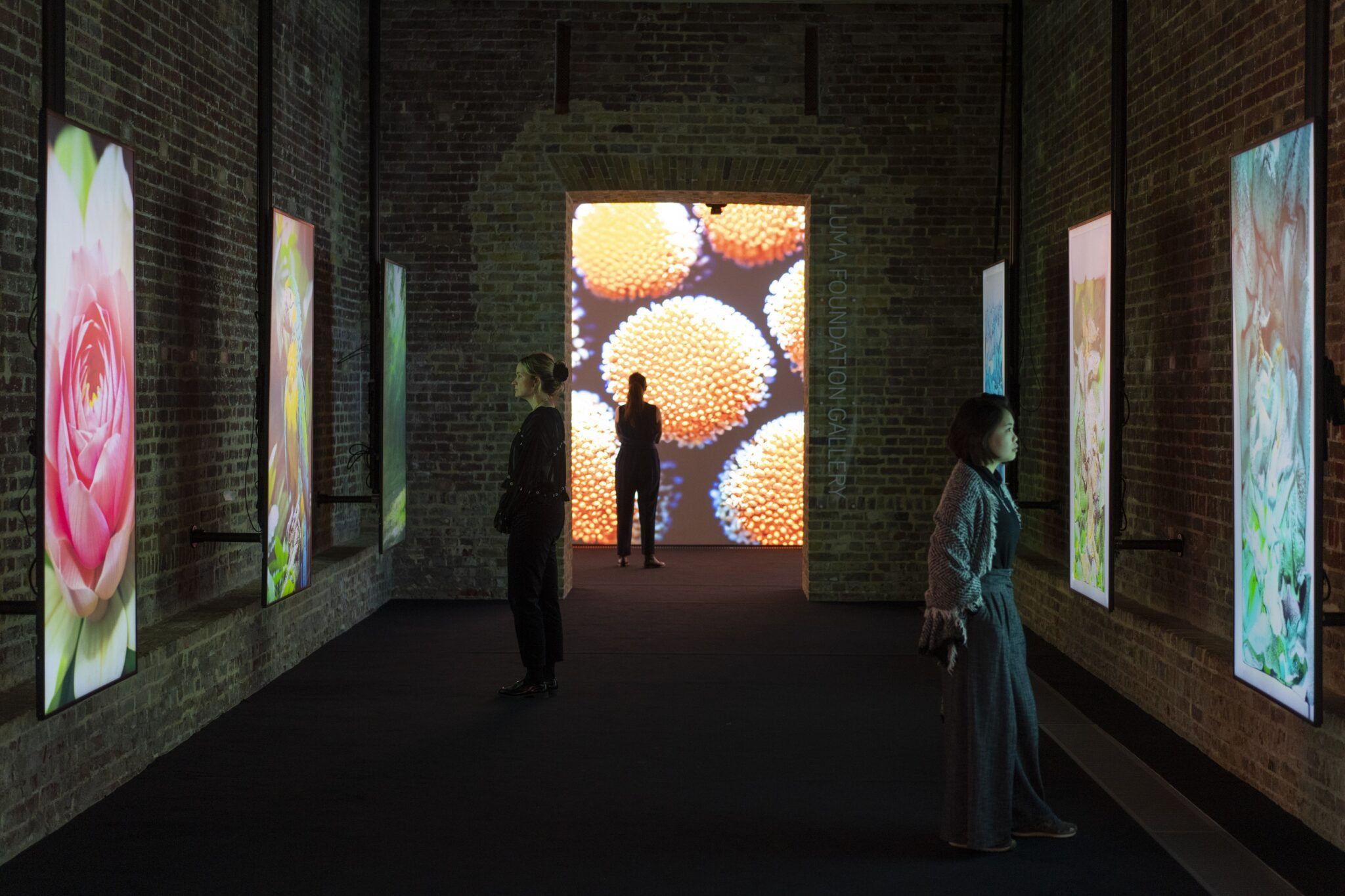

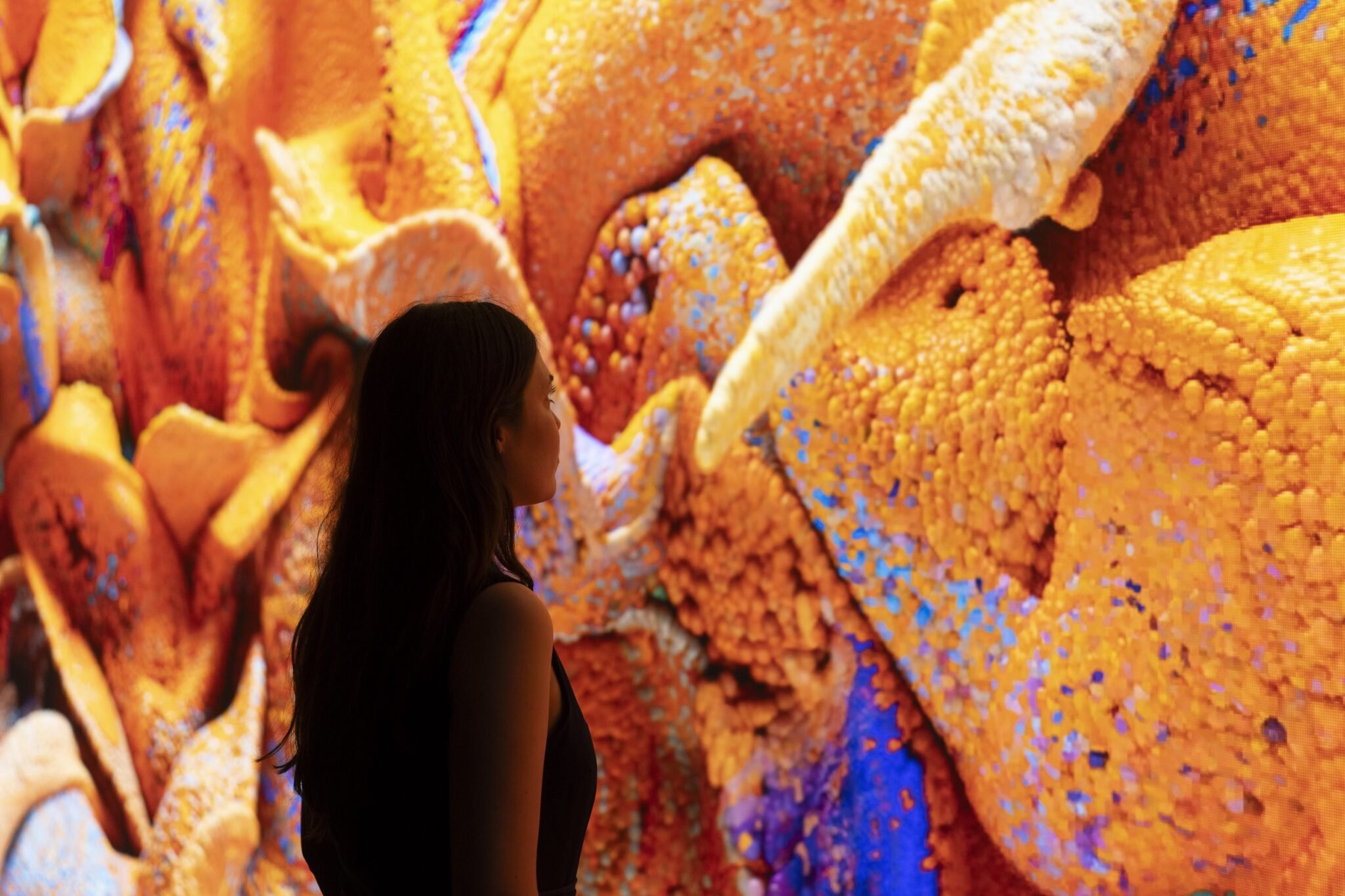
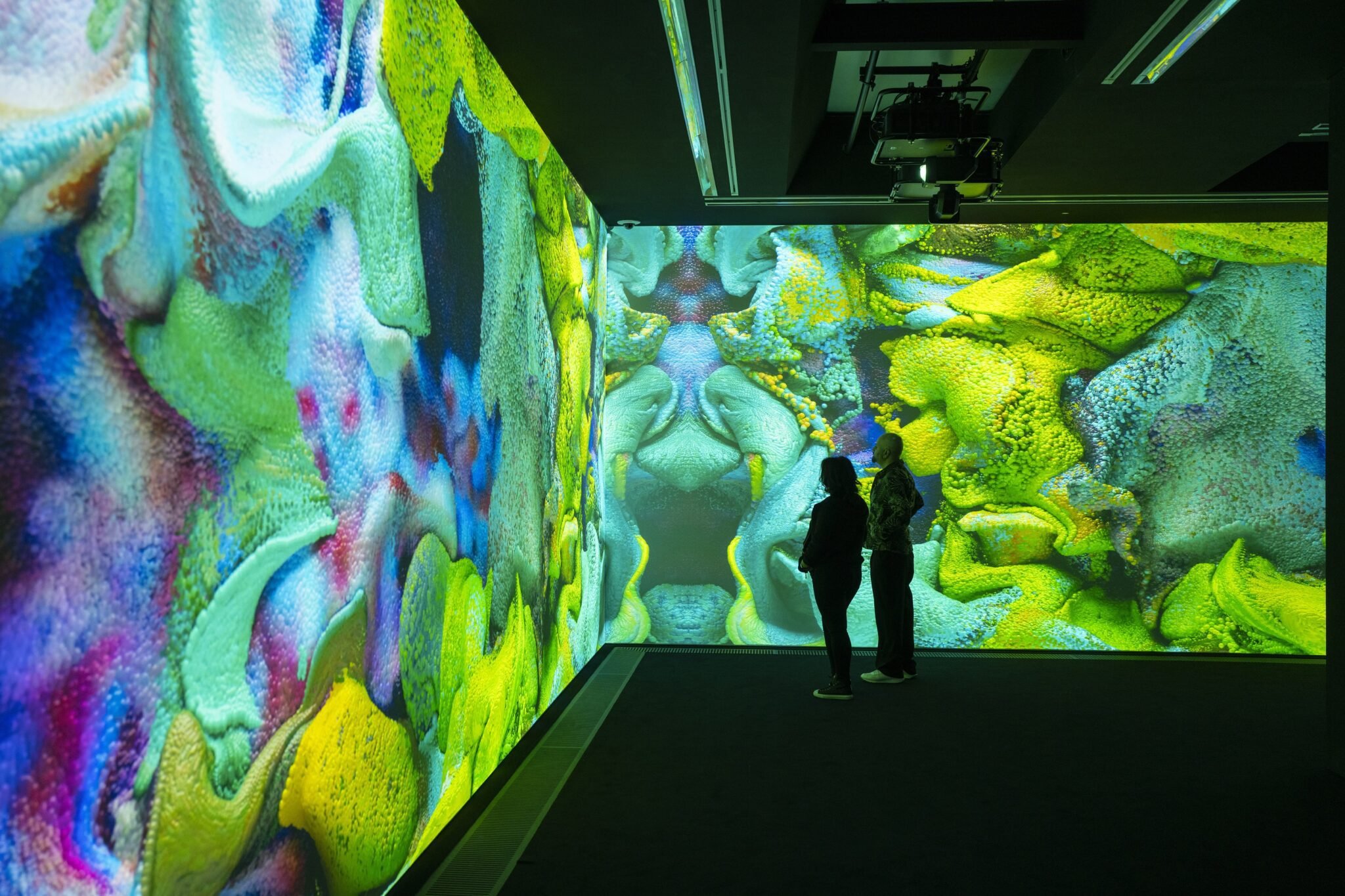
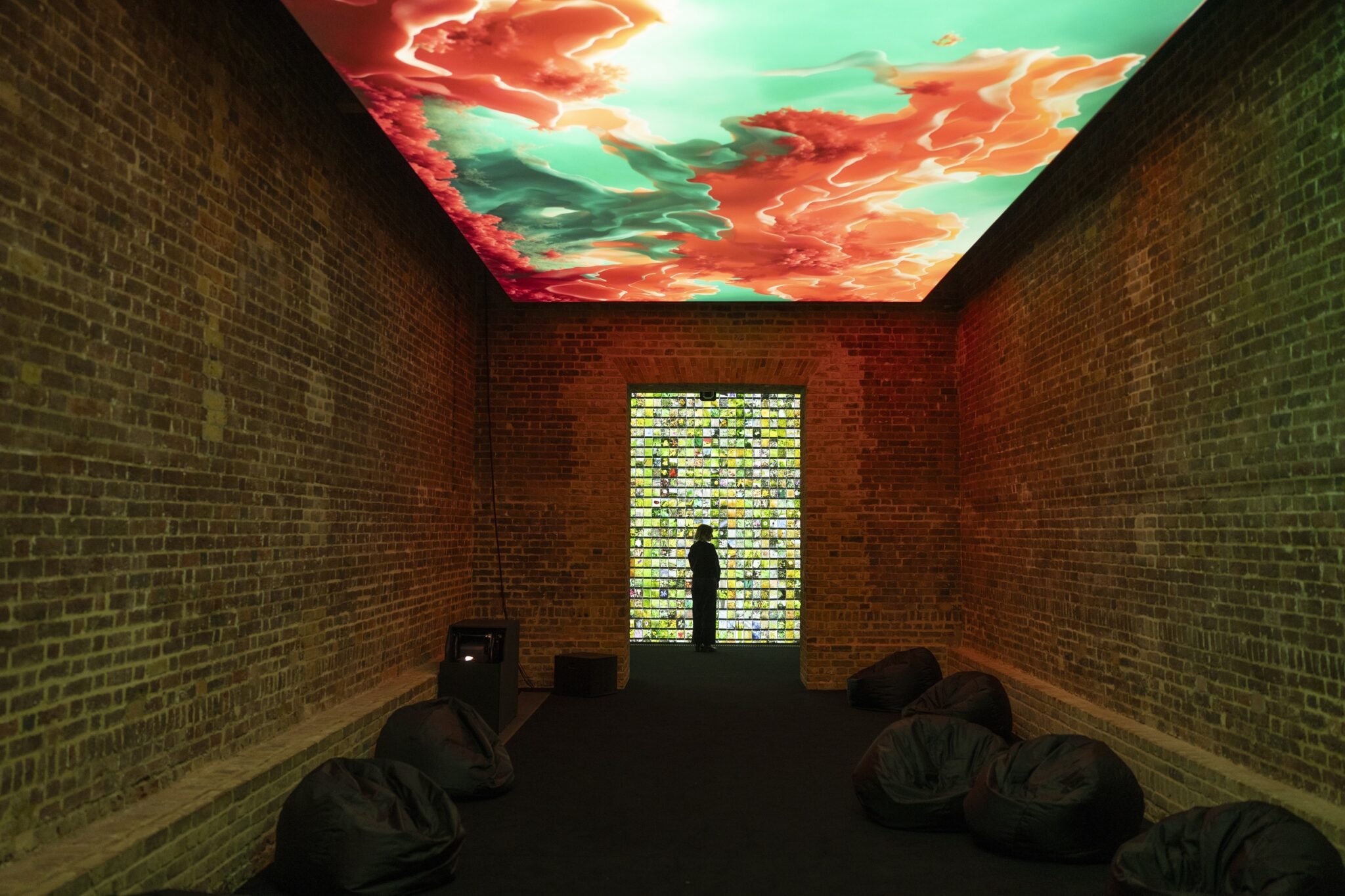
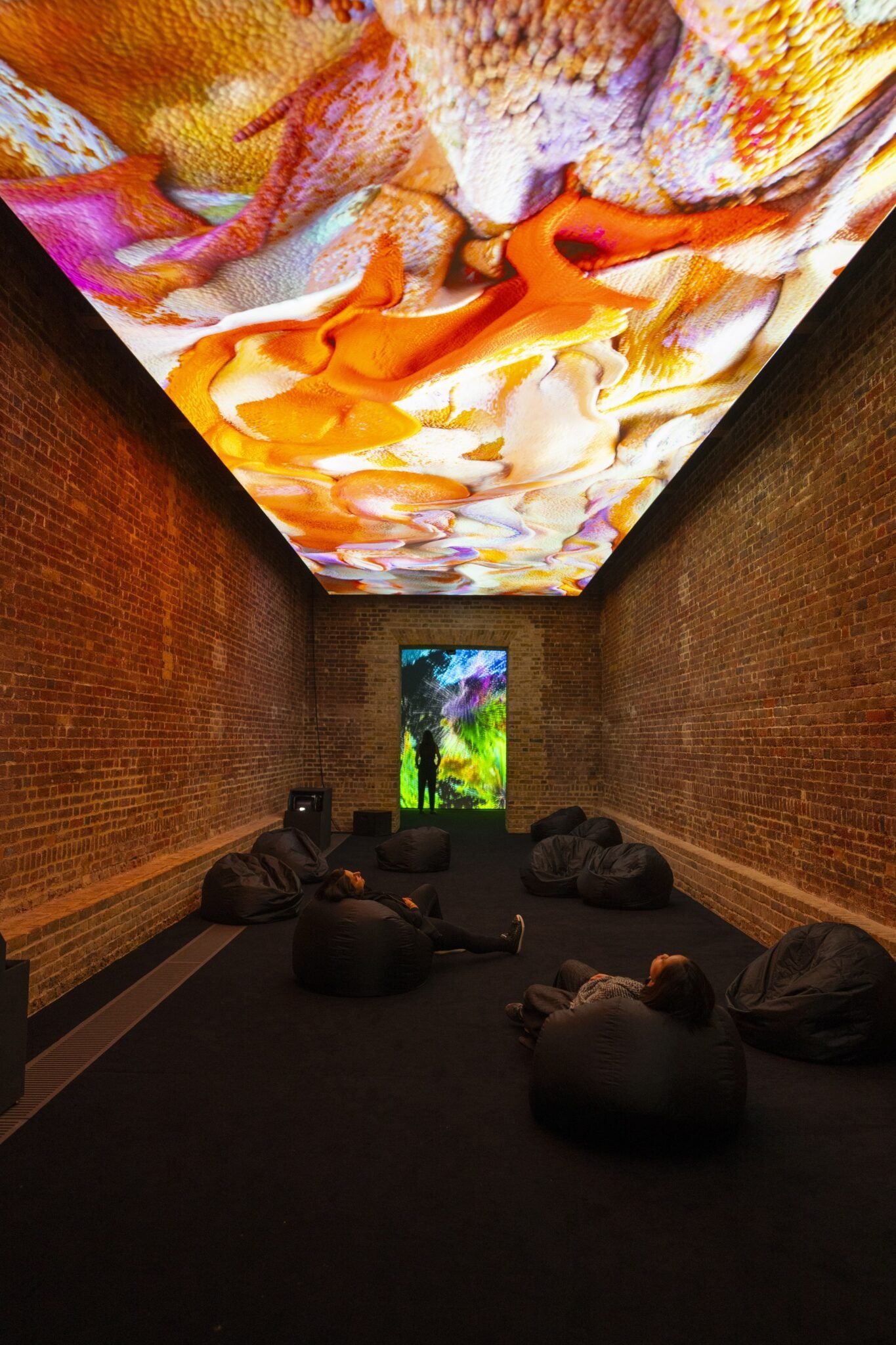
Refik Anadol, Echoes of the Earth: Living Archive, 2024. Installation view, Serpentine North. Photo: Hugo Glendinning. Courtesy Refik Anadol Studio and Serpentine.
The exhibition is part of the New Alliances strand of the Serpentine programme which aims to widen audiences through engagement and collaborations. Echoes of the Earth: Living Archive is presented in collaboration with 1OF1, led by patron and philanthropist Ryan Zurrer, which partners with forward thinking artists and institutions by contextualising and supporting art of the digital age.
Since 2014, Serpentine has developed AI projects with Cécile B. Evans, James Bridle, Jenna Sutela, Ian Cheng, Pierre Huyghe and Hito Steyerl that have prefigured subsequent technological developments in the field. The establishment of Creative AI Lab in collaboration with King's College London in 2019 offered a space for research into AI systems from artistic and cultural perspectives and interests, generating a solid foundation for thought leadership on this topic as AI gains increasing mainstream attention in 2024 which will also see Serpentine Arts Technologies develop a new AI project with Holly Herndon and Mat Dryhurst later in the year.
Echoes of the Earth: Living Archive is curated by Claude Adjil, Curator at Large, with Liz Stumpf, Assistant Curator and produced by Brittany Stewart, Creative Producer and Halime Özdemir, Production Manager.
Refik Anadol by Efsun Erkilic
About Refik Anadol
Refik Anadol (b. 1985, Istanbul, Turkey) established Refik Anadol Studio in Los Angeles, USA, in 2014. The Studio’s research practice centres around discovering and developing trailblazing approaches to data narratives. Anadol also teaches at UCLA’s Department of Design Media Arts from which he obtained his Master of Fine Arts.
By proposing the possibility of “post-digital architecture,” Anadol invites his audience to imagine alternative realities by redefining the functionalities of both interior and exterior architectural elements. He tackles this by moving beyond the integration of media into built forms and translating the logic of a new media technology into art and design. His works are included in the permanent collections of the Museum of Modern Art, New York; Istanbul Museum of Modern Art; and the National Gallery of Victoria, Melbourne. Anadol has participated in Venice’s Architecture Biennial (2021); NGV Triennial in Melbourne (2020); Ars Electronica Linz (2017); and Istanbul Biennial (2015). His works have widely been presented internationally, including recent exhibitions at Kunsthal Rotterdam (2023); Arken Museum of Modern Art (2023); ArtScience Museum, Singapore (2023); Kunstpalast, Düsseldorf (2023); Espoo Museum of Modern Art (2022-23); Centre Pompidou-Metz (2022); Hammer Museum, Los Angeles (2022); and Pinakothek der Moderne, Munich (2022). Refik Anadol’s global projects have received a number of awards and prizes including the Lorenzo il Magnifico Lifetime Achievement Award for New Media Art, Microsoft Research’s Best Vision Award, iF Gold Award, D&AD Pencil Award, German Design Award, UCLA Art+Architecture Moss Award, Columbia University’s Breakthrough in Storytelling Award, University of California Institute for Research in the Arts Award, SEGD Global Design Award, and Google’s Artists and Machine Intelligence Artist Residency Award. A pioneer in his field, and the first to use artificial intelligence in a public artwork, Anadol has partnered with teams at Microsoft, Google, NVIDIA, Panasonic, NASA/JPL, Intel, IBM, Siemens, Epson, MIT, UCLA, Harvard University, Imperial College, Stanford University, and UCSF, to apply the latest, cutting-edge science, research and technologies to his work. Living Architecture: Casa Batlló, inspired by Antoni Gaudí’s building in Barcelona, Spain is one of Anadol’s most significant public art projects. The piece was displayed on a large media screen in New York’s iconic Rockefeller Plaza with a simultaneous live projection mapping performance on the actual facade of Casa Batlló which was viewed by a crowd of nearly 50,000 people.
About Serpentine
Building new connections between artists and society, Serpentine presents pioneering contemporary art exhibitions and cultural events with a legacy that stretches back over half a century, from a wide range of emerging practitioners to the most internationally recognised artists, writers, scientists, thinkers, and cultural thought leaders of our time. Based in London’s Kensington Gardens, across two sites, Serpentine North and Serpentine South, Serpentine features a year-round, free programme of exhibitions, architectural showcases, education, live events and technological activations, in the park and beyond the gallery walls.
The Serpentine Pavilion is a yearly pioneering commission, which began in 2000 with Dame Zaha Hadid. It features the first UK structures by some of the biggest names in international architecture.
Public art has emerged as a central strand of Serpentine’s programme. Major presentations include a collection of Eduardo Paolozzi’s sculptures (1987), Anish Kapoor’s Turning the World Upside Down (2010), Lee Ufan’s Relatum – Stage (2018-19), Christo and Jeanne-Claude’s London Mastaba in the Serpentine Lake (2018), I LOVE YOU EARTH by Yoko Ono (2021), Dominique Gonzalez-Foerster’s In remembrance of the coming alien (Alienor), (2022), and Alexandra Daisy Ginsberg’s Pollinator Pathmaker (2022 - ongoing).
Proud to maintain free access for all visitors, thanks to its unique location, Serpentine also reaches an exceptionally broad audience and maintains a profound connection with its local community.
Serpentine Arts Technologies programme explores the impact of technology through art, research and experimental projects. It supports artists to produce projects that use advanced technologies and convenes people working in art, technology, law, policy, and academia to share knowledge and develop new ideas about technology and society.
The foundation of Serpentine Arts Technologies’ programme is in an evolving R&D Platform that nurtures innovation for future art ecologies by securing a crucial institutional space for pragmatic interventions and necessary risk-taking at the intersection of art, science and technology. This is achieved through dedicated research labs (Blockchain Lab, Creative AI Lab, Legal Lab, Synthetic Ecologies Lab), orientation and knowledge-sharing with the wider sector through Future Art Ecosystems, and co- facilitation of a national Creative R&D Working Group.
For more information about this exhibition and others, please visit Serpentine’s website. Please also visit and follow Serpentine on Instagram, Facebook, and YouTube, along with TikTok.
BARBARA KRUGER THINKING OF Y̶O̶U̶. I MEAN M̶E̶. I MEAN YOU.
Barbara Kruger: Thinking of You. I Mean Me. I Mean You.,(Installation view, 1 February – 17 March 2024, Serpentine South) Photo: George Darrell
Serpentine is honoured to present a solo exhibition of recent works by American artist Barbara Kruger (b. 1945, Newark, New Jersey, USA). The exhibition will be presented at Serpentine South from ] The exhibit opened February 1st at the Serpentine South and will close March 17th 2024. On March the 4th the exhibition will open and close on April 22 2024 with the viewing hours being from 6- 9 ppm in the public realm with Outernet Arts.
This is Babara’s first solo institutional exhibition in London in 23 years, presented both at Serpentine South and in the public realm.
The site-specific exhibition will feature Kruger's iconic pieces reconfigured in recent years as video works, including Untitled (I shop therefore I am] (1987/2019] and Untitled {Your body is a battleground] (1989/2019.
Barbara Kruger: Thinking of You. I Mean Me. I Mean You.,(Installation view, 1 February – 17 March 2024, Serpentine South) Photo: George Darrell
Titled Thinking of ¥Ou. I Mean Me. I Mean You. the exhibition will feature a unique selection of installations, moving image works, and multiple soundscapes installed across the Serpentine building, bookshop, and outside banners, electric taxis as well as on large-scale, immersive wraparound screens at Outernet Arts. Lastly, the artist has been trying with Tik Tok for the first time to create an effect.
It will be the artist's first solo institutional show in London in over 20 years and a return to Serpentine. Kruger previously exhibited at Serpentine in 1994 as part of the group exhibition Wall to Wall.
Barbara Kruger: Thinking of You. I Mean Me. I Mean You.,(Installation view, 1 February – 17 March 2024, Serpentine South) Photo: George Darrell
Devoted to the exploration of visual culture and image production, Kruger is known for her work with imagery and words, frequently borrowing from the languages of advertising, graphic design, and magazines. Her practice often explores complex mechanisms of power, gender, class, and capital.
Barbara Kruger said: "It would be great if my work became archaic, if the issues that they try to present, the commentary that I'm trying to suggest was no longer pertinent. Unfortunately, that is not the case at this point."
Bettina Korek, CEO of Serpentine said: "Serpentine is thrilled to present Barbara Kruger's first institutional exhibition in London in more than twenty years. This show will extend beyond gallery walls to engage Kensington Gardens and other sites around London, building on a history of public art collaborations I am proud to have facilitated with Kruger in Los Angeles - from wrapping school buses with her signature larger than life graphic texts in 2012 to staging massive billboards and murals in 2020 for the second edition of Frieze Los Angeles."
Hans Ulrich, Artistic Director of Serpentine said: "Barbara Kruger is one of the most transformative artists of our time. For her exhibition Thinking of ¥mi. I Mean Me. I Mean You., at Serpentine, the artist connects to the South Gallery's architecture visually and sonically, and draws the viewer into the space, reflecting on context, histories, cultures, and hierarchies.
The future is invented with fragments from the past, and in her recent work, which is seen here for the first time outside the US, Kruger reanimates some of her previous works through puzzles, aerosols, and other distortions. Summarising her practice, Kruger told me in a recent interview that her art 'is about how we are to one another'. For more than half a century, she has created a commentary on living in our times." For this exhibition, the artist has adapted works, which were recently presented at museums in the United States, to specific locations within Serpentine, both indoors and outdoors.
Barbara Kruger: Thinking of You. I Mean Me. I Mean You.,(Installation view, 1 February – 17 March 2024, Serpentine South) Photo: George Darrell
Untitled (I shop therefore I am), 1987/2019 plays on the philosopher and scientist Rene Descartes' (1596-1650) famous words 'I think, therefore I am'. The video begins with the original image being shattered into multiple pieces of puzzles, which are then assembled to 'rebuild' the work. Once complete, the phrase in the centre changes from the original 'I shop therefore I am' to other variations of it: 'I shop therefore I hoard' / 'I need therefore I shop' / 'I love therefore I need' / 'I am therefore I hate' / 'I sext therefore I am' / 'I die therefore I was.'
Four more replays are in this exhibition, including Untitled (Our Leader), 1987/2020. In these works, the original image transforms and dissolves, then comes back to offer further variations of the written message it carries.
The original work referenced in Untitled (Your body is a battleground), 1989/2019, is a rare example of a work that Kruger made in relation to a specific event, as the artist often emphasises that her 'work is not issue-specific. [...] It's more of an ongoing commentary'. In this instance however, it was created as a poster for the Women's March on Washington in 1989, organised in support of reproductive freedom. Kruger uses the visual language of division - the woman's face is split in two halves with contrasting colours, which also can be read as a frontline. In the following years since the work was created, it was translated to many languages and used across the globe at protests.
In a recent conversation with Hans Ulrich Obrist, Kruger emphasised the ongoing relevance of this work, she said: 'I think it's a very free-floating statement about bodies also. It can allude to men, women, non-binary people - it is important for us to realise that the only binaries that count now are digital binaries. I believe in the possibility of the multiplicity of bodies, and those bodies are all vulnerable.'
The site-specific work wrapping all the walls of the first gallery, Untitled (That's the way we do it), 2011/2020, manifests Kruger's embracement of recent digital and commercial appropriations of her work that have all been posted online. It is a further variation of the work Untitled (I shop therefore I am) displayed on the LED screen in the gallery, as it uses the same image of a hand holding a placard, but in this instance the hand presents the different images and objects made across the years by other people in Kruger's 'style'. A single image from this work is also installed in the Koenig bookshop at Serpentine South, playing further with the context of consumerism.
The exhibition is also a UK premiere of Untitled (No Comment), 2020, an immersive three channel video installation, in which short snippets of footage found on social media platforms are accompanied by the artist's work directly addressing viewers with questions, statements, and quotes by French philosopher and writer Voltaire and American rapper Kendrick Lamar. Footage of hairstyle tutorials, animated cats, acrobats, blurred out selfies,
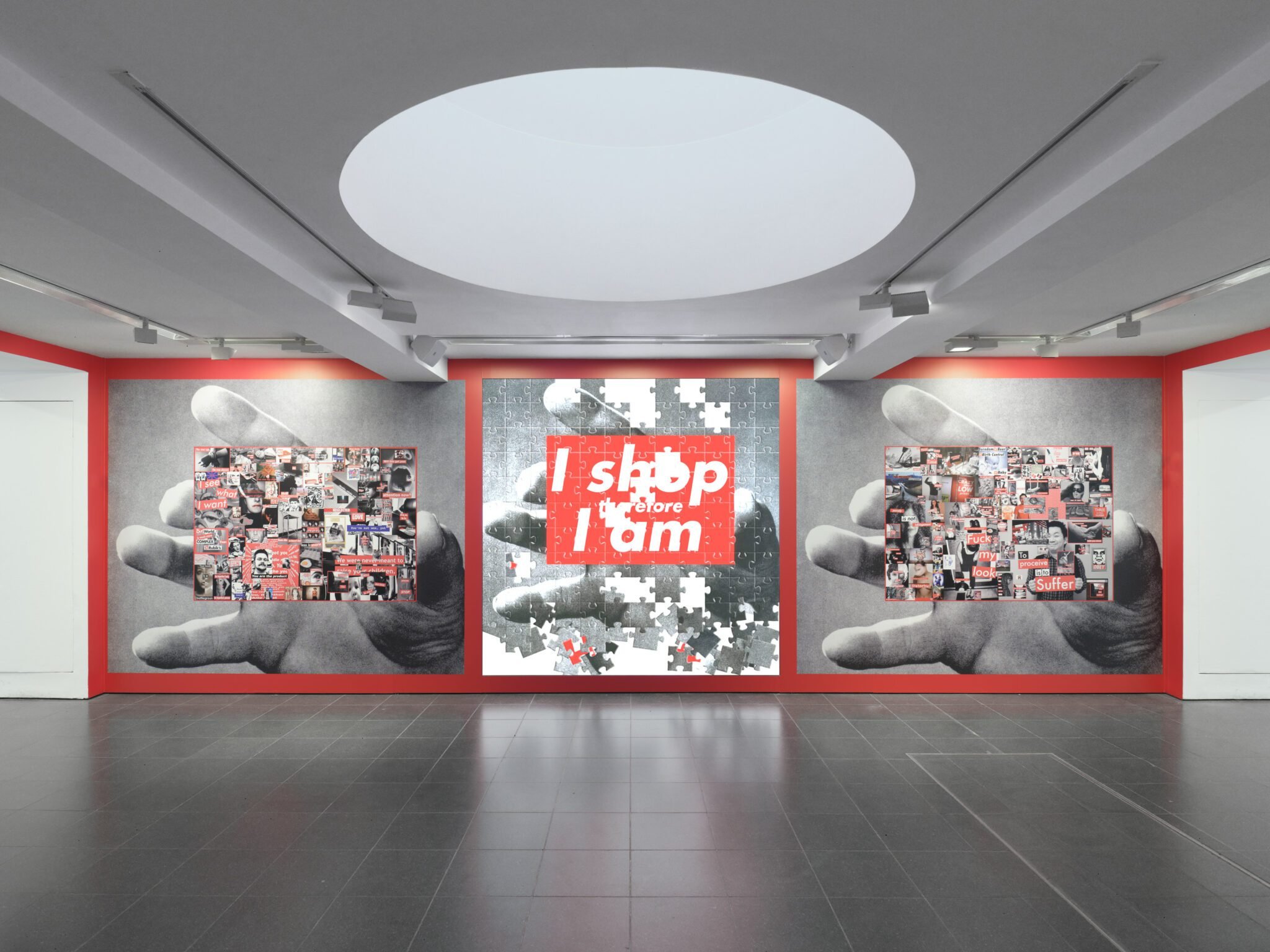
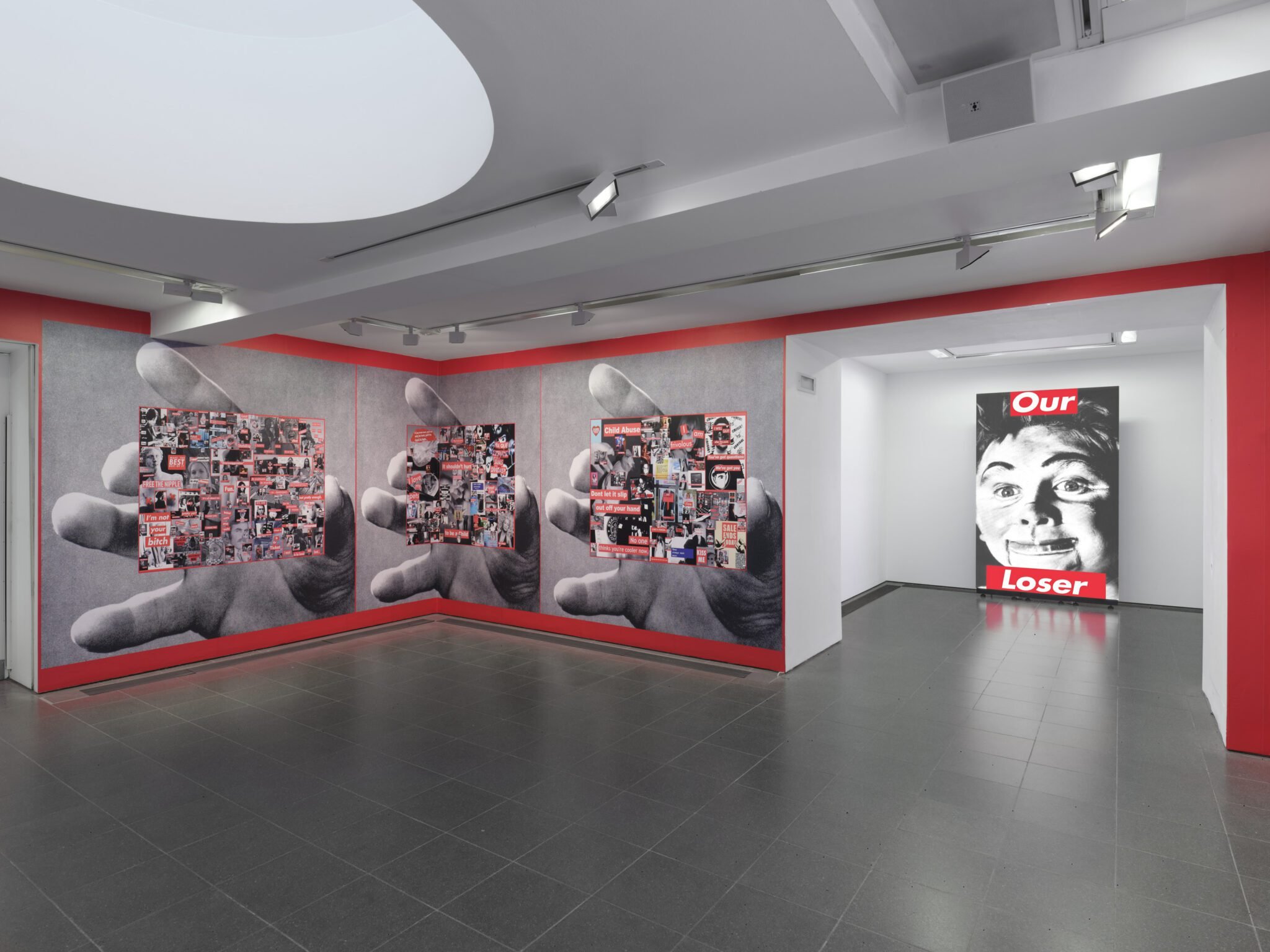
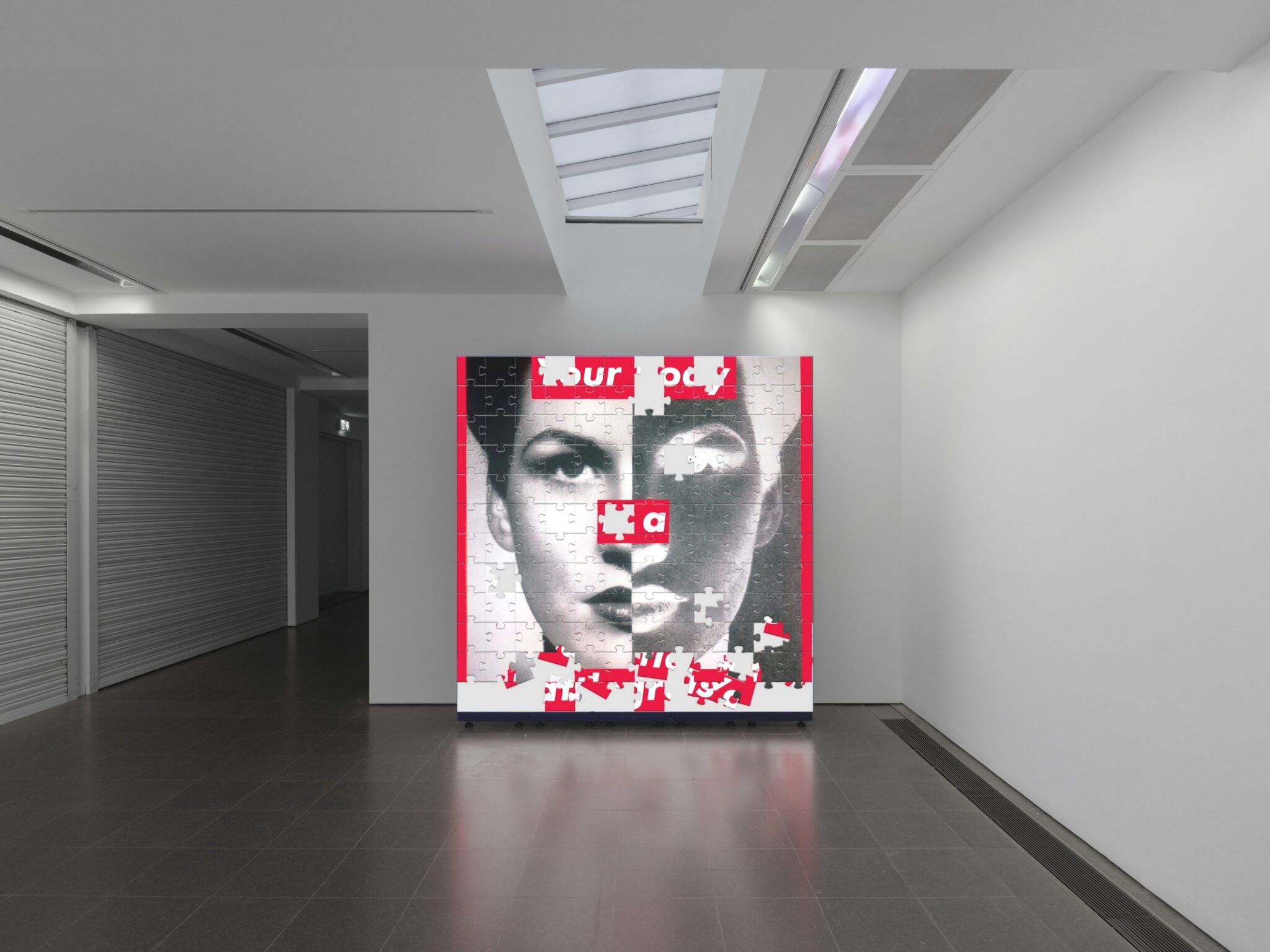
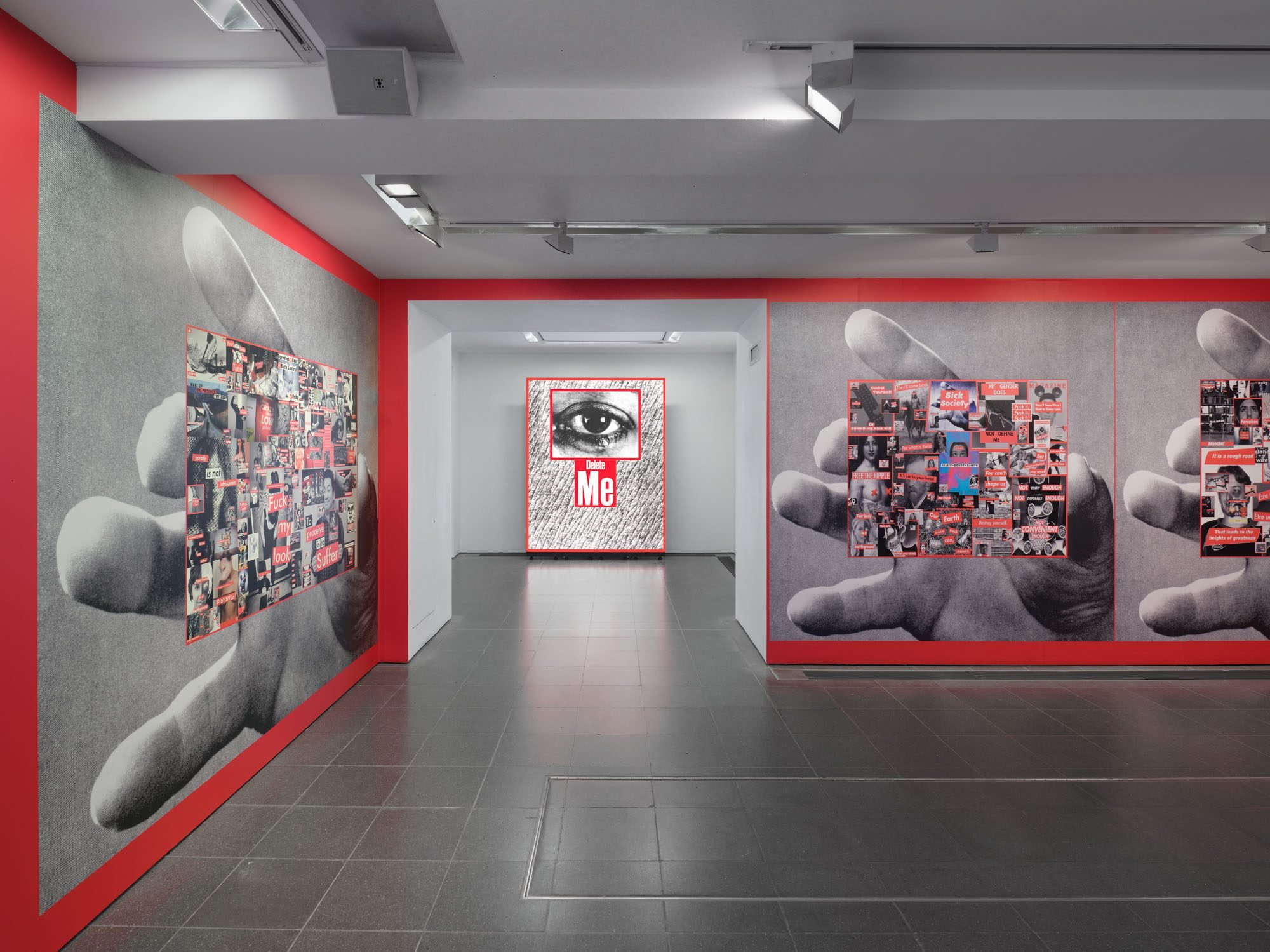
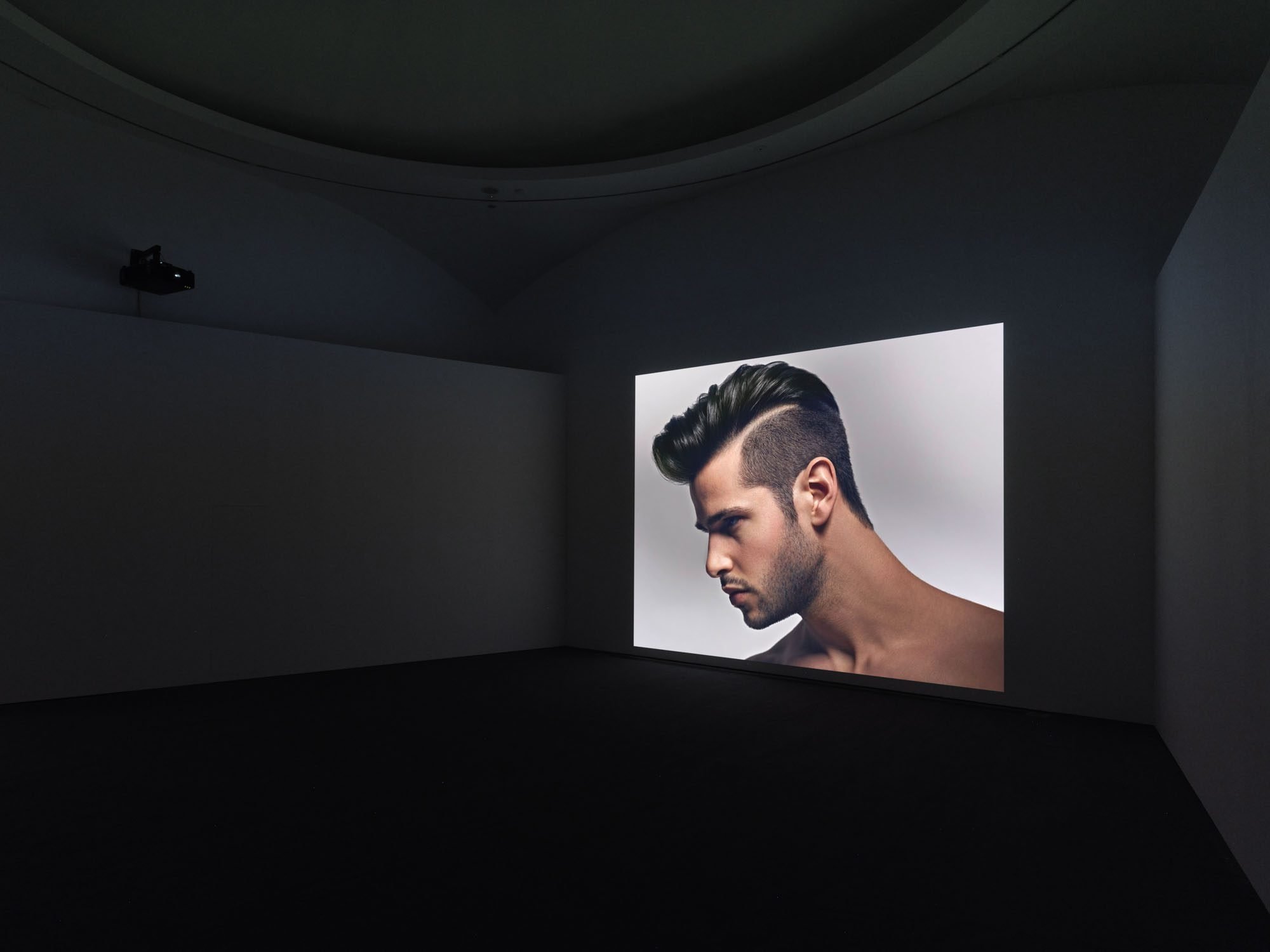

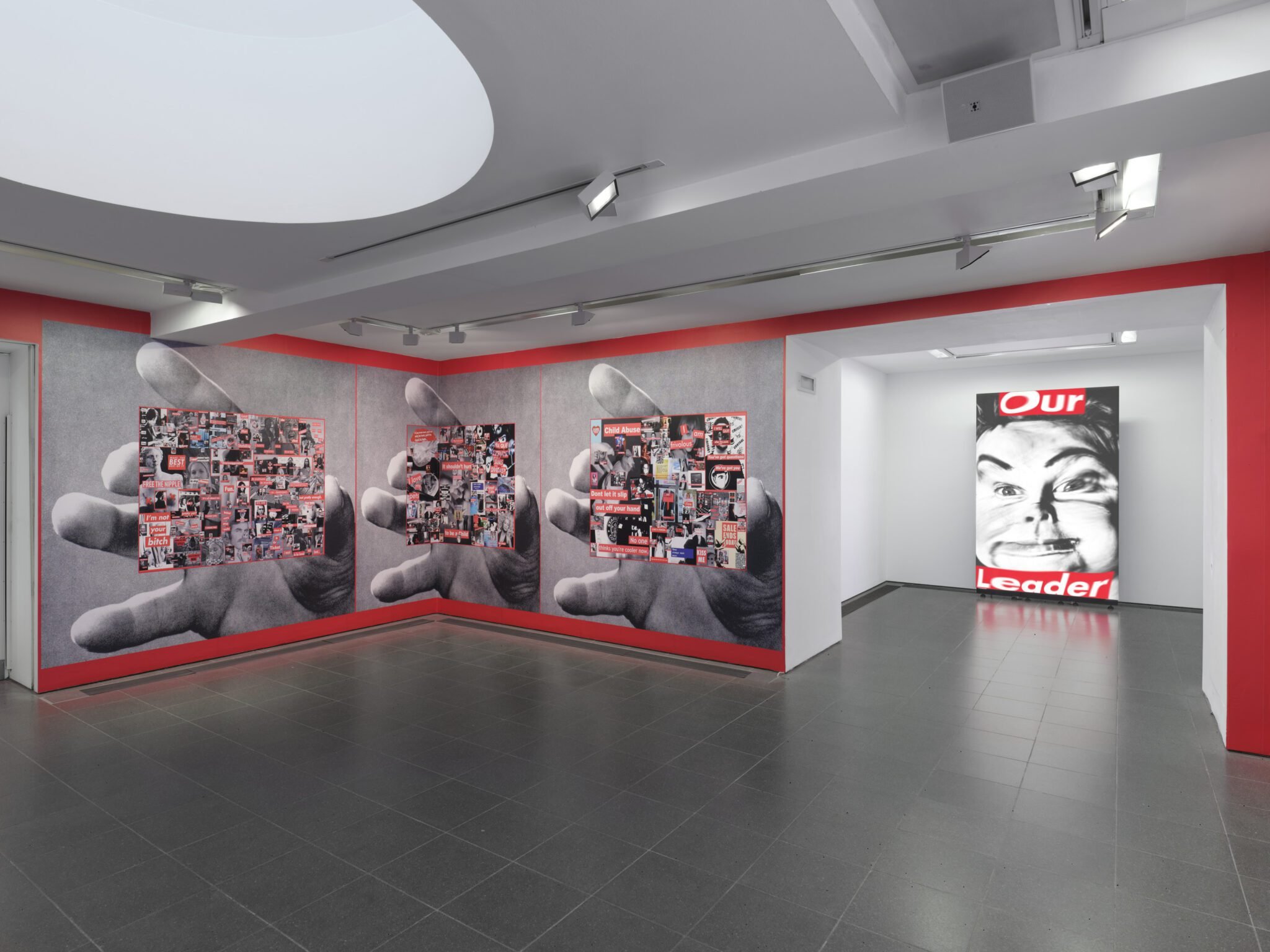

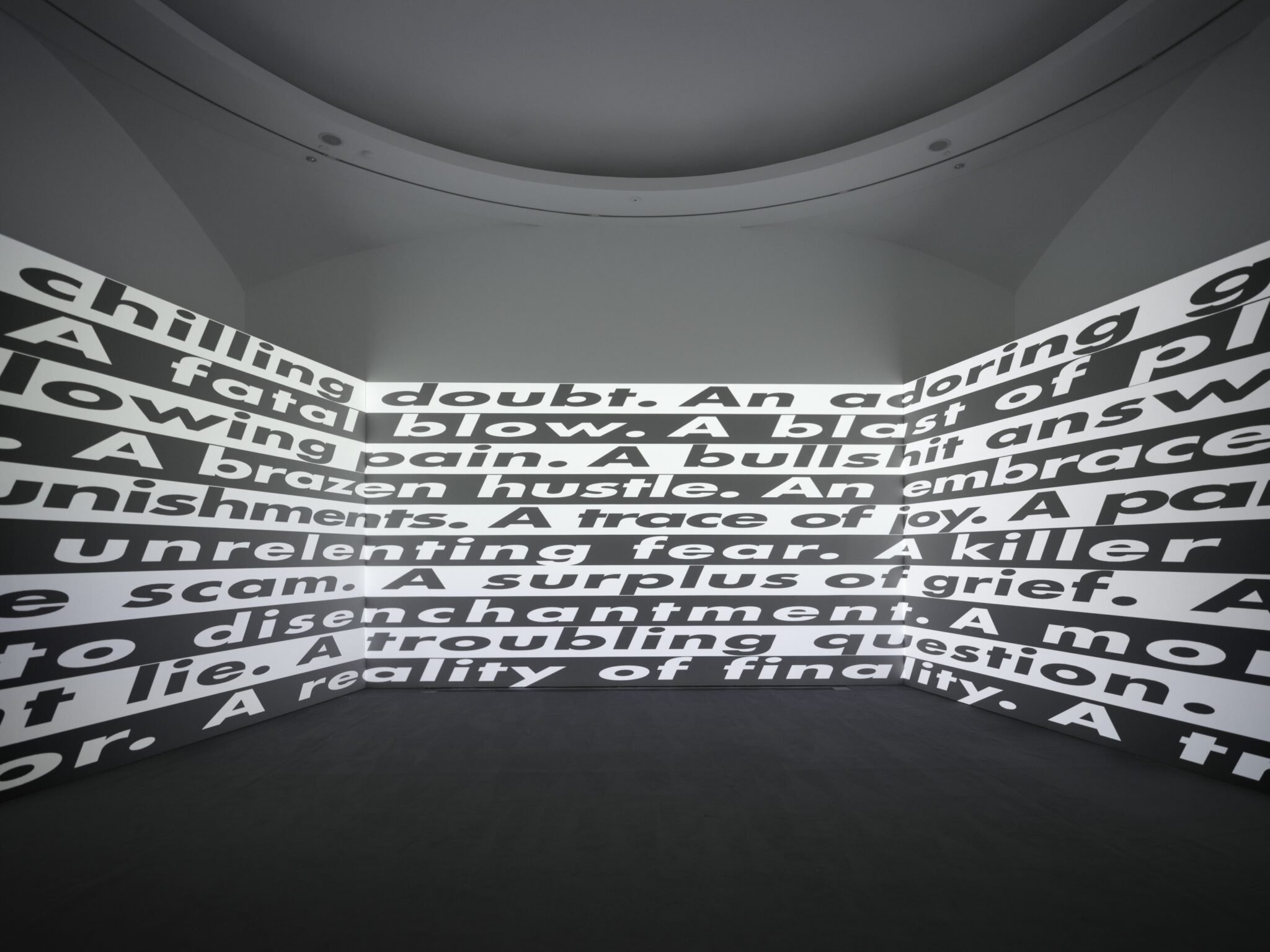
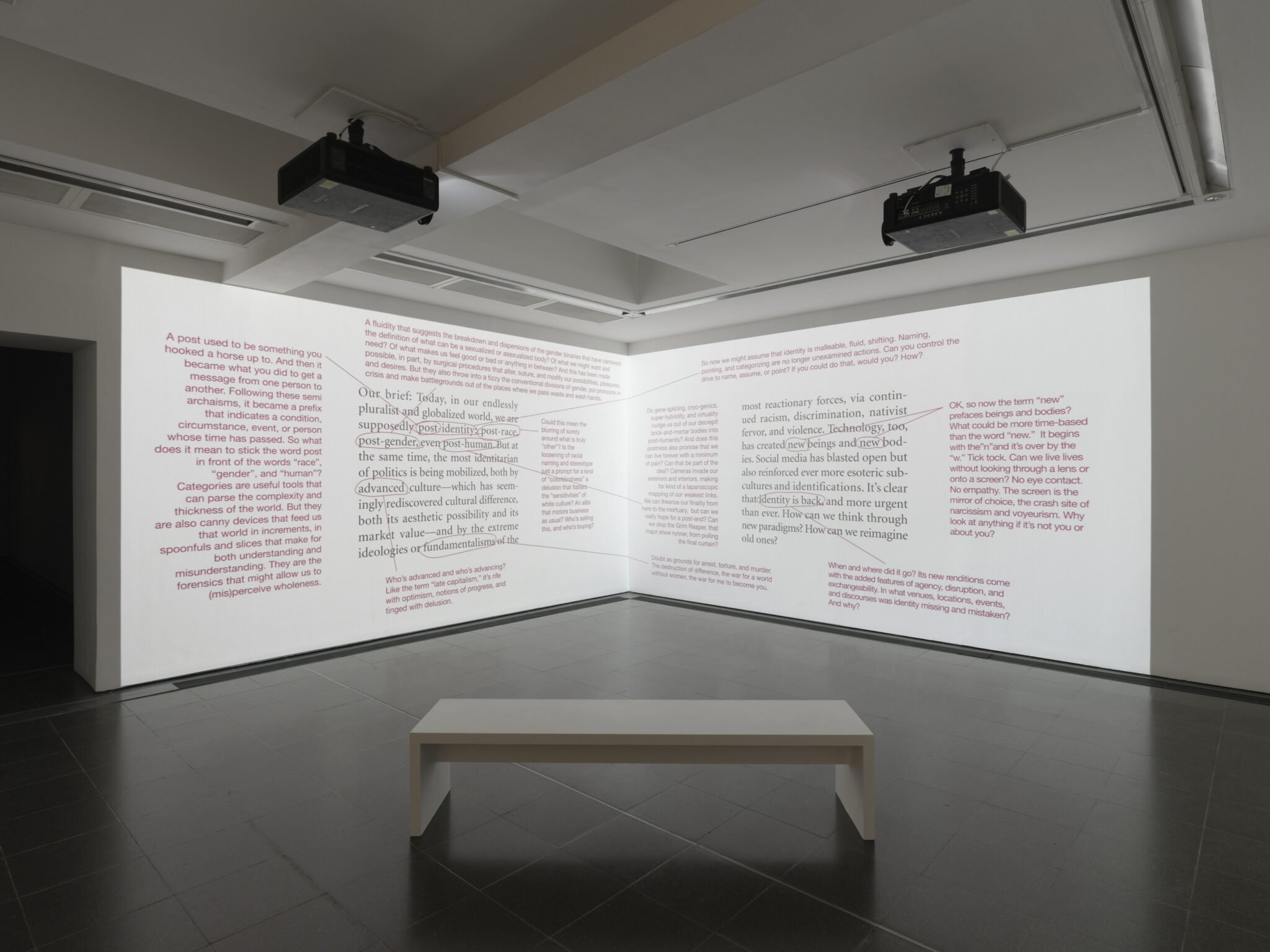
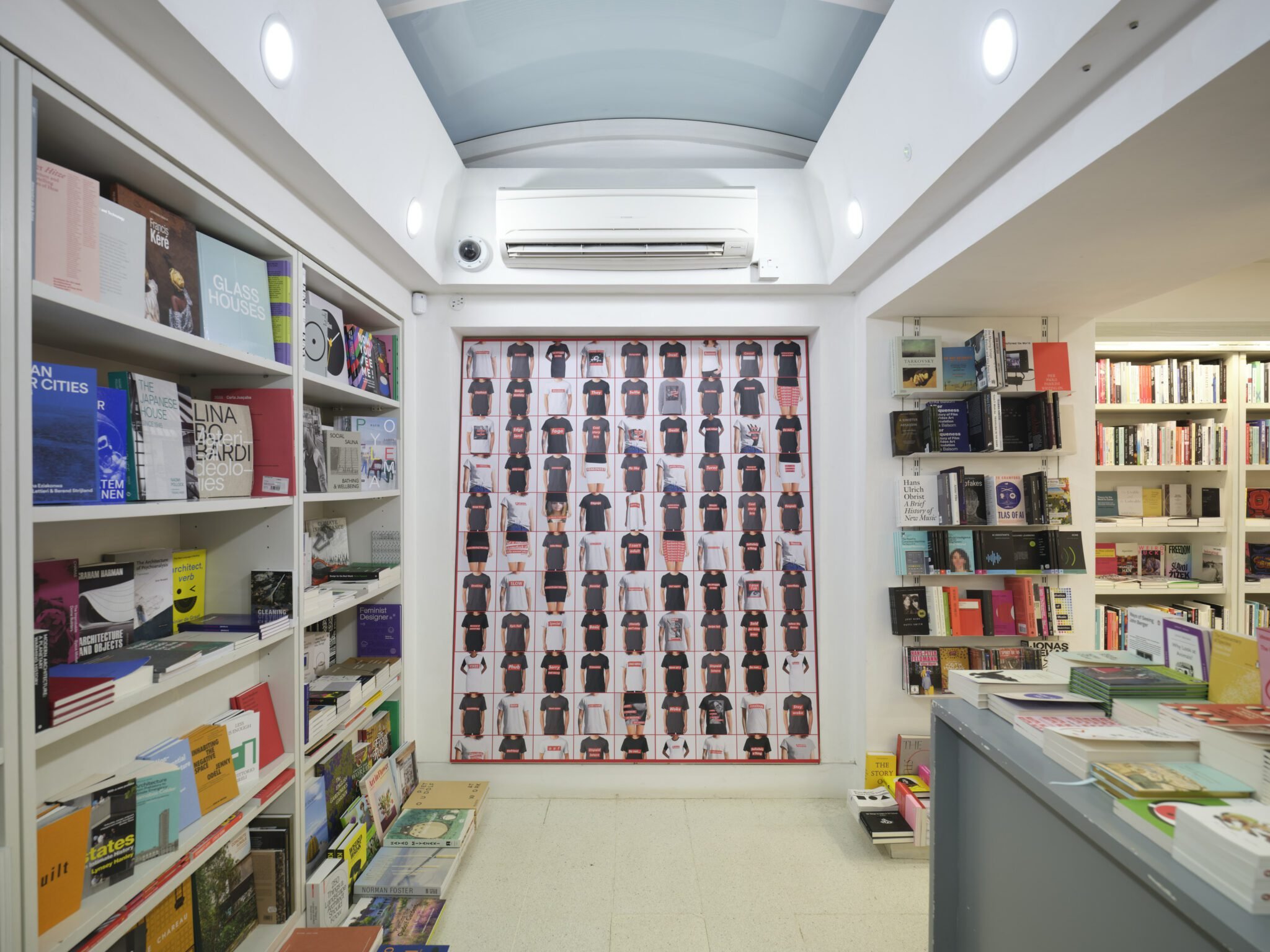
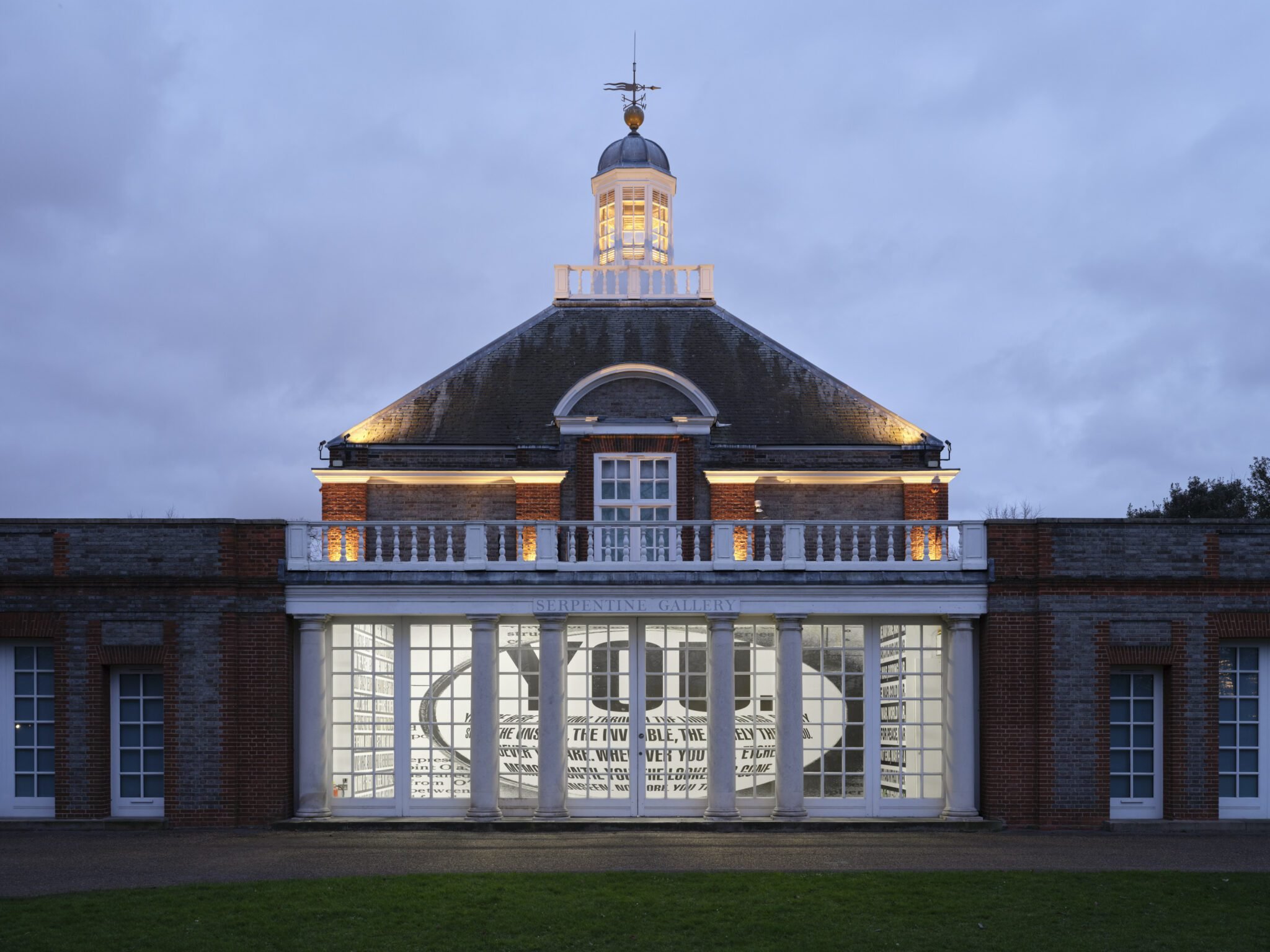
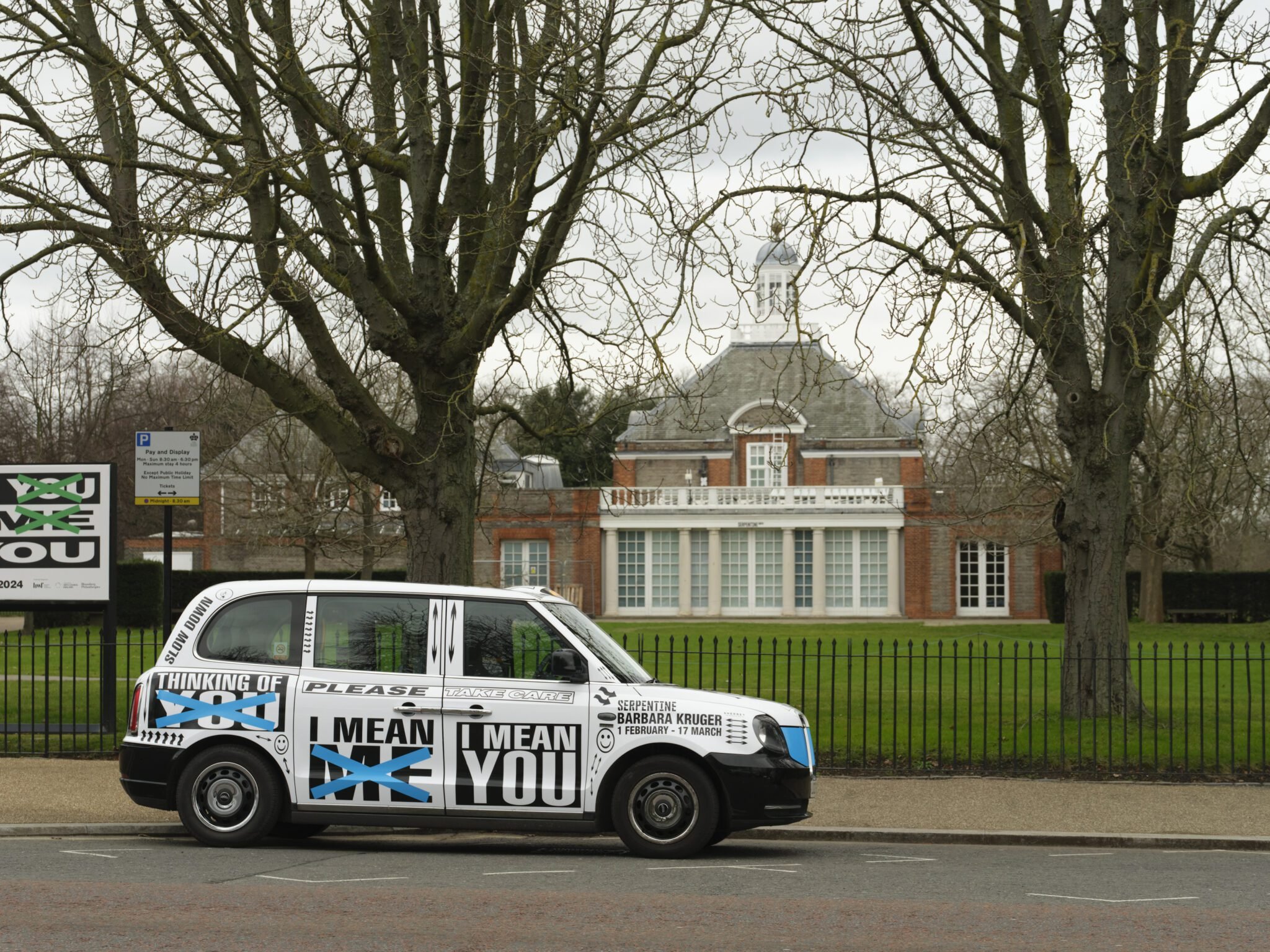
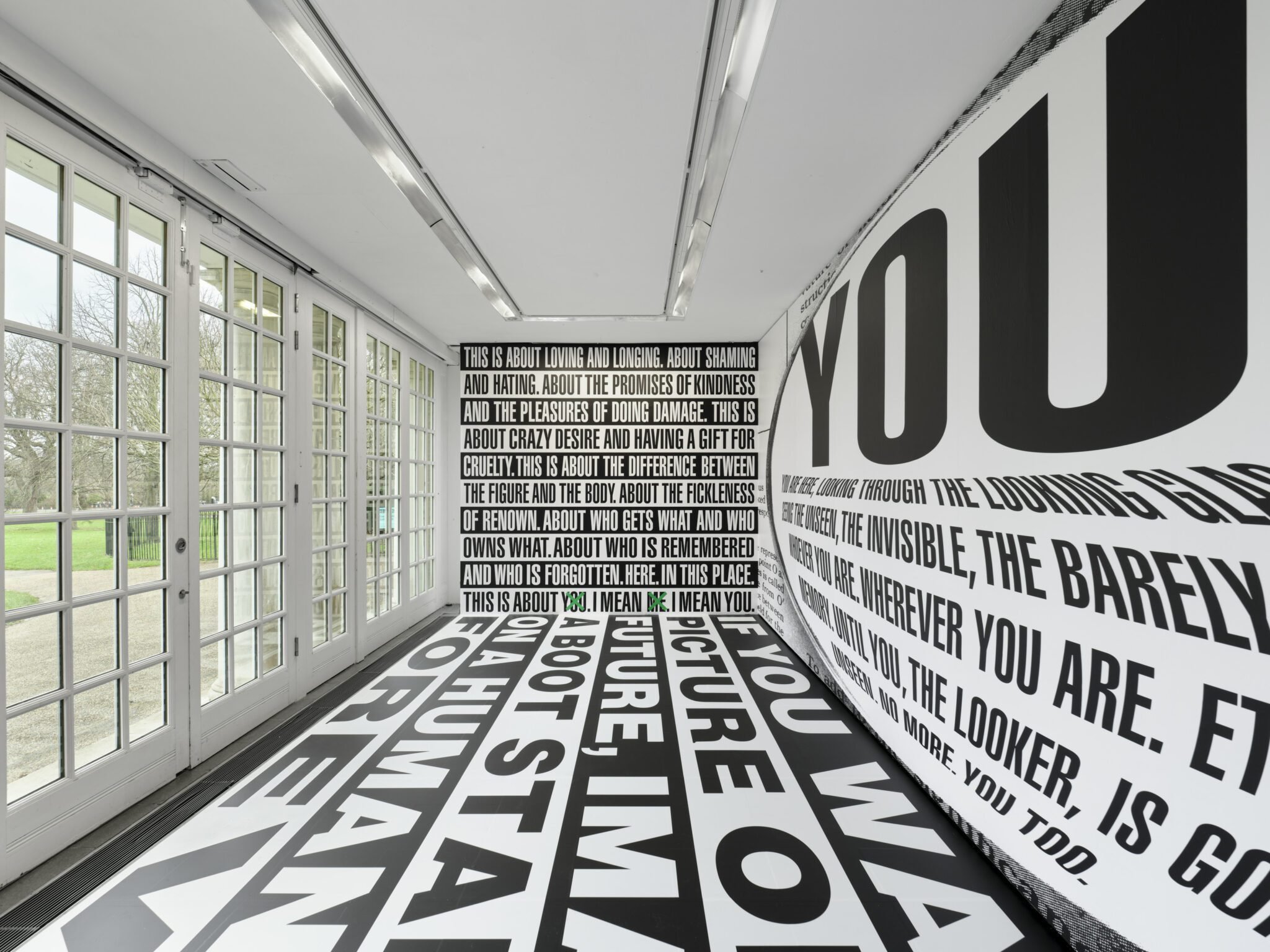
Barbara Kruger: Thinking of You. I Mean Me. I Mean You.,(Installation view, 1 February – 17 March 2024, Serpentine South) Photo: George Darrell
installation images of Kruger's work, and gemstones mix to stress our era's short attention spans.
Pledge, Will, Vow, 1988/2020, is a three-channel video work, recently presented at the 59th Venice Biennale in 2022. In this work, Kruger takes on the texts of the U.S. Pledge of Allegiance, traditional marriage vows, and the last will and testament.
In Untitled (Forever), 2017, enveloping the walls and floor of a gallery rarely open to visitors, Kruger assembles her words with those of others. A quote from George Orwell's novel 1984 is installed on the floor. The rest of the area is covered with textual works, one of which finishes with the words THIS IS ABOUT -¥G-th- I MEAN ME. I MEAN YOU..
The exhibition will also feature an audio chorus of greetings, emotions, and sentiments that address visitors at the entry and throughout the building.
The project is curated by the artist in close collaboration with Natalia Grabowska, Curator at Large, Architecture and Site-specific Projects, and produced by Brittany Stewart, Creative Producer, and Mike Gaughan, Gallery Manager.
About Barbara Kruger:
Barbara Kruger (born 1945, Newark, NJ, USA) is an artist who works with pictures and words. She lives and works in Los Angeles and New York. After spending two years at Syracuse University and Parsons School of Design in New York, she began working as a designer and picture editor at the Conde Nast magazines Mademoiselle and House &Garden. Frequently borrowing from the language of advertising and graphic design, her practice often explores the complex mechanisms of power, gender, class, and capital. Her work has been shown in international art institutions and across public spaces, including installed and projected onto buildings, billboards, hoardings, cars, buses, and skate parks, and printed in newspapers. She is an Emeritus Distinguished Professor in the Department of Art at UCLA.
Solo shows include the Museum of Modern Art, New York (2022), Los Angeles County Museum of Art (2022), Neue Nationalgalerie, Berlin (2022), The Art Institute of Chicago (2021), AMOREPACIFIC Museum of Art, Seoul (2019), National Gallery of Art, Washington, DC (2016), High Line Art, New York (2016), Modern Art Oxford (2014), Kunsthaus Bregenz (2013), Pinakothek der Moderne, Munich (2011), Schirn Kunsthalle, Frankfurt (2010), Gallery of Modern Art, Glasgow (2005), Whitney Museum of American Art, New York (2000), Museum of Contemporary Art, Los Angeles (1999), Musee d'art contemporain, Montreal (1985), and Kunsthalle Basel (1984). Group shows include those at Isabella Stewart Gardner Museum, Boston (2021), Hamburger Bahnhof, Berlin (2018), V-A-C Foundation, Palazzo delle Zattere, Venice (2017), Hammer Museum, Los Angeles (2014), Biennale of Sydney (2014), Museum Ludwig, Cologne (2013), Stedelijk Museum, Amsterdam (2010), Museum of Modern Art, New York (2010, 2009, 2007), Palazzo Grassi, Venice (2006), Museum of Contemporary Art, Chicago (2004), Tate Liverpool (2002), Serpentine, London (1994), Centre Pompidou, Paris (1988), and Solomon R. Guggenheim Museum, New York
(1987). Her work was included in The Milk of Dreams, the 59th International Art Exhibition
- La Biennale di Venezia (2022).
Thinking of ¥mt. I Mean Me. I Mean You. is an adaptation of the exhibition organised by the Art Institute of Chicago, the Los Angeles County Museum of Art, and The Museum of Modern Art, New York.
Thinking of¥eit. I Mean Me. I Mean You. was on view at the Art Institute of Chicago from 19 September 2021 to 24 January 2022, and was co-organised by James Rondeau, President and Eloise W. Martin Director, and Robyn Farrell, Senior Curator at the Kitchen and former Associate Curator of Modern and Contemporary Art. At LACMA, the exhibition was presented 20 March 2022 to 17 July, 2022 and was organised by Michael Govan, CEO and Wallis Annenberg Director, and Rebecca Morse, Curator, Wallis Annenberg Photography Department. The installation at The Museum of Modern Art, New York, was on view from 18 July, 2022 to 2 January 2023 and was organised by Peter Eleey, former Chief Curator, MoMA PS1, and Lanka Tattersall, Laurenz Foundation Curator, Department of Drawings and Prints.
Beyond the gallery walls
Thinking of ¥ou. I Mean M̶e̶. I Mean You. will extend beyond Serpentine South. From 4th March to 20th May 2024, from 6 pm to 11.30 pm in its second collaboration with Outernet Arts - located at the junction of Tottenham Court Road and Charing Cross Road alongside Centre Point - a presentation of Barbara Kruger's work will be displayed on the world's largest wrap-around public screens.
In Silent Writings, 2009/2024, Barbara Kruger explores how we communicate and connect with global events and with each other. The piece weaves images and words in an attempt to engage issues of control, power and dominance. Kruger incorporates her own words alongside quotes from writers and philosophers including Aime Cesaire, Goethe, Thomas Mann and Mary Therese McCarthy. These quotes allude to themes of violence, political modes of operation and spectatorship. Kruger manipulates selected words, enlarging or removing them to highlight their meanings and create new ones. Opposing terms like contact/isolation, order/horror, stupid/clever become fluid and interchangeable.
Throughout the piece, cropped found documentary photographs of conflicts, politicians and mass media images briefly appear between sentences, serving as illustrations of the words or evidence of their relevance. As in many of her works, the artist addresses the viewers directly to make us question our beliefs, perspectives and how we perceive the world.
About Serpentine
Building new connections between artists and society, Serpentine presents pioneering contemporary art exhibitions and cultural events with a legacy that stretches back over half a century, from a wide range of emerging practitioners to the most internationally recognised artists, writers, scientists, thinkers, and cultural thought leaders of our time.
Based in London's Kensington Gardens, across two sites, Serpentine North and Serpentine South, Serpentine features a year-round, free programme of exhibitions, architectural showcases, education, live events and technological activations, in the park and beyond the gallery walls.
The Serpentine Pavilion is a yearly pioneering commission, which began in 2000 with Dame Zaha Hadid. It features the first UK structures by some of the biggest names in international architecture.
Public art has emerged as a central strand of Serpentine's programme. Major presentations include a collection of Eduardo Paolozzi's sculptures (1987), Anish Kapoor's Turning the World Upside Down (2010), Lee Ufan presentedRelatum-Stage (2018-19), Christo and Jeanne-Claude's London Mastaba in the Serpentine Lake (2018), I LOVE YOU EARTH by Yoko Ono (2021), Dominique Gonzalez-Foerster In remembrance of the coming alien (Alienor), (2022), and Alexandra Daisy Ginsberg's Pollinator Pathmaker (2022 - ongoing).
Proud to maintain free access for all visitors, thanks to its unique location, Serpentine also reaches an exceptionally broad audience and maintains a profound connection with its local community.
A Serpentine limited edition by Barbara Kruger will be launched to coincide with the exhibition, to purchase please contact here. Barbara Kruger's limited run drop of apparel will also be sold exclusively at Serpentine South throughout the exhibition.
About Outernet Arts
Outernet Arts is an independent arts organisation located in the heart of London, offering free and accessible exhibitions in one of the world's largest digital spaces. With screens spanning the height of four stories, the organisation presents a year-round programme every Monday from 18:00 to 23:30. It aims to bring together a diverse network of both established and under-represented artists, commissioning projects that explore the complexities of the media space. Through artist-led initiatives, Outernet Arts sparks meaningful discussions about our existence in a digitally dominated world.
For more information about this exhibition and others, please visit Serpentine’s website. Please also visit and follow Serpentine on Instagram, Facebook, and YouTube, along with TikTok.
Stephen Friedman Gallery presents Brazilian artist Luiz Zerbini for Frieze Los Angeles
Installation views: Luiz Zerbini at Frieze LA (2024). Courtesy Stephen Friedman Gallery, London and New York. Photo by Mark Blower.
Stephen Friedman Gallery presents a new body of work by Brazilian artist Luiz Zerbini for Frieze Los Angeles, marking the artist's debut exhibition in the city. The solo presentation includes dynamic paintings and monotypes and shows the immersive and seductive quality of Brazil’s natural environment.
Luiz Zerbini, 'Natureza morta', 2023. Oil on Hahnemühle paper over linen, acrylic on wood, 127 x 98.5cm (50 x 38 3/4in). Copyright Luiz Zerbini. Courtesy of the artist and Stephen Friedman Gallery, London, and New York. Photo by Pat Kilgore.
In a career spanning over three decades, Zerbini has developed a complex visual vocabulary rooted at the intersection of figuration and abstraction. He first emerged within the generational and global ‘return to painting’ of the 1980s, centred in Rio de Janeiro around the Parque Lage School of Visual Arts. The artist was subsequently defined by the landmark exhibition ‘Como vai você Geração 80?’ (How Are You Doing, 80s Generation?, 1984).
Luiz Zerbini, 'Vitamina C', 2023. Oil on Hahnemühle paper over linen, acrylic on wood, 127 x 98.5cm (50 x 38 3/4in). Copyright Luiz Zerbini. Courtesy the artist and Stephen Friedman Gallery, London and New York. Photo by Pat Kilgore.
Juxtaposing hard-edged geometry with organic pattern, Zerbini’s paintings are an optical sensation, and evoke a blend of modernist architecture and lush tropical flora. By incorporating sweeping curves, fluid textures and vivid colours, the artist emulates the intoxicating effects of the sights and sounds of the rainforest. The works are “a reflection of the place I live,” Zerbini explains. “Rio de Janeiro has a huge forest just inside of the city. Everything is mixed. It’s an urban landscape, but it’s really full of nature.”
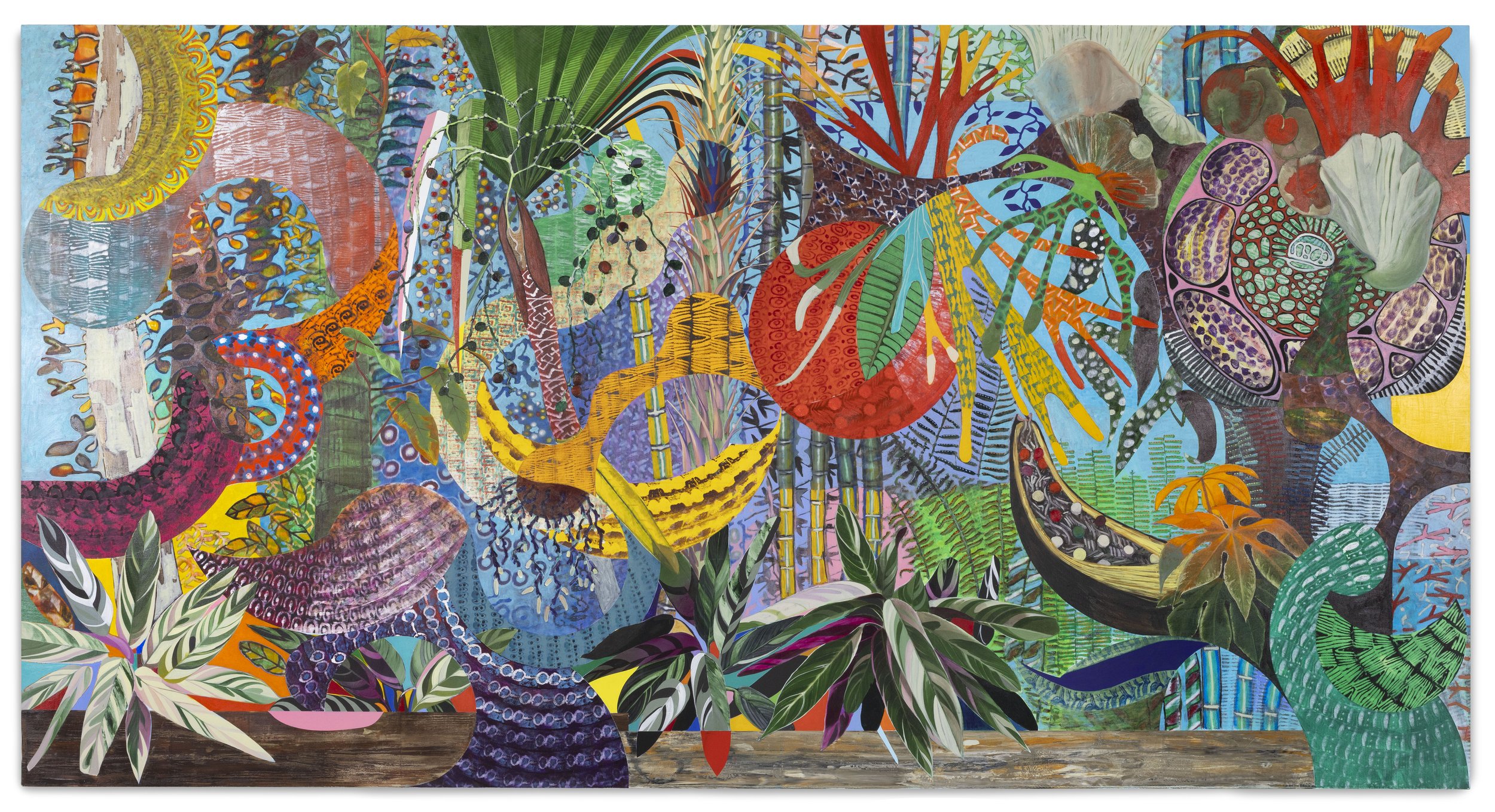
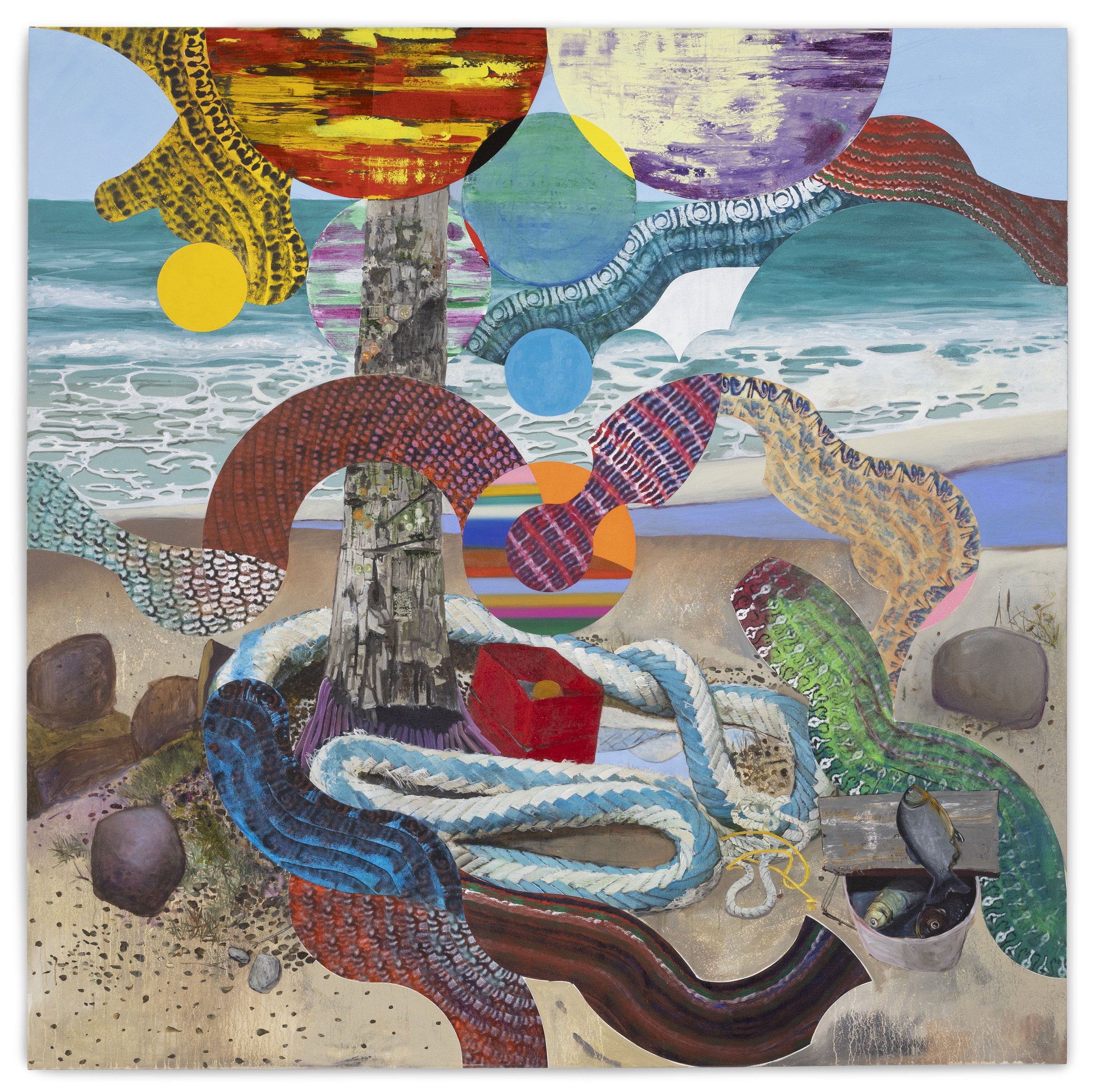
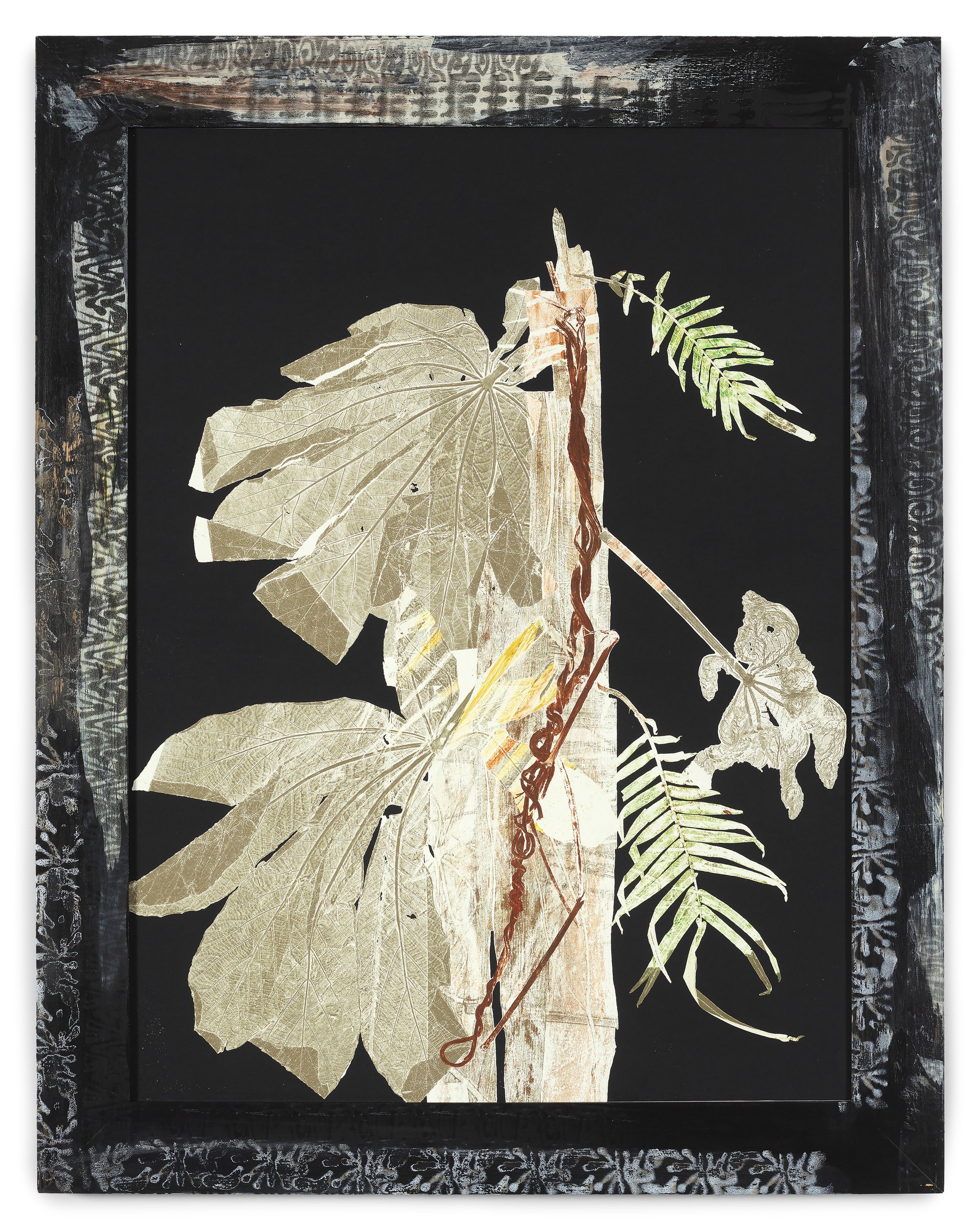
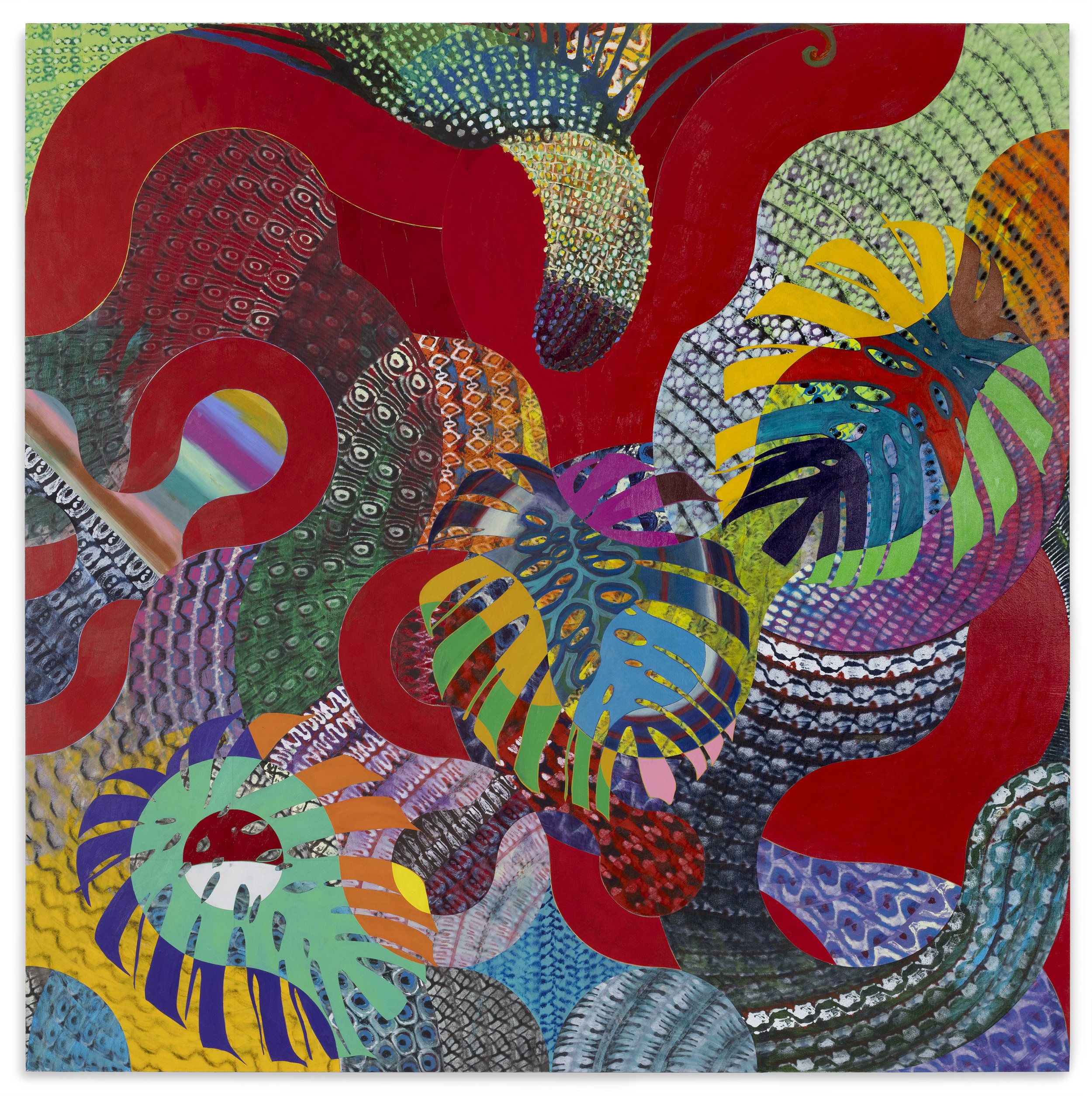
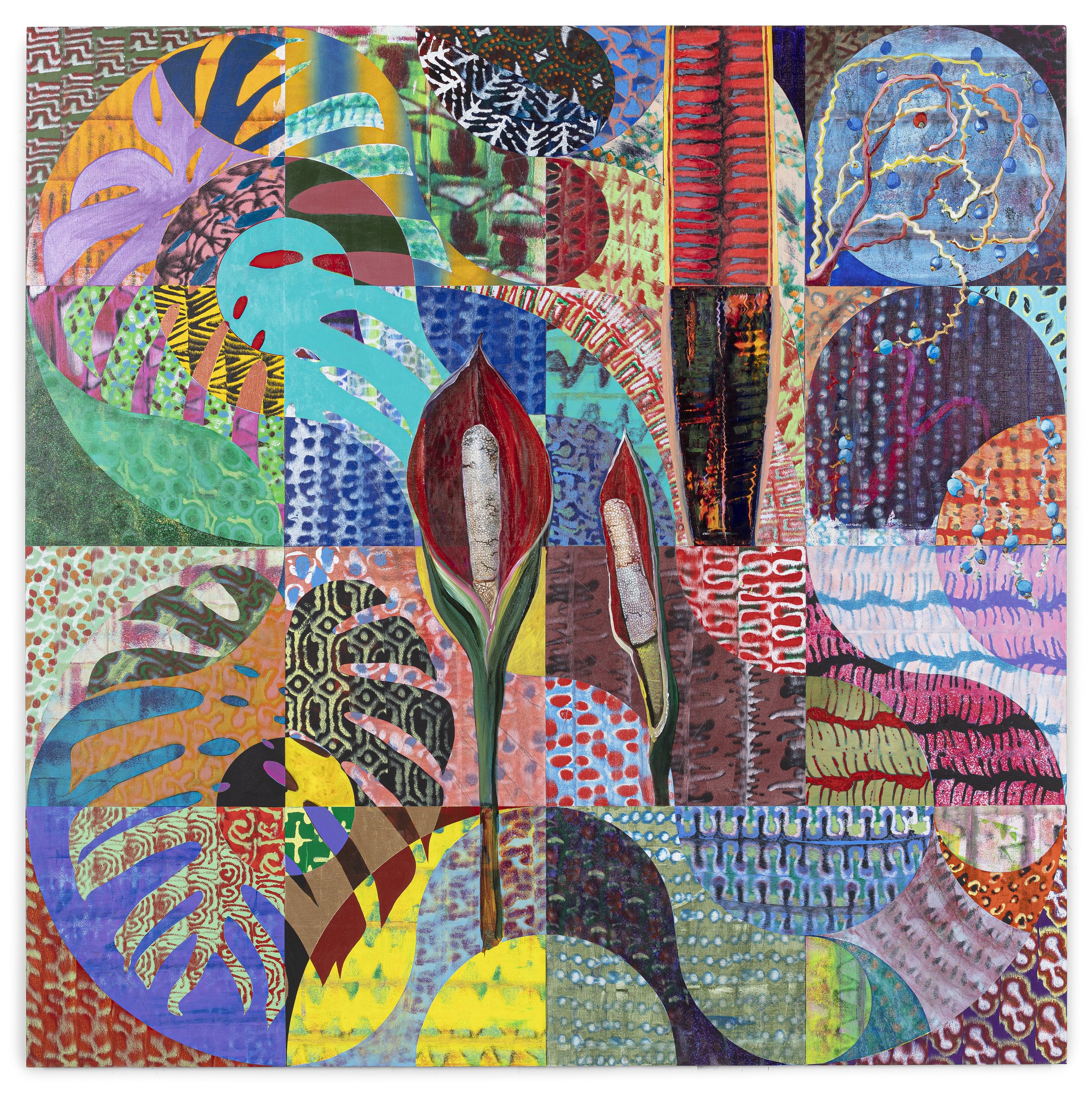
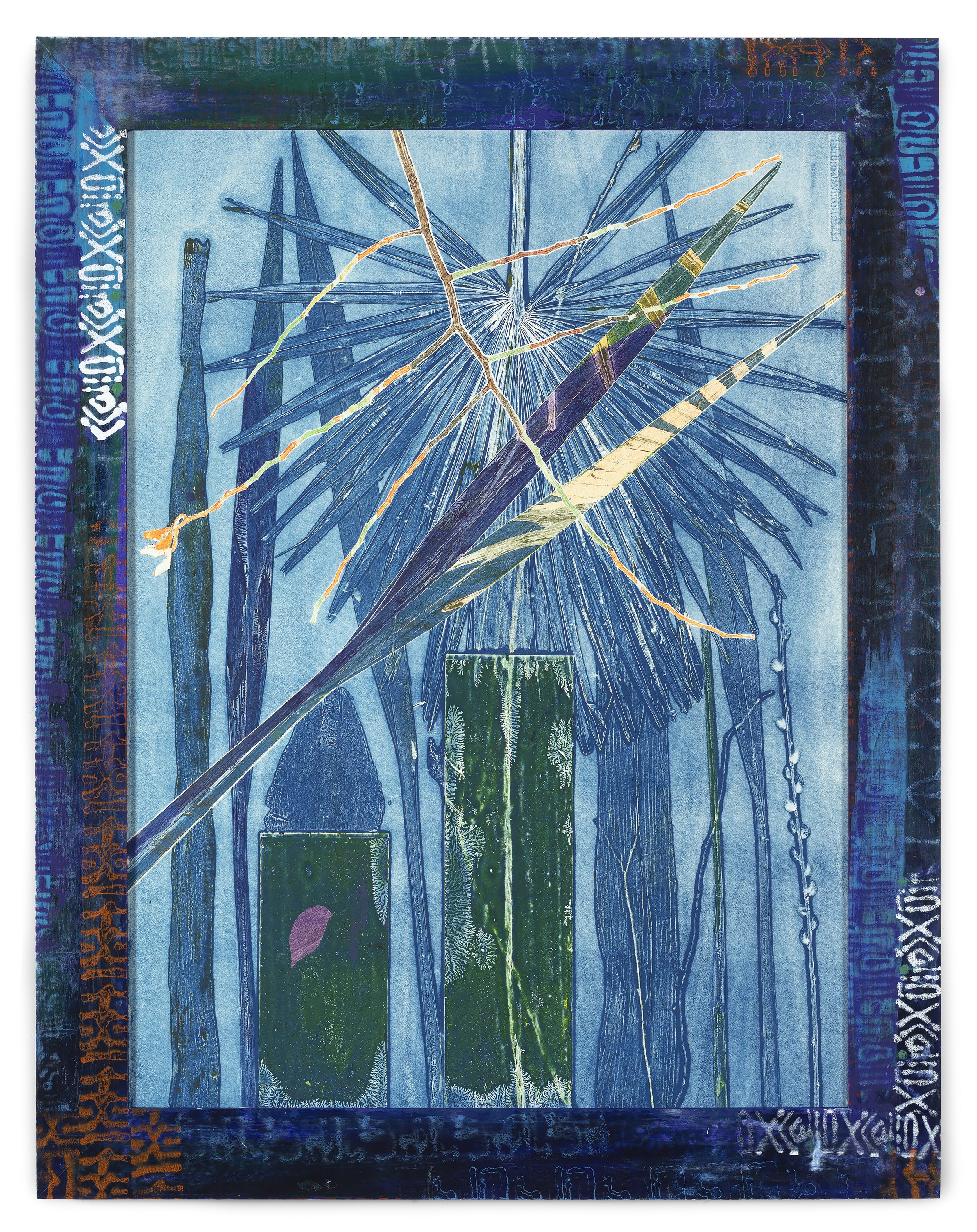
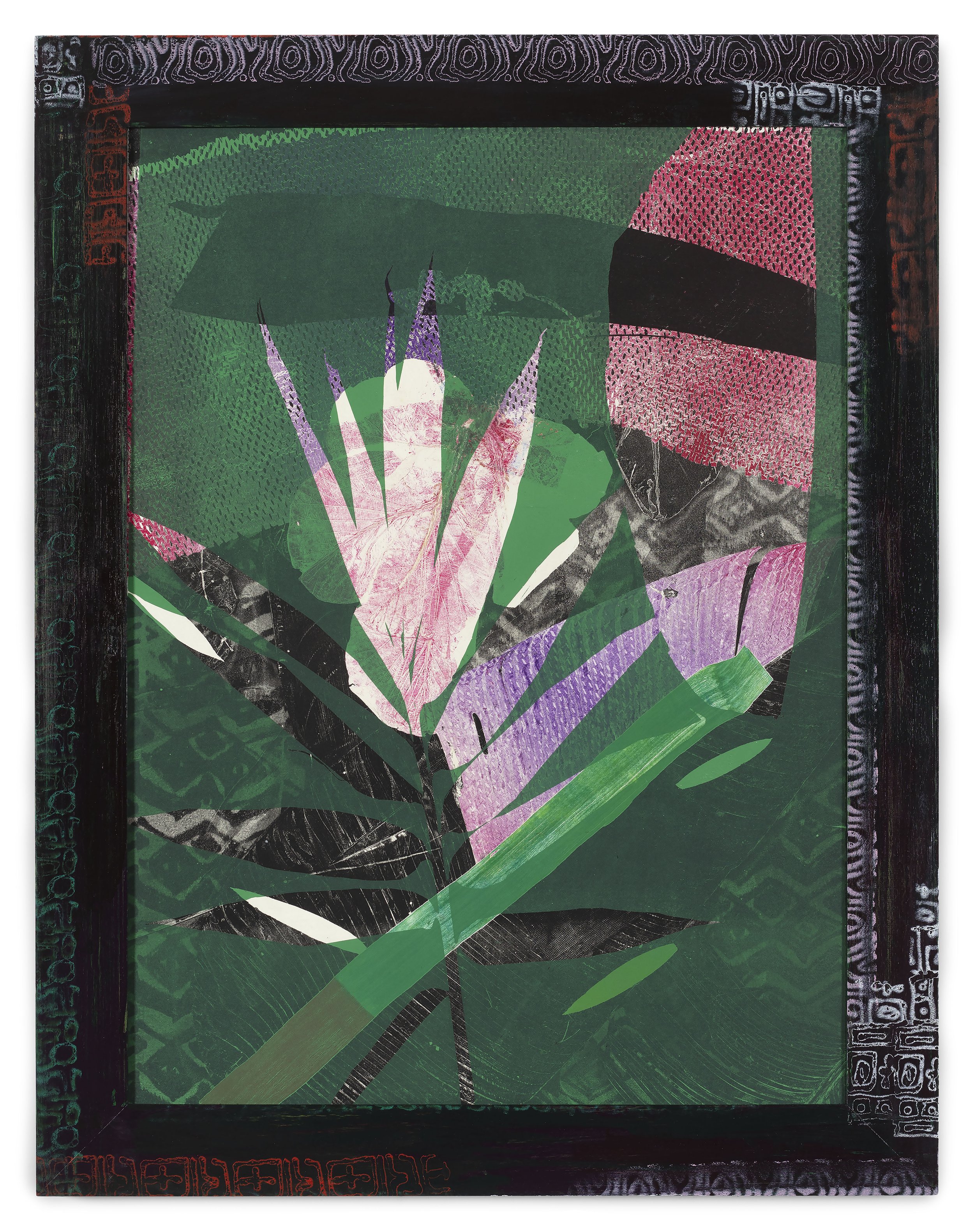
The grid – an emblem of modernism – is typically associated with the static, antinatural and systematic. Zerbini often uses a quadrangular grid as a primary structuring device, which subtly nods to the mosaic pavements and façades of Brazilian tower blocks. In the vibrant painting Erótica (2023), Zerbini transforms the grid’s tight squares into lenses of a kaleidoscopic vision. Monstera leaves and Calla lily flowers are layered over the work’s gridded structure, revealing appropriated patterns found in nature that were incorporated into his own vernacular. The artist takes elements of the grid in Sea Bubbles (2023) to lend the expressive composition a rhythmic quality, recalling the movement of water or trees swaying in the breeze. Flooding the viewer’s perception, Zerbini seeks to convey the impression of “being in the painting as you could be in a forest.”
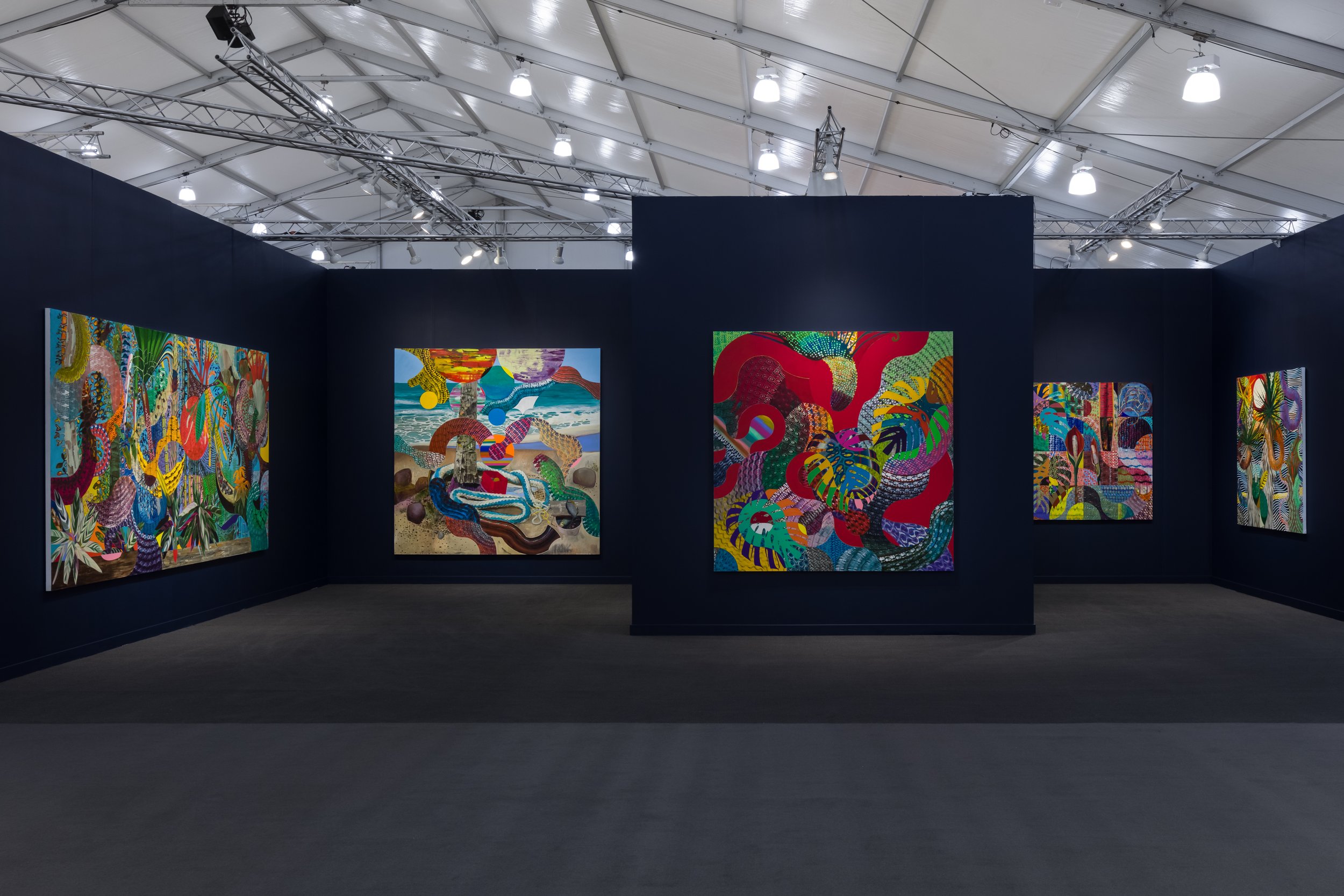
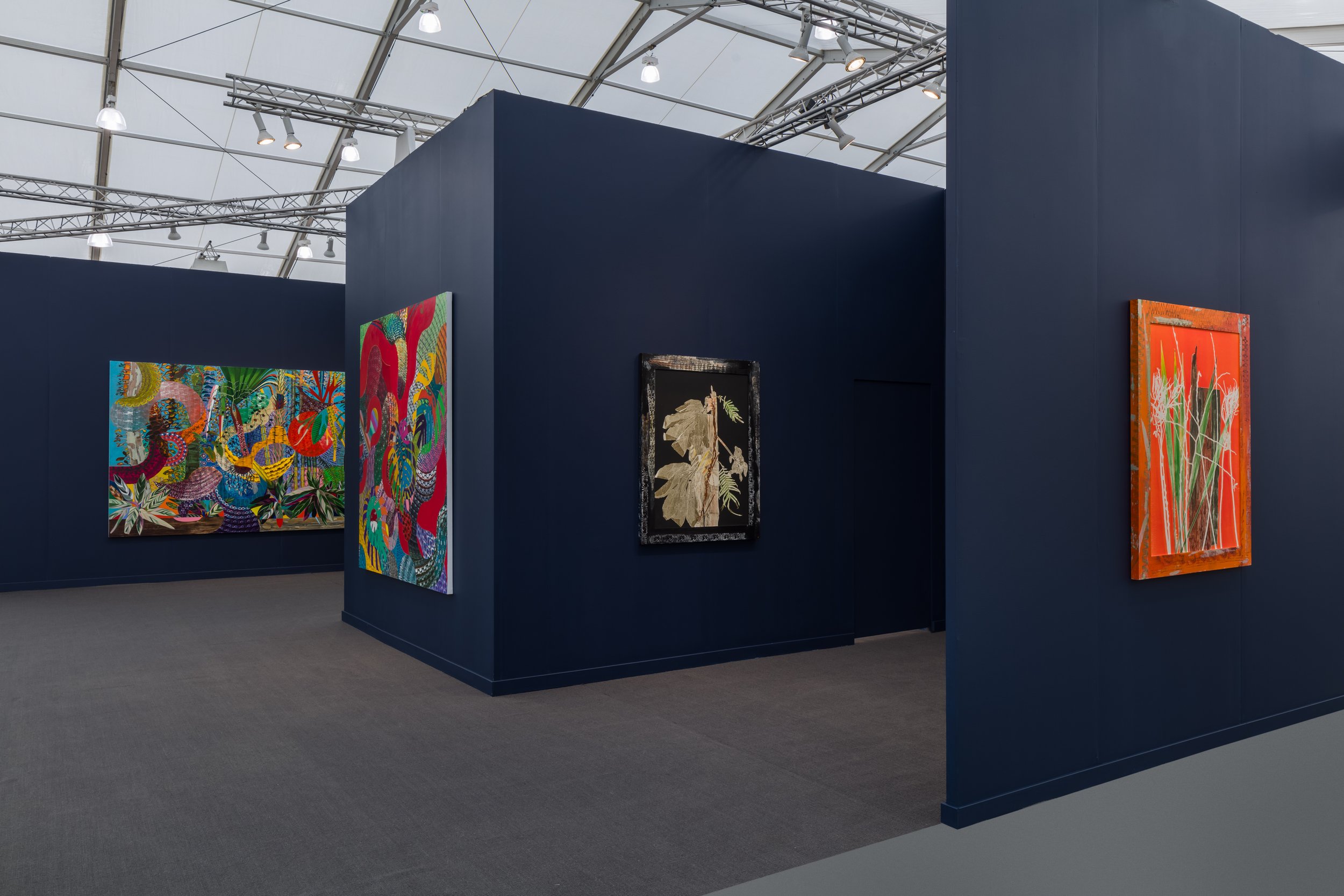
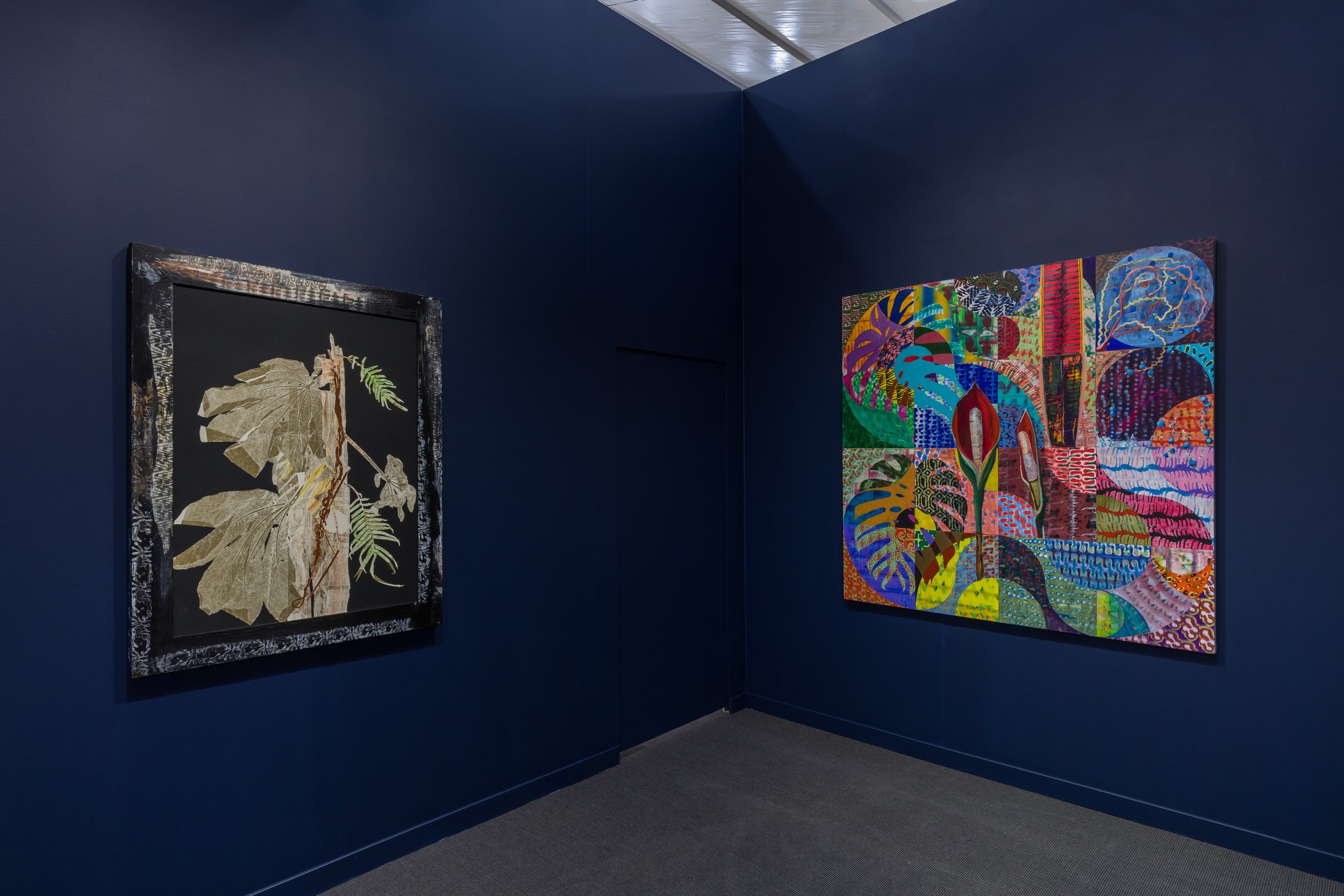
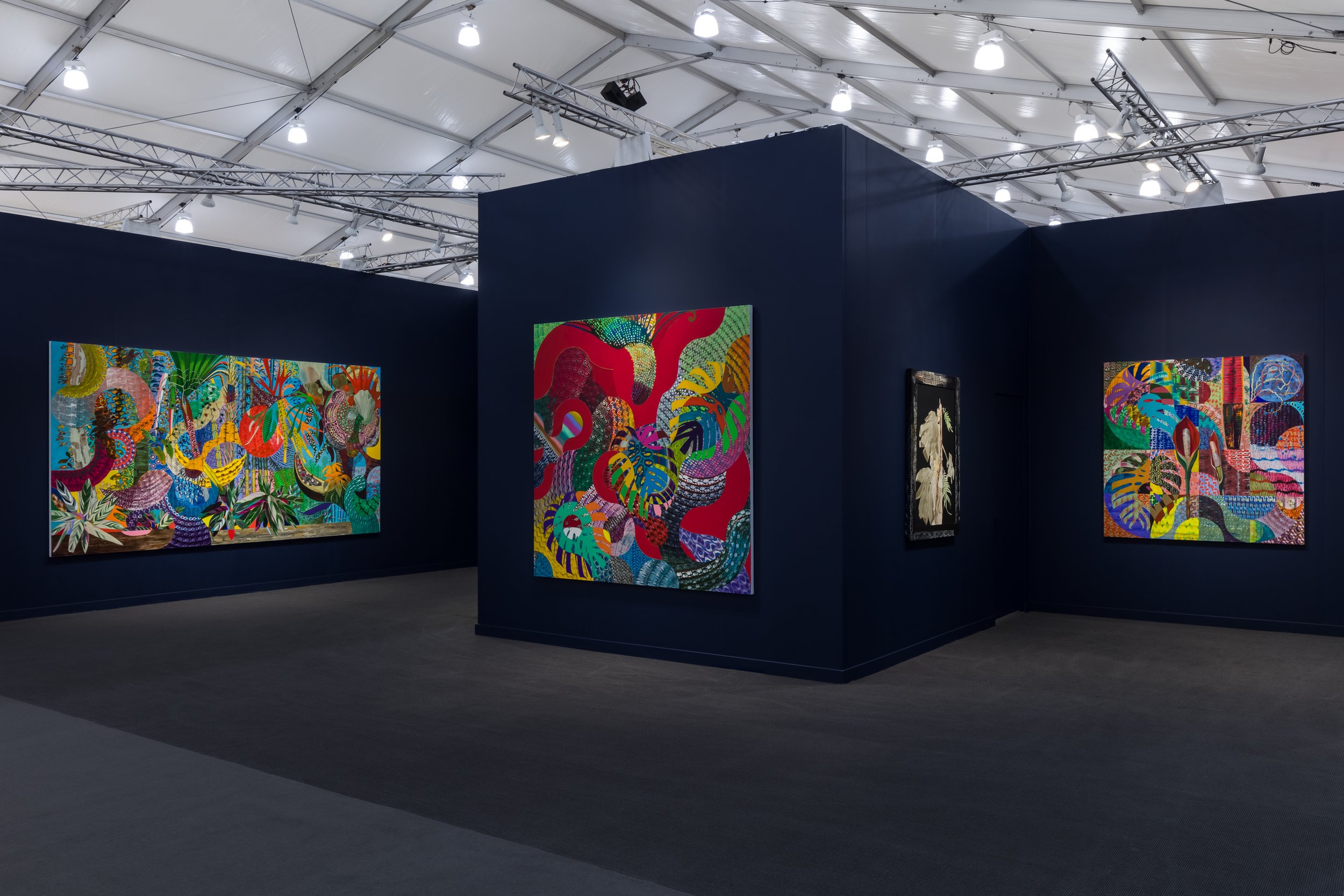
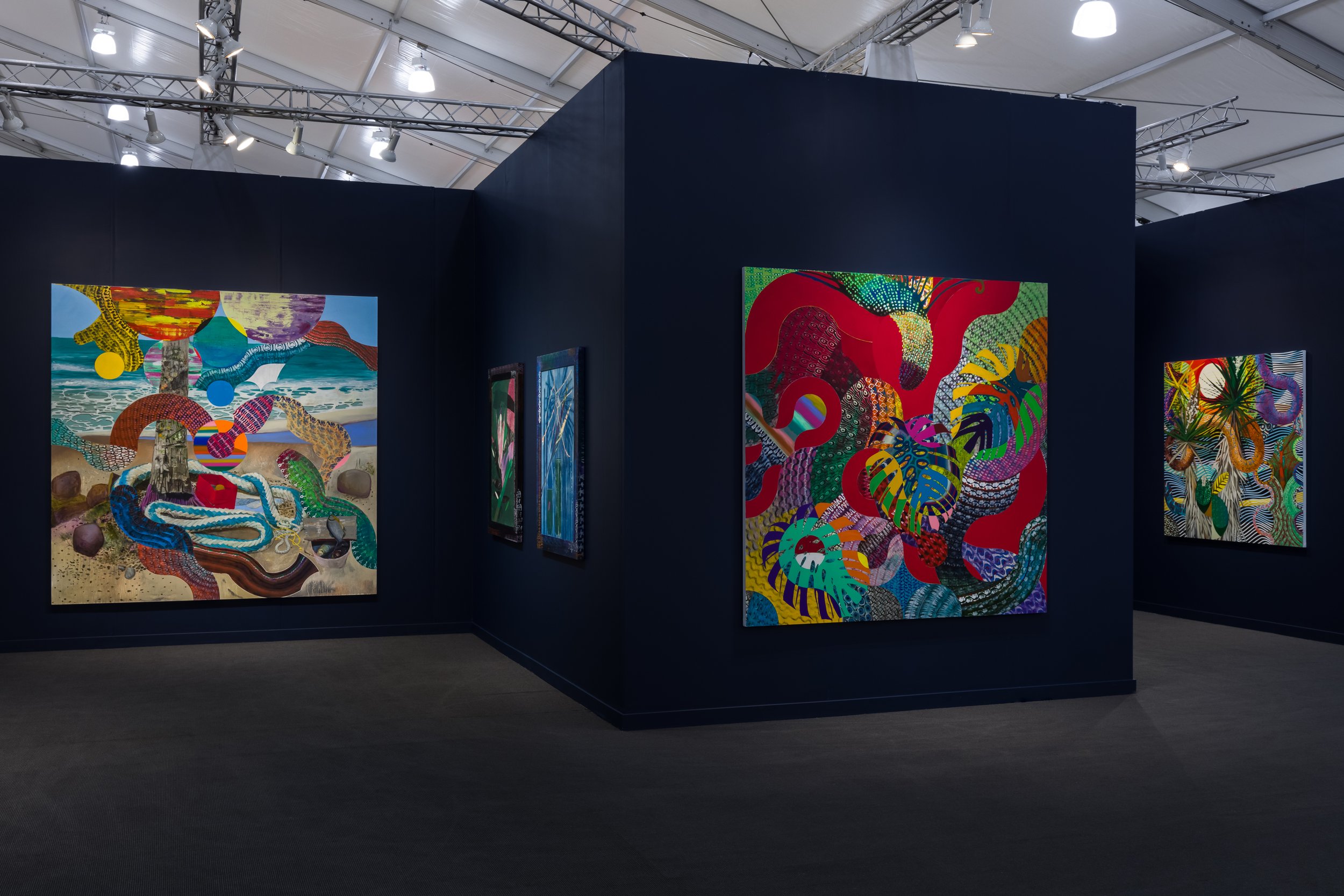
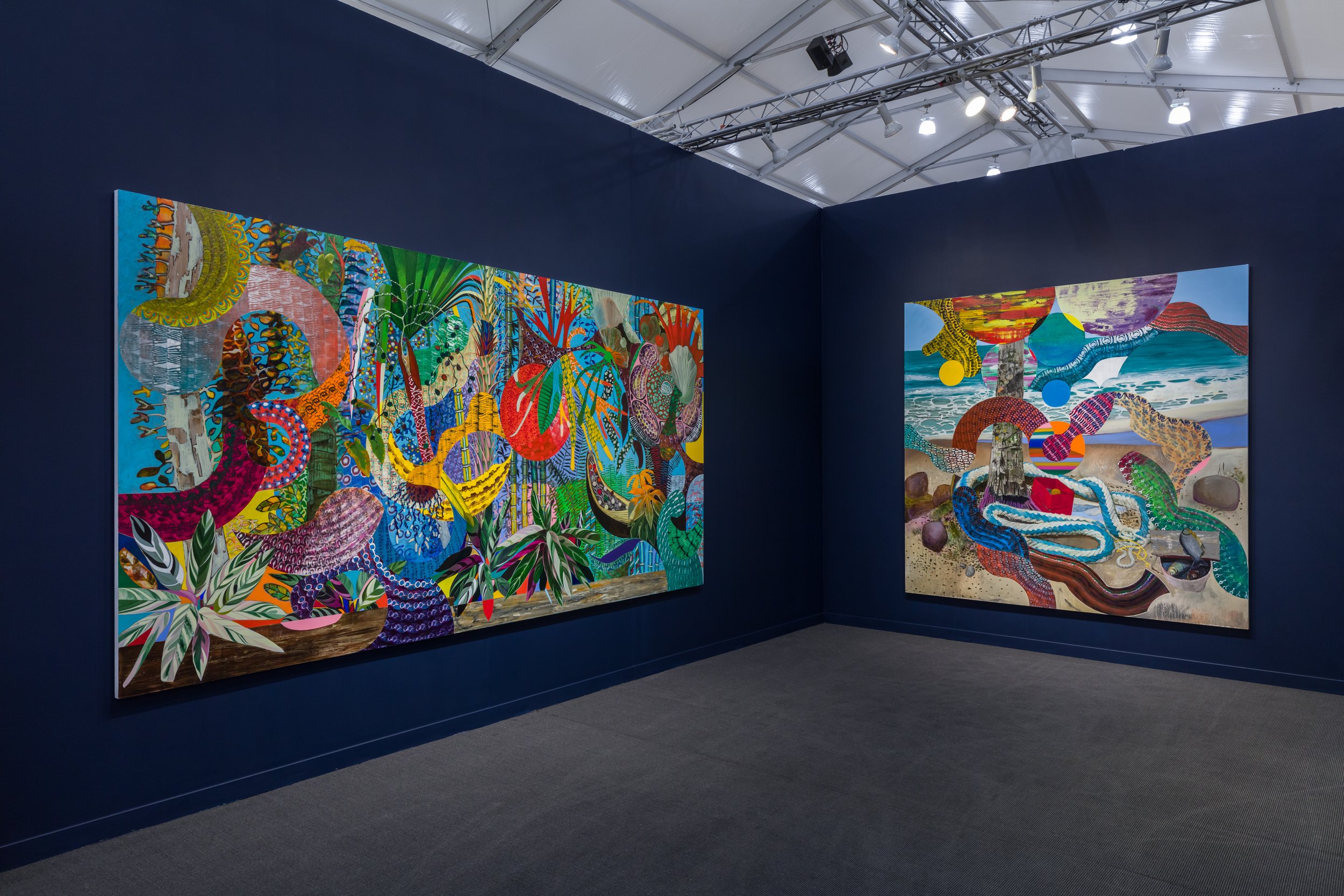
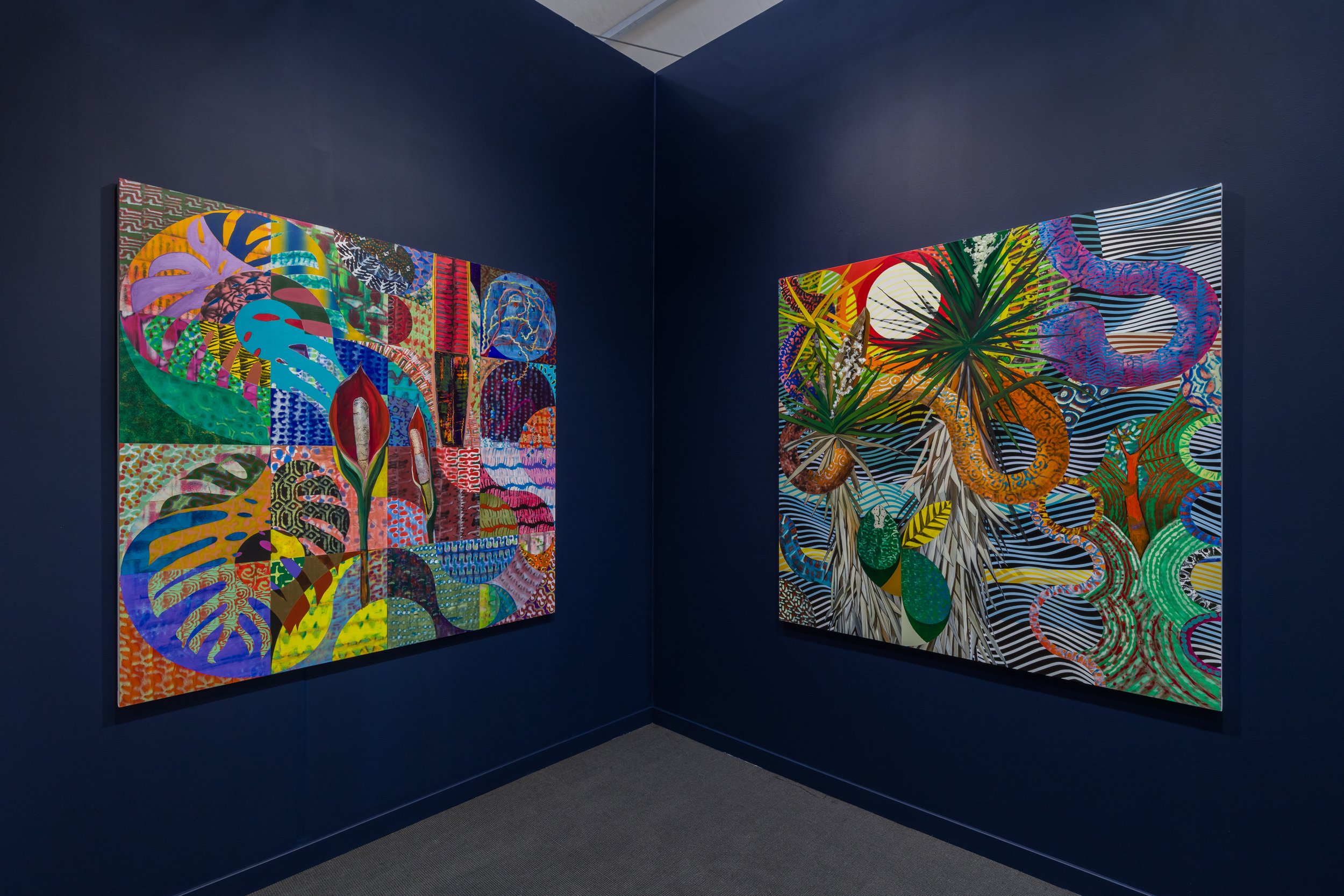

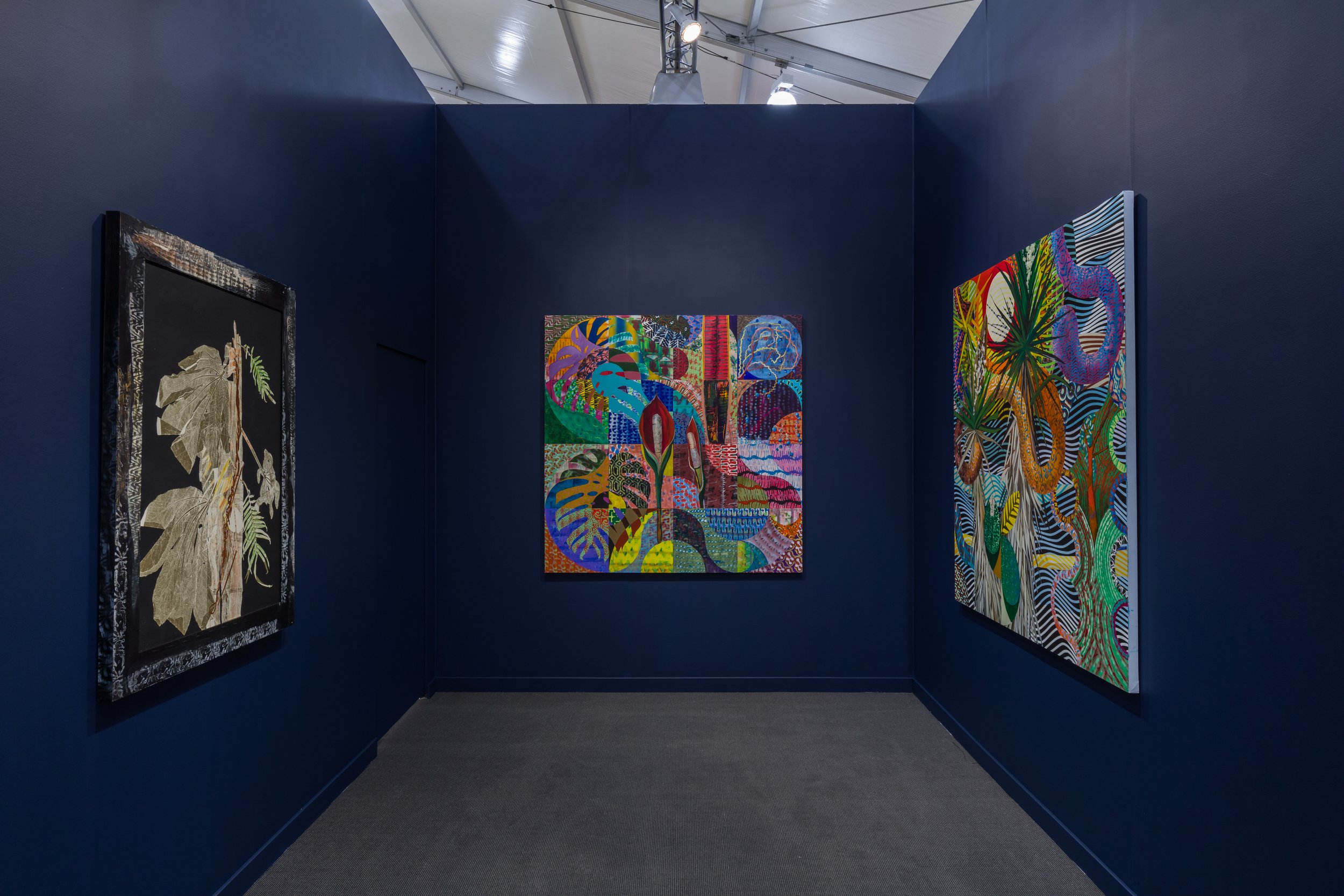
Installation views: Luiz Zerbini at Frieze LA (2024). Courtesy Stephen Friedman Gallery, London and New York. Photo by Mark Blower.
Zerbini’s monotypes echo the collaged appearance of his paintings, combining abstract mark making with figurative elements drawn from his everyday surroundings. “For me, I would pass the whole world through the press,” the artist declares. In these new monotypes, Zerbini hand-paints the frames, marking a significant development in the artist’s monotype series.
Luiz Zerbini, 'Serpentário', 2023. Acrylic on canvas, 160 x 160cm (63 x 63in). Copyright Luiz Zerbini. Courtesy the artist and Stephen Friedman Gallery, London and New York. Photo by Pat Kilgore.
Luiz Zerbini
Luiz Zerbini was born in São Paulo in 1959 and lives and works in Rio de Janeiro, Brazil. In 2023, Zerbini had a solo focus in the group exhibition ‘We Are Forest’ at the Triennale di Milano, Milan, Italy; touring from Fondation Cartier Pour l’Art Contemporain, Paris, France (2020). A major exhibition by the artist opened at Museu de Arte de São Paulo, Brazil, in March 2022. Zerbini’s second solo show at Stephen Friedman Gallery took place in January 2021, following his exhibition in 2020 at Oi Futuro, Rio de Janeiro, Brazil. ‘Luiz Zerbini: Intuitive Ratio’, his first solo exhibition at a UK public institution, opened in 2018 at South London Gallery, London, UK.
Zerbini has been the subject of major mid-career surveys at Casa Daros, Rio de Janeiro (2014); Instituto Inhotim, Brumadinho, Minas Gerais, Brazil (2013); and Museu de Arte Moderna do Rio de Janeiro (2012). He has represented Brazil at notable biennales, including the São Paulo Biennial (2010 and 1987); Bienal do Mercosul, Brazil (2001); Bienal de La Habana, Cuba (2000); and the Bienal Internacional de Cuenca (1996).
Stephen Friedman Gallery
Stephen Friedman Gallery is a contemporary art gallery that was founded in 1995 with a focus on representing exceptional artists from around the world. Since its inauguration, the gallery has been based in Mayfair, London. In October 2023, the gallery expanded and relocated to Cork Street. In November 2023, the gallery opened its first location outside the UK at 54 Franklin Street in Tribeca, New York.
For more information about Stephen Friedman Gallery please visit their website here. The gallery can also be found on Facebook, Instagram, and Artsy.
The Roof Garden Commission and The Facade Commission at the MET Announcement
Jennie C. Jones (left) and Jeffrey Gibson (right)
On February 27, 2024 The Metropolitan Museum of Art announced the artists for its 2025 commissions. Jennie C. Jones (born 1968, Cincinnati, Ohio) will produce her first multi-work outdoor sculptural installation for the Museum’s Iris and B. Gerald Cantor Roof Garden. For The Met Fifth Avenue facade, Jeffrey Gibson (born 1972, Colorado Springs, Colorado), a member of the Mississippi Band of Choctaw Indians and of Cherokee descent, will create four figurative sculptures—works that he refers to as ancestral spirit figures.
The Roof Garden Commission: Jennie C. Jones will be on view from April 15 through October 19, 2025. The Facade Commission: Jeffrey Gibson will be on view from September 2025 through May 2026.
The Met previously announced its 2024 commissions: The Roof Garden Commission: Petrit Halilaj will be on view from April 29 through October 27, 2024; The Facade Commission: Lee Bul, from September 12, 2024, through May 27, 2025; and The Great Hall Commission: Tong Yang-Tze, from November 21, 2024, through April 8, 2025.
“As we anticipate the start of The Met’s 2024 commission series, we are thrilled to expand on the already robust program with the announcement of our exciting 2025 commission projects by the esteemed artists Jennie C. Jones and Jeffrey Gibson,” said Max Hollein, The Met’s Marina Kellen French Director and Chief Executive Officer. "Though stylistically different, both Jones and Gibson see the potential for beauty and form to carry the potency of individual and cultural histories. We're honored to have them join this important commission series and look forward to unveiling their works in 2025.
Through her sculptural installation for the 2025 Roof Garden Commission, Jones will explore the sonic potential of stringed instruments as well as their formal possibilities. In Jones’s unique response to modernism, these acoustic sculptures propose the line of the string as a proxy for art history, unbroken and continuous.
Gibson’s project for The Met’s Fifth Avenue facade will be the sixth in a series of commissions for the historic exterior. The artist’s new works for the niches will draw upon his longstanding and highly developed iconography, one built upon a dynamic visual language that fuses Indigenous identity and imagery with abstraction, patterning, materiality, and text. These projects are the latest in The Met’s series of contemporary commissions in which the Museum invites artists to create new works of art, establishing a dialogue between the artist's practice, The Met collection, the physical Museum, and The Met's audiences.
About the Artists
Jennie C. Jones, Other Octaves, 2024 Acrylic, acoustic panel, and architectural felt on canvas 48 x 48 x 2 1/2 in (121.9 x 121.9 x 6.3 cm) Courtesy the artist and Alexander Gray Associates, New York
Jennie C. Jones
In her paintings, sculptures, works on paper, installations, and audio compositions, Jones uses sound to respond to the legacy of minimalism and to modernism itself. Drawing on her immersion in Black improvisation and avant-garde music, she deploys sound and listening as important conceptual elements of her practice, from the acoustic fiberglass panels she affixes to canvas, which absorb sound and affect the acoustic properties of the environment, to the lines and bars she creates through her compositions that refer to elements of musical notation. Her work across media offers new possibilities for minimalist abstraction, challenging how—and by whom—it is produced.
Jennie C. Jones: New Compositions, Installation view Alexander Gray Associates, New York (2021) Courtesy the artist and Alexander Gray Associates, New York
Her solo exhibitions include Jennie C. Jones: Compilation, at the Contemporary Art Museum Houston (2015–16); Jennie C. Jones: RPM, at the Glass House (2018); Jennie C. Jones: Constant Structure, at the Arts Club Chicago (2020); and, most recently, Jennie C. Jones: Dynamics, at the Solomon R. Guggenheim Museum. Jones’s work is held by numerous public and private collections across the United States, including the Art Institute of Chicago; Cleveland Museum of Art; Hirshhorn Museum and Sculpture Garden; Los Angeles County Museum of Art; The Museum of Modern Art; Philadelphia Museum of Art; Solomon R. Guggenheim Museum; the Walker Art Center; and the Whitney Museum of American Art, among many others. She lives and works in Hudson, New York.
Installation view: ‘Jeffrey Gibson: DREAMING OF HOW IT’S MEANT TO BE’, Stephen Friedman Gallery, London (2024). Courtesy Stephen Friedman Gallery, London and New York. Photo by Lucy Dawkins.
Jeffrey Gibson
An interdisciplinary artist who grew up in the United States, Germany, and Korea, Gibson’s expansive body of work ranges from hard-edged abstract works to a rich practice of performance and filmmaking to significant work as artist convener and curator. Since the 2000s, Gibson’s work—which incorporates Indigenous identity and imagery—has consistently reimagined new possibilities for abstraction, the use of text, and queer culture, interconnecting these formal and conceptual interests. Notably, Gibson’s work has introduced a broad range of recurring Indigenous sources, material elements, and imagery while regularly offering a critique of the reductive ways in which Indigenous culture has been historically flattened and misappropriated.
Jeffrey Gibson Can’t Take My Eyes Off of You, 2015 Mixed media Dimensions variable Courtesy the artist and Stephen Friedman Gallery, London and New York
Recent solo exhibitions include This Burning World: Jeffrey Gibson (ICA San Francisco, 2022); Jeffrey Gibson: The Body Electric (SITE Santa Fe, 2022); Jeffrey Gibson: They Come From Fire (Portland Art Museum, 2022); Jeffrey Gibson: INFINITE INDIGENOUS QUEER LOVE (deCordova Sculpture Park and Museum, 2022); and Jeffrey Gibson: Like a Hammer (Denver Art Museum, 2018). Most recently, Gibson was selected to represent the United States at La Biennale di Venezia, the 60th International Art Exhibition, in 2024. Gibson also conceived of and co-edited the landmark volume An Indigenous Present (2023), which showcases diverse approaches to Indigenous concepts, forms, and media. His work is included in the permanent collections of the Denver Art Museum; Museum of Fine Arts, Boston; The Museum of Modern Art, New York; National Gallery of Canada; Portland Art Museum; Smithsonian National Museum of the American Indian; and the Whitney Museum of American Art, among others. Gibson has received many distinguished awards, including the John D. and Catherine T. MacArthur Foundation Fellowship Award (2019), and is currently an artist in residence at Bard College, in Annandale, New York. He lives and works in Hudson, New York.
Credits
The Roof Garden Commission: Jennie C. Jones is conceived by the artist in consultation with Lauren Rosati, Associate Curator in the Department of Modern and Contemporary Art and Research Projects Manager in the Leonard A. Lauder Research Center for Modern Art at The Met.
The Facade Commission: Jeffrey Gibson is conceived by the artist in consultation with Jane Panetta, the Aaron I. Fleischman Curator in the Department of Modern and Contemporary Art at The Met. The commission is made possible in part by Oscar L. Tang and H.M. Agnes Hsu-Tang, Sarah Arison, and Helen Lee-Warren and David Warren.
For more information about this announcement and the Met Gala, please visit the Met’s website and also visit their Instagram, YouTube, Facebook pages.
AMIR FATTAL | POST-ARTIFICIAL PAINTINGS
Amir Fattal: Post Artificial Paintings Installation View: KÖNIG TELEGRAPHENAMT, Berlin, 2024. Photo: Courtesy of the artist & KÖNIG GALERIE
KÖNIG TELEGRAPHENAMT is pleased to present POST-ARTIFICIAL PAINTINGS, a solo exhibition by Amir Fattal, born in Tel Aviv in 1978 and based in Berlin since 2002. On display at Telegraphenamt are new oil paintings from the series STUDIO VISITS, which interpret classical art world scenes for the 21st century. Fattal begins each of his works with a series of keywords and prompts that coax a fictional portrait out of the depths of the "collective unconscious" of artificial intelligence. The subjects are various protagonists of an idealized "art world" – from artists with models in their studios to collectors in their homes to art dealers in their offices. They all pose with one of their most prized possessions: an "artwork within an artwork". This second artwork is also the product of AI, generated according to the specific aesthetics and values of each protagonist depicted.
The figures in Fattal’s paintings embody the ideals of the present, placeholders for wealth, style, elegance, sophistication, and artistic sensibility. Displaying an impeccable taste for designer garments and existing among their carefully arranged furniture and displaying expressions of unfettered self-confidence, Fattal’s protagonists are almost too perfect to be true. They are both a product and a commentary on our society, a mirror reflecting the various ways our collective data is harnessed to dream up new realities.
Roy, 2023, Oil on canvas, 90 x 80 cm, Courtesy of the artist & KÖNIG GALERIE
In Fattal’s paintings, the typical Californian, mid-century bungalows with their glass fronts and turquoise pools and leather couches, can be found, evoking parallels to a number of predecessors in this genre: David Hockney’s LA domiciles, the everyday nature of Eric Fischl’s sitters, and the staging of the individual in Cindy Sherman’s self-portraits. Fattal’s works introduce the AI prompt as a compelling new technique for art production, building an inherent curiosity as to the linguistic locutions that were given to generate the resulting images. The figures are at once both ambitious and aspirational, with the subtly coded "je ne sais quois" of a 21st century aristocracy – understated and discreet, confident, and breathtakingly determined in their aesthetic choices and appearance.
In this series, Fattal has blurred the lines between reality and imagination, creating characters that are composites of cultural ideals. They are the embodiment of an art world that doesn’t exist just within the confines of galleries and studios but extends into the spaces we inhabit and the lives we aspire to lead. This series does not merely capture the zeitgeist; it is a zeitgeist in itself, a realm where the lines between the real and the artificially conceived are not just blurred but interwoven.
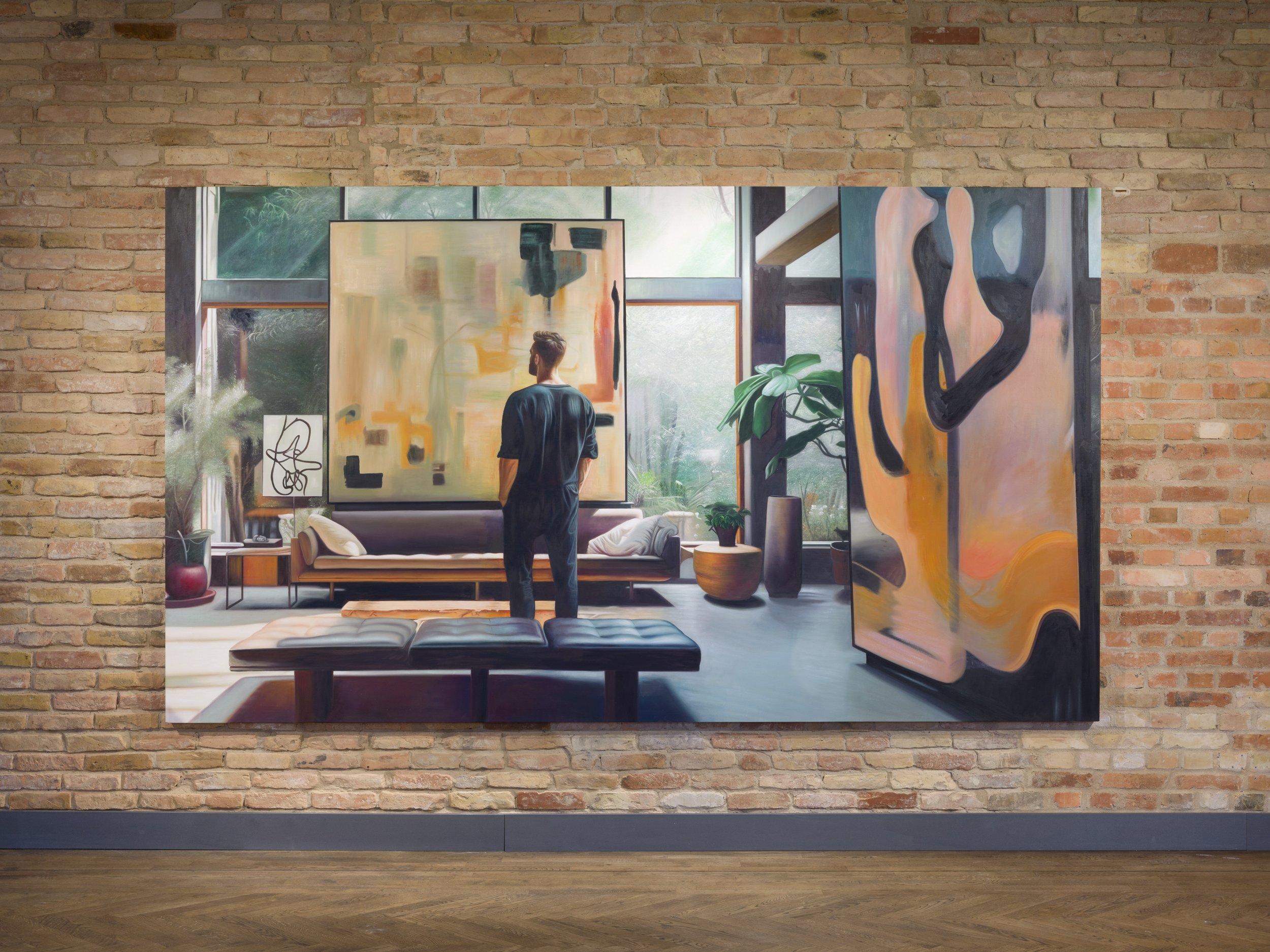
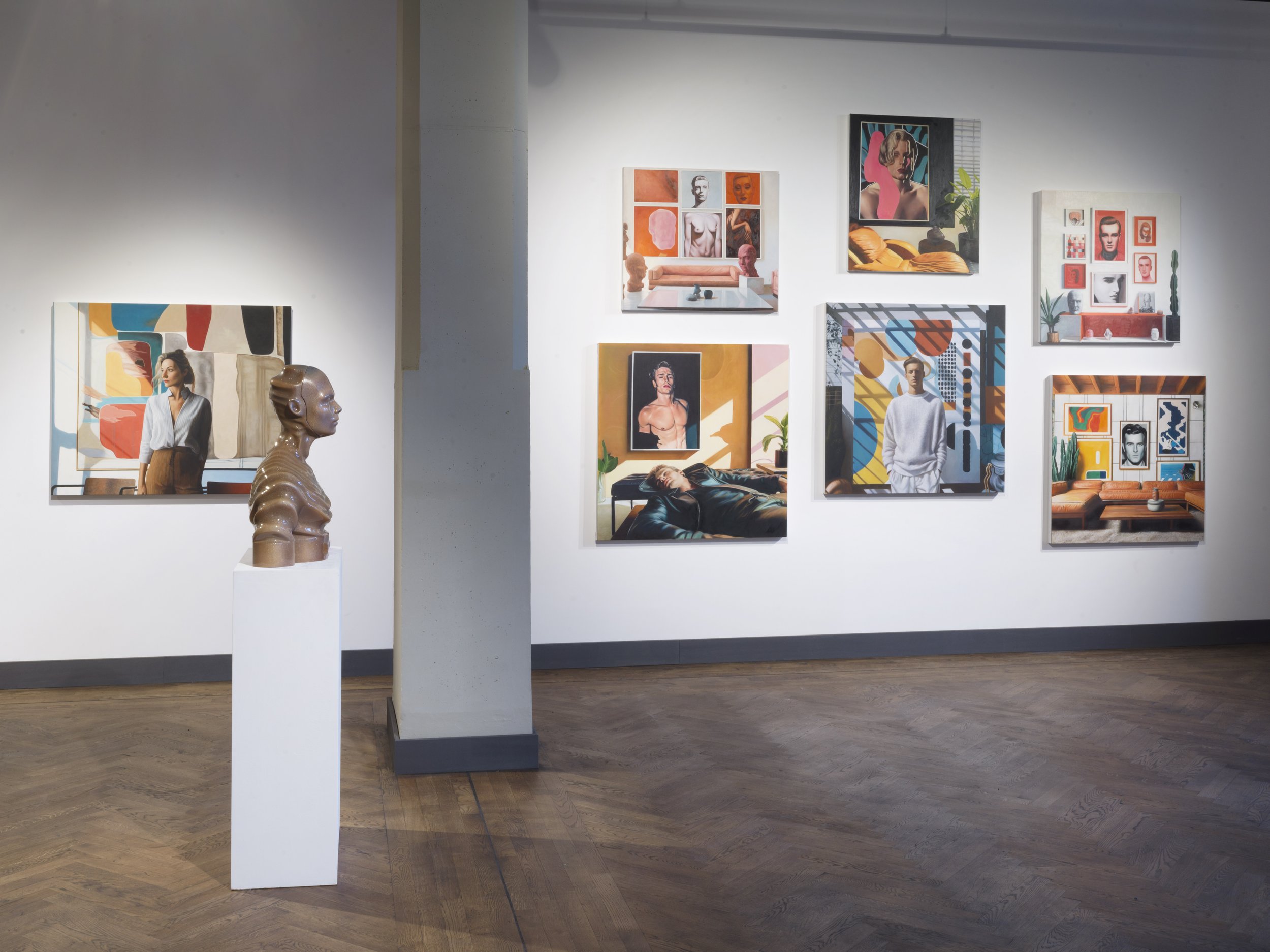


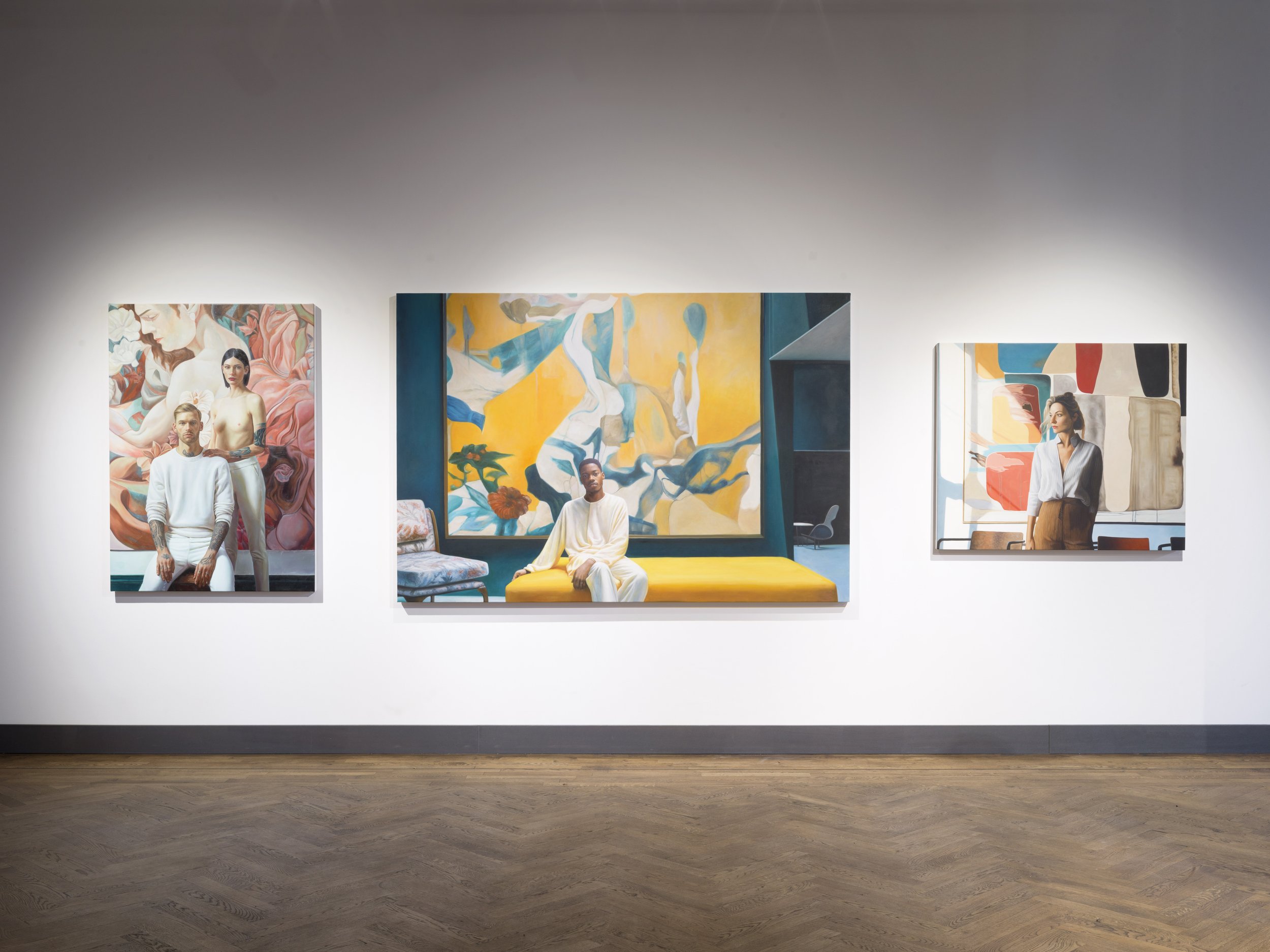
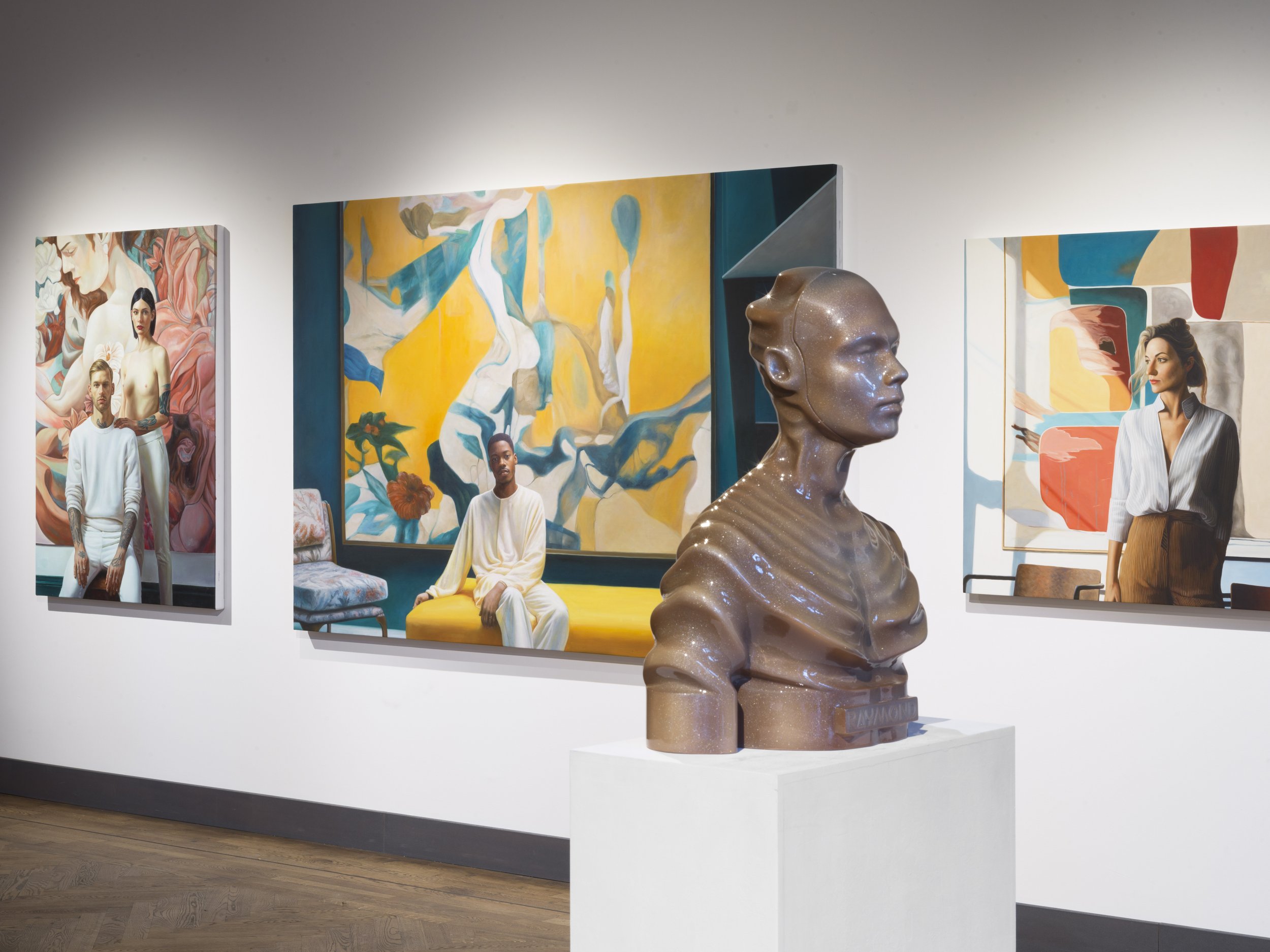
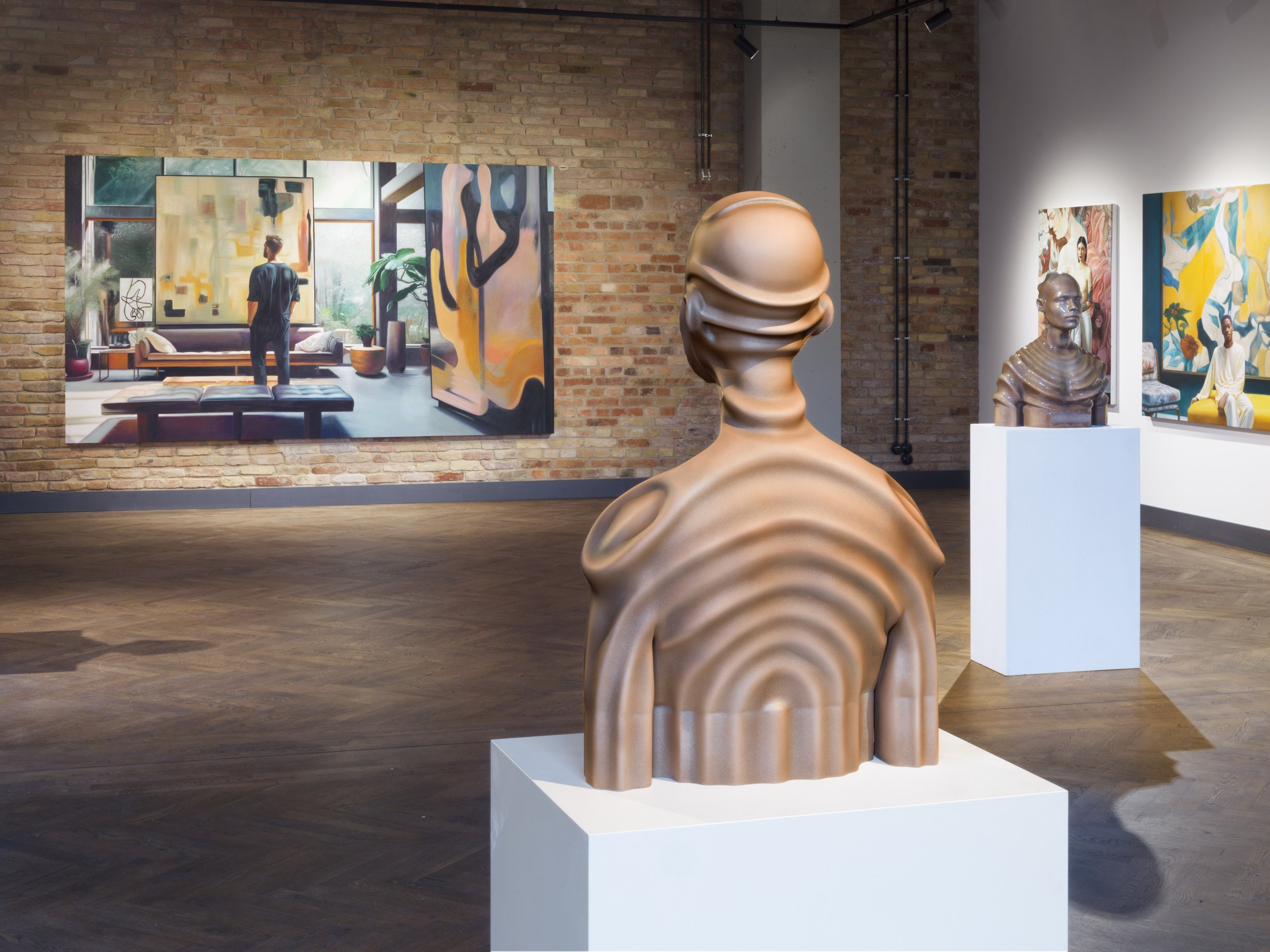
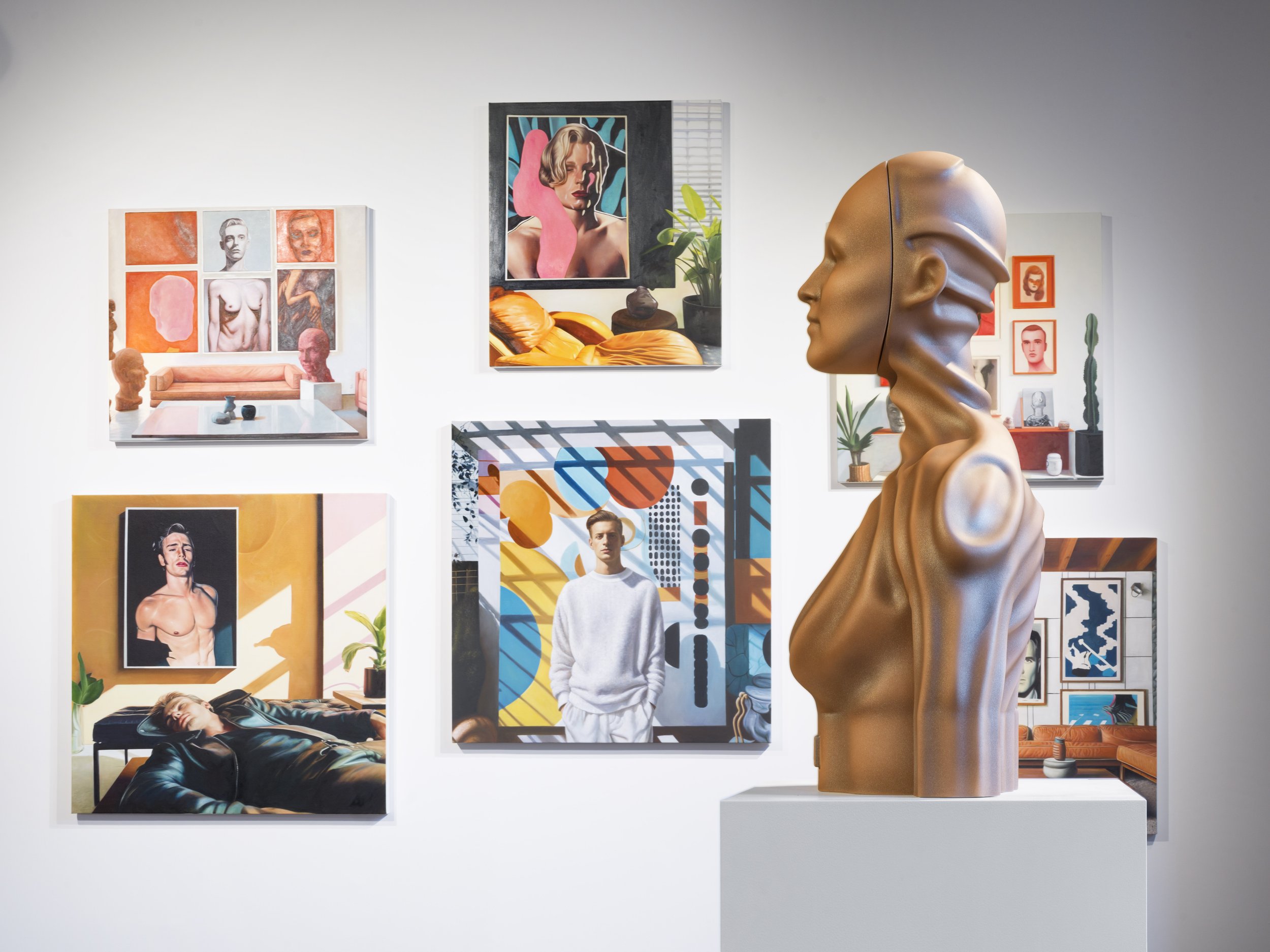
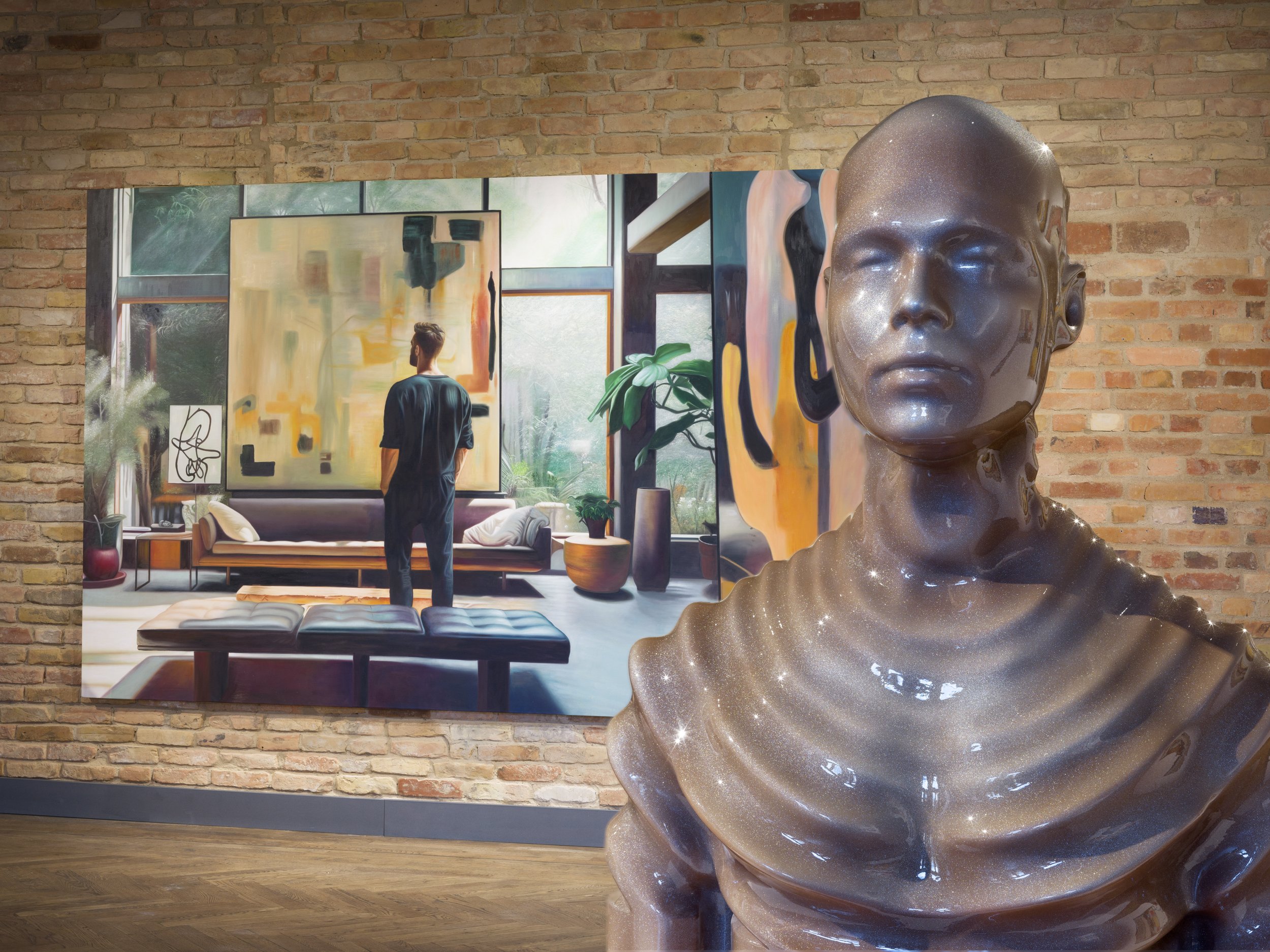
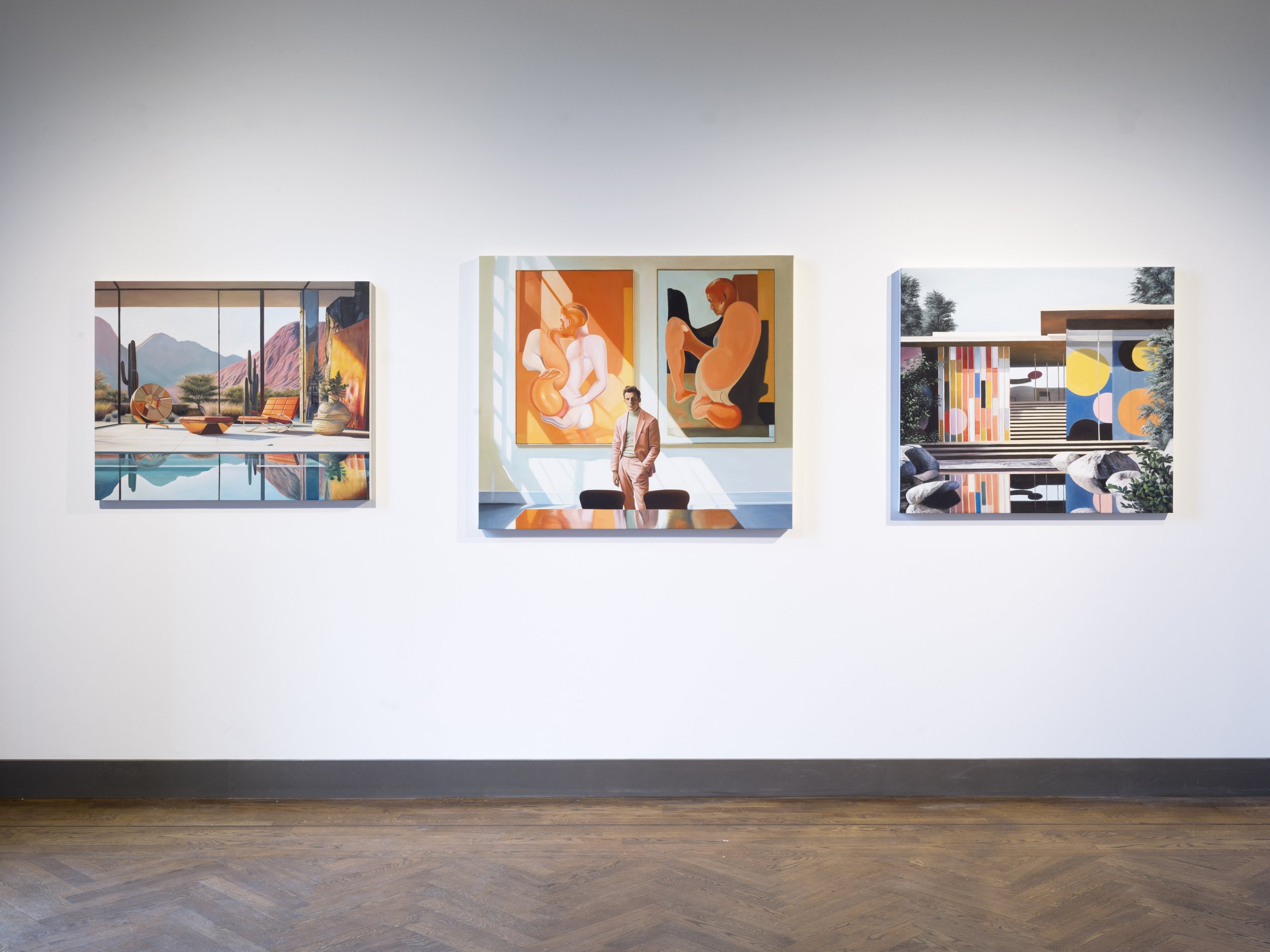
Amir Fattal: Post Artificial Paintings Installation View: KÖNIG TELEGRAPHENAMT, Berlin, 2024. Photo: Courtesy of the artist & KÖNIG GALERIE
In order to focus on the collaboration between artist and AI and create an emotional distance to the finished works, Fattal leaves the actual realization of the oil on canvas AI-generated images to a painting workshop in China. In so doing, Fattal draws attention to the tradition of painting as a medium of copying, employed as such for thousands of years, until the invention of photography. Copying also provides the opportunity to reflect more closely on the social conditions surrounding images, such as the globalization of their modes of production, the artistic value of AI technology, and the role of capitalism more generally.
Amir Fattal: Post Artificial Paintings Installation View: KÖNIG TELEGRAPHENAMT, Berlin, 2024. Photo: Courtesy of the artist & KÖNIG GALERIE
In his project LOVE CHILD, from which three sculptures are included in the exhibition, Fattal combines a new DNA visualization technology with 3D scanning and printing. With this technology, originally developed for forensic science, a person’s facial features can be reconstructed based on data extracted from raw DNA. Fattal goes one step further, though, by combining the DNA of six of his closest friends to create composite facial realizations of how their potential offspring might look. The DNA visualized using the 3D printer is ultimately a combination of the two test subjects in bust form, with their surfaces finished by hand, giving the generated figures a futuristic, yet somehow individualized, look.
Antonio, 2023, Oil on canvas, 150 x 220 cm, Courtesy of the artist & KÖNIG GALERIE
Rich Mnisi: Dzuvula (Shedding Skin)
Installation view of Rich Mnisi’s Dzuvula (Shedding Skin), 2024. Southern Guild Cape Town. Image courtesy of Hayden Phipps/Southern Guild.
Southern Guild Cape Town presents Dzuvula (Shedding Skin), a solo exhibition of collectible design by Rich Mnisi, from 8 February to May 23, 2024. Comprising sculptural bronze furniture and lighting, as well as a hand-woven limited-edition rug, Dzuvula is an expansion on the cosmology of duality that emerged with the designer’s debut collection, Nyoka (2021). The body of work complicates the interplay of the mundane and the magical, the matriarchal and magisterial – themes that have emanated from the artist’s embrace of fluidity as a guiding philosophy and aesthetic approach.
The snake – with its embodiment of fear and beauty – makes a reappearance in Dzuvula, the undulating arcs of its movement distorting and disrupting borders and edges. A hiss resounds through this collection, a sensuous whisper hinting at something deviant, rubbing against boundaries, smoothing hard gradients, holding within its resonant sound conflicting truths and contrasts.
A polished bronze table, titled Mbhoni (Witness), bulges and swells outwards, held up on a serpentine limb that at once embraces and impales it. A pair of sculptural seats, Ripfumelo I and Ripfumelo II, combining bronze armatures and sheepskin seats, introduce a soft lushness to the collection, embodying fear/comfort dualities.
In Vutlhari II (Wisdom), a bronze chandelier, the serpent contorts over and into itself in a manner best described as swirling, consuming wisdom handed down by our forebears. In this edition of the chandelier – a collaboration between Rich Mnisi and designer Charles Haupt that debuted in Nyoka – the shades have been printed with an intricate snakeskin pattern.
Installation view of Rich Mnisi’s Dzuvula (Shedding Skin), 2024. Southern Guild Cape Town. Image courtesy of Hayden Phipps/Southern Guild.
Dzuvula also references Bumba, the Bushongo mythological god who created life by vomiting up elements of the natural world. Shiluva (Flower), a rug in Tibetan wool and silk, depicts the primordial soup of Bumba’s regurgitation of life. Nyoka II, a curved console which also first appeared in Mnisi’s 2021 solo, is punctuated by the winding form of a bronze snake, its storage cavity concealed by richly patterned beading inspired by Mnisi’s 2022 Mafamba Yexe fashion collection.
Collaborating closely with Southern Guild, Mnisi brought his visions to life by working with various artists and artisans including Haupt, Monkeybiz and PACO. This aligns with both Southern Guild and the designer’s commitment to promoting craft and South African handwork.
Collaboration is an incredibly intimate praxis, requiring connection and closeness before it can reach for comprehension. Intimacy as a theme runs throughout Mnisi’s works, in the way their forms hug the body and require the viewer to move around, their silhouettes changing with every view. Nwa-Mulamula’s Embrace (2021) is named after his great grandmother and models its form on the curved shape of the late matriarch. Reworked in concrete for this collection, it is a powerful evocation of the transfer of knowledge between generations, here transmuted into a gesture of peace, reflected in its title, Rhulani (Peace).
Installation view of Rich Mnisi’s Dzuvula (Shedding Skin), 2024. Southern Guild Cape Town. Image courtesy of Hayden Phipps/Southern Guild.
Where Nyoka attempted to hold the frictions and tensions of creation and life, Dzuvula expands on this world to draw parallels between the snake’s duplexity and our own conflicting nature. Nyoka spoke to creation through regurgitation and the drawing together of things; Dzuvula speaks to the things that quietly encroach in between. This new body of work is the spark created by that friction: the animation of life. Reflective surfaces refract and manipulate light, creating many forms from the teasing apart of one.
“We are at once faithful and faithless, bound and free,” Mnisi notes. “Sustaining existence within life's many tensions defines the human experience. Dzuvula turns the acceptance of this immutable truth into a sensory journey. Every piece reflects the result of growing into oneself – risk and vulnerability, strain and ease – through a vocabulary of forms, patinas, patterns and textures.”
Courtesy of Hayden Phipps/Southern Guild.
ARTIST BIO
Born in Johannesburg in 1991, Rich Mnisi’s broad design vision embraces fashion and functional sculpture. His work flows according to the themes and motifs he returns to and continually pushes forward: the women in his life, queerness and the VaTsonga tribe.
Mnisi graduated from Johannesburg’s LISOF School of Fashion in 2014, following which he was named Africa Fashion International Young Designer of the Year at Mercedes Benz Fashion Week Africa. He founded his eponymous label in 2015, creating genderless, seasonless collections infused with his own personal narrative and heritage.
His first solo exhibition of sculptural furniture, titled Nyoka (meaning snake in Xitsonga), was a bold exploration of shape and fluidity, brought to life through vivid contrasts of forms and materials, including bronze, wool, resin and glass. Mnisi’s work has been presented by Southern Guild at Design Miami and Investec Cape Town Art Fair.
Dzuvula (Shedding Skin) by Rich Mnisi runs concurrently with VIGIL by Justine Mahoney at Southern Guild Cape Town from 8 February – 18 May 23 2024. For more information about this exhibition and others, please visit the Southern Guild Website here; the gallery can also be found on Artsy, Instagram, and Facebook.
Marcela Cantuária : The South American Dream
Marcela Cantuária: The South American Dream Installation View: Pérez Art Museum Miami, 2023. Photo: Oriol Tarridas.
(Miami, FL) — Pérez Art Museum Miami (PAMM) is pleased to present Marcela Cantuária: TheSouthAmericanDream, the artist’s first solo exhibition in the United States featuring all newly commissioned works. The South American Dream will be on view March 23, 2023 through Spring 2024.
The work of Marcela Cantuária (b. 1991, Rio de Janeiro; lives in Rio de Janeiro) often portrays female figures who navigate regional, international, and social boundaries. Highlighting symbols from tarot and astrology as well as themes that reflect political and environmental activism in Latin America, Cantuária weaves together narratives of social spheres, political associations, and ethereal wishes. Cantuária’s vivid and colorful works are evidence of her versatility and investigations through various mediums and techniques, including painting, textile, and ceramics.
Chico Mendes, 2023 Oil and ceramic on canvas 70 3/4 x 98 1/2 inches Courtesy the artist and A Gentil Carioca, Rio de Janeiro
Installation View: Pérez Art Museum Miami, 2023. Photo: Oriol Tarridas.
In her exhibition at PAMM, Cantuária invites the viewer to ponder the nature of the South American dream. Explored within the three main paintings, she accents the narratives of critical South American activists and environmentalists, such as Chico Mendes, Dorothy Stang, Maria do Espírito Santo da Silva, Túpac Amaru, and Juana Azurduy de Padilla—all of whom pursued their dreams through resistance and by fighting for their countries and land.
The South American Dream features three large-scale oil paintings, a vibrant textile map of South America, a wood piece resembling an altar, as well as various panels along the walls of the gallery framing the exhibition. Throughout the space, an arched vinyl wallpaper encloses the paintings while recessed lights illuminate the paintings, creating a halo for each. Overall, the exhibition extends a feeling of sanctitude, inviting the viewer to reflect upon corporeal narratives, ambitions, and the potential of achieving each through faith.
A temperança (The Temperance), 2022–23 Oil and ceramic on canvas 98 1/2 x 70 3/4 inches Courtesy the artist and A Gentil Carioca, Rio de Janeiro
Installation View: Pérez Art Museum Miami, 2023. Photo: Oriol Tarridas.
“Marcela Cantuária has transformed the double-height gallery into a magical space of remembrance, hope, and dream by combining activism with her interests in tarot through vibrant colors and strong symbolisms. I am excited to bring her voice to the US and share with a global audience not only her practice, but the many Latin American narratives that she captures within her work,” said PAMM Associate Curator Jennifer Inacio.
While Cantuária’s research underscores where struggles and injustices lie, her paintings point to the beauty of the fight that often persists in these stories; thus, the paintings become monuments for iconic South American figures who, despite dangers and devastating odds, fought for their visions. In The South American Dream, Cantuária elevates and revives these histories, ideals, and battles, sharing with viewers the richness of South American natural resources that so many struggle to protect.
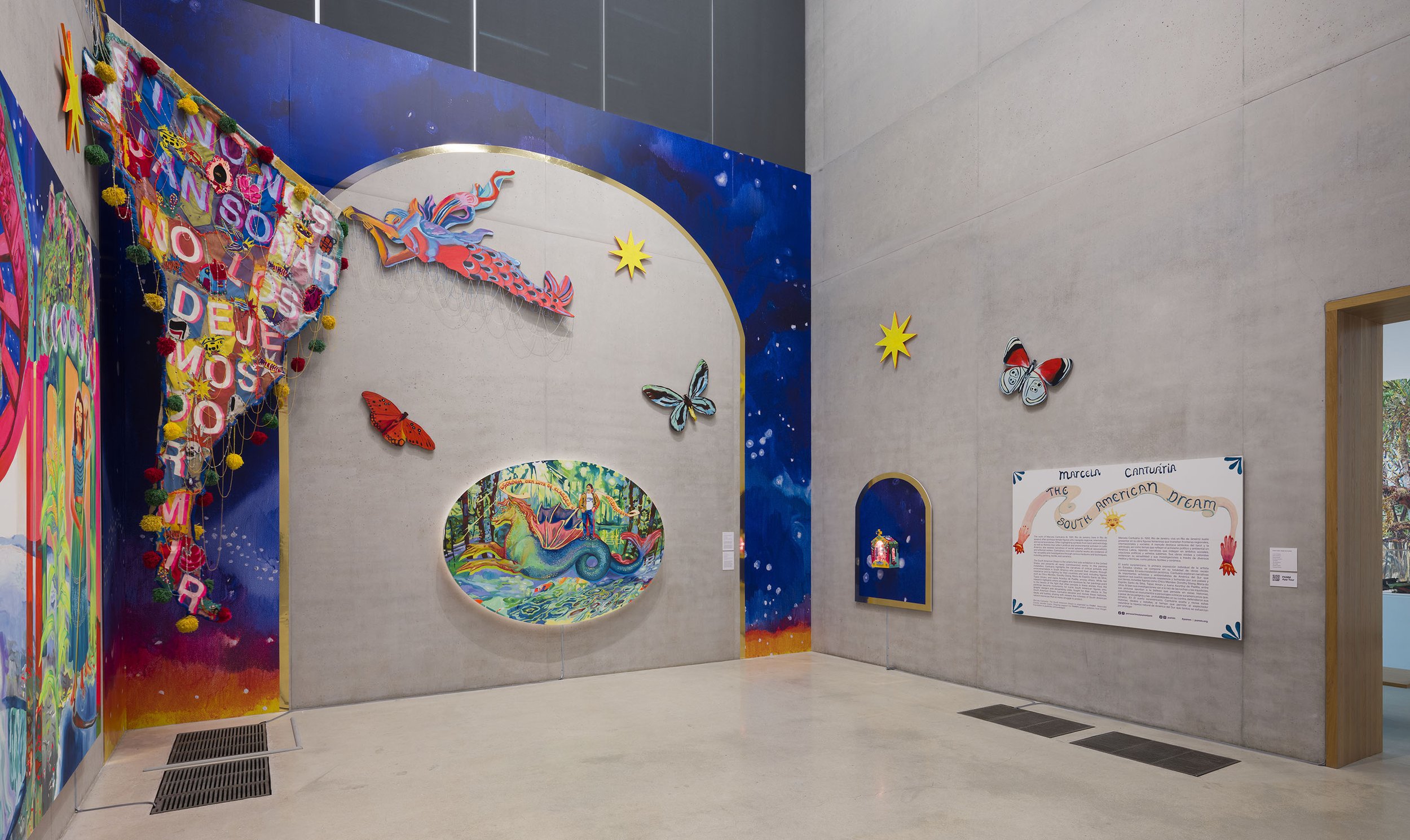
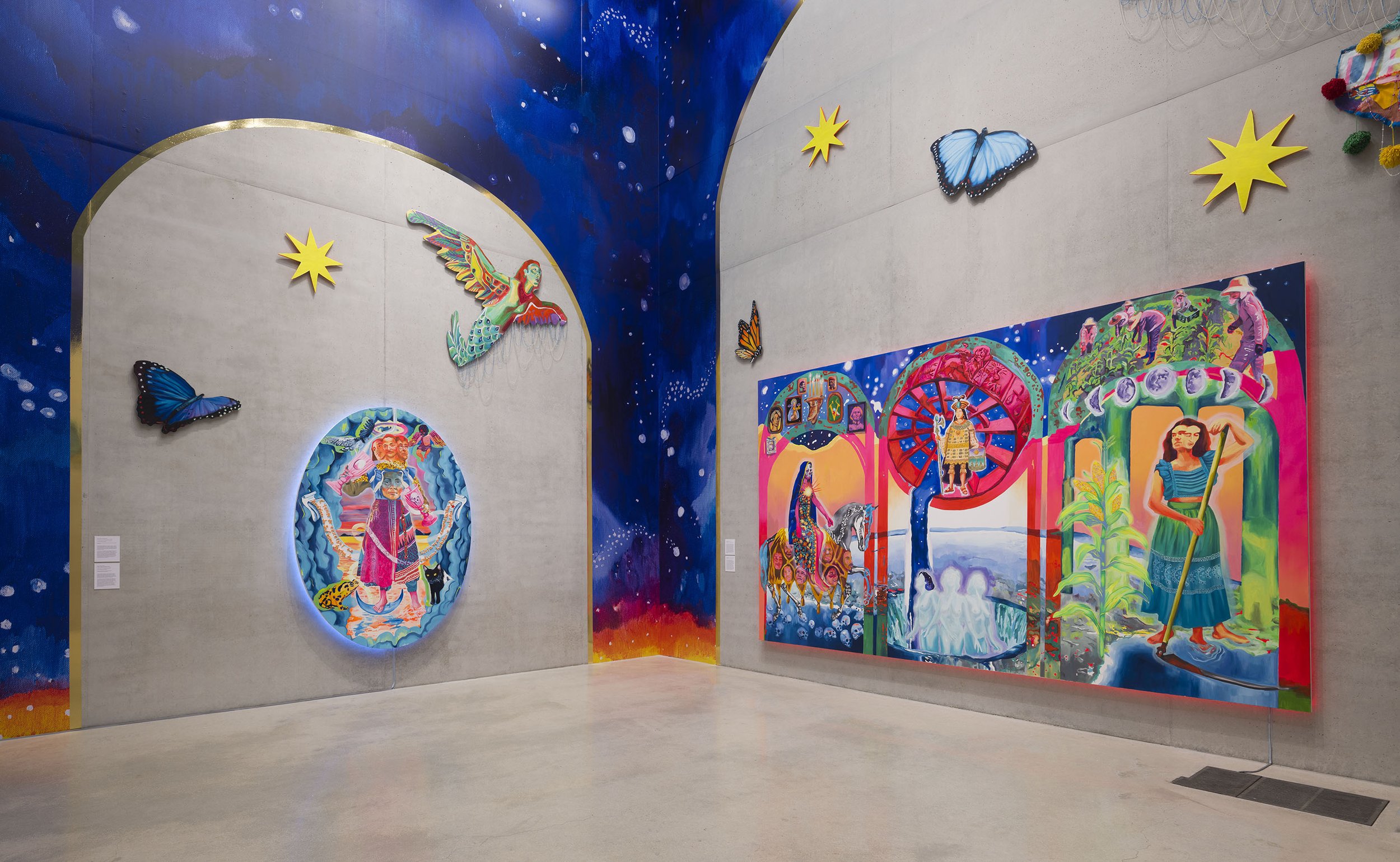
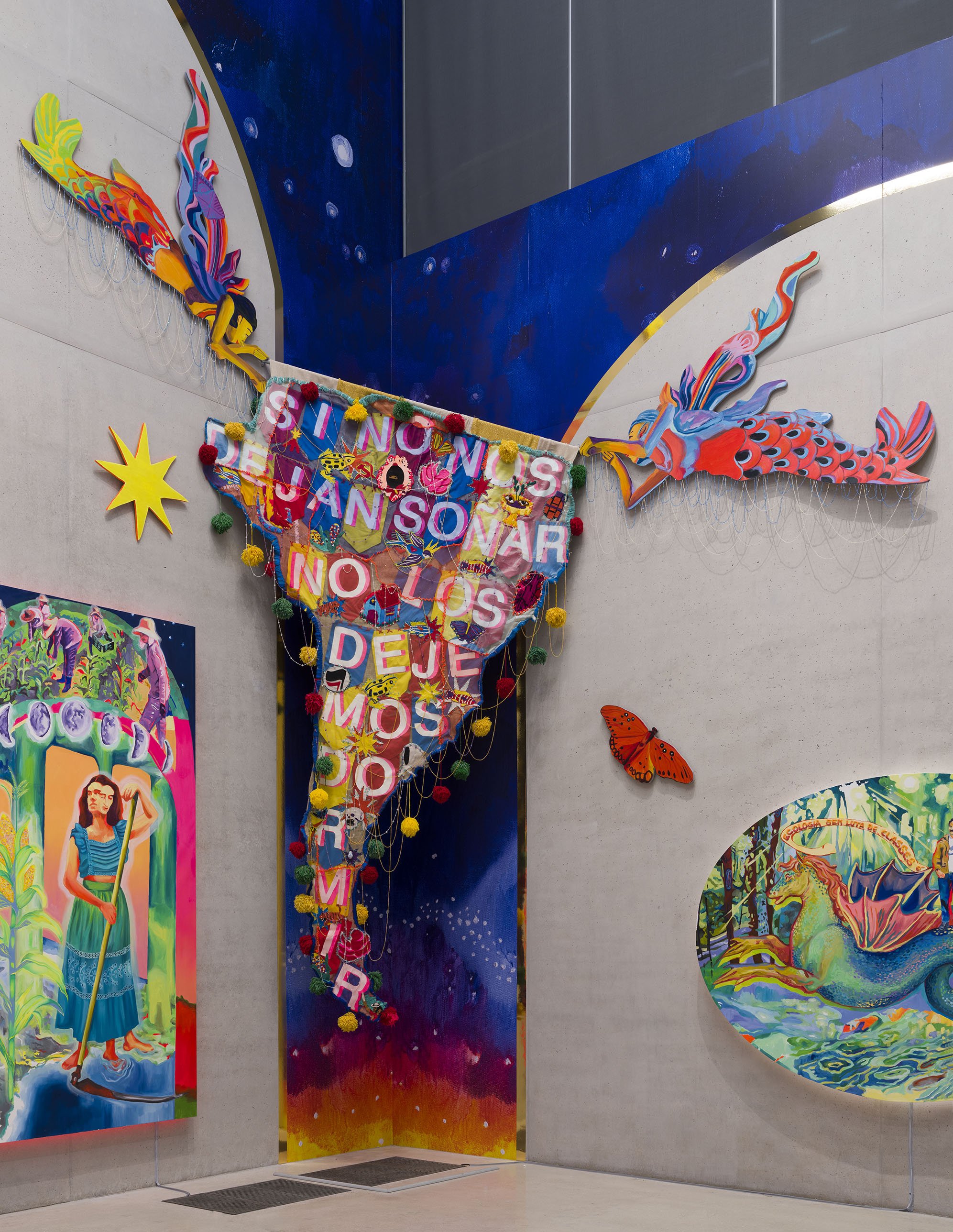
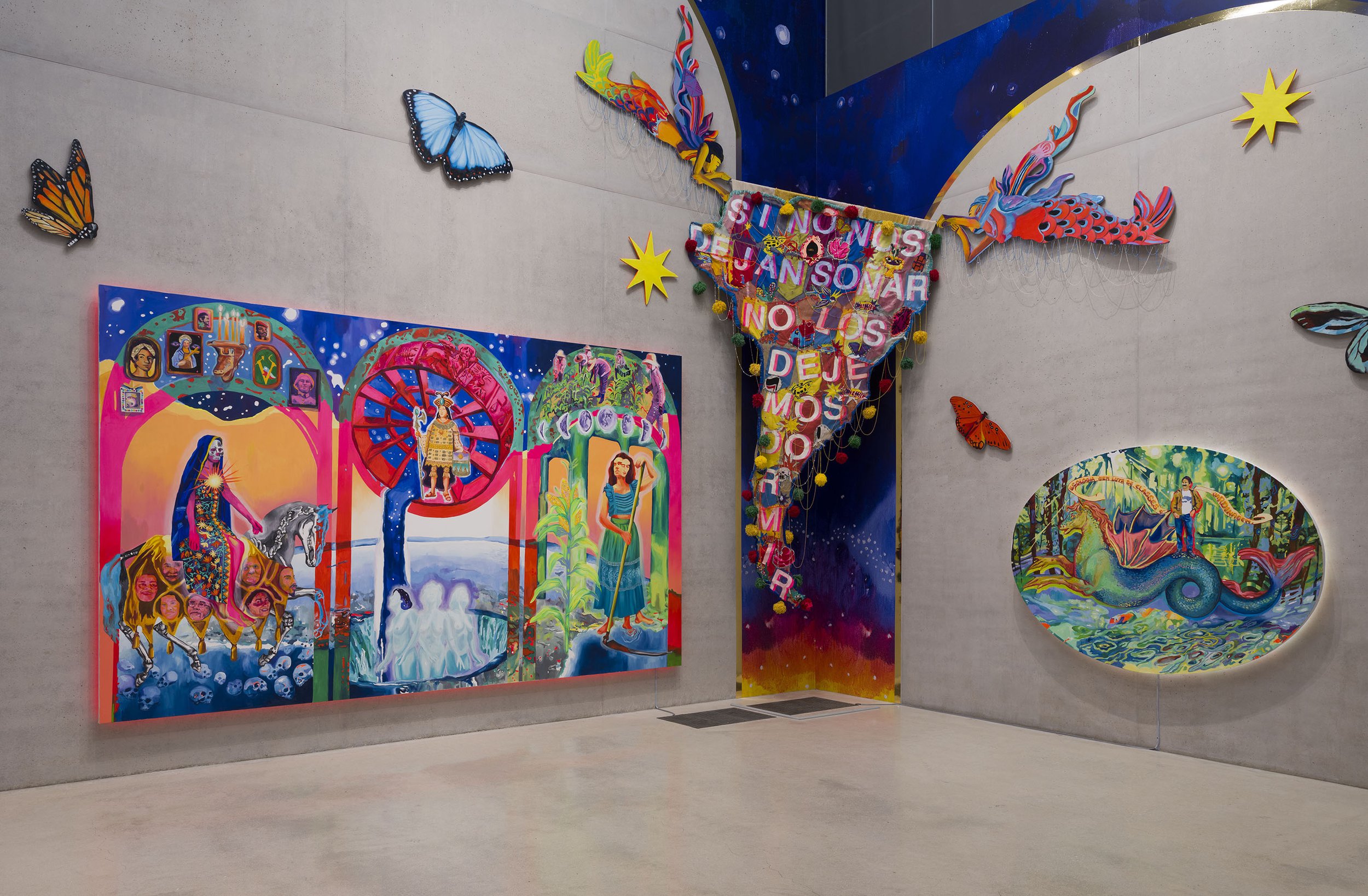
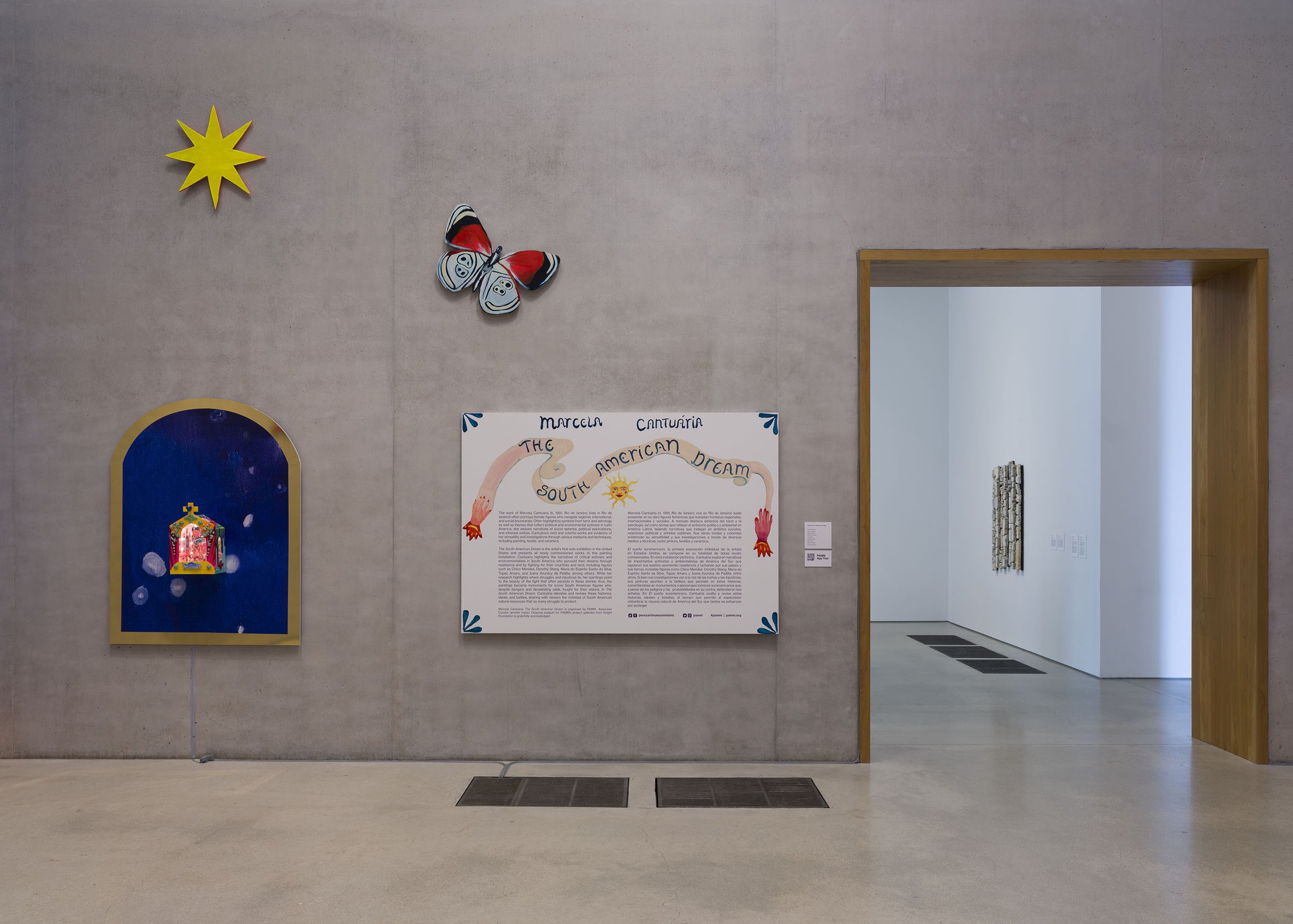
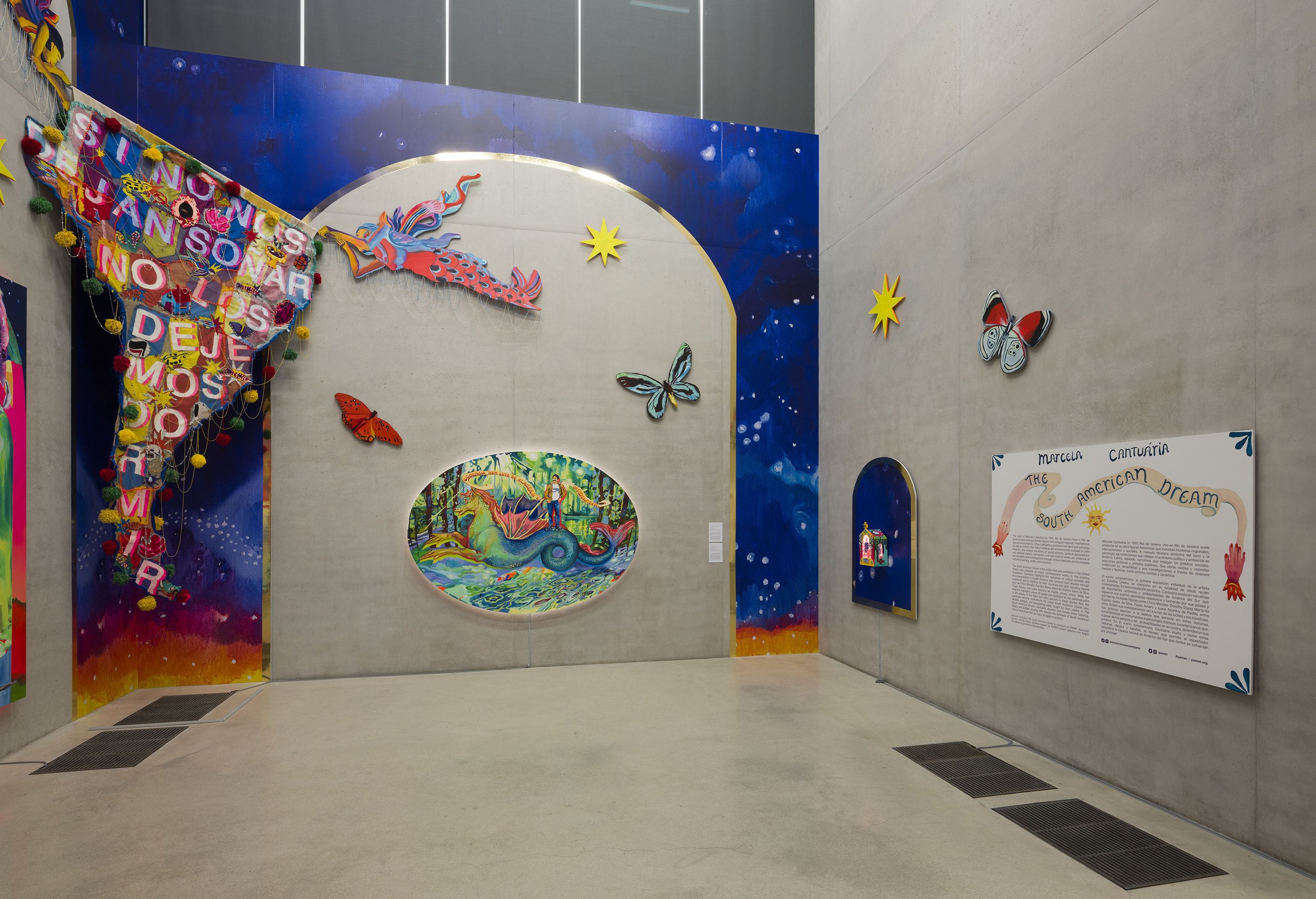
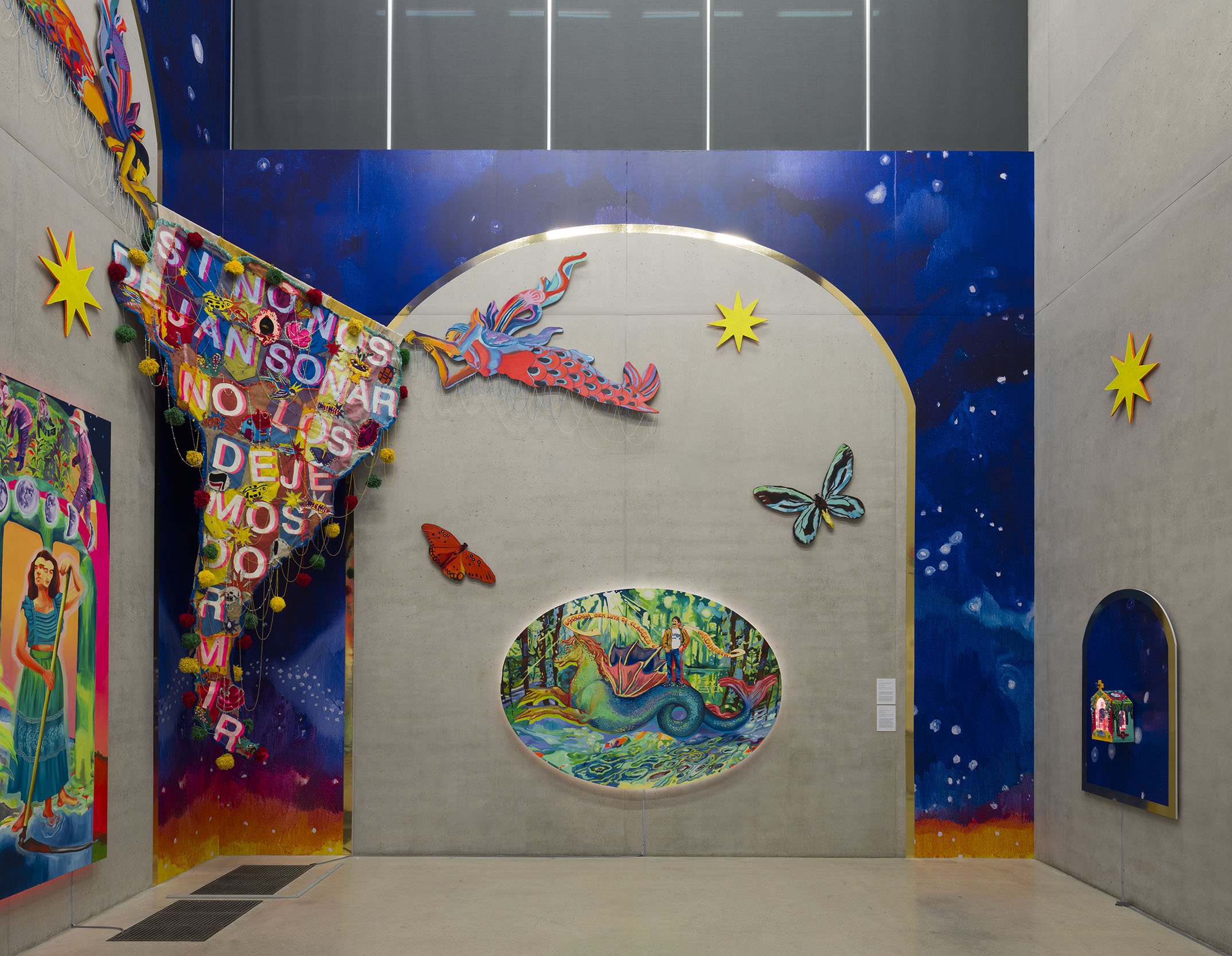
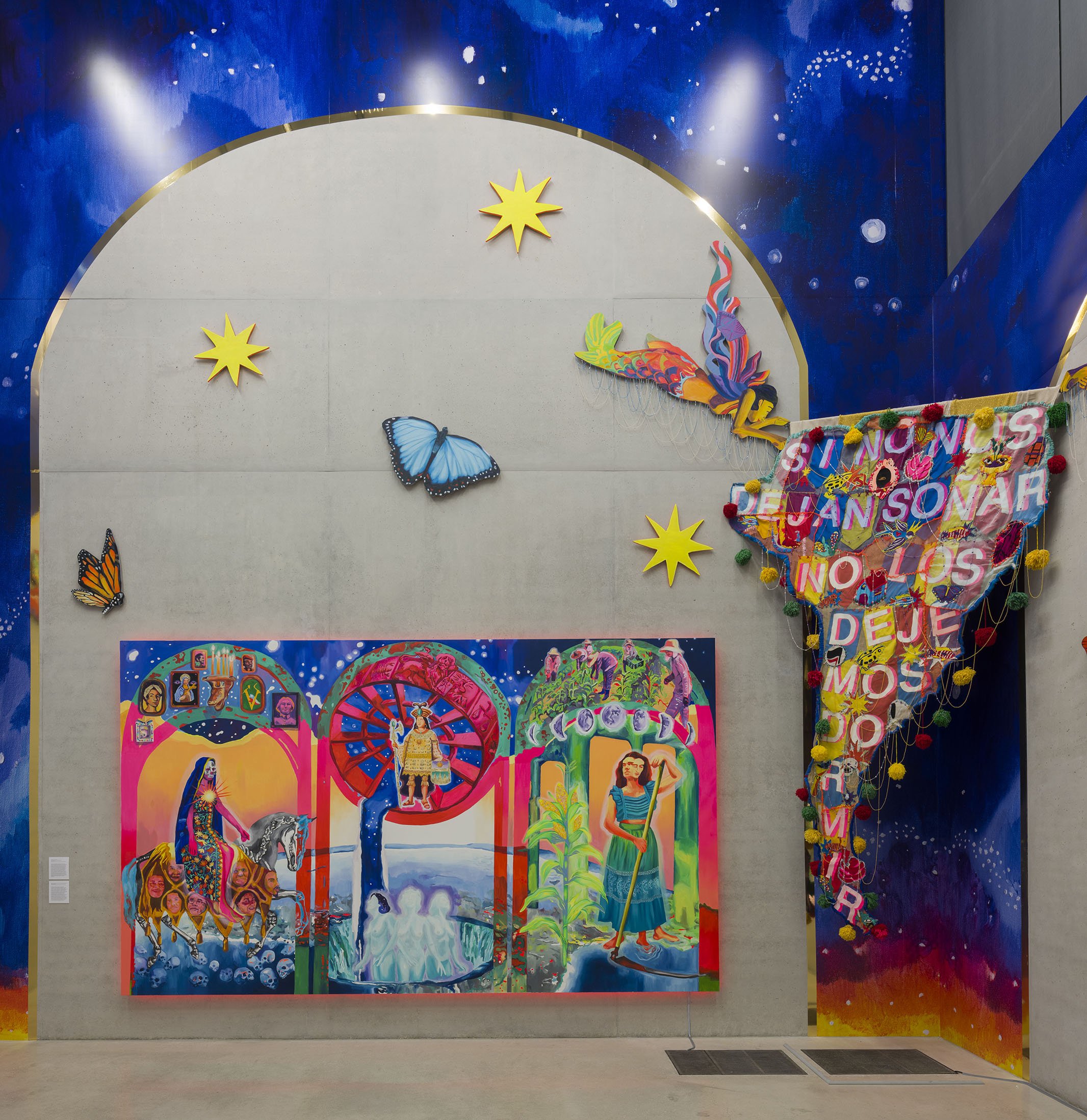
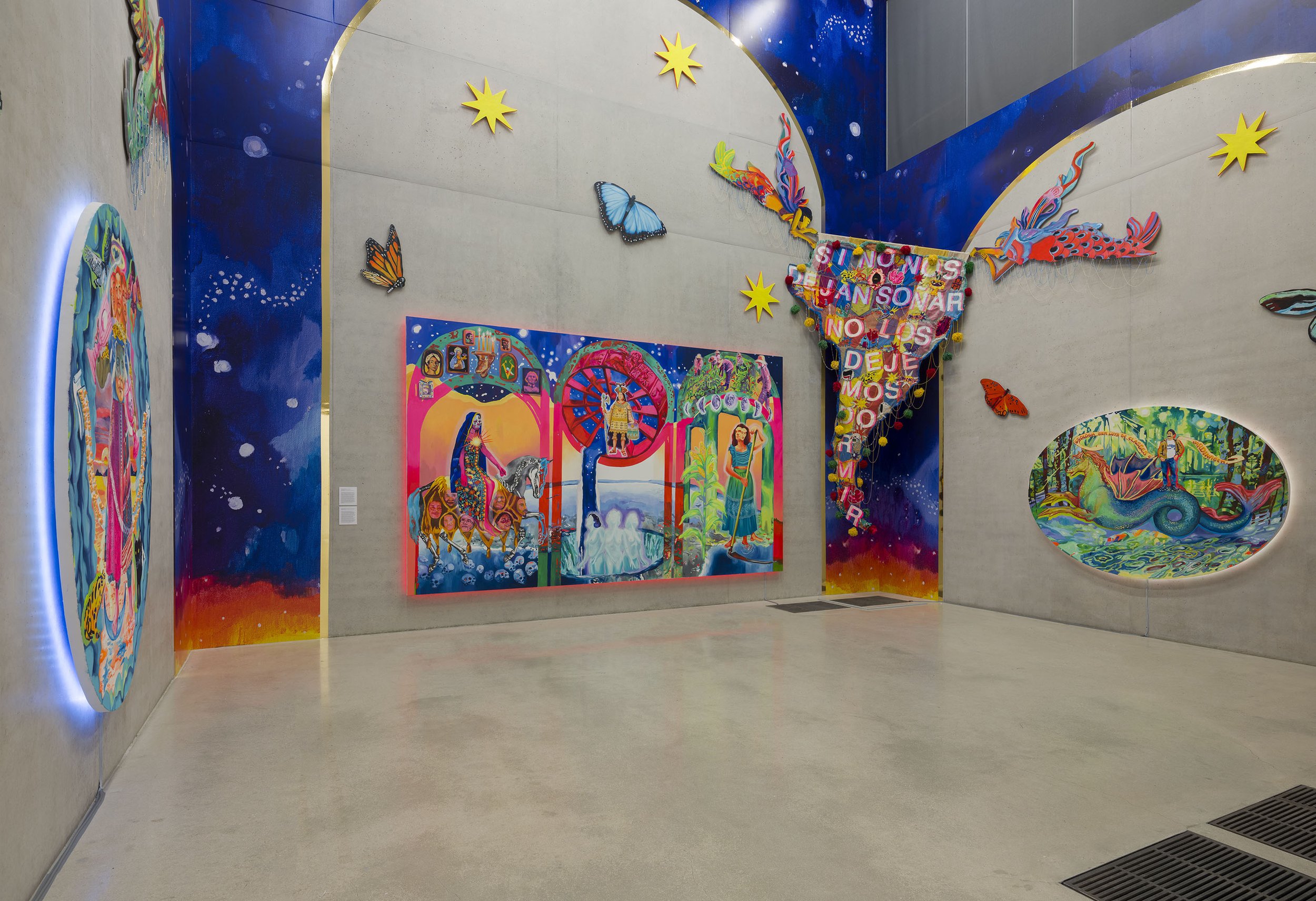
Marcela Cantuária: The South American Dream Installation View: Pérez Art Museum Miami, 2023. Photo: Oriol Tarridas.
This exhibition is a reflection of PAMM’s mission to showcase works that consider Miami’s diverse cultural landscape and unique position as the nexus between North and South America. In honoring its commitment to spotlight artists from the Caribbean, Latin America, and the African diaspora, PAMM offers a platform for genuine human interaction and exchange.
ABOUT PAMM
Pérez Art Museum Miami (PAMM), led by Director Franklin Sirmans, promotes artistic expression and the exchange of ideas, advancing public knowledge and appreciation of art, architecture, and design, and reflecting the diverse community of its pivotal geographic location at the crossroads of the Americas. The nearly 40-year-old South Florida institution, formerly known as Miami Art Museum (MAM), opened a new building, designed by world-renowned architects Herzog & de Meuron, on December 4, 2013 in Downtown Miami’s Maurice A. Ferré Park. The facility is a state-of-the-art model for sustainable museum design and progressive programming and features 200,000 square feet of indoor and outdoor program space with flexible galleries; shaded outdoor verandas; a waterfront restaurant and bar; a museum shop; and an education center with a library, media lab, and classroom spaces.
Accredited by the American Alliance of Museums, Pérez Art Museum Miami (PAMM) is Sponsored in part by the State of Florida, Department of State, Division of Arts and Culture and the Florida Council on Arts and Culture. Support is provided by the Miami-Dade County Department of Cultural Affairs and the Cultural Affairs Council, the Miami-Dade County Mayor and Board of County Commissioners. Additional support is provided by the City of Miami and the Miami OMNI Community Redevelopment Agency (OMNI CRA). Pérez Art Museum Miami is an accessible facility. All contents ©Pérez Art Museum Miami. All rights reserved.
For more information about this exhibit and other exhibits currently on view and upcoming, please visit the Pérez Art Museum website here. PAMM can also be found on Instagram, YouTube, TikTok, and Facebook.
Human / Nature: Encountering Ourselves in the Natural World
Installation View: Photography Credit: Leandro Justen. Courtesy of Fotografiska New York
New York– Fotografiska New York is pleased to announce the opening of Human / Nature: Encountering Ourselves in the Natural World, which opened on February 9, 2024, and will run through to May 25, 2024), a sprawling group exhibition bringing together more than a dozen photographers from around the world through over 40 works for an investigation into humanity’s fraught relationship with planet Earth.
Human / Nature will include photographs, immersive video installations, and sculptures that push audiences to reflect on how people and the world around them have had a profound impact on shaping one another. At once celebratory and contemplative, the exhibition includes works highlighting moments of symbiotic connection while never shying away from the often-fraught relationship humanity has developed with the climate.
Installation View: Photography Credit: Leandro Justen. Courtesy of Fotografiska New York
Included in the show are works by artists including David Ụzọchukwu and Lewis Miller that revel in the beauty of nature. Rush by Ụzọchukwu, for example, presents an image of a carefully posed body set within lush wild grass, alluding to the possibility of peaceful coexistence. Meanwhile, Miller’s “Flower Flash” installations joyfully depict floral arrangements in garbage
cans—a cheeky way of highlighting the powerful impact of nature in urban landscapes. Other works in the exhibition, however, focus on the pernicious and shocking realities of climate change. Works by Edward Burtynsky investigate industry’s impact on different environments. Burtynsky’s world-renowned aerial photographs abstract the ugly realities of mining, oil, and other damaging industries with beautiful and vibrant photographs of color fields. Ori Gerscht’s work shows the violent destruction of natural beauty via the literal explosion of bouquets.
Other artists ring out a hopeful note, with works by Yan Wang Preston and Indigenous artist Pat Kane among others, offering glimpses into how humankind can move forward despite the challenges wrought by climate change. Preston’s works depict lush greenery carefully inhabiting structured, urban settings, while Pat Kane’s photographs document the Łutsël K'é Dene First Nation’s stewardship of their land in Northern Canada.
Installation View: Photography Credit: Leandro Justen. Courtesy of Fotografiska New York
Human / Nature will include “In Harmony With Mother Earth” by climate justice activist Xiye Bastida, a moving and revelatory text punctuated with personal anecdotes and urging humankind’s reconnection and rebalancing of our relationship with nature. The text also illuminates the knowledge of Indigenous Peoples as a resource for repair and implores a recognition of collective responsibility to preserve our environment.
“This exhibition illustrates the beautiful yet sometimes difficult relationship between human life and the rest of the living world,” said Sophie Wright, Executive Director of Fotografiska New York. “It touches not only on what we can do to make the world more inhabitable, but also invites guests to reflect on their own experiences and to consider their roles in our rapidly changing environment while presenting a bold new way forward.”
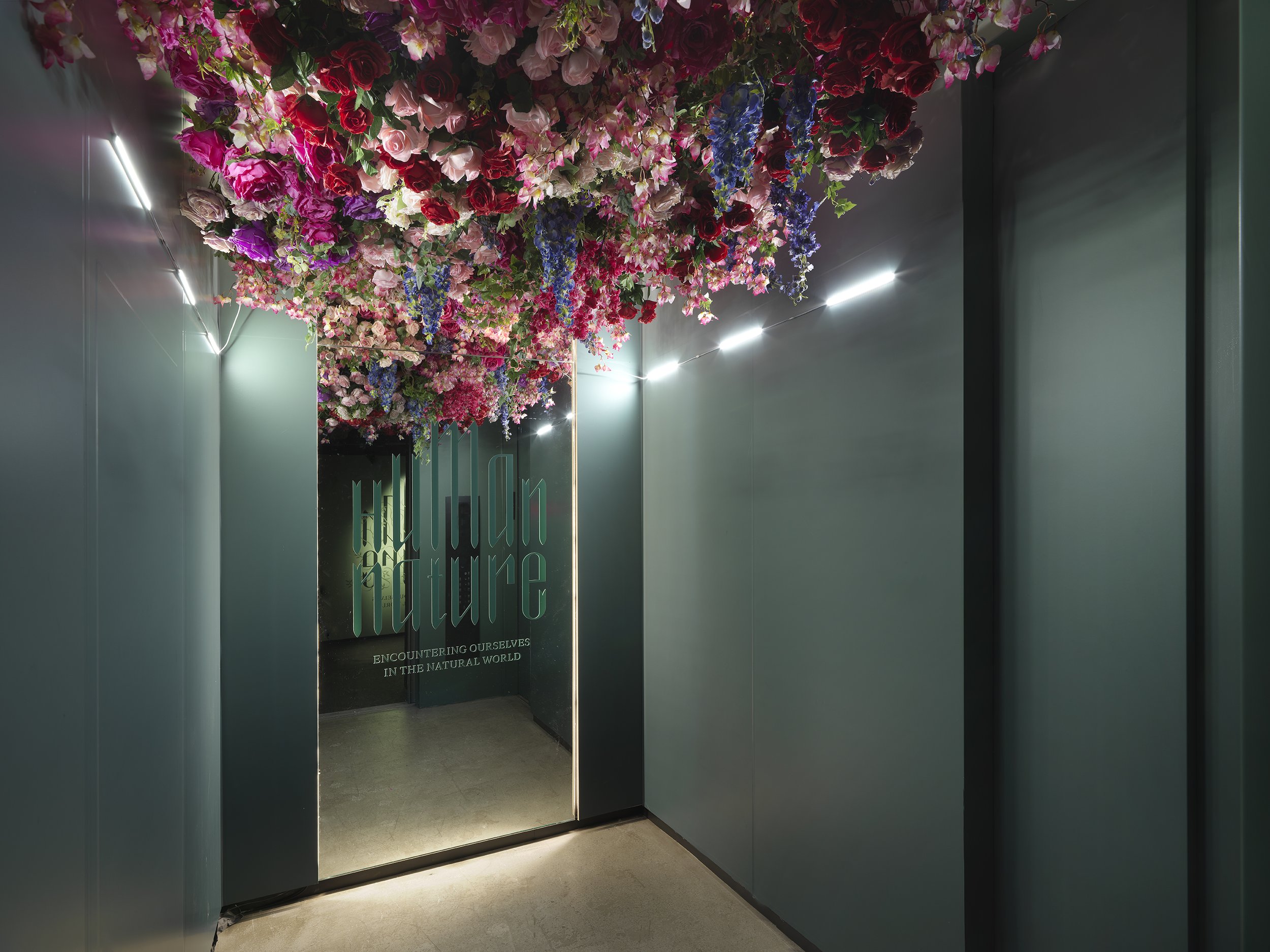
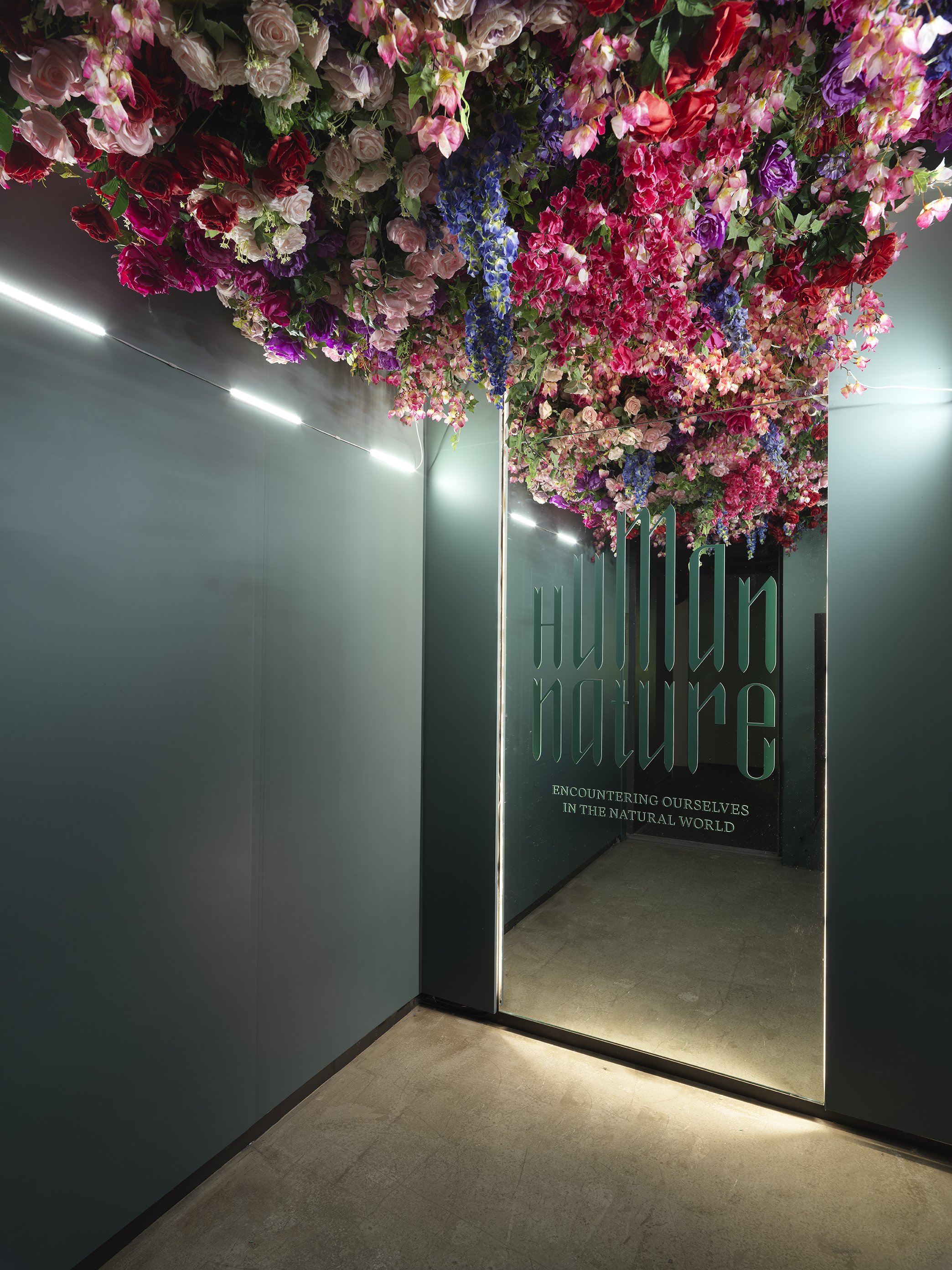
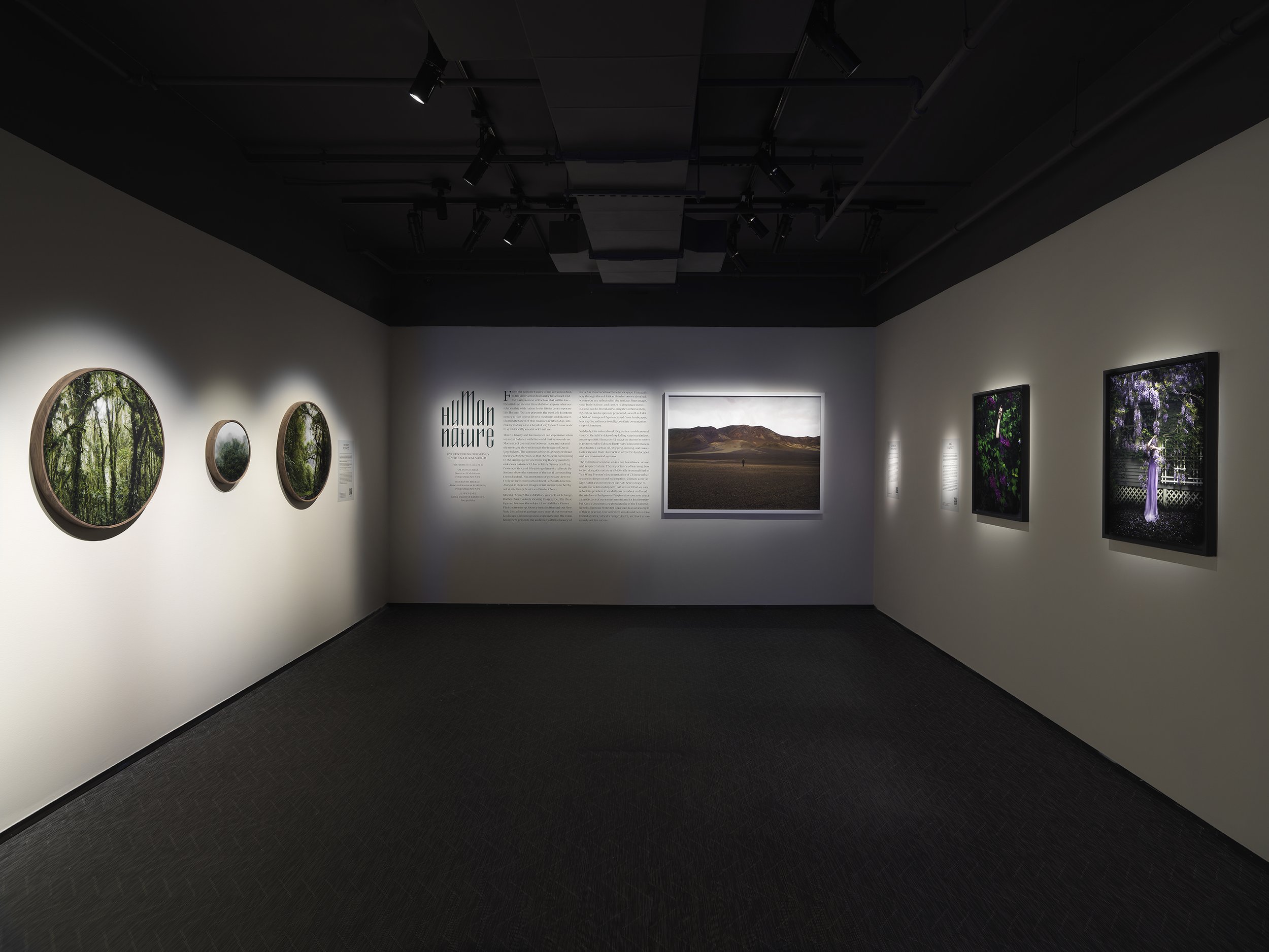
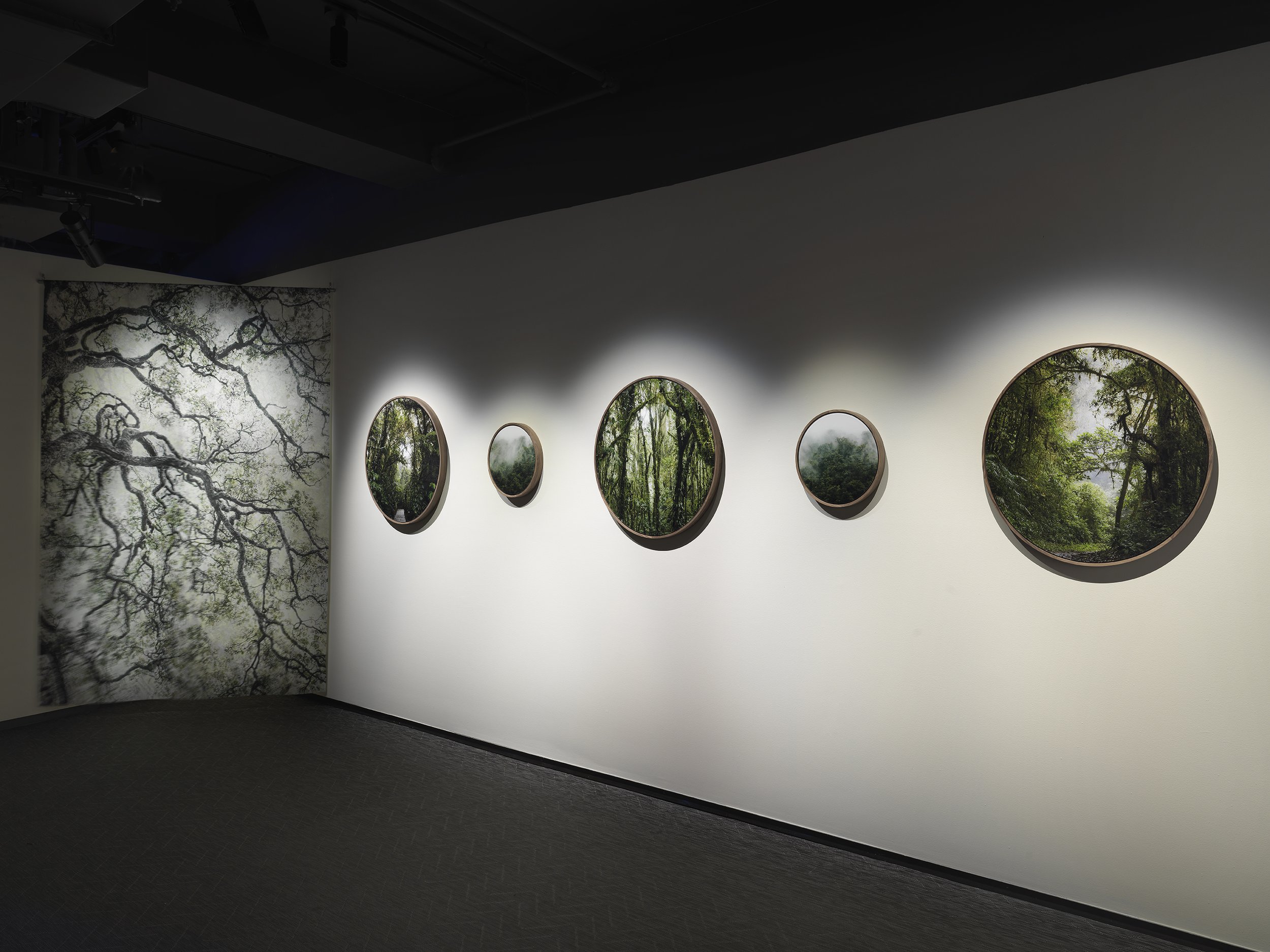
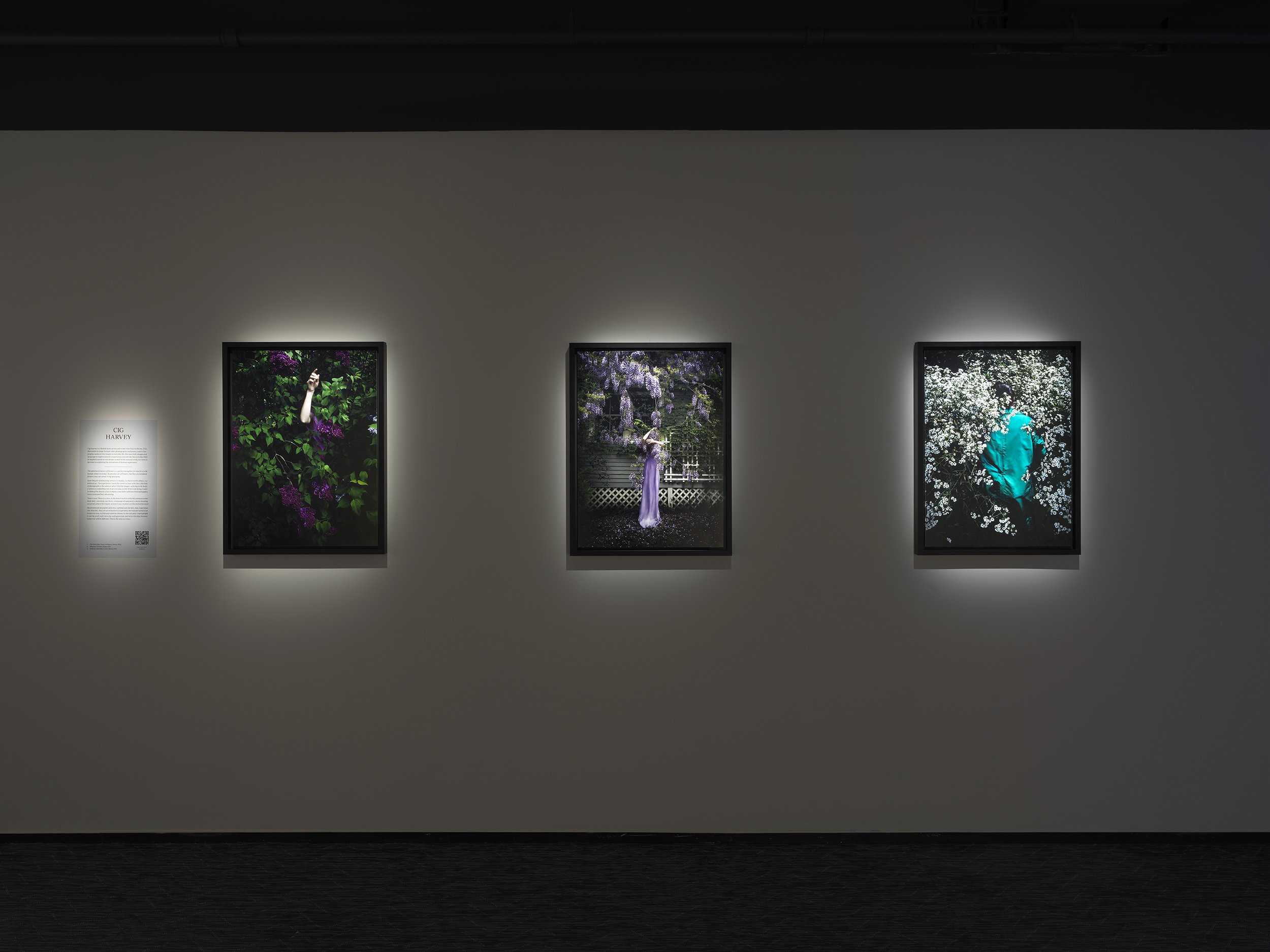
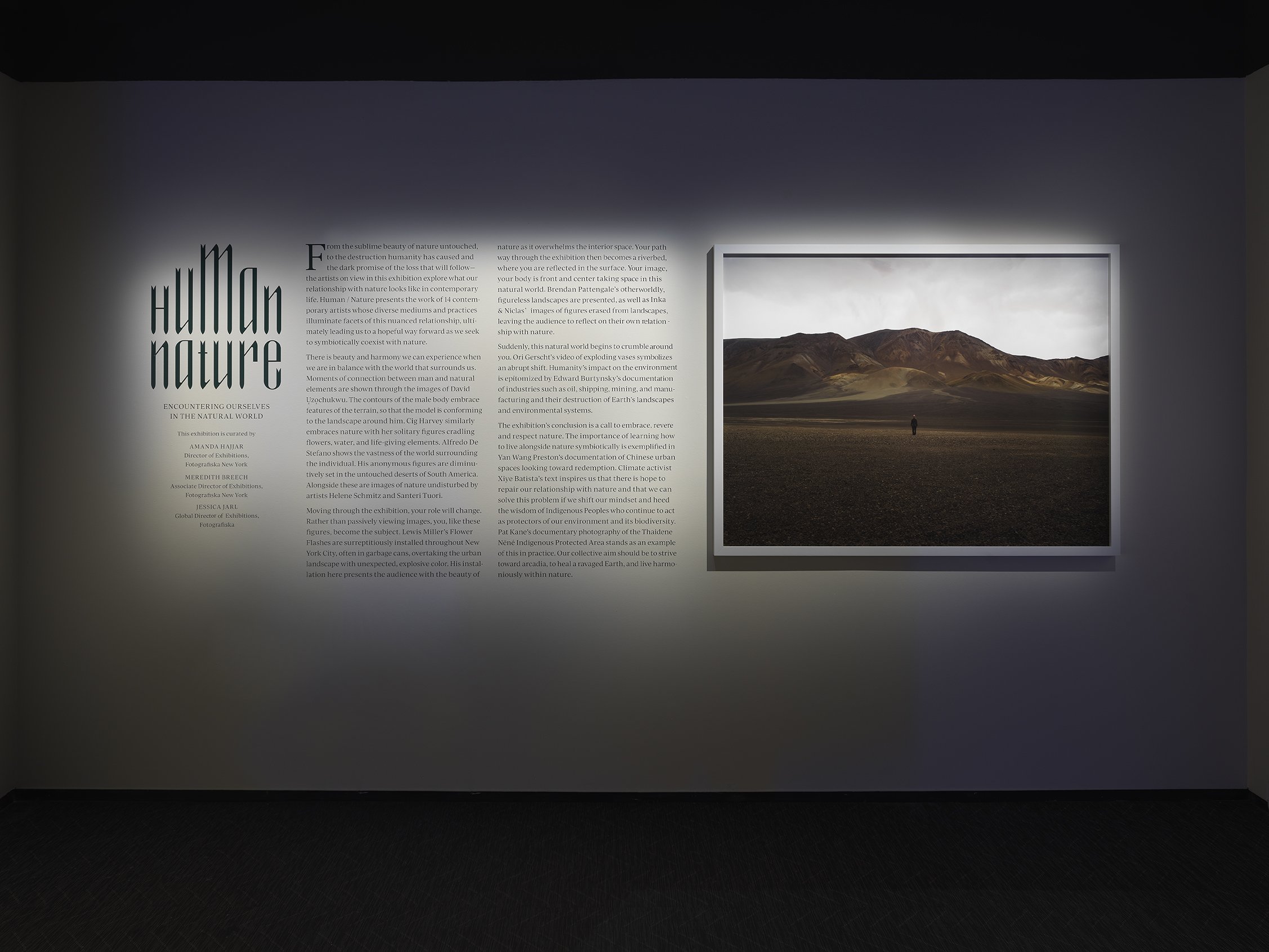
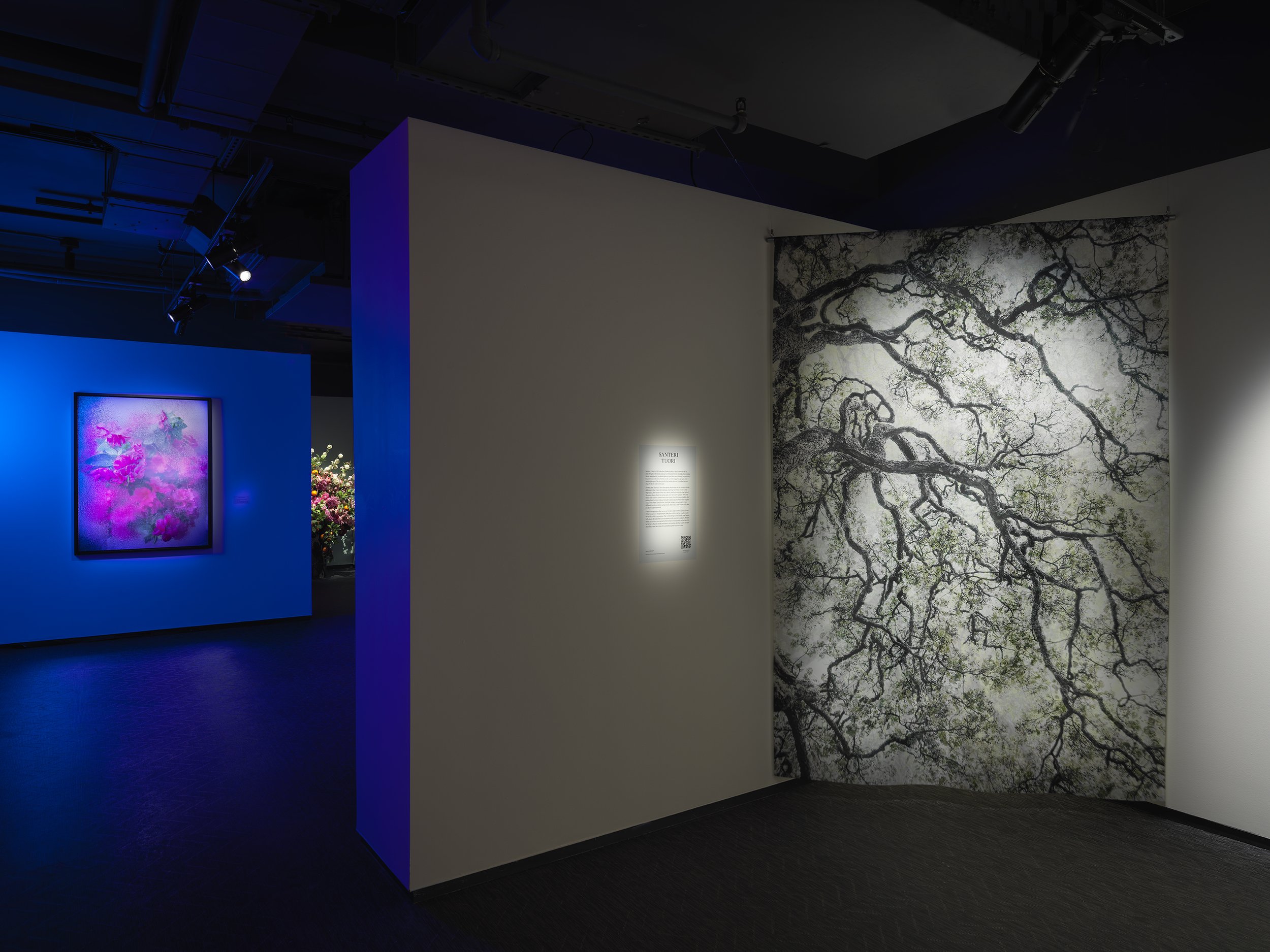
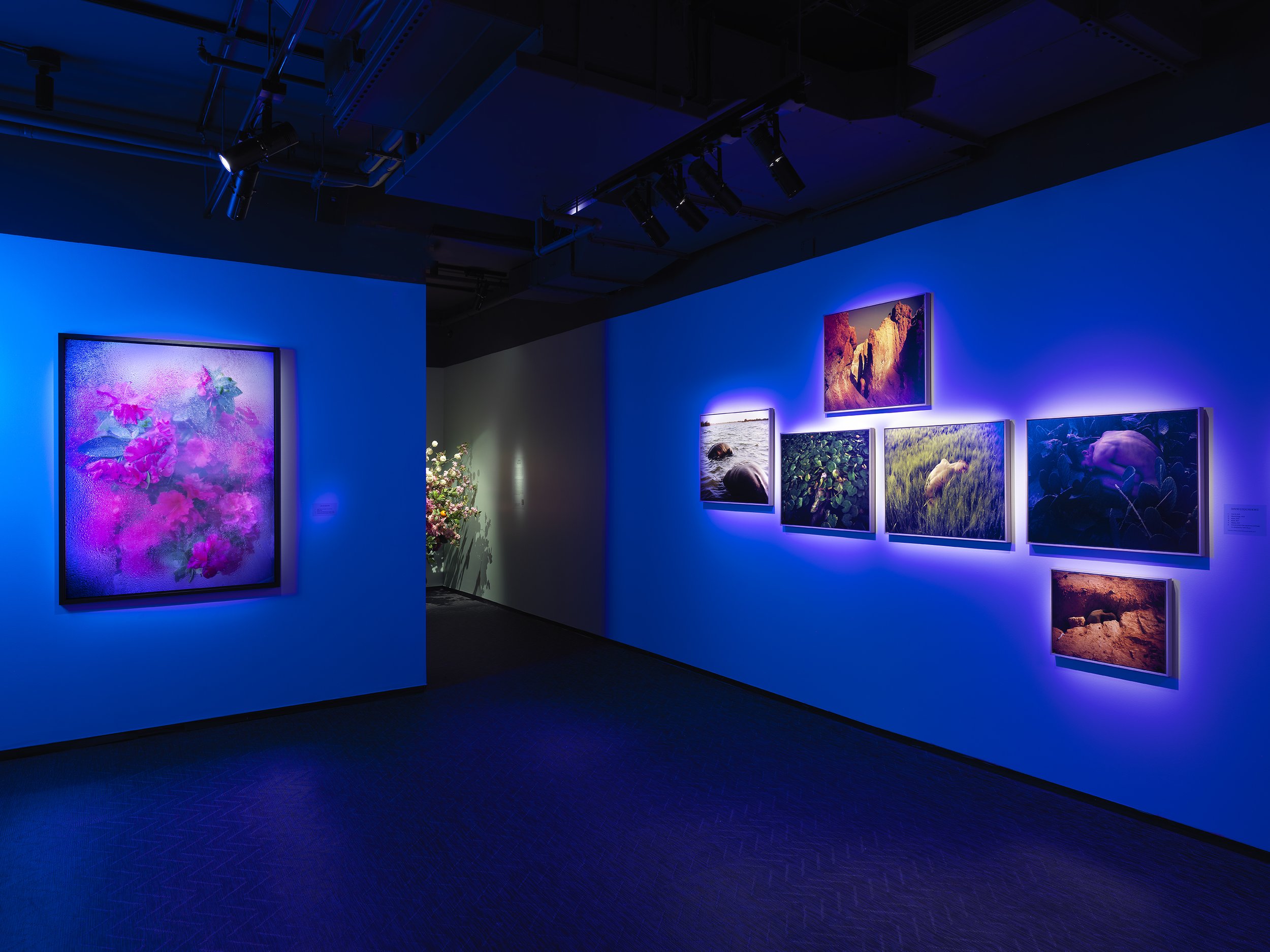
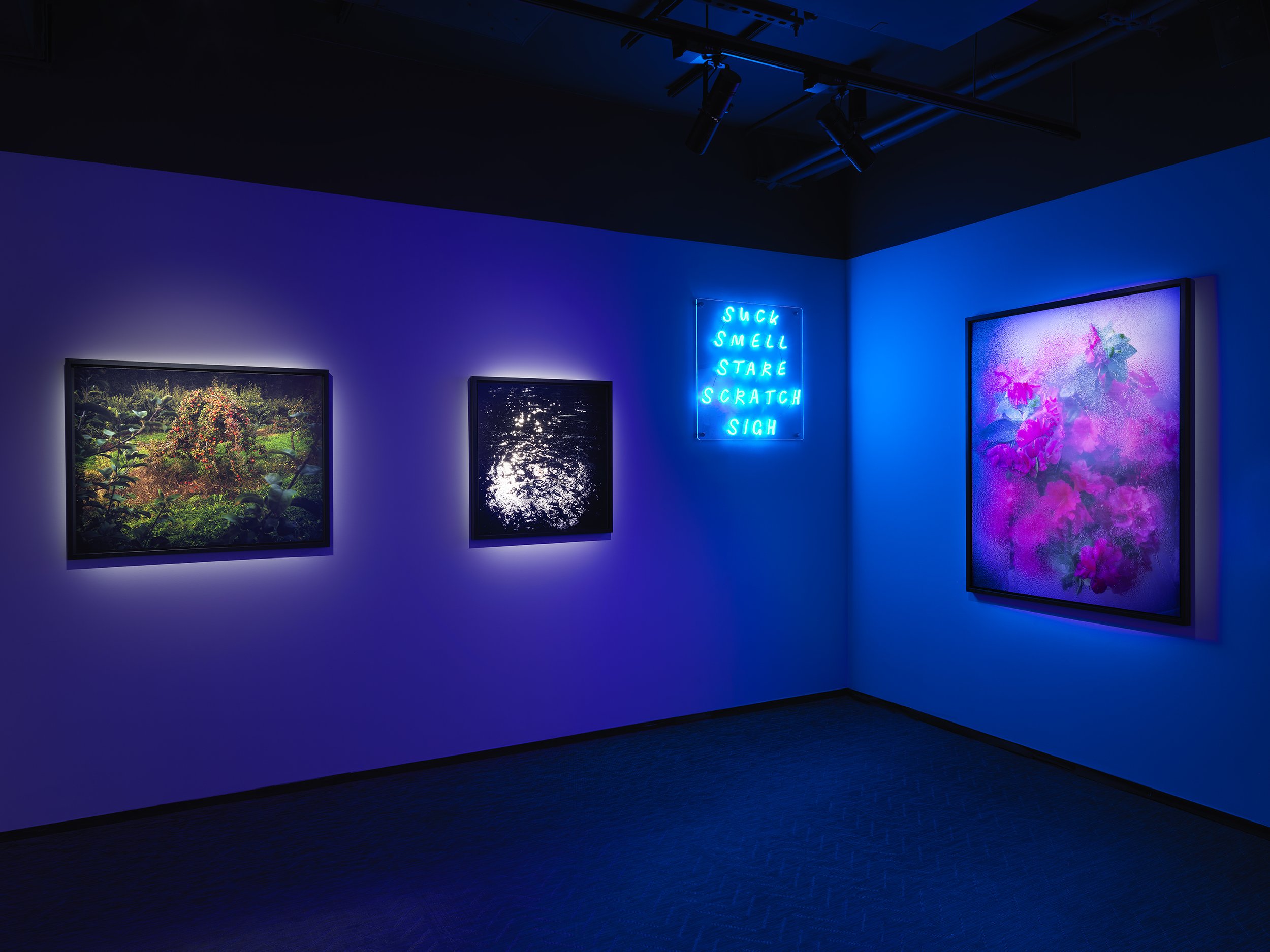
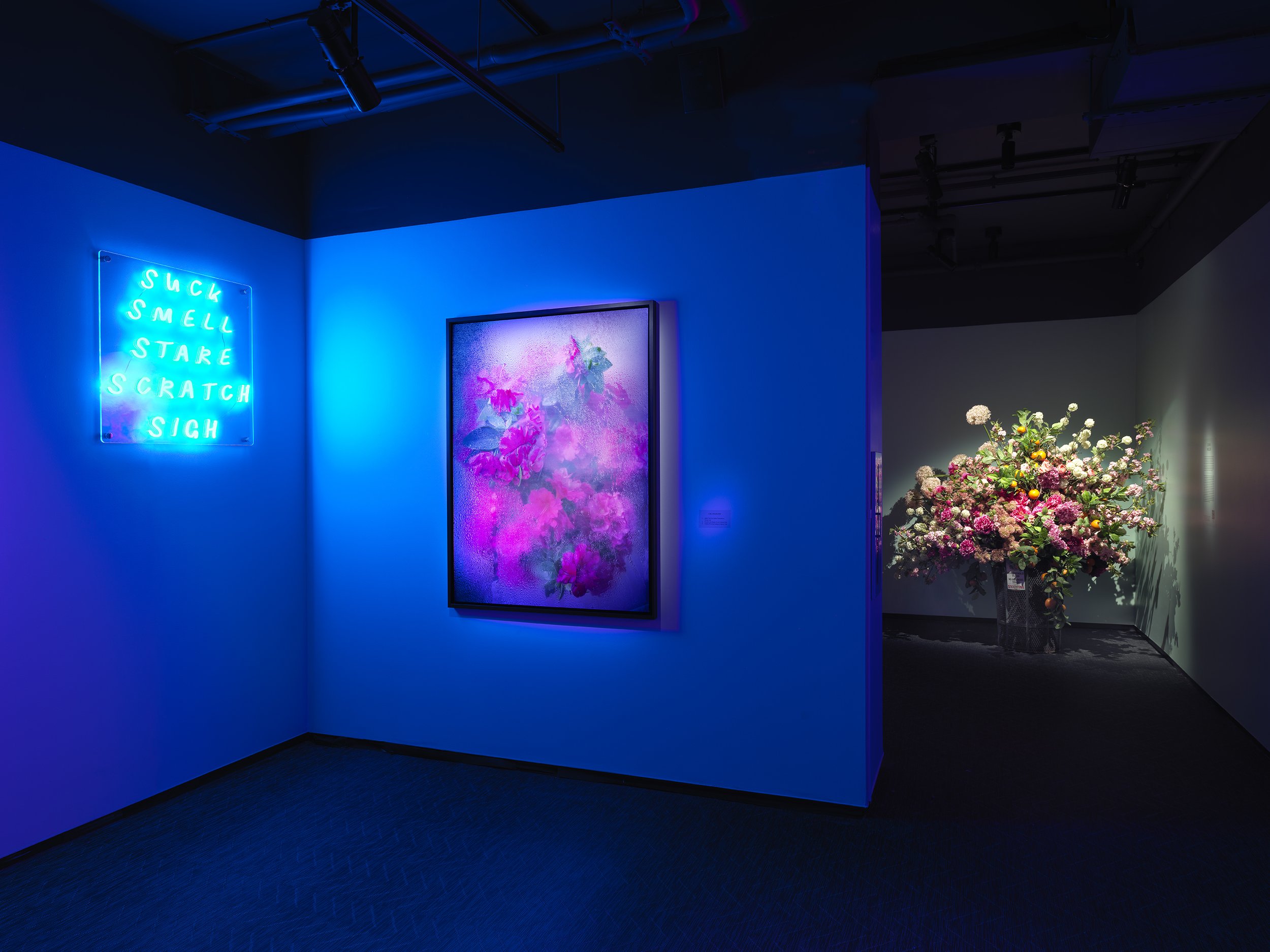
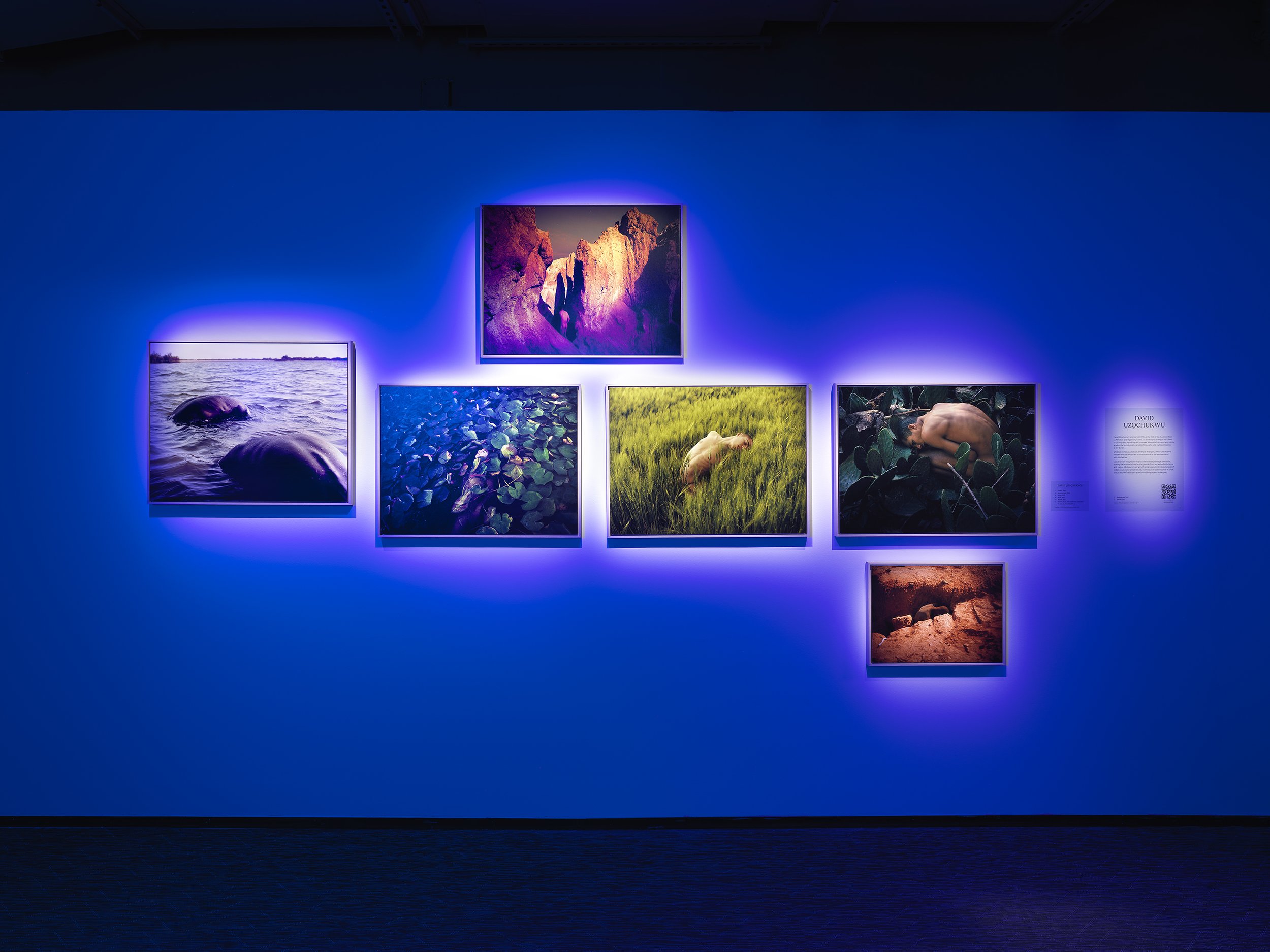
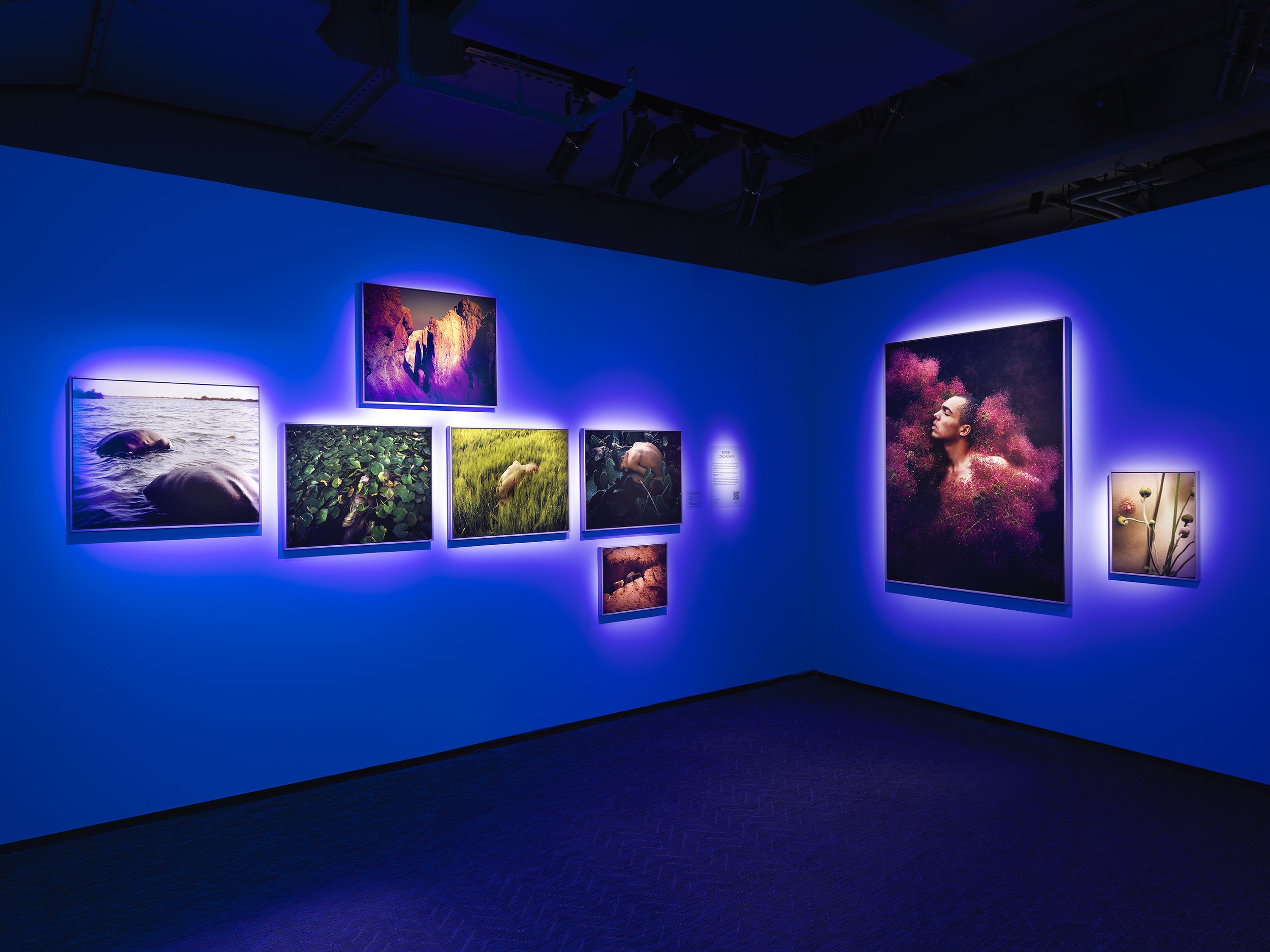
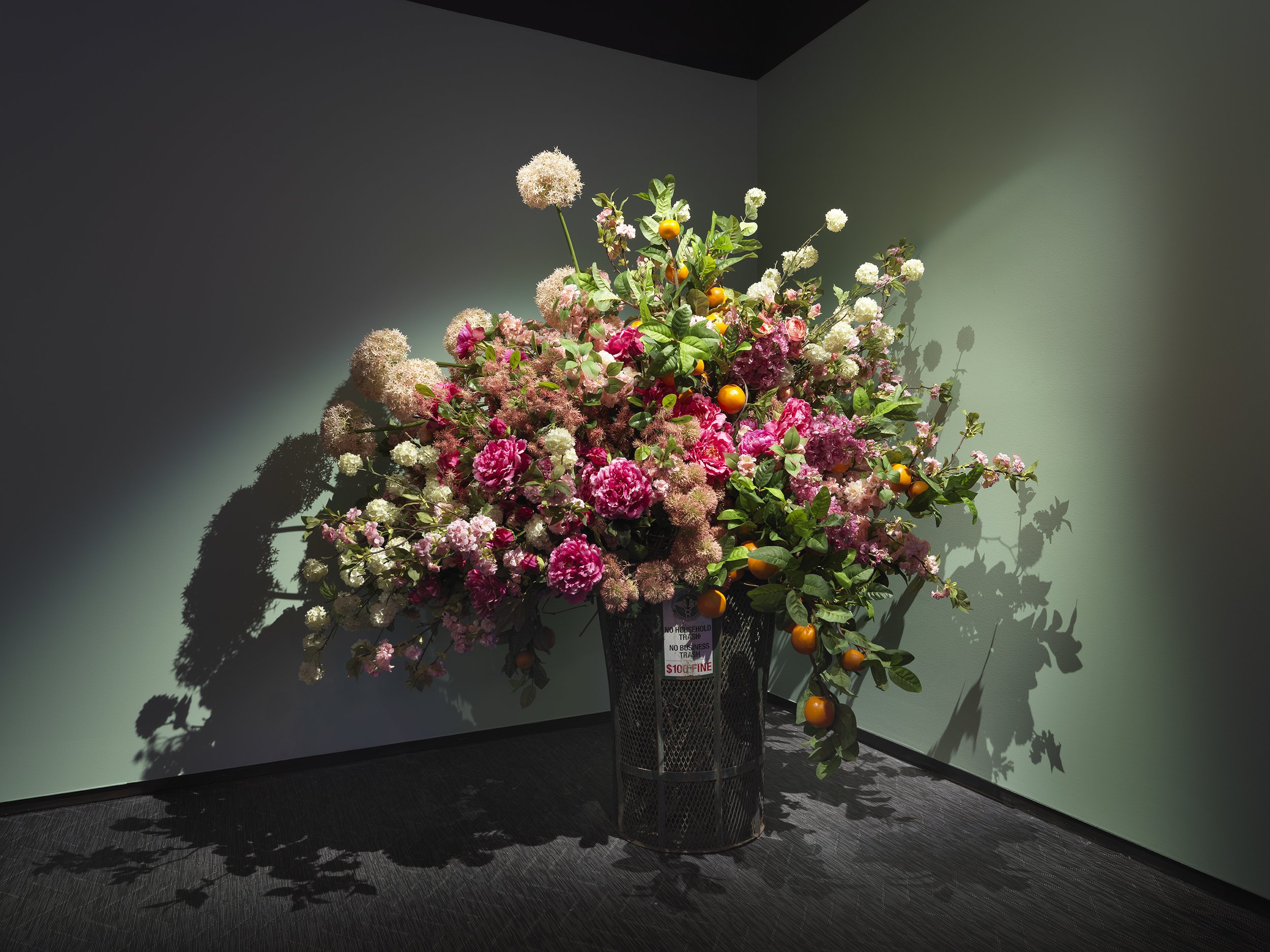
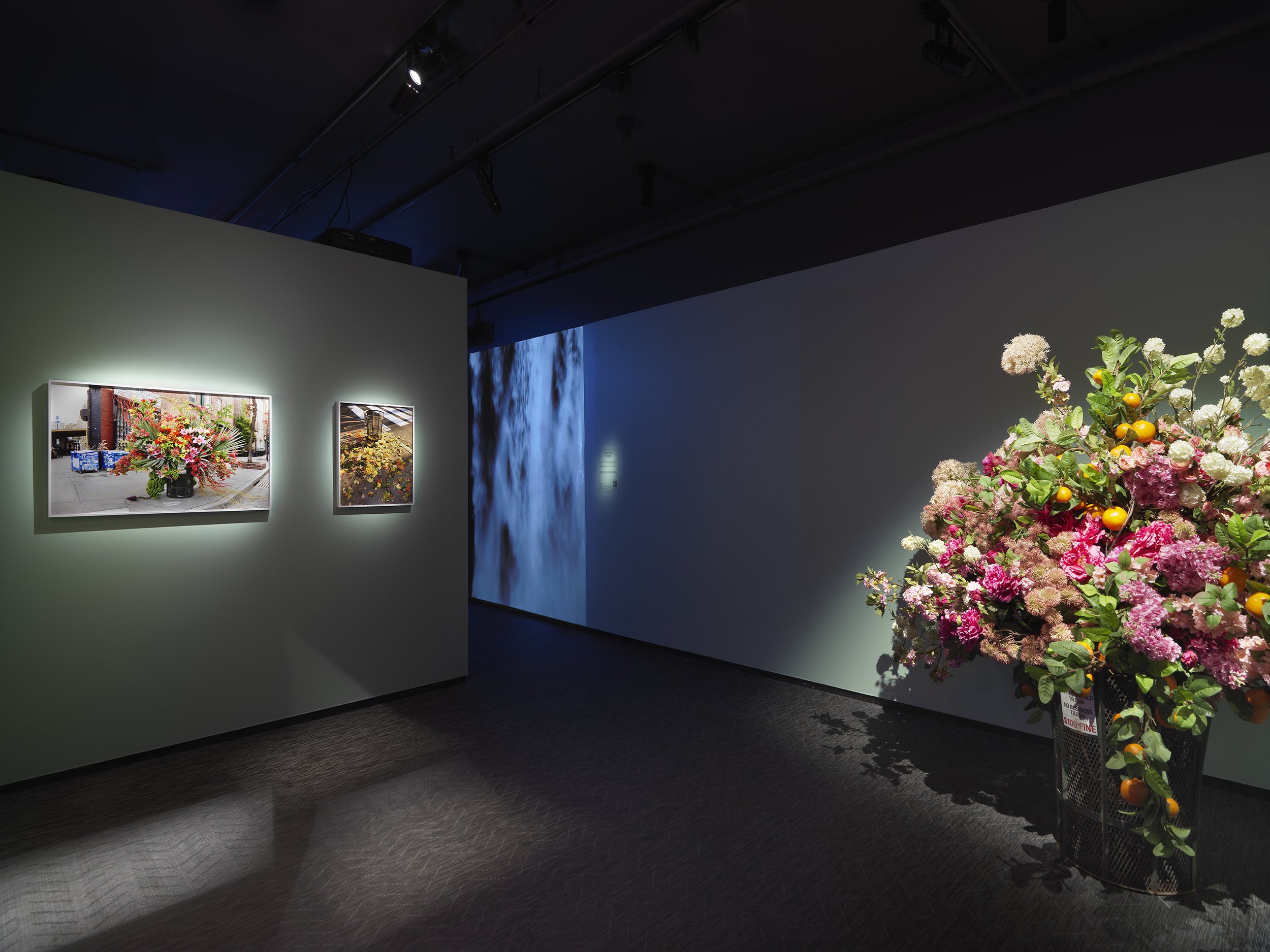
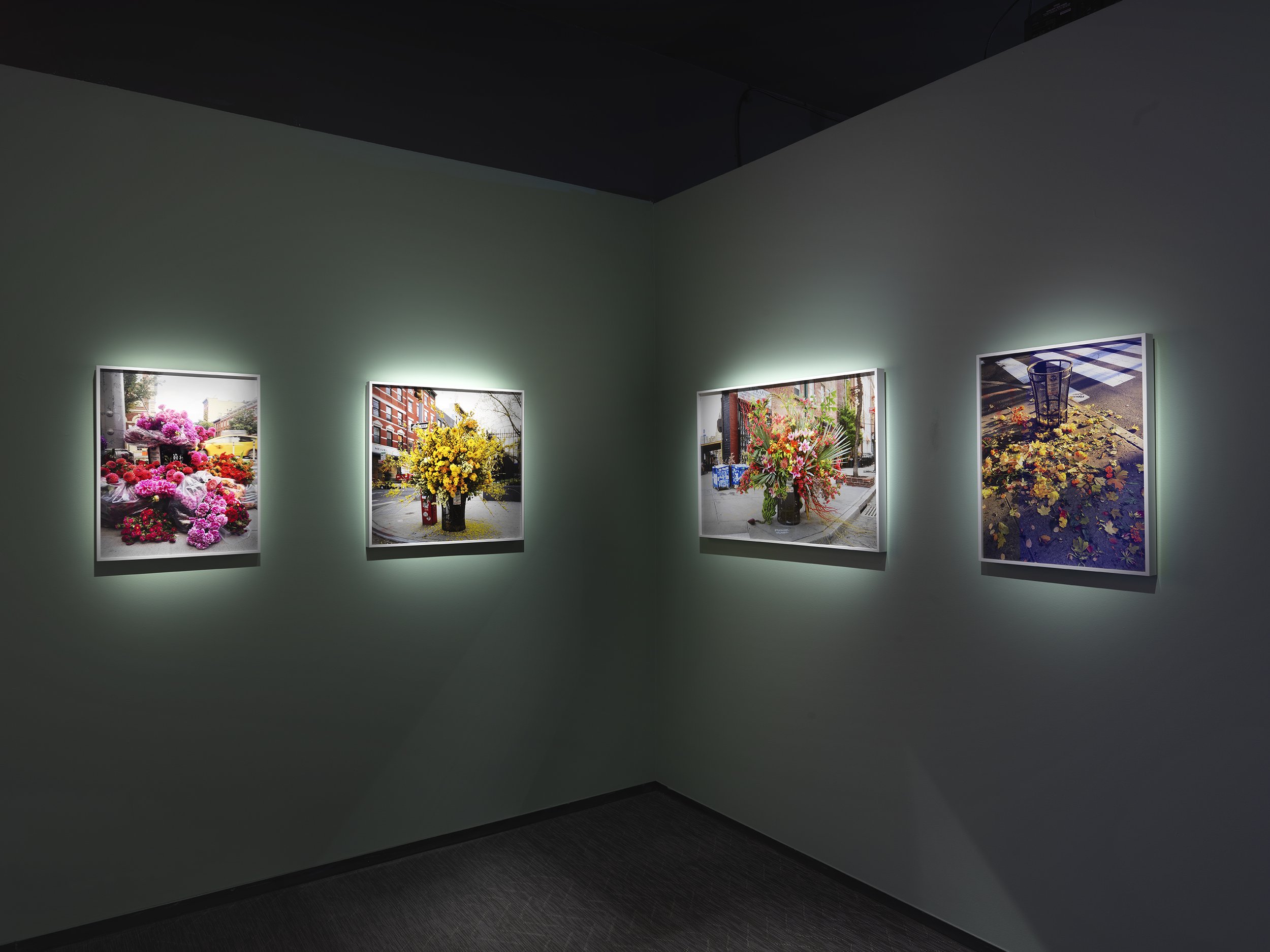
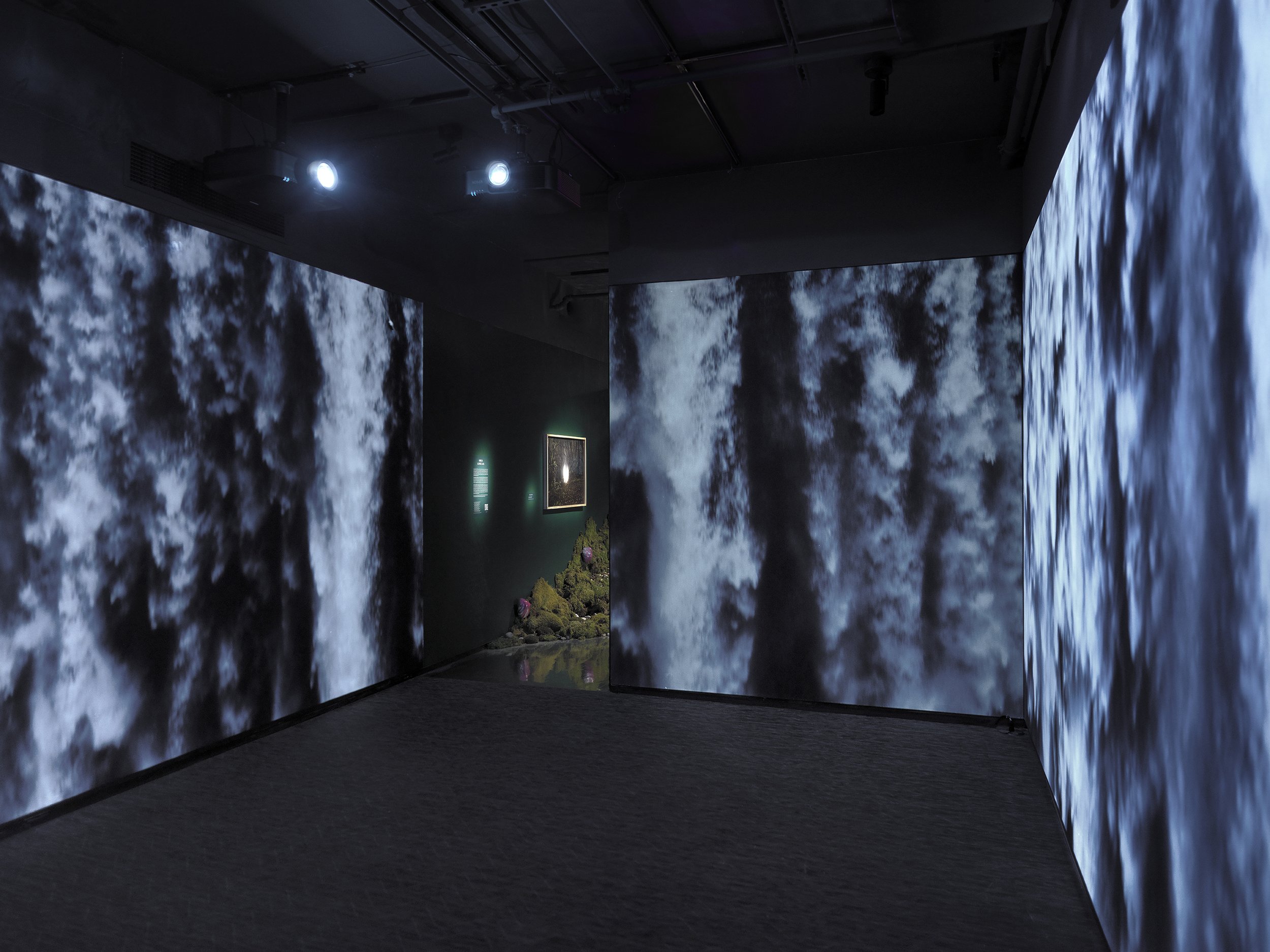
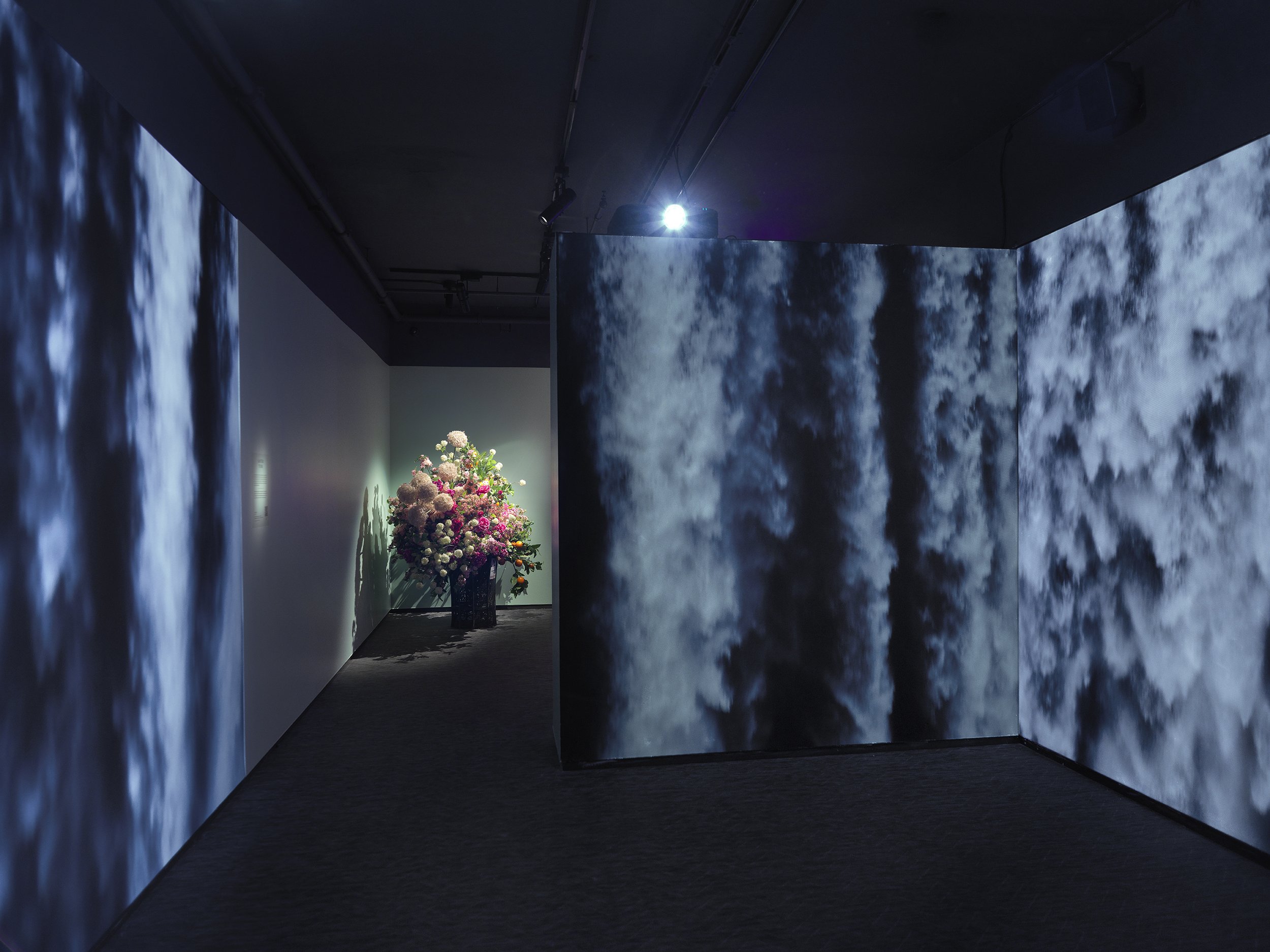
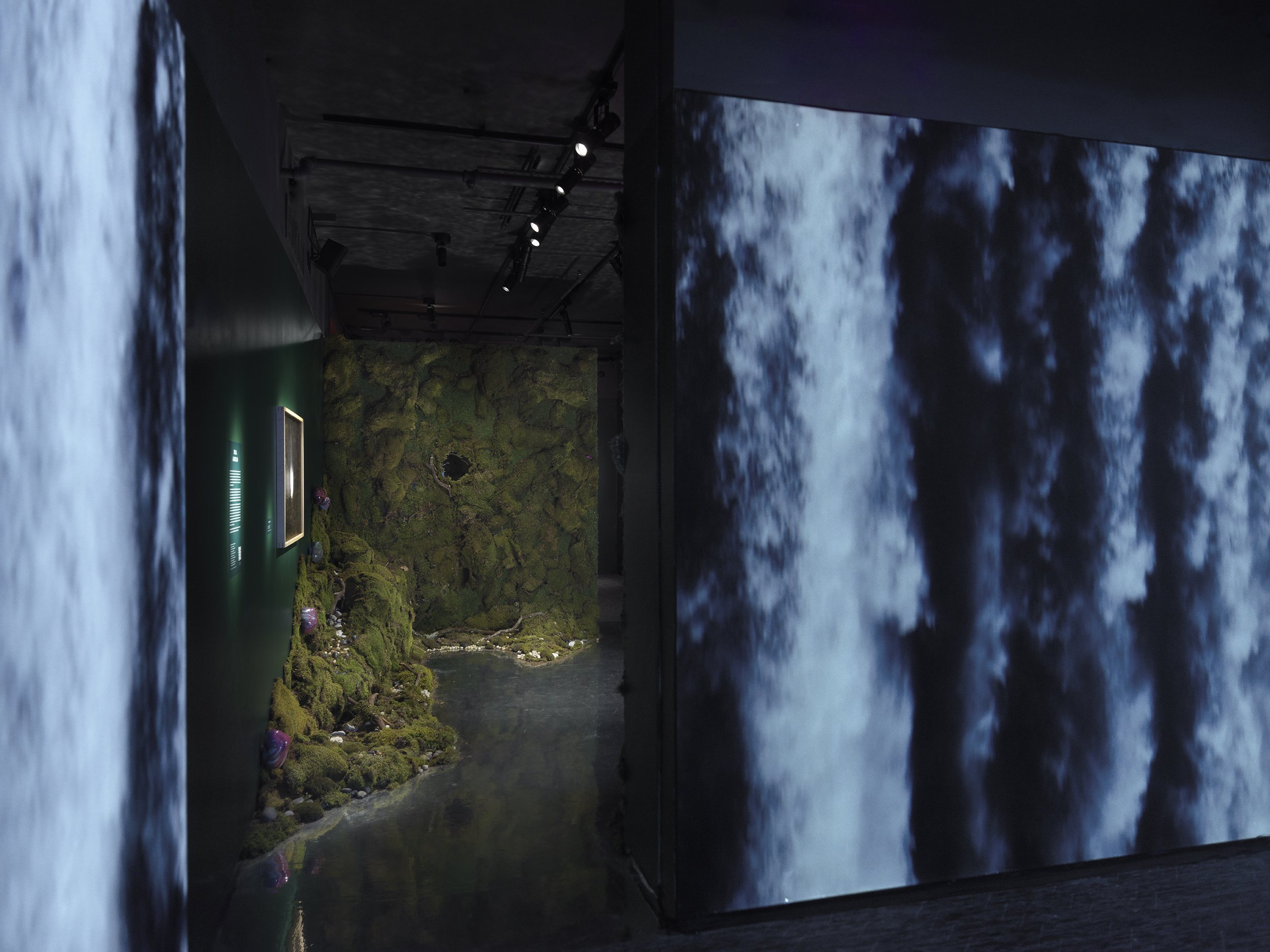
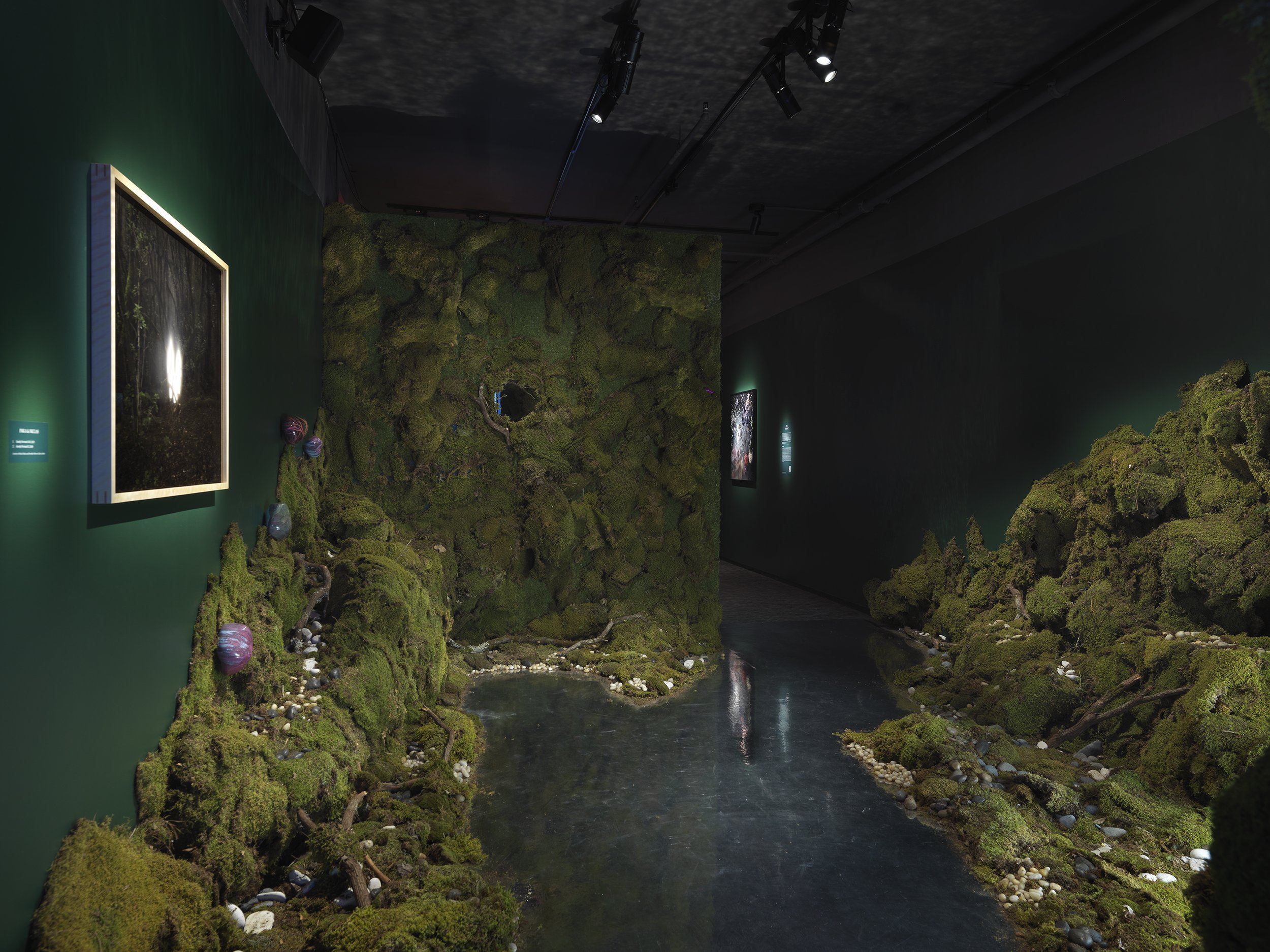
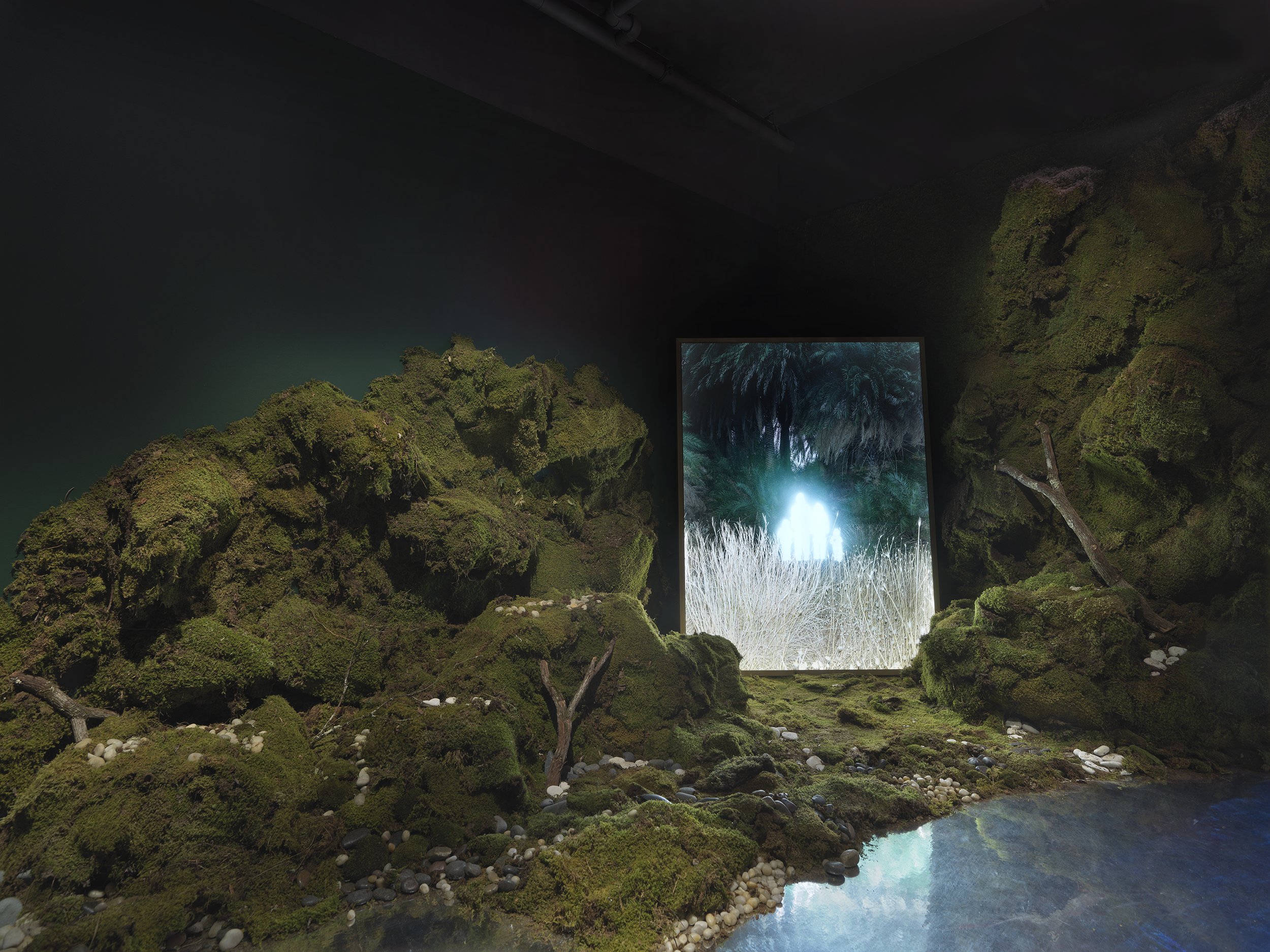


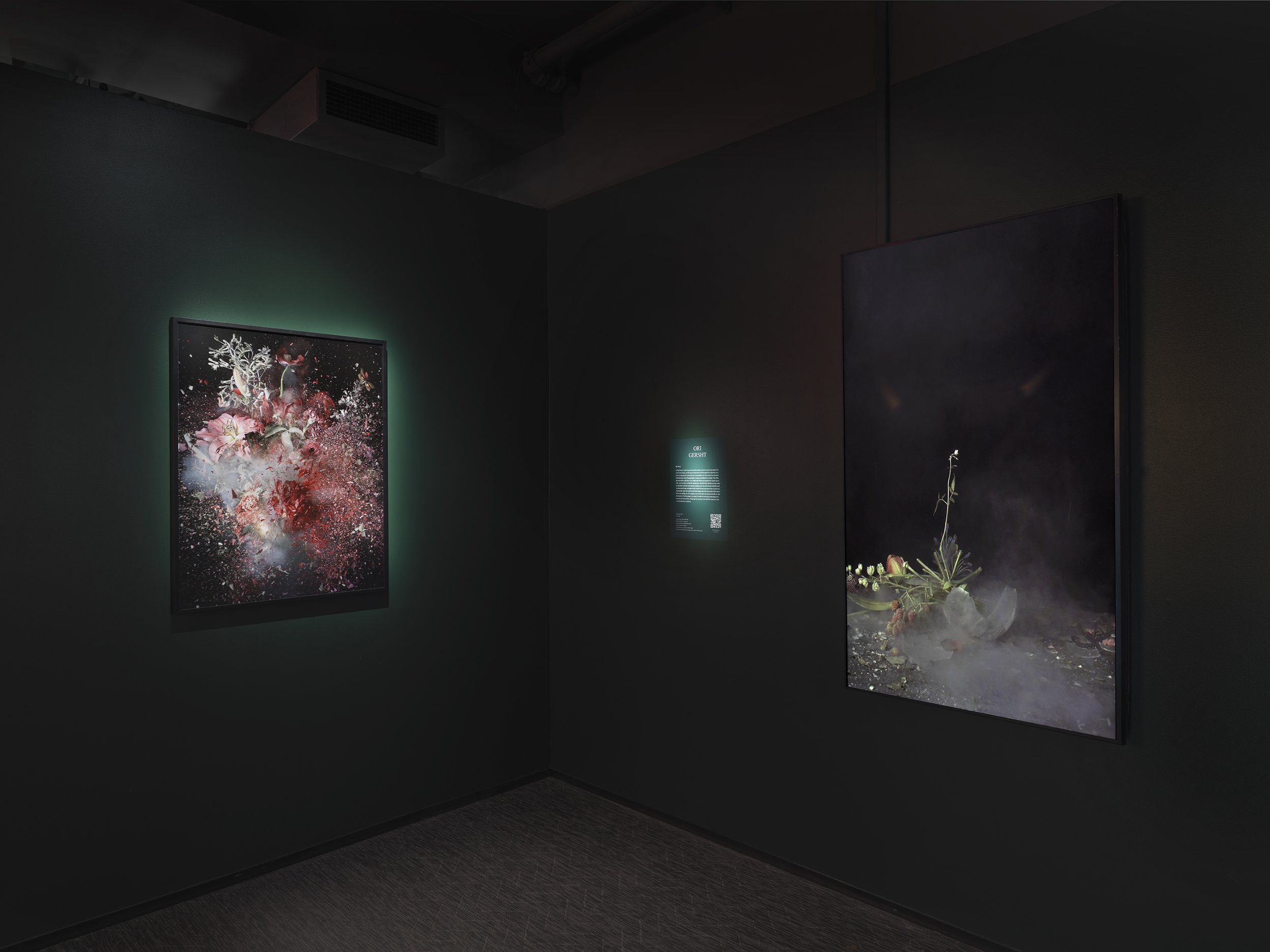

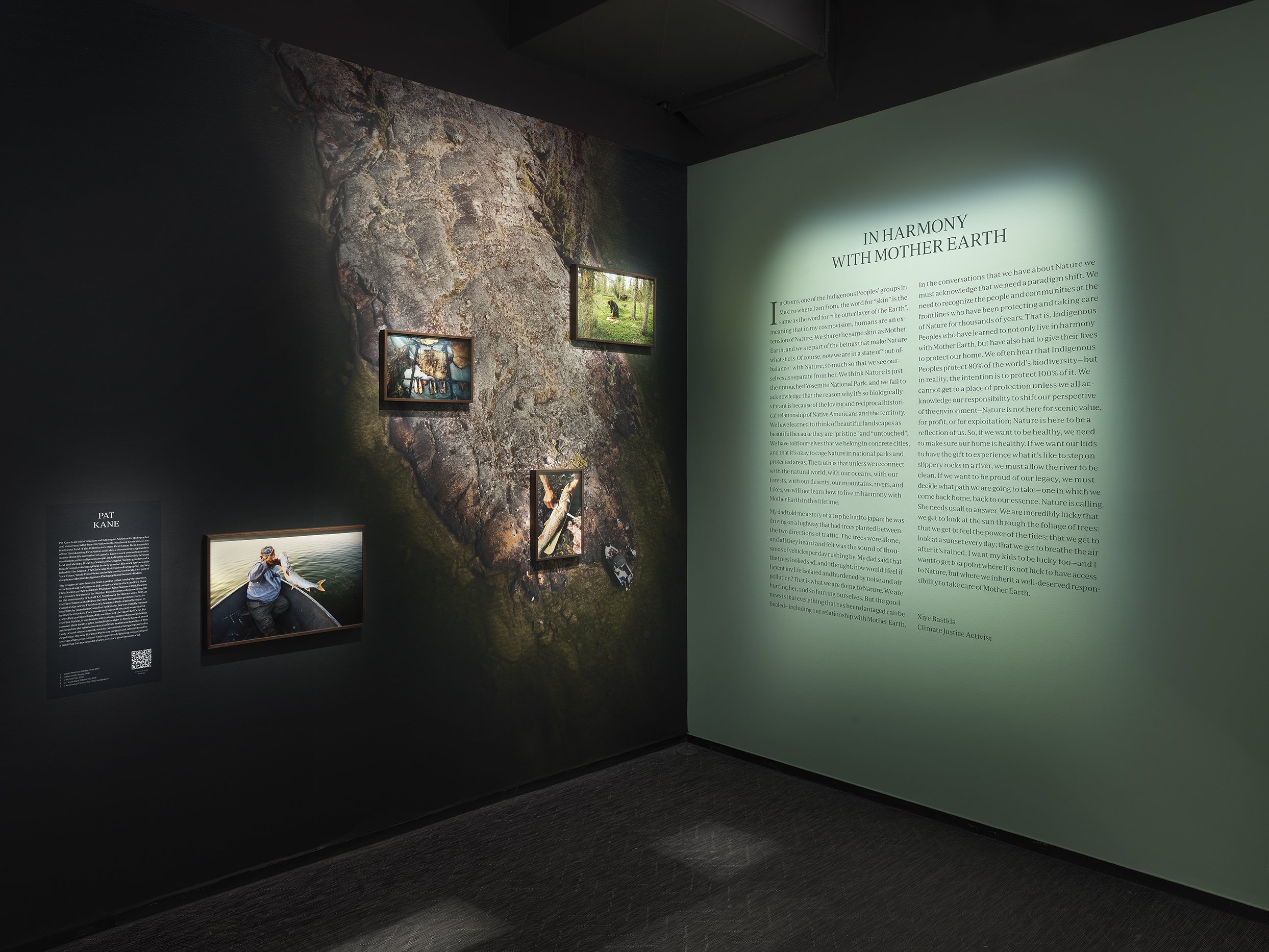
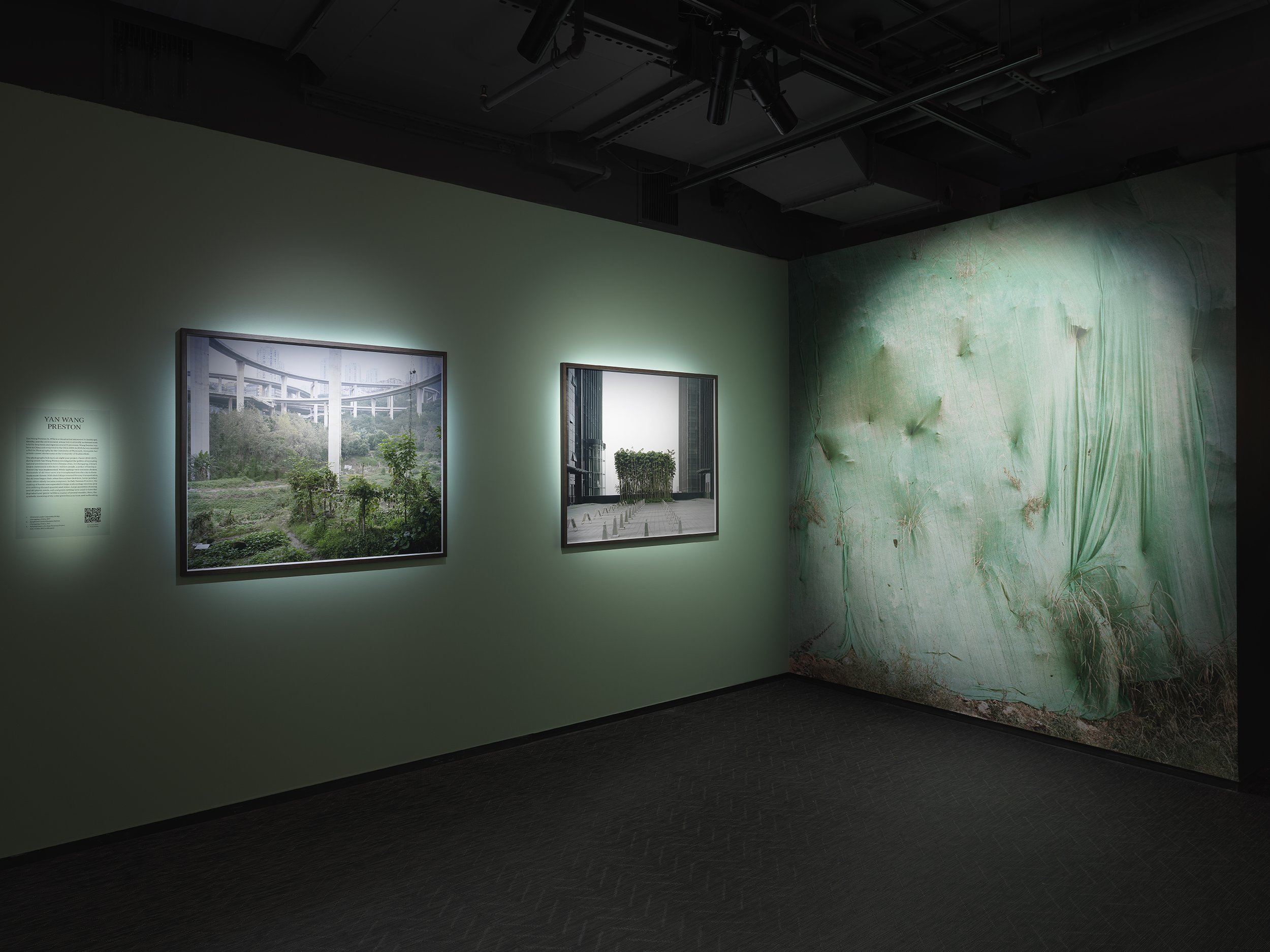
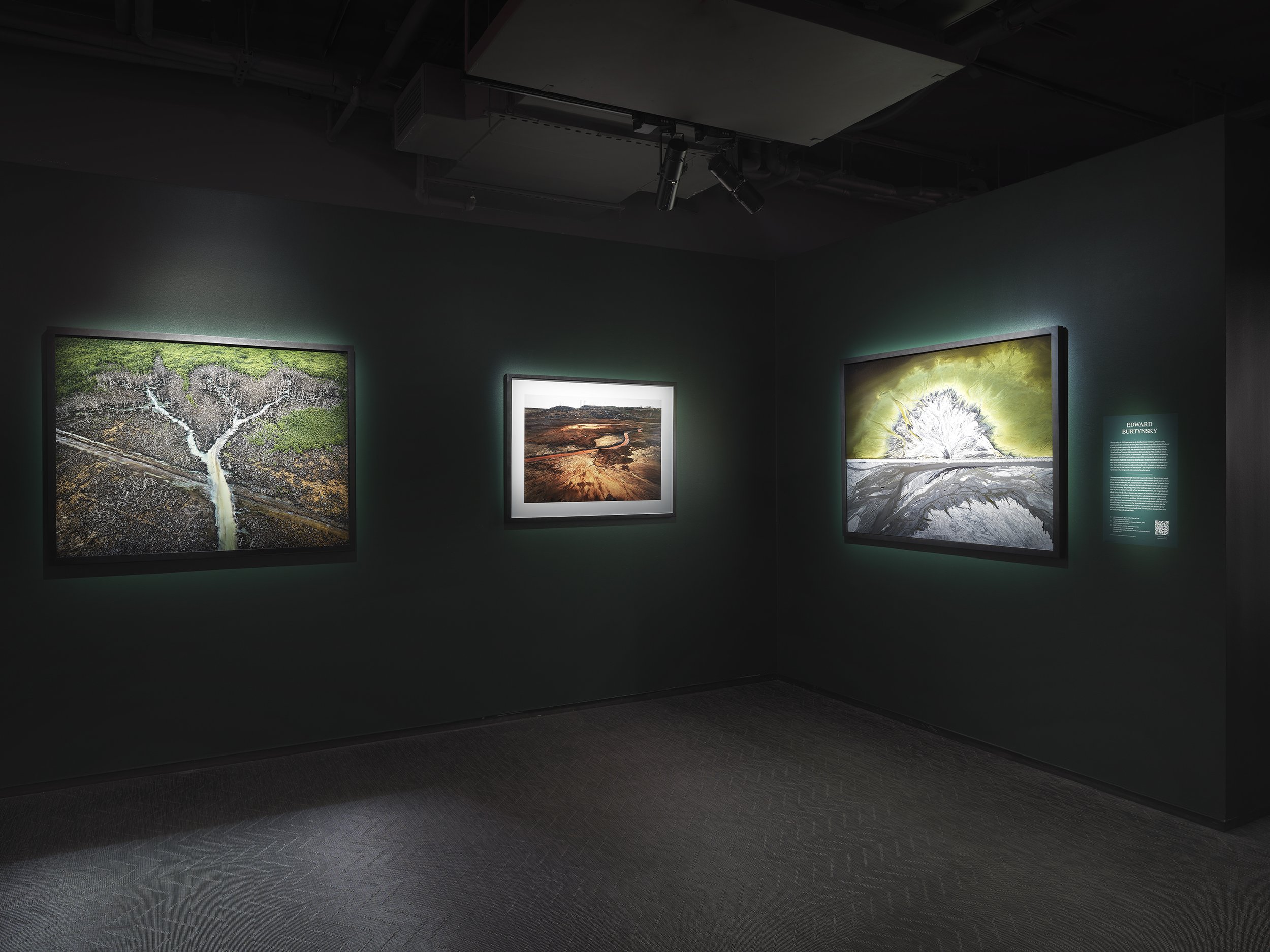

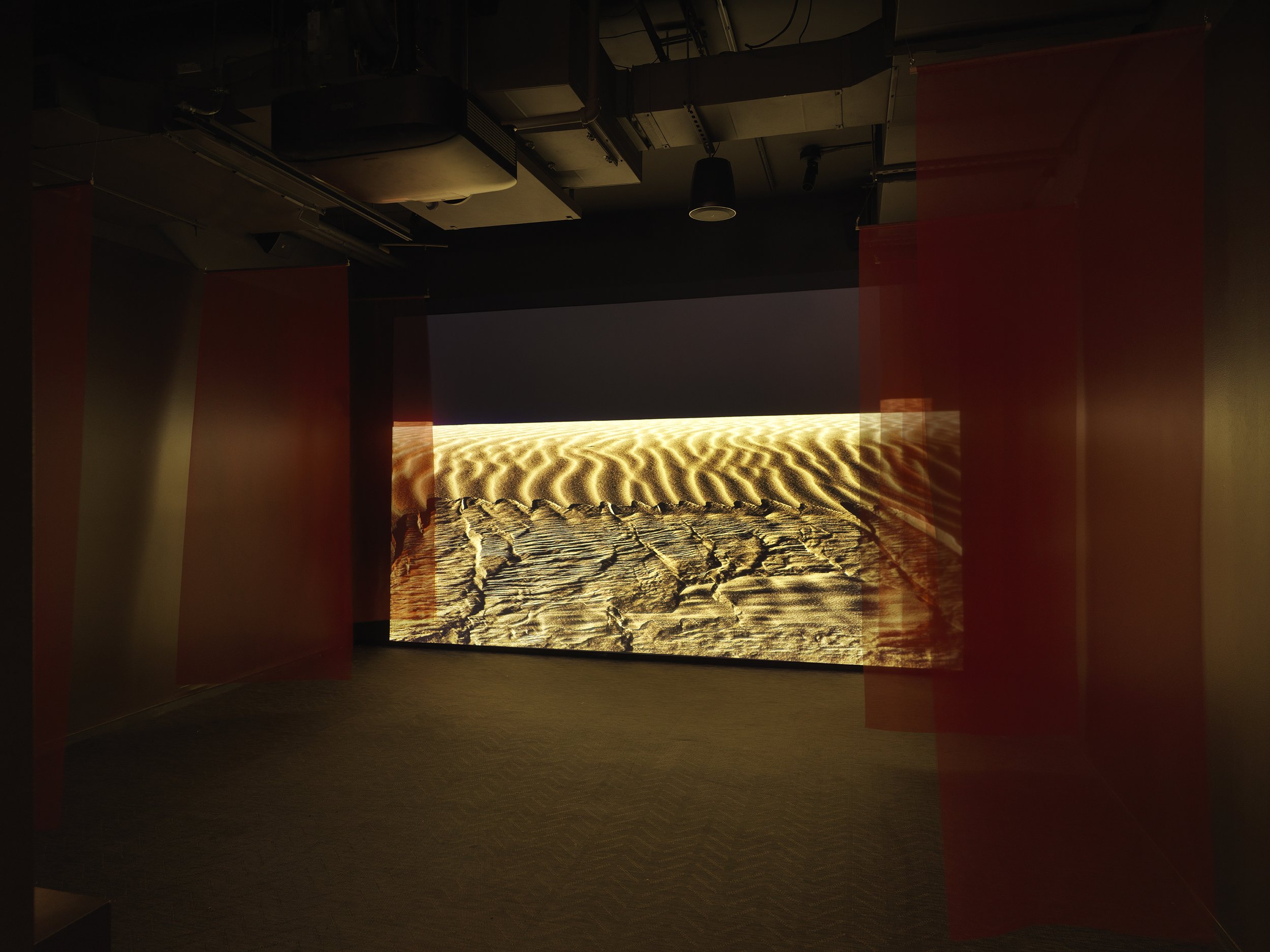
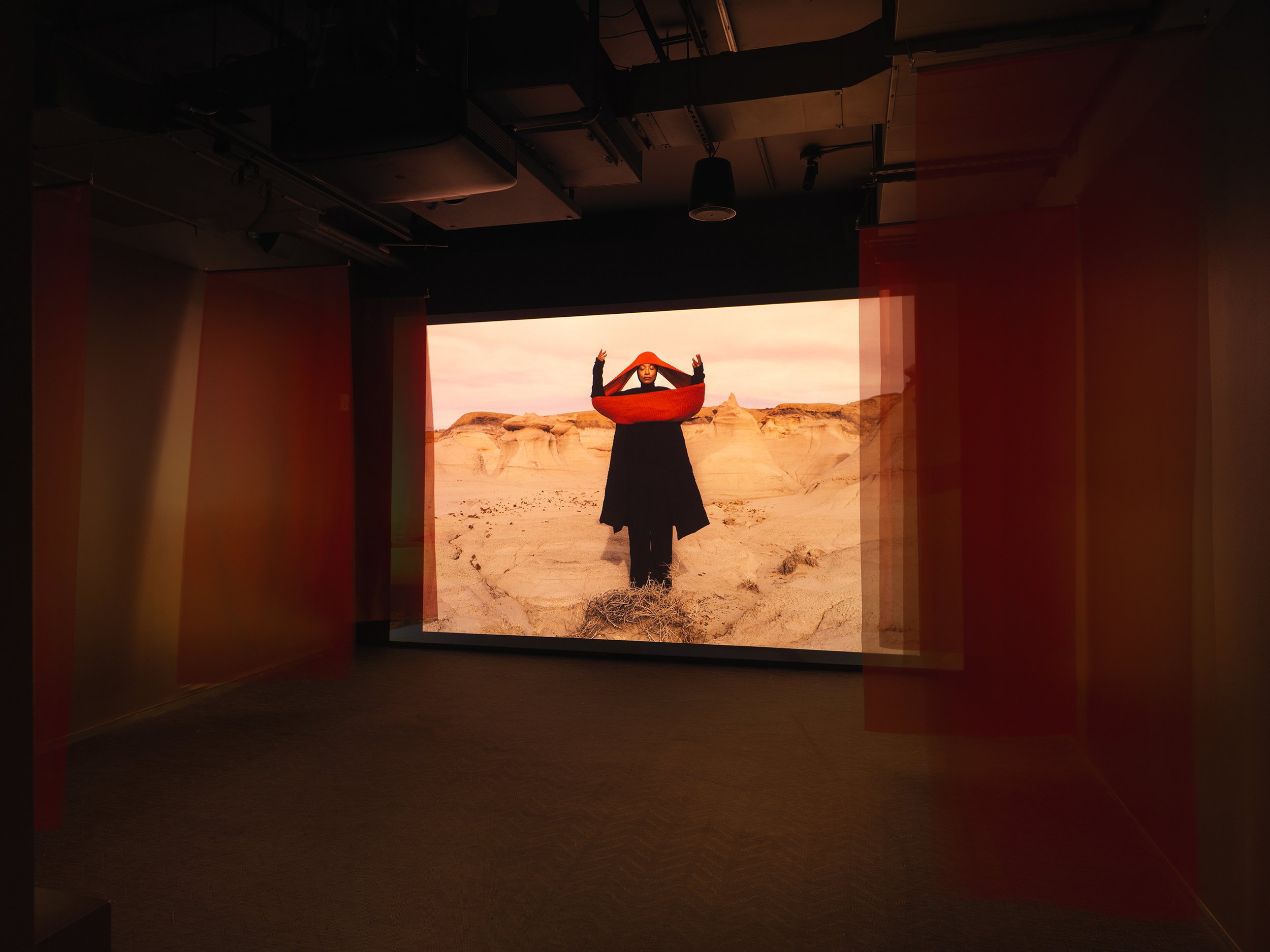
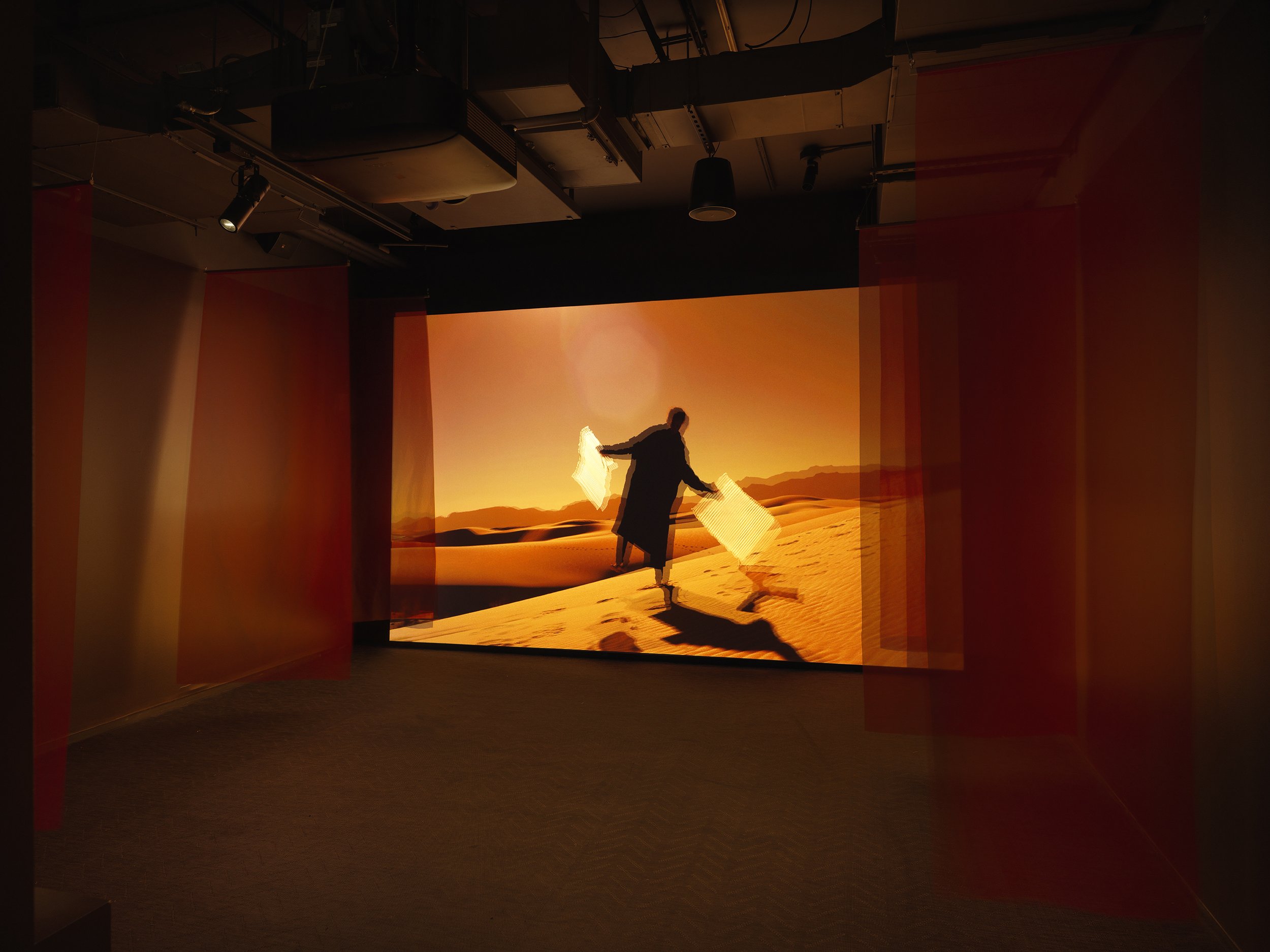
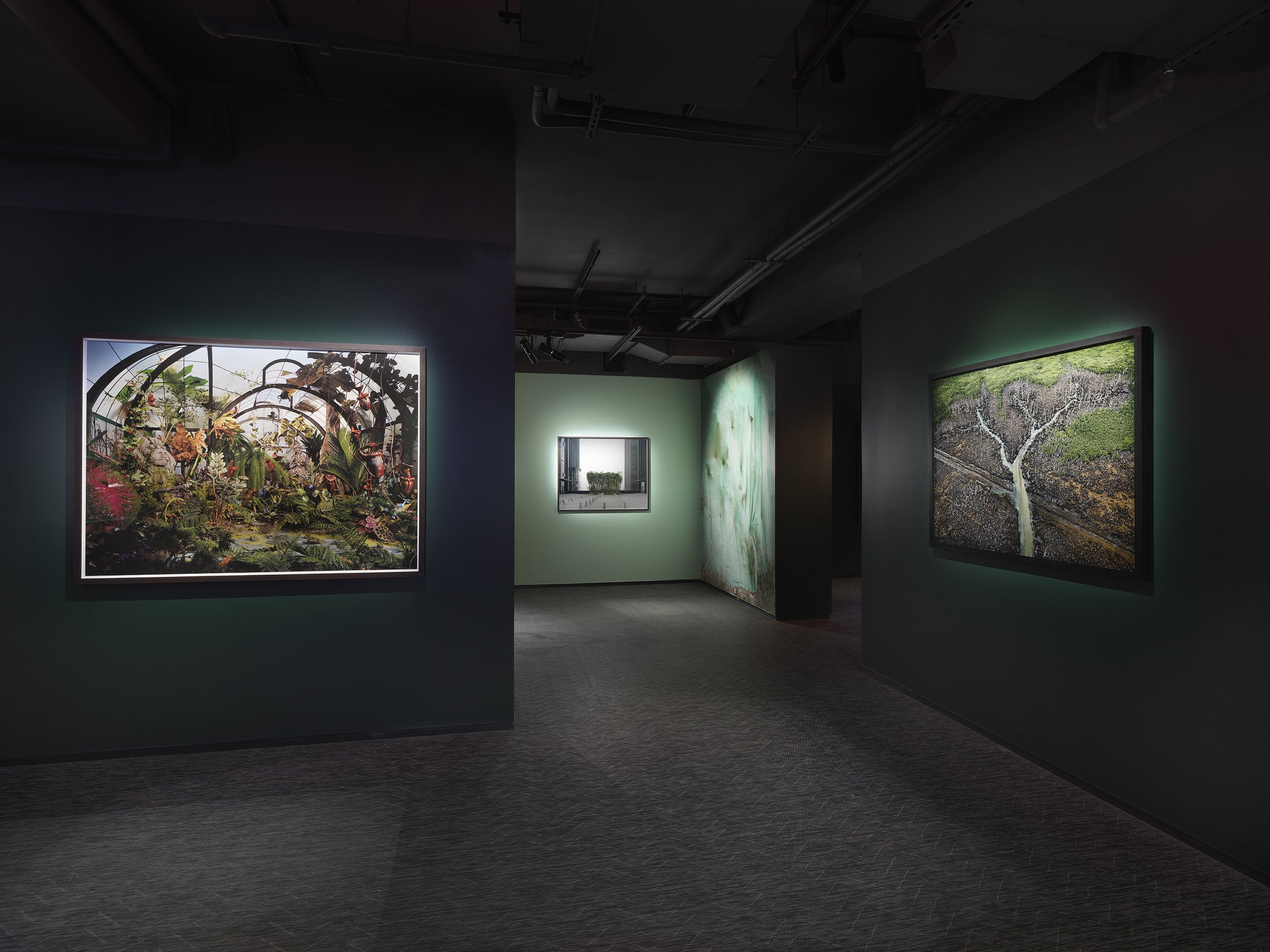
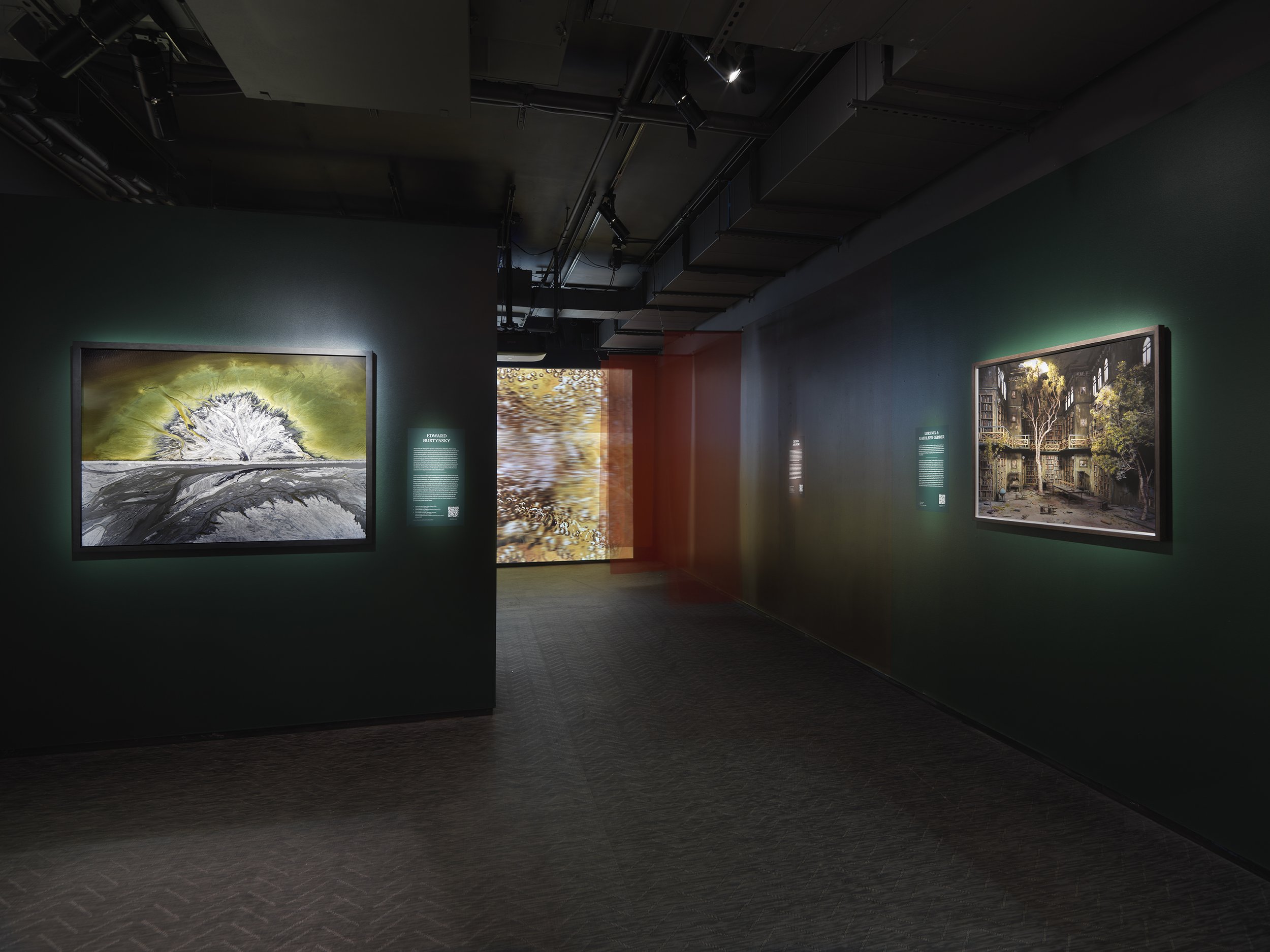
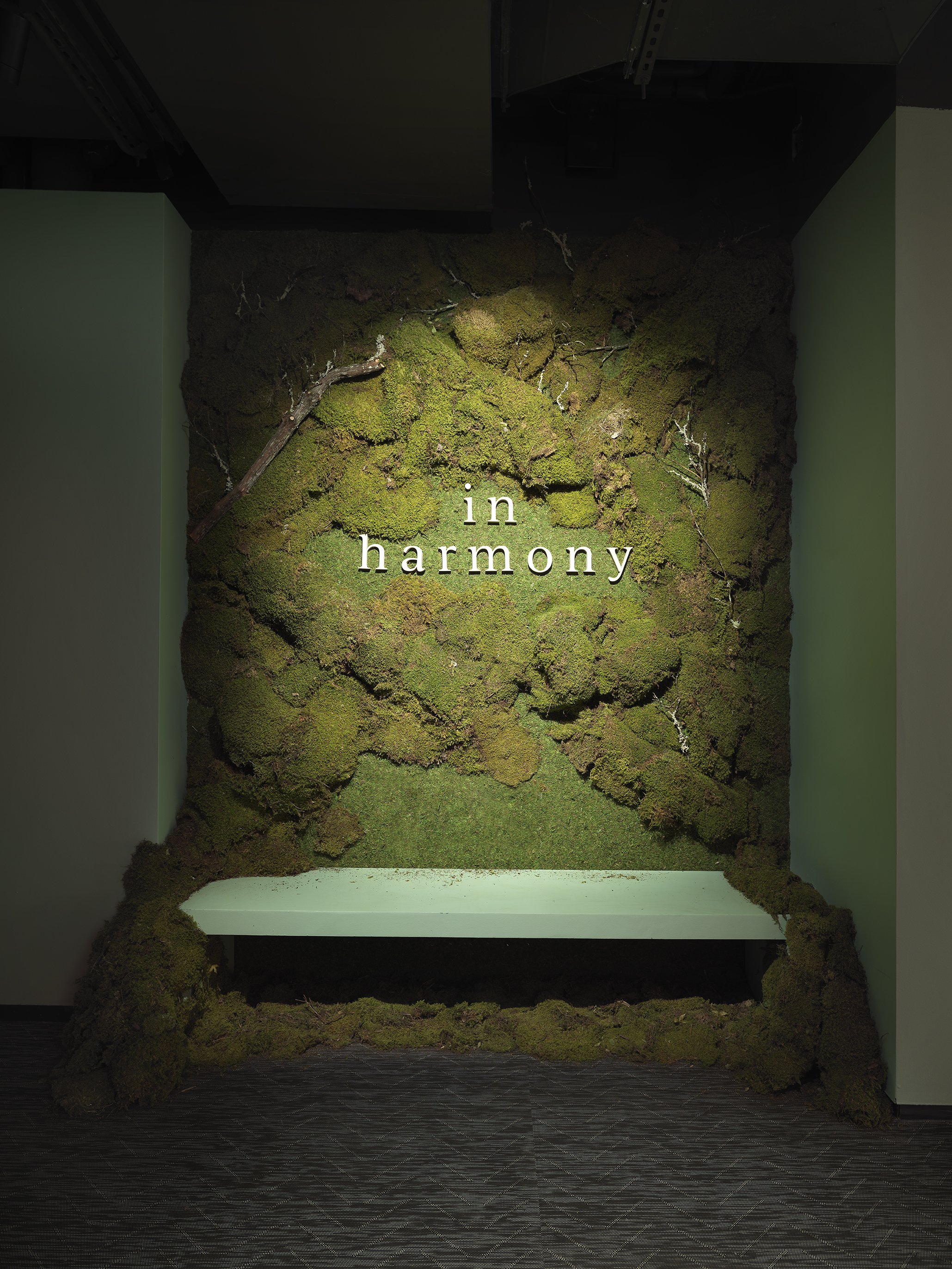
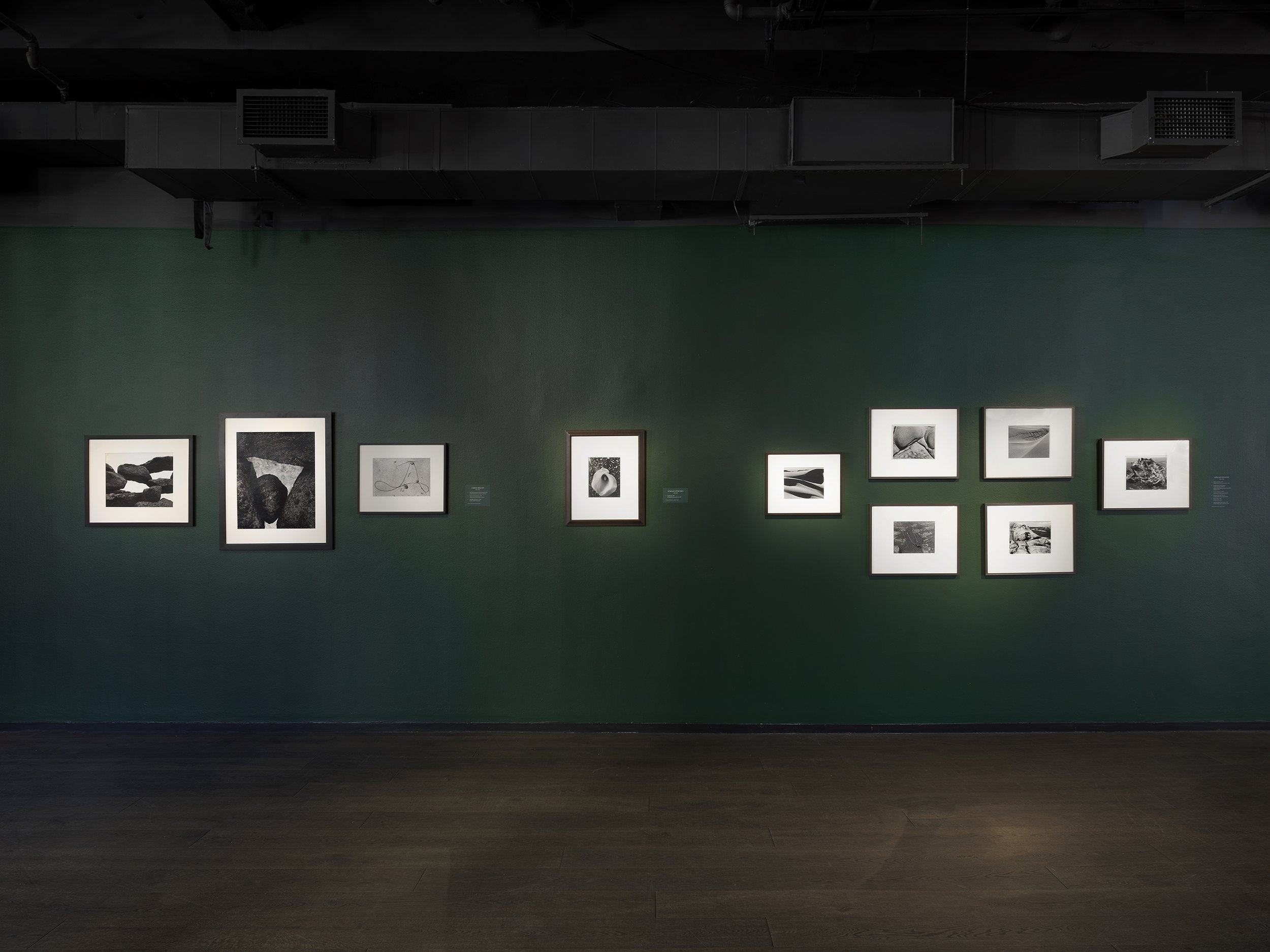
Installation View: Photography Credit: Leandro Justen. Courtesy of Fotografiska New York
The artists featured in Human / Nature include Alfredo De Stefano; Brendan Pattengale; Cig Harvey, David Ụzọchukwu; Djeneba Aduayo; Edward Burtynsky; Helene Schmitz; Lori Nix & Kathleen Gerber; Ori Gersht; Yan Wang Preston; Lewis Miller; Inka & Niclas; Pat Kane; and Santeri Tuori.
To accompany the show, a gallery on the Museum’s sixth floor will highlight pioneer photographers and the history of this genre, featuring works by Ansel Adams, Edward Steichen, Aaron Siskind, and Edward Weston.
Installation View: Photography Credit: Leandro Justen. Courtesy of Fotografiska New York
Fotografiska members were invited to preview Human / Nature during an opening night party. Guests had the chance to hear remarks from artists Edward Burtynsky and Djeneba Aduayo, as well as from environmental activist Xiye Bastida.
Tuesday, March 14
Brooklyn Ballet: “Flowers, Creatures, and Snow”
Brooklyn Ballet will perform choreography inspired by the natural world, drawing inspiration from the Waltz of the Flowers and Snowflake Waltz. In the Galleries, dancers will perform vignettes in various constellations throughout. Corresponding choreography inspired by the exhibition will be adapted for a performance in The Loft space at Fotografiska.
Monday, April 11
Unfiltered Music: Iris Trio, Project Earth
Fotografiska presents a newly commissioned musical performance by Andrew Downing and Sarah Slean, as well as newly commissioned poetry by Karen Solie. Project Earth strives to illuminate the impact of human behavior on the environment, addressing issues of climate change, pollution, habitat degradation, and biodiversity loss.
Monday, April 15
Book Launch & Talk with Pete McBride — The Colorado River: Chasing Water
Join author and photographer Pete McBride for a live talk to celebrate the release of his new book, The Colorado River: Chasing Water. Further information about programming can be found here.
About Fotografiska
Fotografiska is the contemporary museum for photography, art, and culture. Founded in Stockholm in 2010 and led globally by its Chairman Yoram Roth, Fotografiska is a destination to discover world-class photography, eclectic programming, elevated dining, and surprising new perspectives.
Guided by a mission to inspire a more conscious world through the power of photography, art, and culture, Fotografiska produces dynamic and unparalleled rotating exhibitions spanning various genres in inclusive environments. With a dedicated international community and locations in Stockholm, New York City, Tallinn, Berlin and Shanghai, Fotografiska is the premier global gathering place for photography and culture.
The exhibition runs from February 9, 2024 through May 25, 2024. For more information about Fotografiska please visit their website here. Also visit the museum on Instagram and Facebook.
Jessica Jackson Hutchins: Wrecked and Righteous
Photo: Mario Gallucci
Jessica Jackson Hutchins (born in 1971 in Chicago) has explored the relationship between art and everyday life for nearly thirty years, playfully melding materials with an unruly, intuitive approach to traditional mediums and found objects alike. Based in Portland, Oregon, Hutchins gained international recognition for her expressive sculptural assemblages that combine cast-off household items with handmade ceramic and papier-mâché elements. Recently, she expanded her artistic practice to include fused glass, producing vibrant, collage-like panels and windows that bring a form associated with exalted spiritual spaces into the secular realm. Wrecked and Righteous is the most extensive overview of Hutchins’s practice to date and includes works created since the late 1990s.
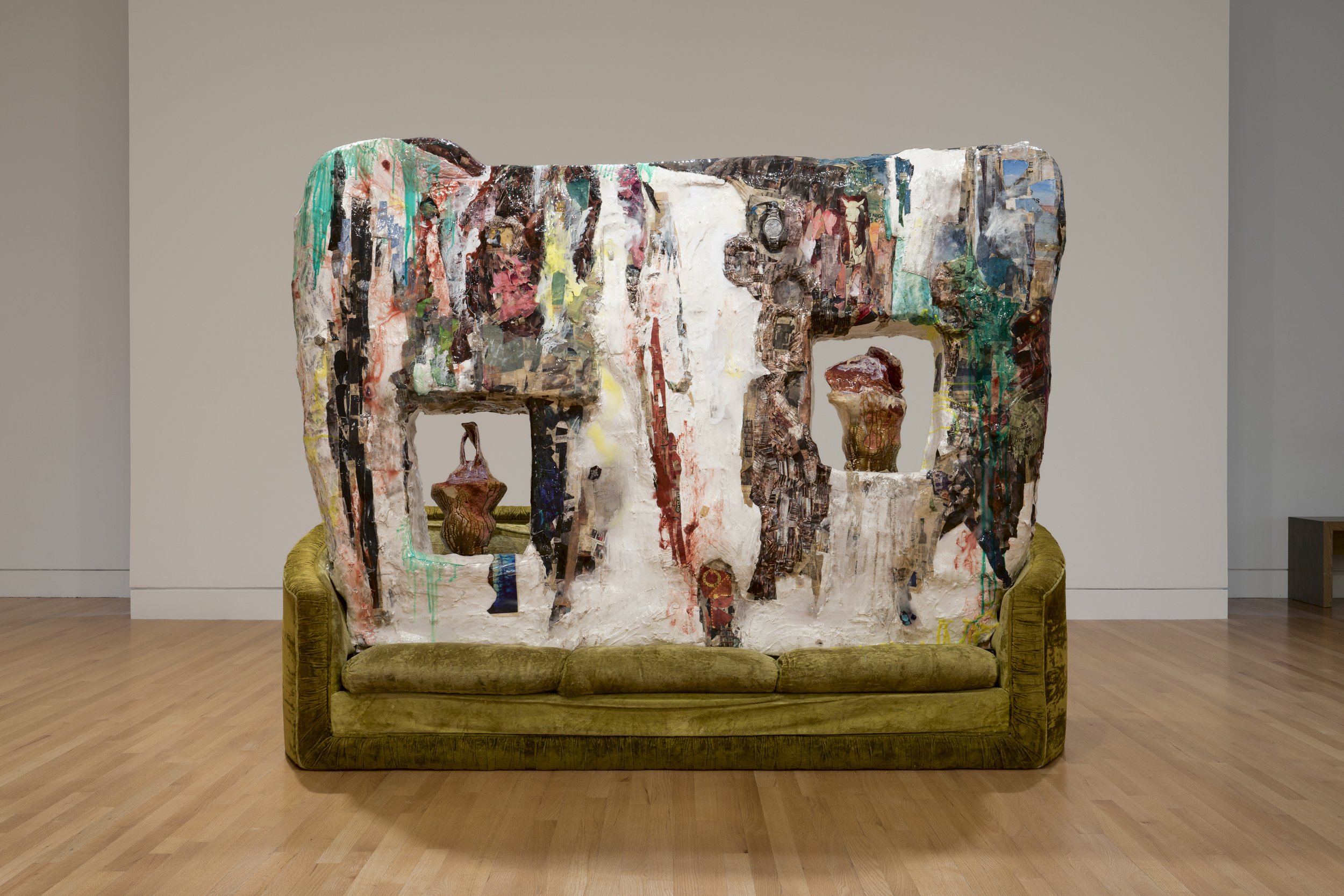
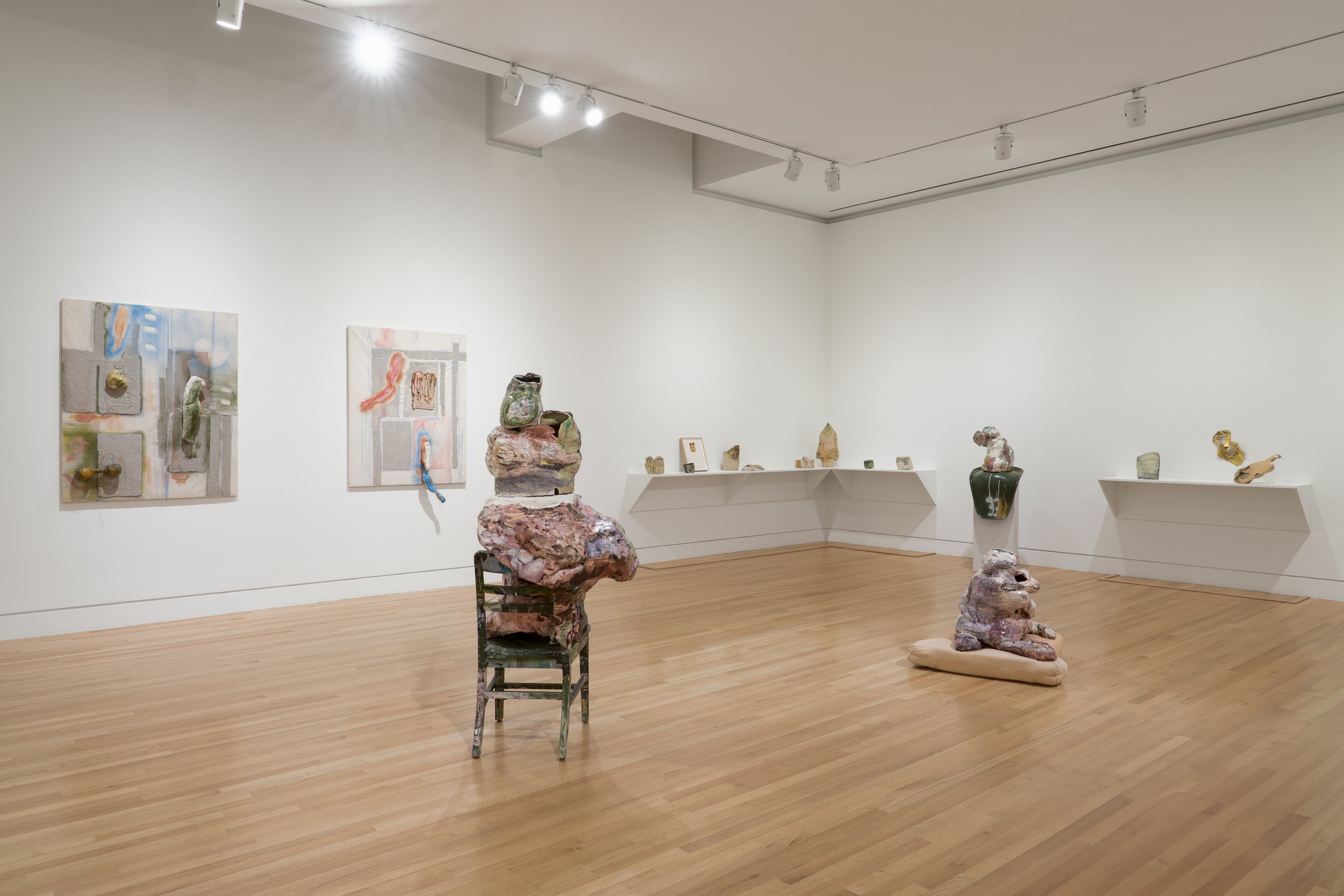

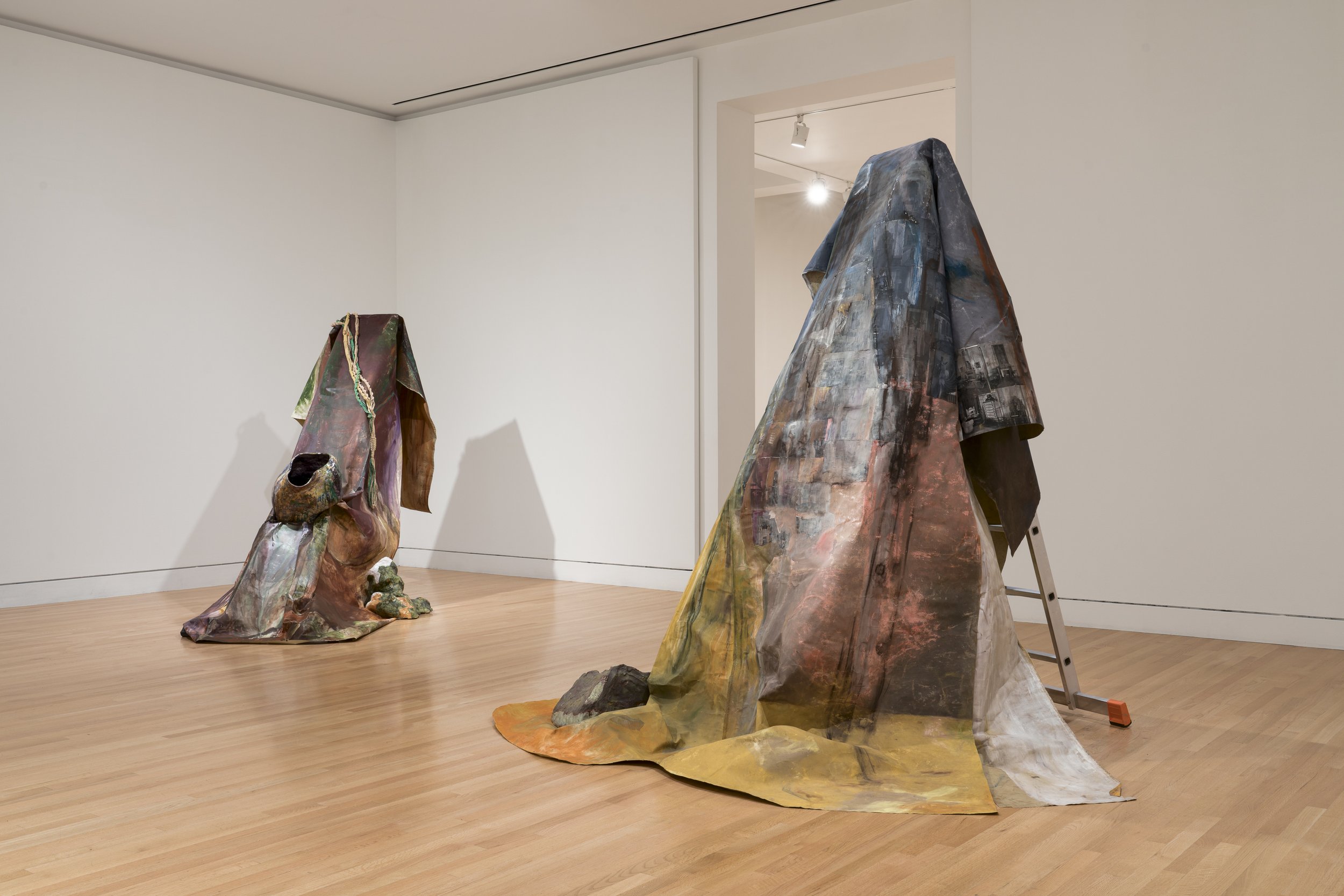
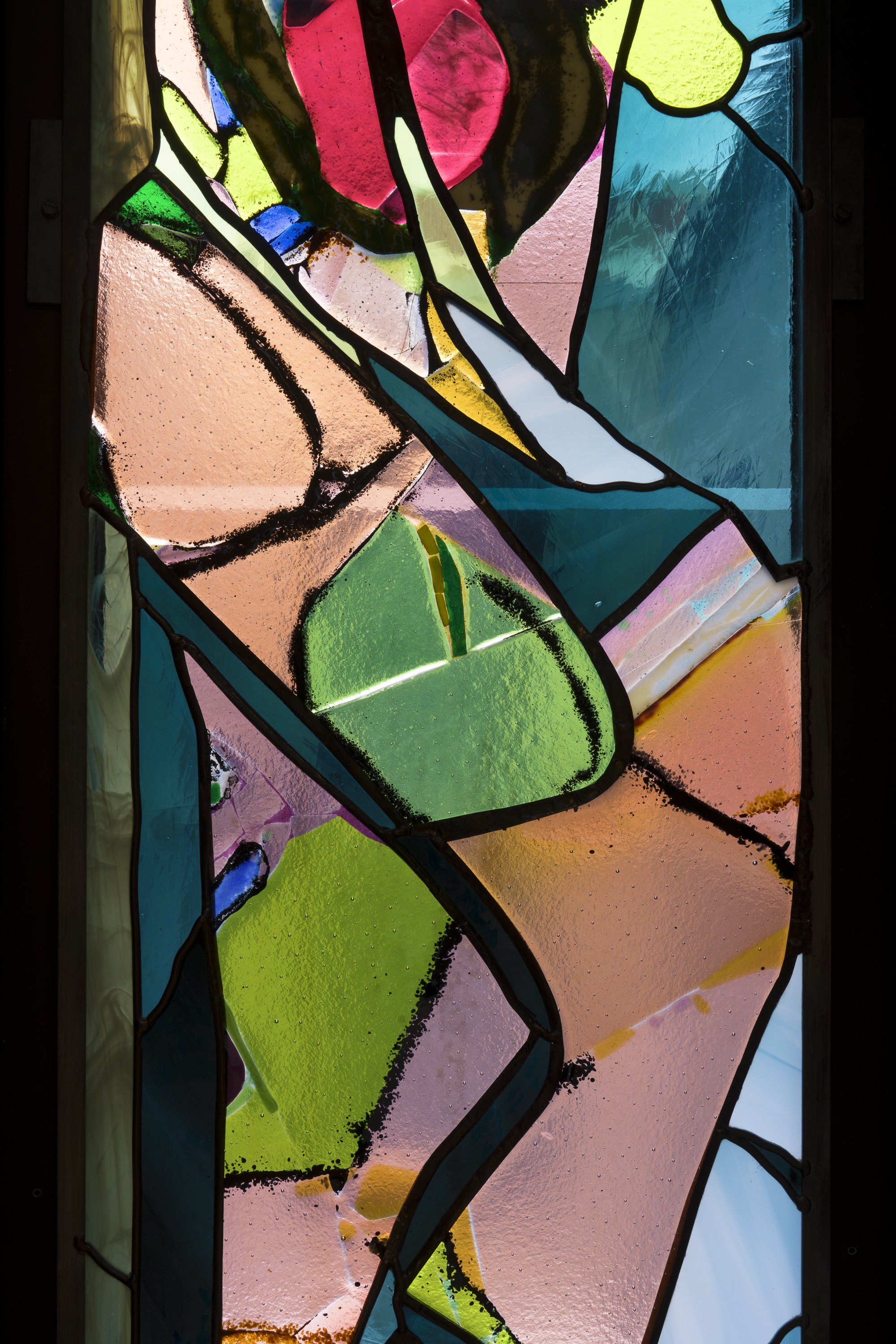
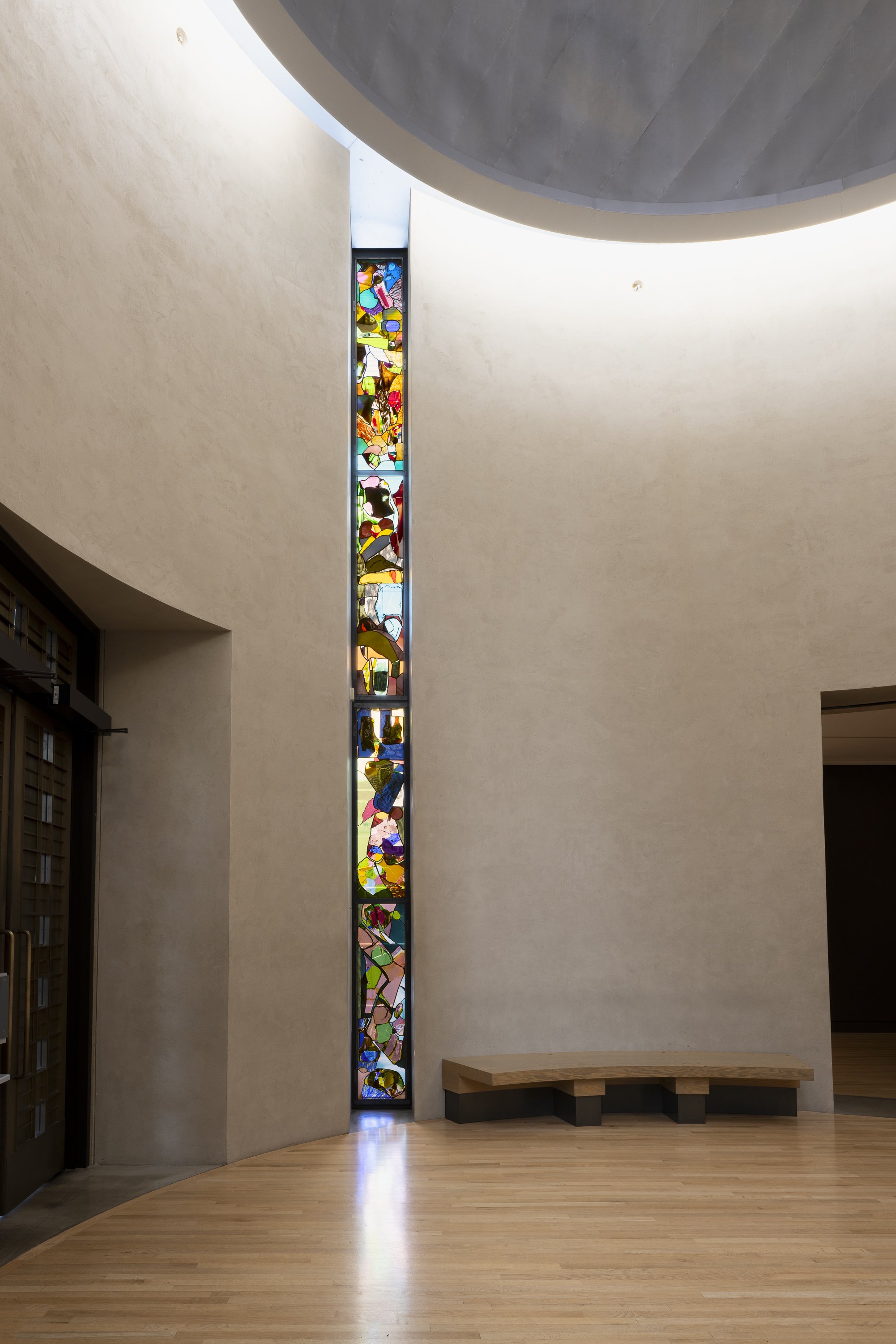
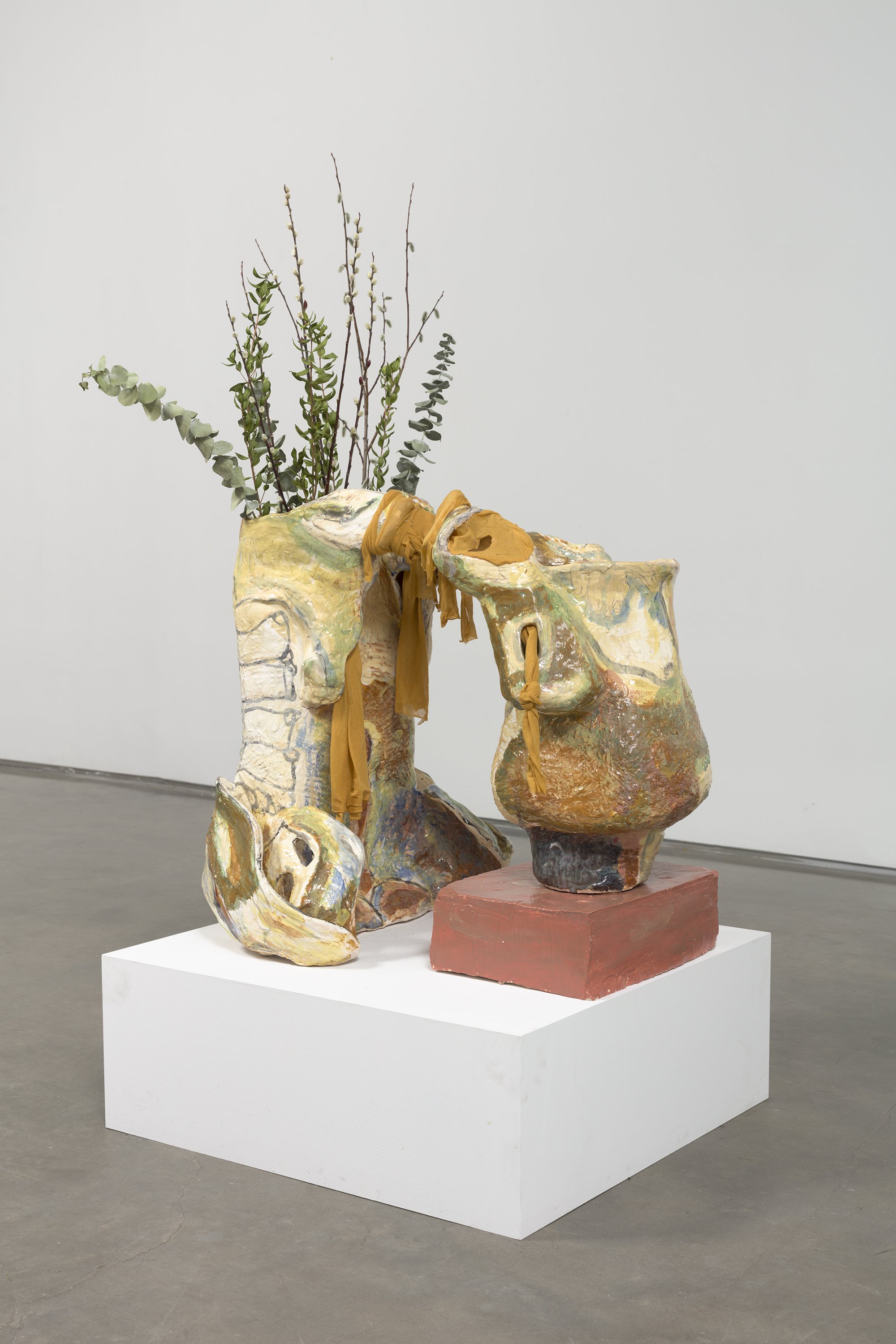

Installation view of Jessica Jackson Hutchins: Wrecked and Righteous, Frye Art Museum, Seattle, January 27–May 5, 2024. Photo: Jueqian Fang
The nonchronological presentation surveys the artist’s pursuit of immediacy and communion through art, beginning in the museum’s rotunda entryway with a site-specific fused-glass window. Within the galleries, Hutchins’s relief paintings, intimate tabletop objects, and
needlepoint compositions mingle with selected furniture sculptures— well-worn sofas and chairs cradling lumpy ceramic forms that read as surrogates for the human body.
My Friend the Poet, 2019. Ceramic, plaster, papier-mâché, collage, chair. 63 x 30 x 33 in. Courtesy of the artist. Photo: Mario Gallucci
Designed as wearable serving platters and bowls, the large, fitted food vessels in the adjacent room rest in armchairs until activated by performers during a special onetime event. The exhibition links these unwieldy prostheses to the artist’s early milagros (miracles) sculptures: papier-mâché body parts created to symbolically heal suffering people she knew or followed in the media. Drawing a thorough line of vulnerability, caring, and repair between these poles of Hutchins’s career, the exhibition honors her unique capacity for finding the sublime in ordinary places and neglected things.
Jessica Jackson Hutchins: Wrecked and Righteous is organized by Amanda Donnan, Chief Curator and Director of Exhibitions.
Lead support is provided by The Ford Family Foundation, administered by the Portland Institute for Contemporary Art.
Additional generous support was provided by the Frye Foundation and Frye Members. Media sponsorship provided by KEXP.
Third Eye, 2015. Acrylic paint, collage, fabric, ceramic, chair. 56 x 47 1/2 x 6 in. Courtesy of the artist. Photo: Mario Gallucci
Jason Seife: Coming to Fruition
Installation photograph, Jason Seife: Coming to Fruition, Pérez Art Museum, May 18, 2023, through August 11, 2024, photo © Pérez Art Museum Miami (PAMM)
(MIAMI, FL) — Pérez Art Museum Miami (PAMM) is pleased to present Jason Seife: Coming to Fruition opened on May 18, 2023. Featuring all new site-specific works including a custom wallpaper, triptychs, and a large-scale canvas, Coming to Fruition is Seife’s first solo exhibition in the United States.
“Jason was born and raised in Miami and continues to live and work here. As Miami’s flagship institution, we want the local art ecosystem to flourish and support our local artists,” said PAMM Assistant Curator Maritza Lacayo. “Jason’s very first museum visit was to Miami Art Museum, PAMM’s predecessor, and it gave him the idea that he could become an artist and exhibit his work at a museum. This exhibition is very much a full circle moment for Jason and means the world to me, as a born-and-bred Miamian as well.”
Installation photograph, Jason Seife: Coming to Fruition Nothing New, Pérez Art Museum, May 18, 2023 through August 11, 2024, photo © Pérez Art Museum Miami (PAMM)
Seife, like many Miami residents, is the son of immigrants—in his case of Cuban and Syrian descent. His oeuvre centers on his Middle Eastern heritage, referencing Persian carpets and the intricate details found in mosques and traditional Islamic art. He digitally designs his carpet-inspired compositions, mirroring weavers’ practice of associating patterns or colors with specific locations and communities. Seife subsequently hand-paints these intricate patterns onto a concrete slab or canvas. For Coming to Fruition, Seife presents his elaborate process in media res––amid the action. The effect created by this site-specific exhibition is one in which the boundary between artistic process and finished product is blurred. The process-as-product dynamic is evident in two triptychs that reveal the progression of his paintings—from initial stages and minimal paint on the concrete to intricately painted finished product.
Accompanied by an additional finished painting on canvas, the triptychs are surrounded by labyrinthine wood frames which appear to seep out of the paintings and onto the walls, as if taking over the gallery’s interior. The frames recall elaborately carved mosque ornamentation and have been made specifically for this exhibition and gallery space. The overall effect of wooden frames and paintings on the concrete walls recalls a phenomenon common to both Cuba and Syria: beautifully painted buildings that have been reduced by war or neglect to their wood and concrete shells. The site-specificity of Coming to Fruition allows Seife to present a secular sanctuary wherein the visitor can meditate on human desecration, community-building, and complicated identities.
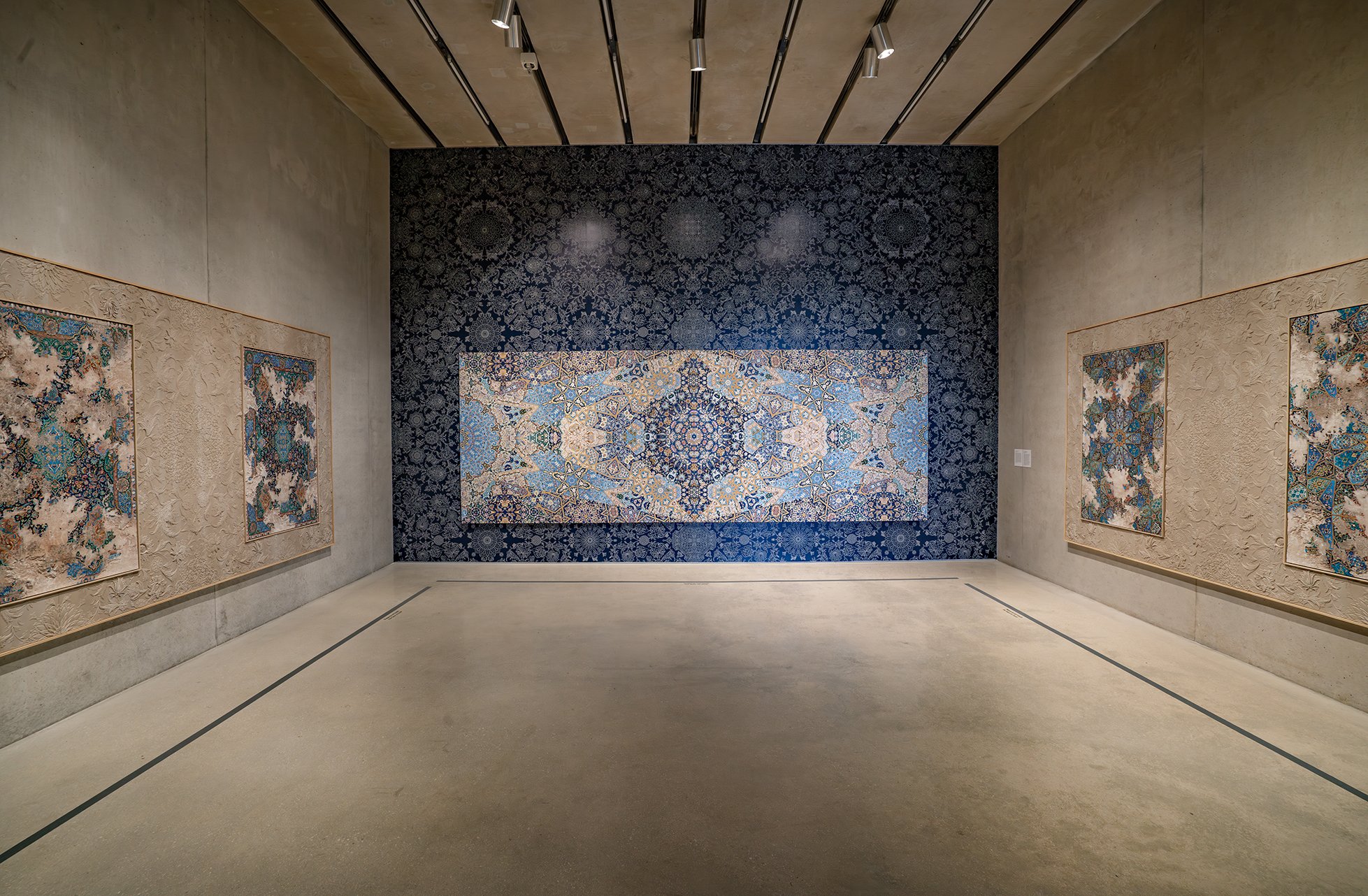
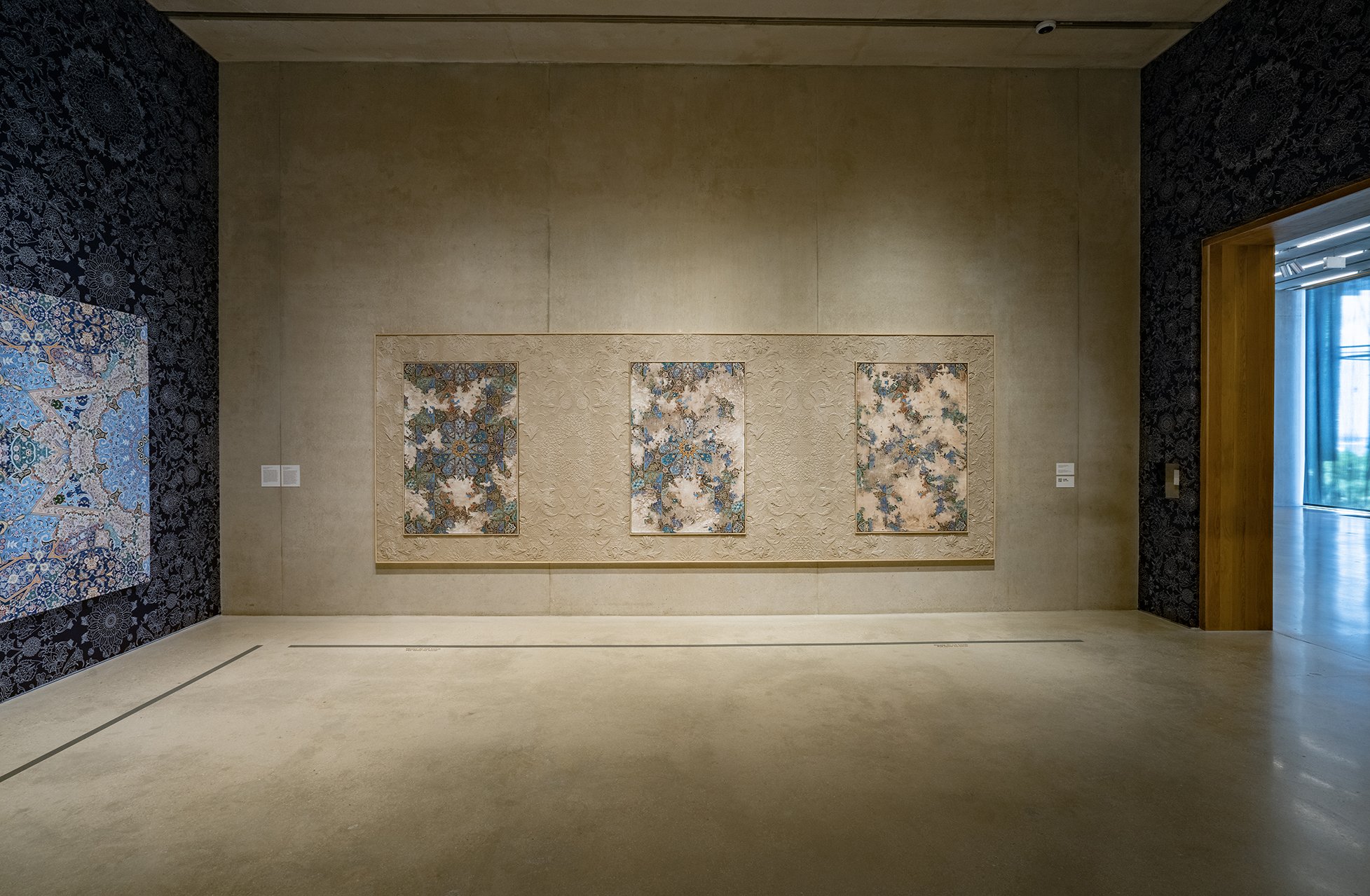
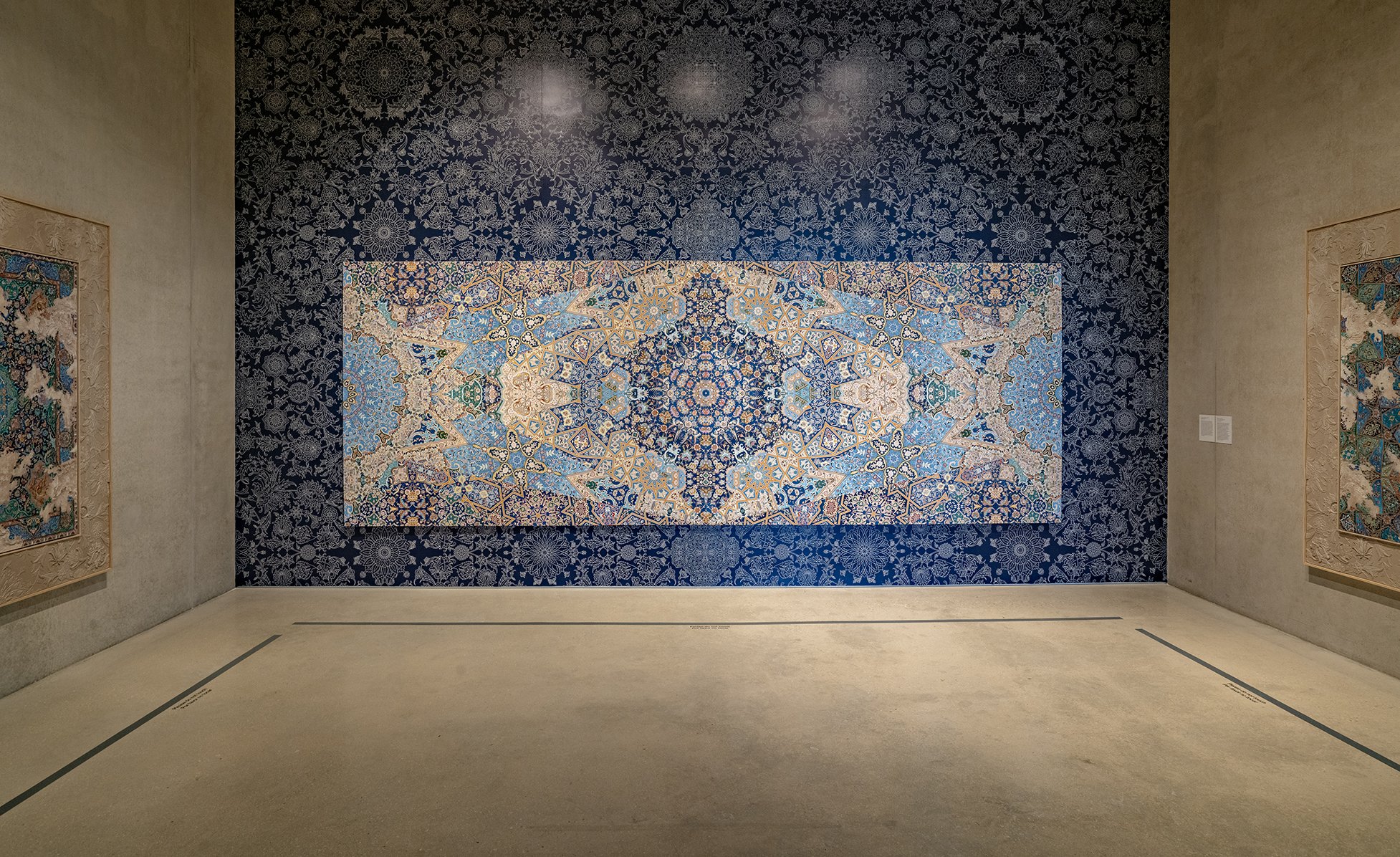
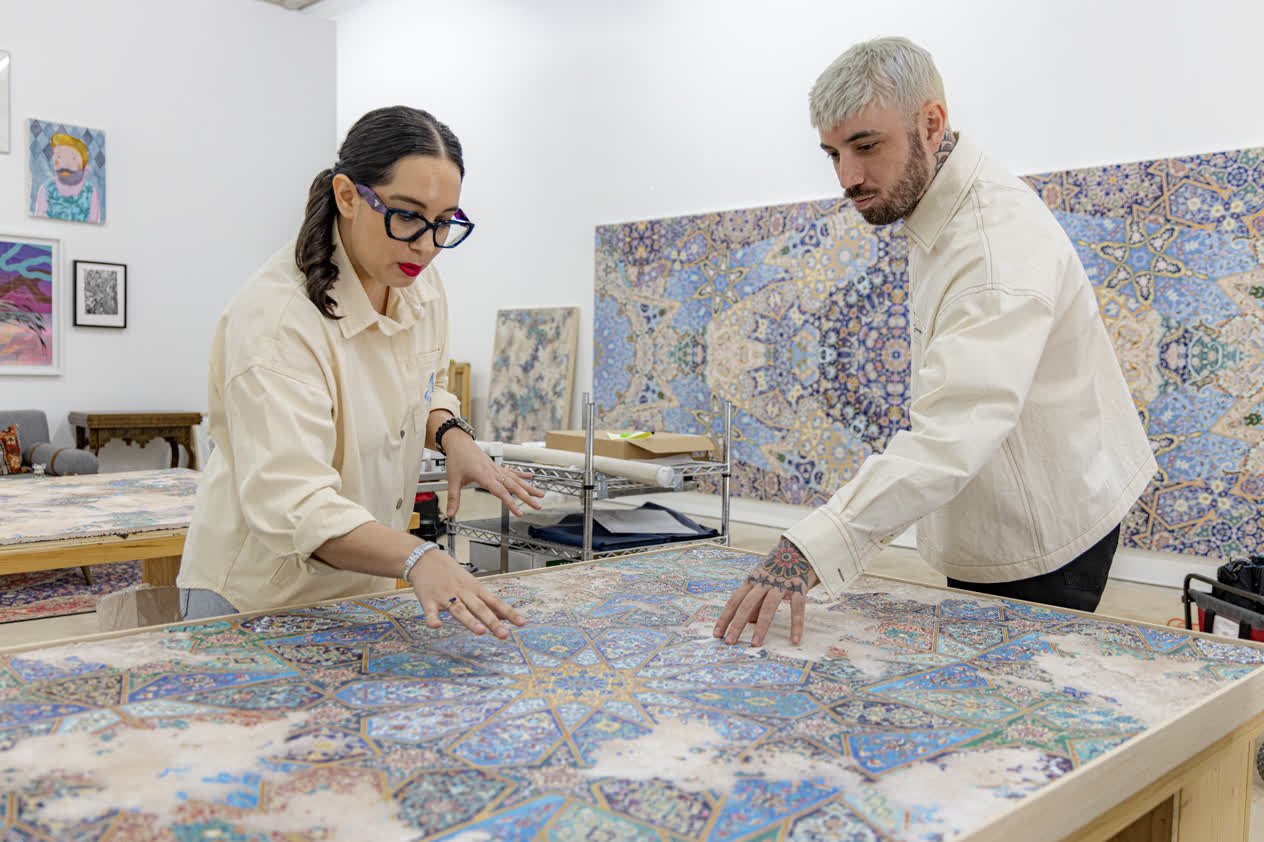
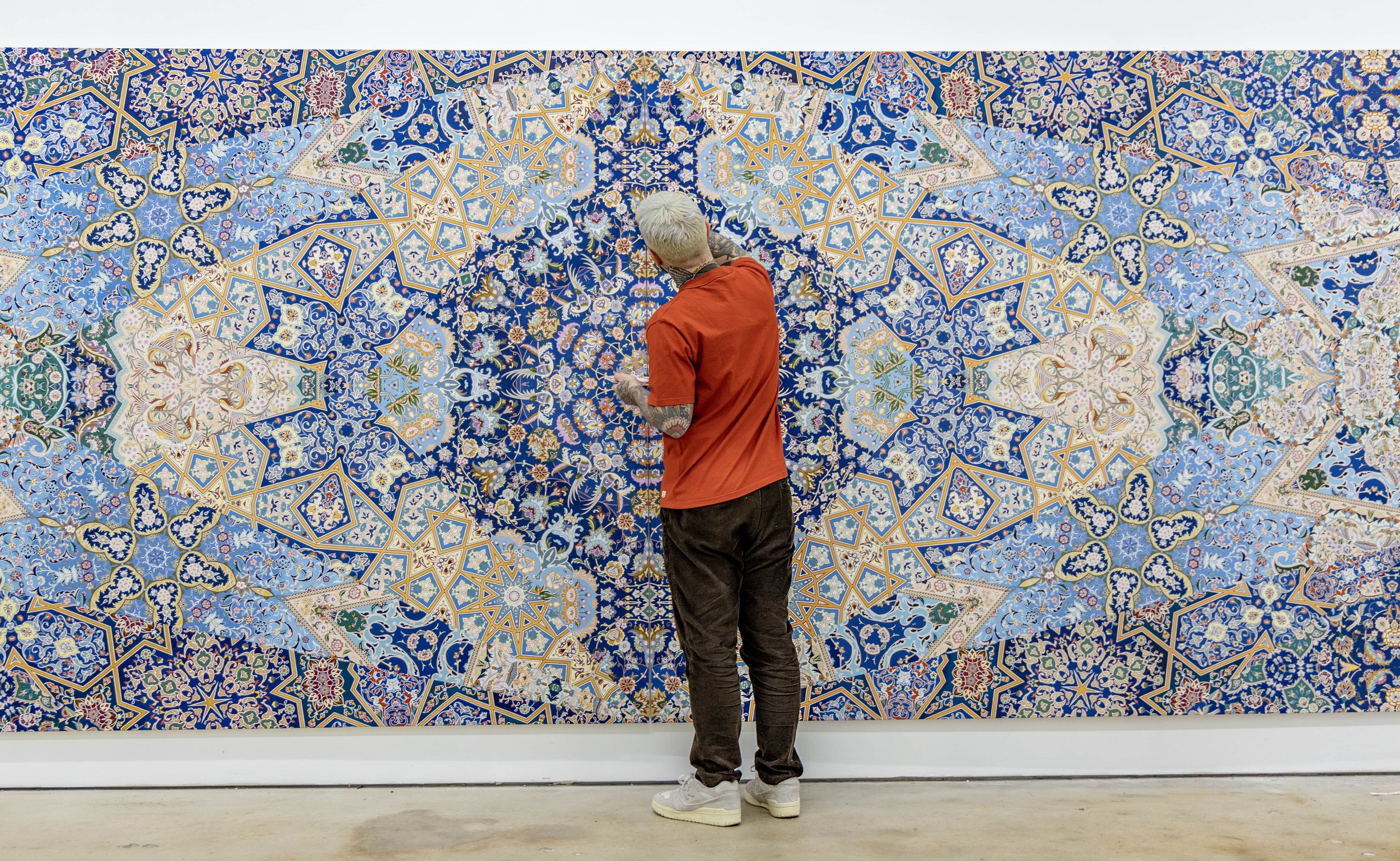
Installation photograph, Jason Seife: Coming to Fruition Nothing New, Pérez Art Museum, May 18, 2023 through August 11, 2024, photo © Pérez Art Museum Miami (PAMM)
“Jason Seife’s work and facility with old and new technology to make art objects is remarkable. While finding inspiration in art from antiquity, he is also incredibly versed in the art of our time, specifically in new digital advancements in technology, including NFT’s and the burgeoning space of Web3. Also evident of his versatility and a reflection of his timeliness, he has been a collaborator with artists from other disciplines,” said PAMM Director Franklin Sirmans. “A true collaboration between artist and curator, Jason and Maritza—two Miamians who visited PAMM growing up—we hope our community can draw inspiration from their example as well.”
Jason Seife: Coming to Fruition is organized by PAMM Assistant Curator Maritza Lacayo. Ongoing support for PAMM’s project galleries from Knight Foundation is gratefully acknowledged.
photo © Pérez Art Museum Miami (PAMM)
ABOUT JASON SEIFE
Jason Seife lives and works out of Miami, Florida. Despite being accepted to some of the most prestigious art schools in America, Jason opted for a more hands on approach and dove straight into the art world. Paving his way through graphic design, Jason has worked with some of the largest names in the music business including Kanye West, Pharrell Wiliams, Big Sean and Nicki Minaj, designing everything from album artwork to jewelry and merchandise. Refusing to be limited to one form of Art, Jason's true passion lies in painting. His work is loosely based on reinventing the past by using modern day materials and compositions to change the way the viewer experiences a once overlooked piece of art. Seife has presented solo exhibitions at Tabari Artspace, Dubai; Museo Carlo Bilotti, Rome; Unit London; Sharjah Art Museum, United Arab Emirates; Montoro12 Gallery, Brussels; and the Outsiders, Newcastle, United Kingdom. His work has been included in a number of group exhibitions, including those at Unit London; Joshua Liner Gallery, New York; Leila Heller Gallery, Dubai; Bedford Art Center, Lesher Center for the Arts, Walnut Creek, California; Montoro12 Gallery; Hashimoto Contemporary, San Francisco; and
Peveto Gallery, Houston. His work is included in numerous public and private collections, including Fort Wayne Museum of Art; Mosaic Art Foundation, Istanbul; Goss-Michael Foundation, Dallas; Dean Collection, Los Angeles; Contemporary Art Platform Kuwait; and Tribal Art Foundation, Raipur, India.
ABOUT PAMM
Pérez Art Museum Miami (PAMM), led by Director Franklin Sirmans, promotes artistic expression and the exchange of ideas, advancing public knowledge and appreciation of art, architecture, and design, and reflecting the diverse community of its pivotal geographic location at the crossroads of the Americas. The nearly 40-year-old South Florida institution, formerly known as Miami Art Museum (MAM), opened a new building, designed by world-renowned architects Herzog & de Meuron, on December 4, 2013 in Downtown Miami’s Maurice A. Ferré Park. The facility is a state-of-the-art model for sustainable museum design and progressive programming and features 200,000 square feet of indoor and outdoor program space with flexible galleries; shaded outdoor verandas; a waterfront restaurant and bar; a museum shop; and an education center with a library, media lab, and classroom spaces.
Accredited by the American Alliance of Museums, Pérez Art Museum Miami (PAMM) is Sponsored in part by the State of Florida, Department of State, Division of Arts and Culture and the Florida Council on Arts and Culture. Support is provided by the Miami-Dade County Department of Cultural Affairs and the Cultural Affairs Council, the Miami-Dade County Mayor and Board of County Commissioners. Additional support is provided by the City of Miami and the Miami OMNI Community Redevelopment Agency (OMNI CRA). Pérez Art Museum Miami is an accessible facility. All contents ©Pérez Art Museum Miami. All rights reserved.
For more information about this exhibit and other exhibits currently on view and upcoming, please visit the Pérez Art Museum website here. PAMM can also be found on Instagram, YouTube, TikTok, and Facebook.
Puppies Puppies (Jade Guanaro Kuriki-Olivo): Nothing New
Installation photograph, Puppies Puppies (Jade Guanaro Kuriki-Olivo): Nothing New, The New Museum, October 12, 2023, through March 3, 2024, photo © The New Museum
The New Museum presents the first New York solo exhibition of conceptual and performance artist Jade Guanaro Kuriki-Olivo (b. 1989, Dallas, Texas), widely known by the moniker Puppies Puppies. On view through March 3, 2024, “Nothing New” transforms the New Museum’s glass-walled Lobby Gallery into a mise-en-scène for Kuriki-Olivo’s daily life, with a portion of the space functioning as a duplicate of the artist’s actual bedroom. Using a fogging glass mechanism, Puppies Puppies will alternately obscure and reveal her activities in the gallery to visitors, foregrounding themes of visibility, representation, and cultural consumption.
Puppies Puppies (Jade Guanaro Kuriki-Olivo), Plague, 2019. Installation view from Halle für Kunst Lüneburg. Courtesy the artist, Halle fur Kunst, Luneburg and Hannah Hoffman, Los Angeles. Photo: Fred Dott
Kuriki-Olivo expands on contemporary ideas around the readymade by imbuing ubiquitous and everyday objects, signifiers, and actions with a personal and political charge. She has, for example, reconfigured antibacterial gel dispensers, toilet bowl liquid, and the color green—as well as the acts of sleeping, peeing, and taking a pill—in installations and performances that question ableist frameworks of artistic and capitalist production. Many of Puppies Puppies’ exhibitions have also included actionable components: a GoFundMe to support a friend’s transition fund; free HIV testing and counseling; a working shower available for use by the public. Kuriki-Olivo thus asserts that life can be viewed as its own form of endurance practice, especially for those whose very survival is at stake, including trans, nonbinary, and gender- nonconforming people of color.
Puppies Puppies (Jade Guanaro Kuriki-Olivo), Barriers (Stanchions), 2017. Installation view: T293, Rome. Courtesy the artist, T293, Rome and Hannah Hoffman, Los Angeles
Much of Puppies Puppies’ past work has also centered around a refusal to be seen. She has used proxies to speak or act on her behalf during studio visits, interviews, and performances; donned costumes that function as avatars, dressing as SpongeBob, a Minion, Gollum, Freddy Krueger, and Lady Liberty; and staged performances in absentia. “Nothing New” marks an important shift in the artist’s practice, exploring new registers of transparency and obfuscation by inviting visitors to experience Kuriki-Olivo’s life as if through a screen.
Puppies Puppies (Jade Guanaro Kuriki-Olivo), MRI scans from having a brain tumor removed in 2010 (documents from having brain cancer), 2010–2021. MRI Scans. Installation View: Kunsthaus Glarus. Courtesy the artist, Kunsthaus, Glarus, and Hannah Hoffman, Los Angeles. Photo: CE
Cameras will film the artist as she navigates between the New Museum, her Lower East Side apartment, and her day-to-day life in the city, with live footage broadcast onto monitors at the Museum. By engaging with contemporary modes of surveillance in both their self-enacted and nonconsensual manifestations, Puppies Puppies blurs the boundaries between her public and private life while also destabilizing the distinctions between URL and IRL existence. Using the heightened setting of the museum space, “Nothing New” considers how camming, chatrooms, social media, and other forms of online surveillance and display can be tools of connection and survival that also risk producing new forms of exploitation and control. “Nothing New” thus establishes a reflection on the art world's power dynamics and financial structures and the ways in which they mirror those of sex work, as well as other modes of connection that emerge via the internet and in real life.
Puppies Puppies (Jade Guanaro Kuriki-Olivo), Public shower (shower is available to be used), 2016. Performance, shower (public shower participant). Image courtesy the artist, Kunsthaus, Glarus, and Hannah Hoffman, Los Angeles. Photo: Stefan Burger
Visible through the glass wall of the Lobby Gallery, a reproduction of Kuriki-Olivo’s bedroom will be flanked by two additional vignettes revealing aspects of her familial heritage and interior world. On one side, a Torii gate and a scaled-down recreation of the garden at Ryōan-ji Temple in Kyoto delineate the entrance into a sacred space. On the other, MRI scans of the artist’s brain accompany a small hemp growing station relating to her use of CBD to prevent seizures during treatment and recovery from a brain tumor, as well as the broader mental health benefits of regular cannabis use for, in her words, “a trans woman navigating this world.” By allowing a spectacularized view into her daily existence and elements of her personal history, Kuriki-Olivo asserts the nuanced layers of her own identity, eliding tokenization and reductive narratives of racial and trans identities.
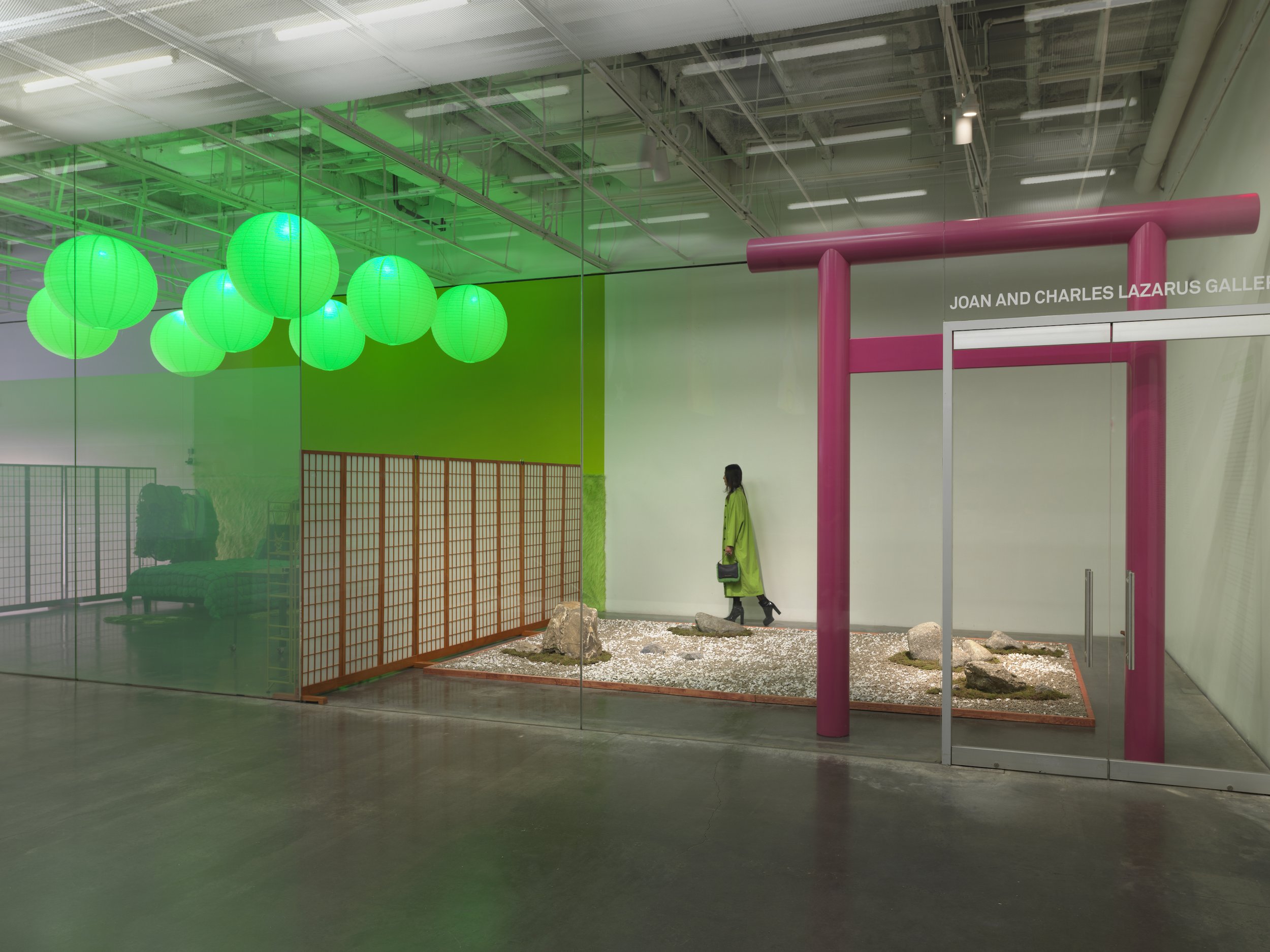
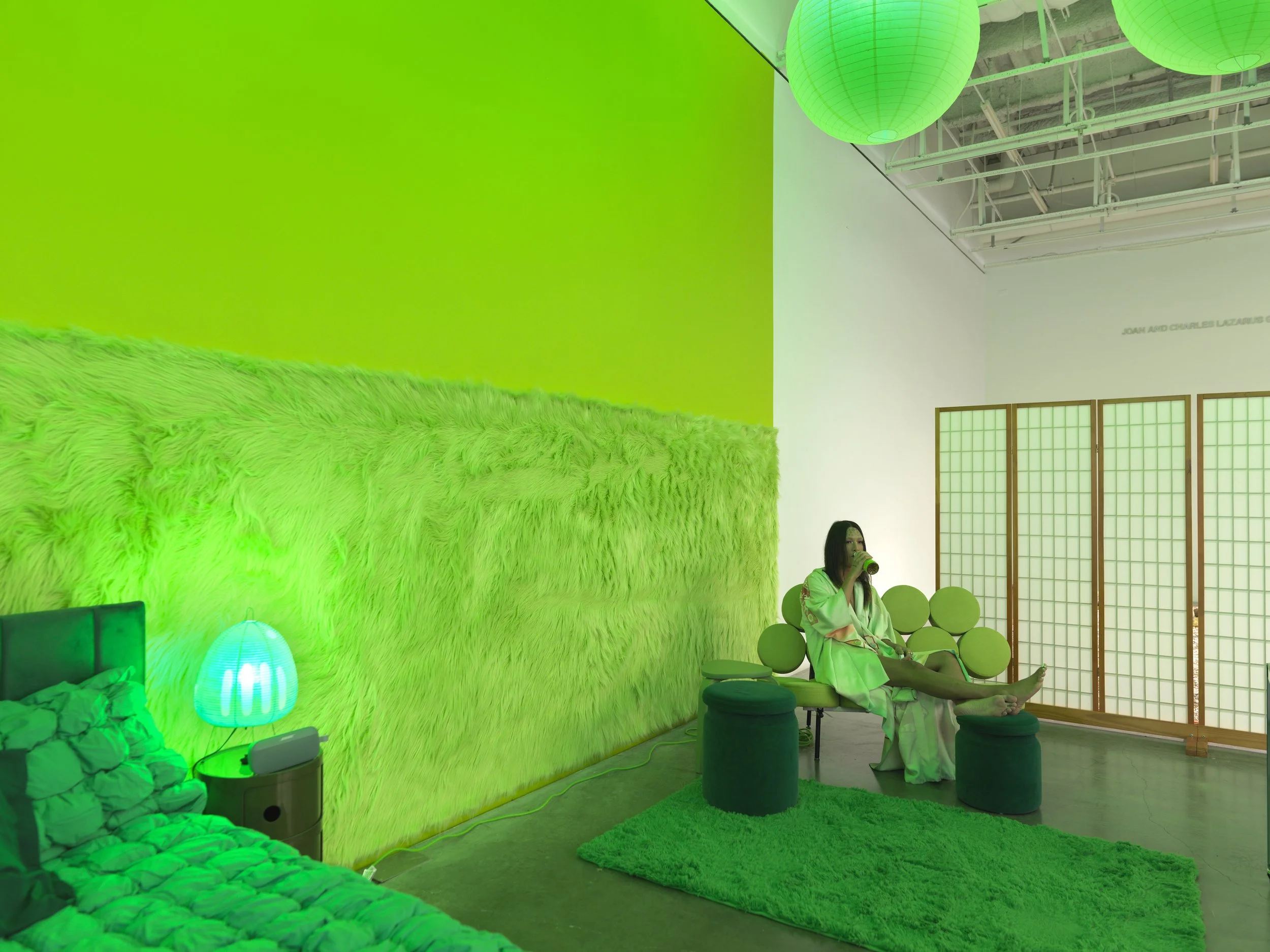

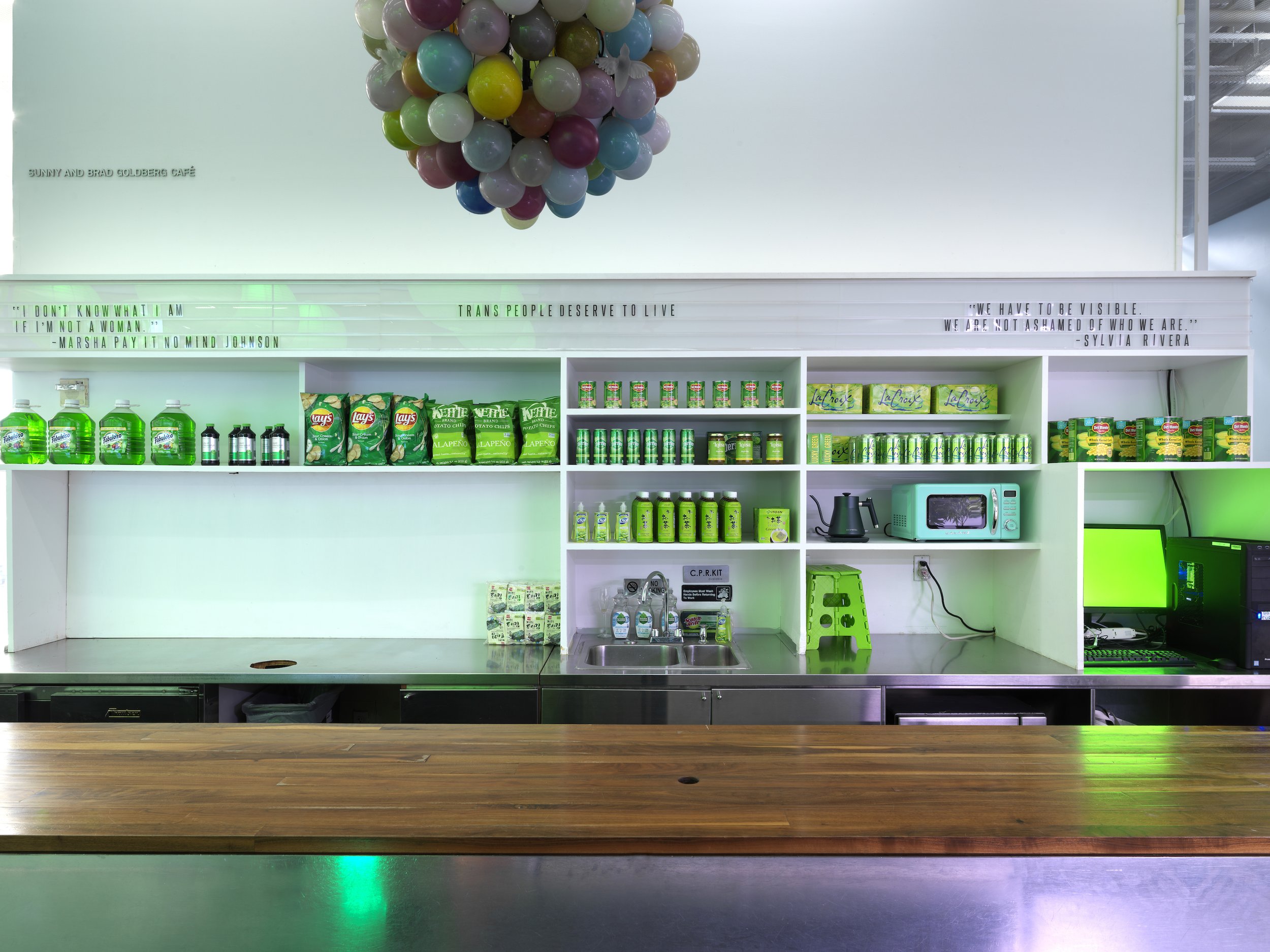
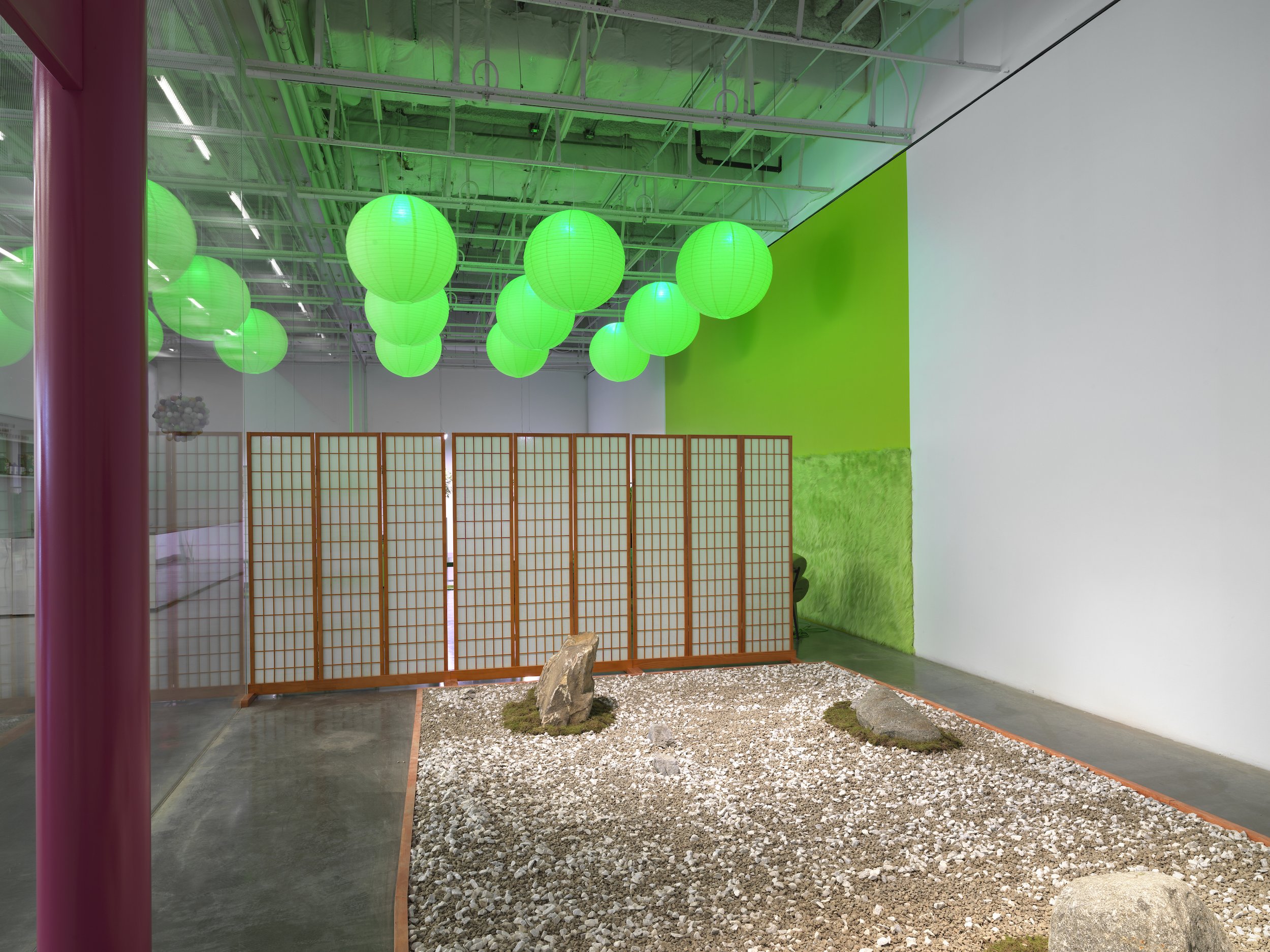
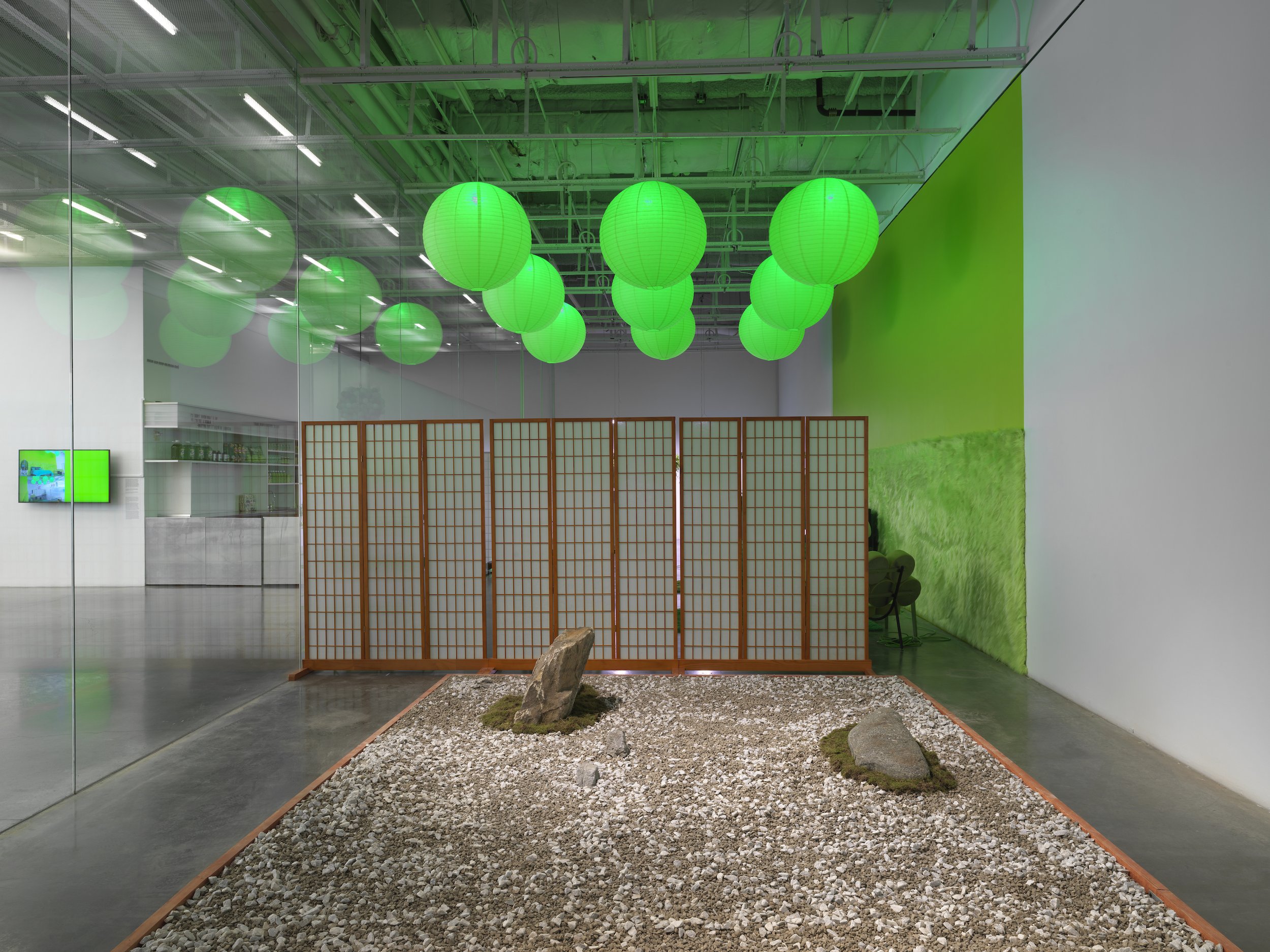
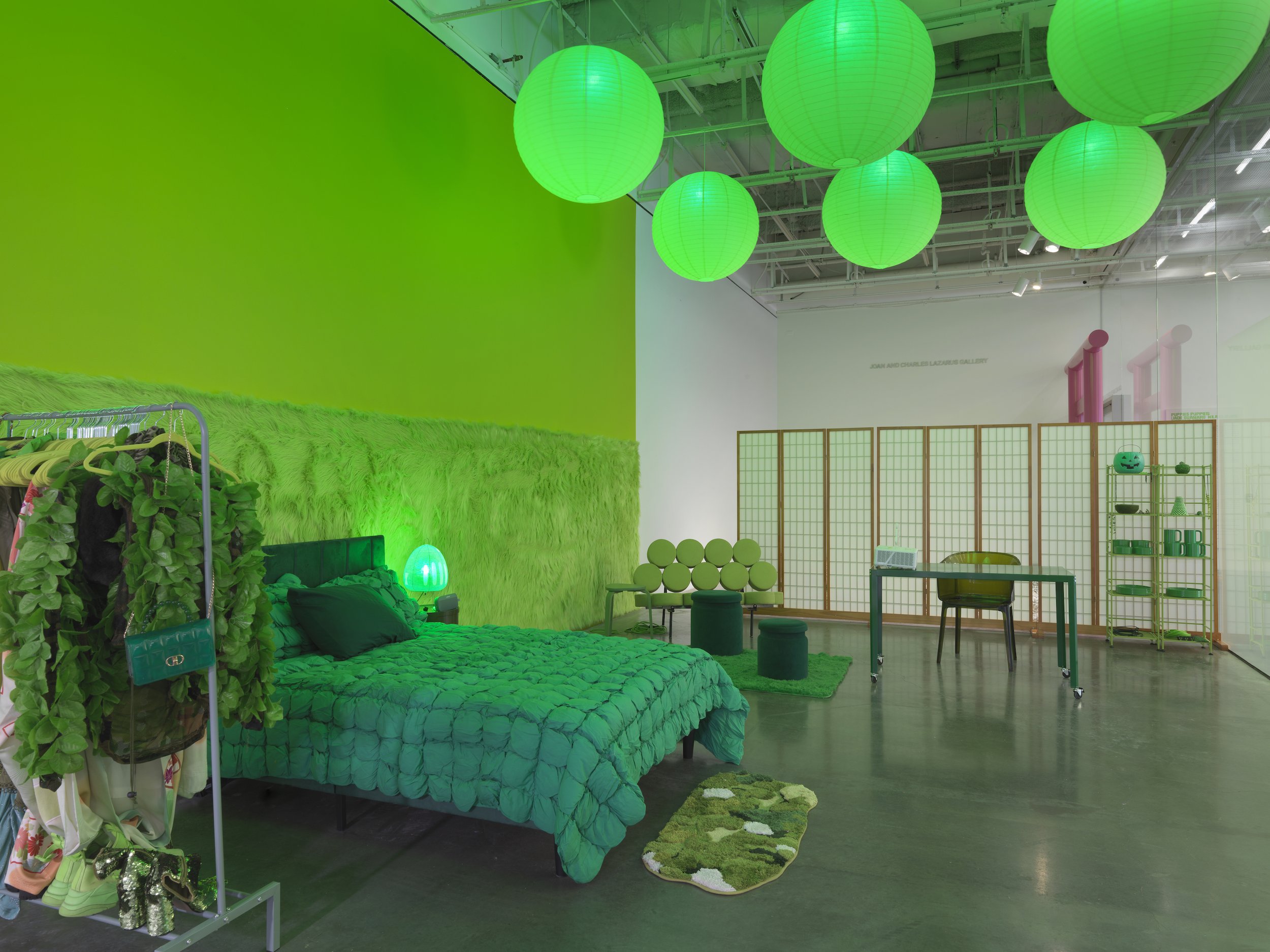
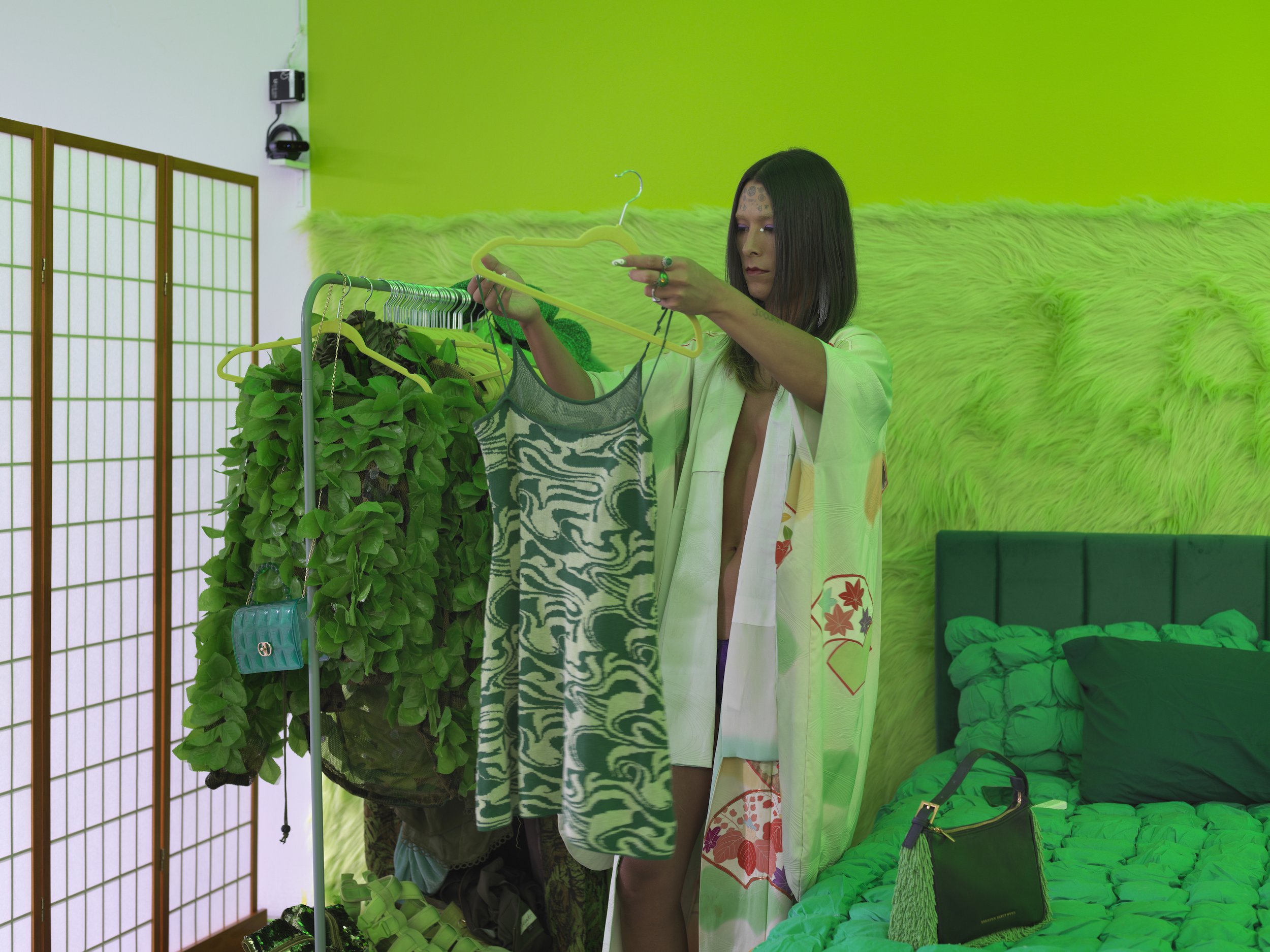
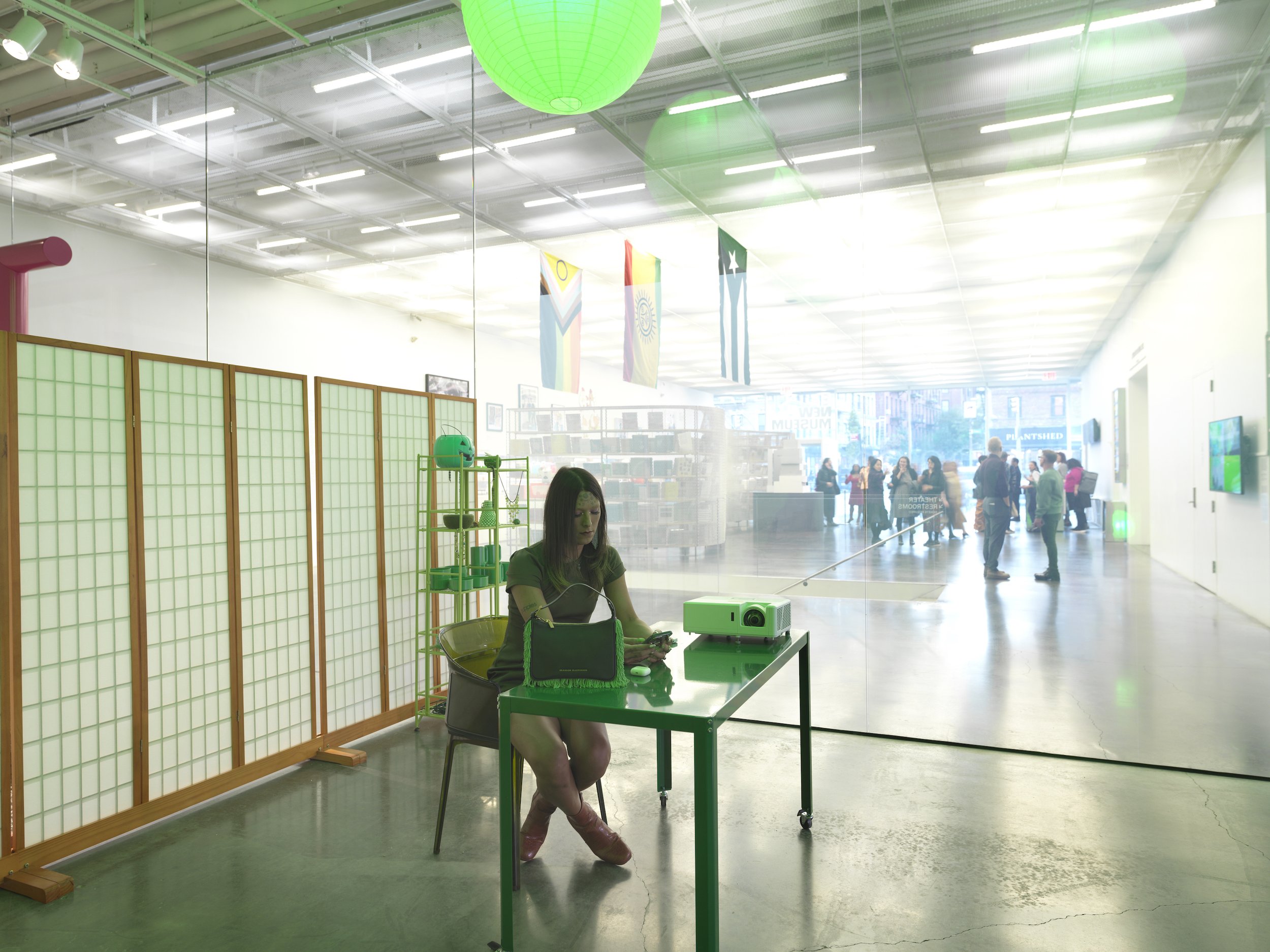
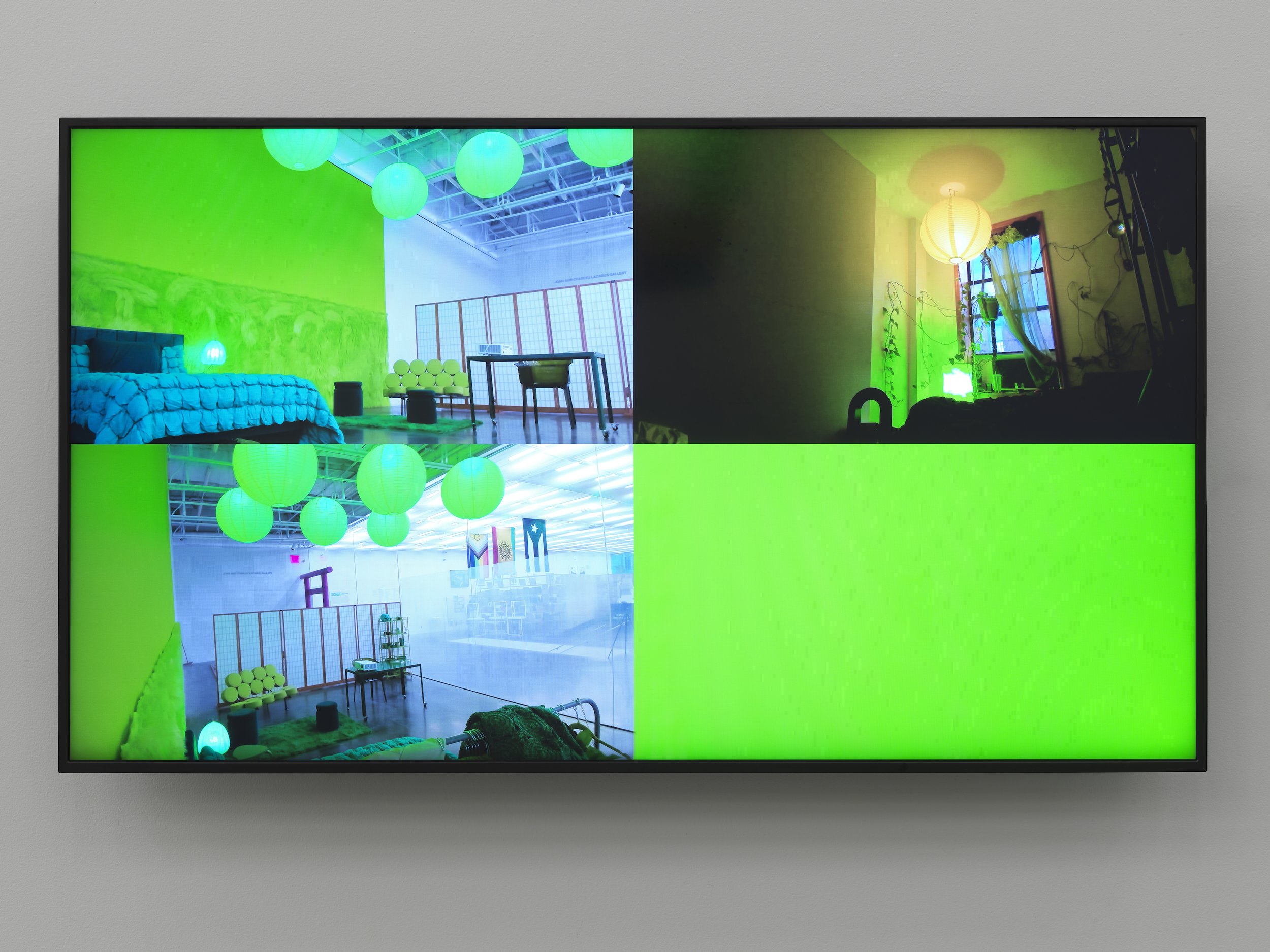
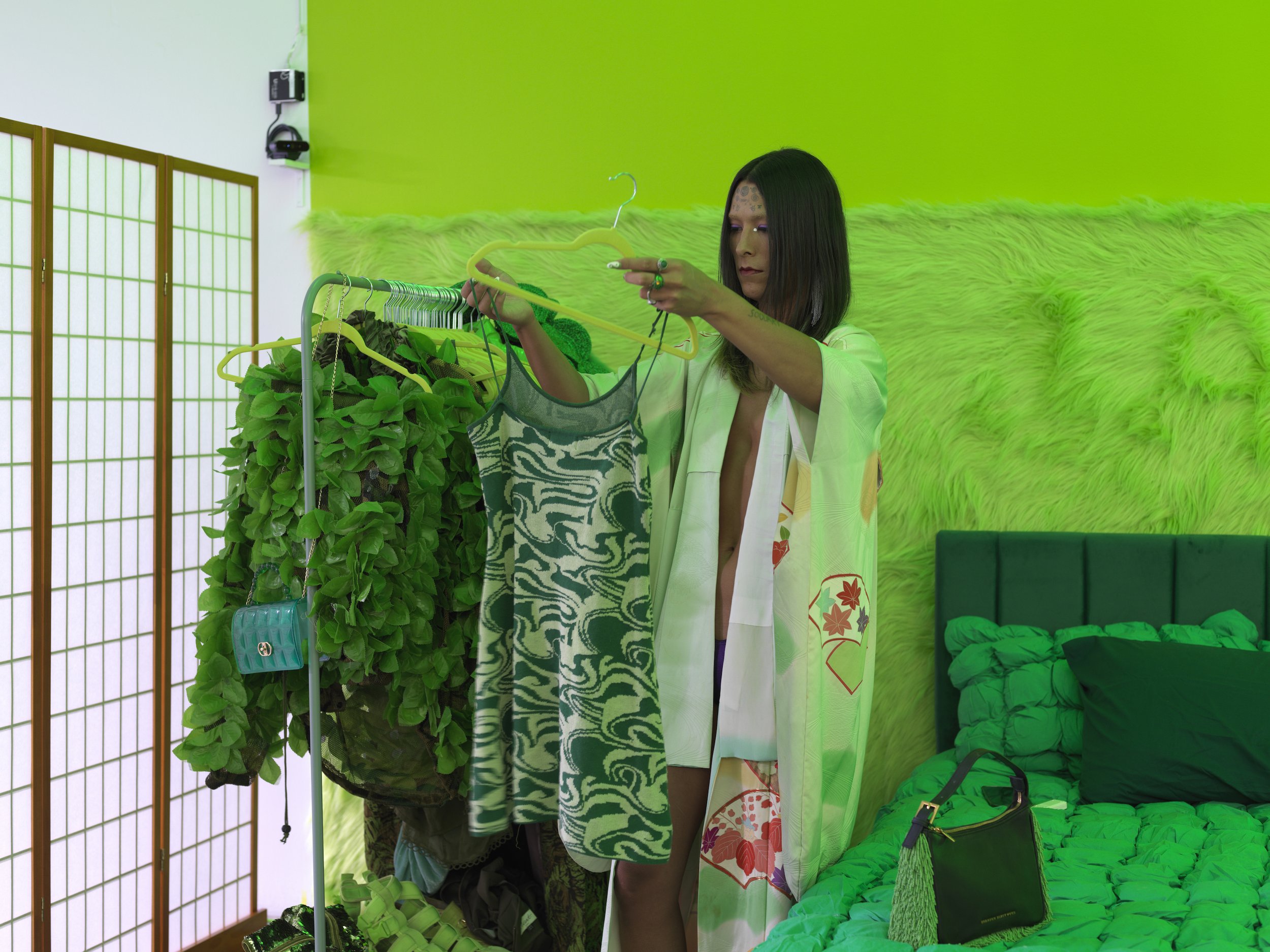
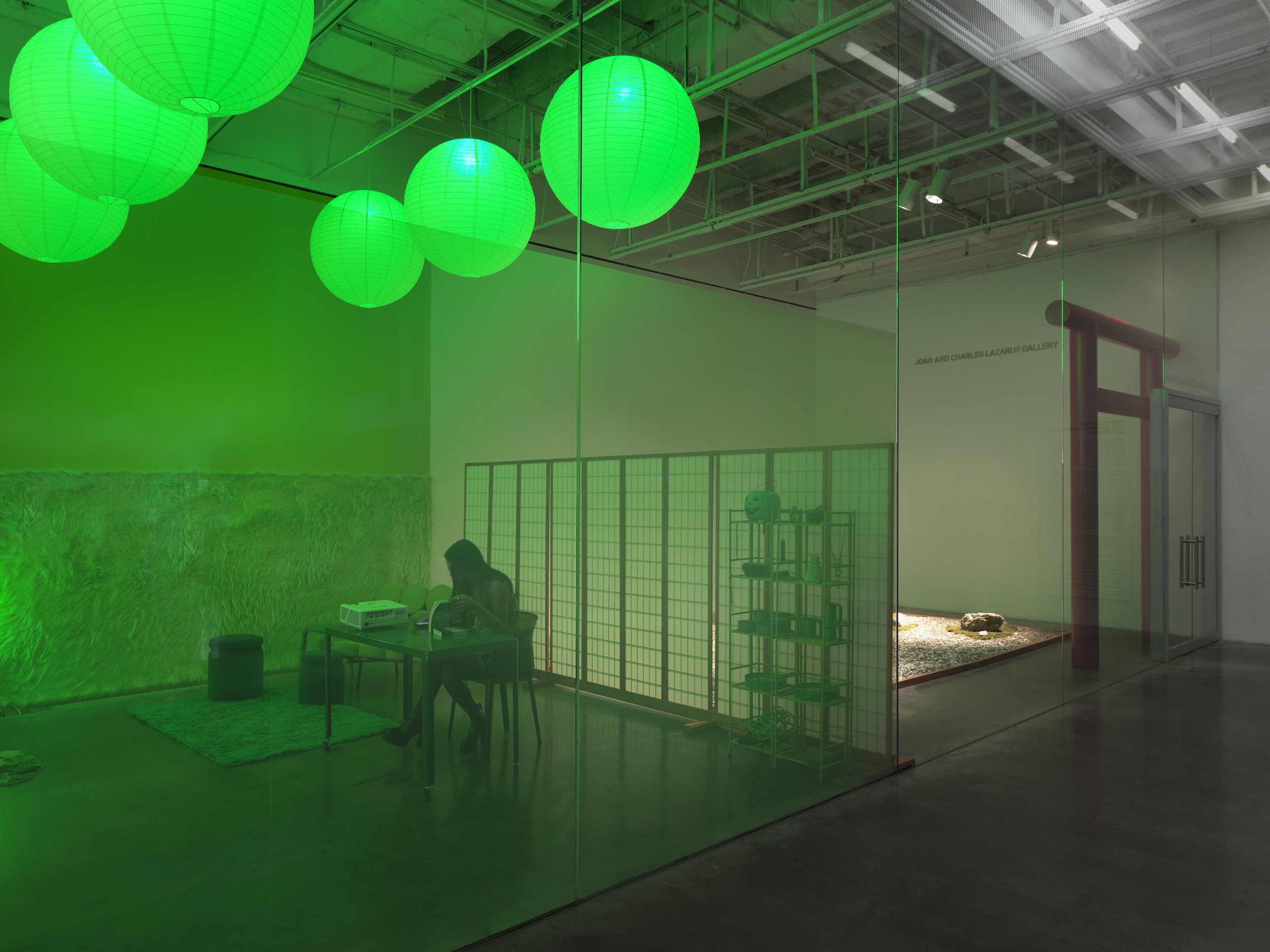
Installation photograph, Puppies Puppies (Jade Guanaro Kuriki-Olivo): Nothing New, The New Museum, October 12, 2023, through March 3, 2024, photo © The New Museum
“Puppies Puppies (Jade Guanaro Kuriki-Olivo): Nothing New” is curated by Vivian Crockett, Curator, with Ian Wallace, Curatorial Assistant.
SUPPORT
Lead support for “Puppies Puppies (Jade Guanaro Kuriki-Olivo): Nothing New” is provided by Christina Hribar.
Support for this exhibition is provided by the Toby Devan Lewis Emerging Artists Exhibitions Fund.
Artist commissions are generously supported by the Neeson / Edlis Artist Commissions Fund.
Generous support is provided by the Fundación Almine y Bernard Ruiz-Picasso para el Arte.
Additional support is provided by the Morton Neumann Family Foundation, Dillon Callie Cohen, R F Jefferies, and Tiffany Zabludowicz.
We gratefully acknowledge the Producers Council of the New Museum.
Special thanks to the Artemis Council of the New Museum.
Thanks to Balice Hertling Galerie, Paris.
*Please note, the full exhibition title for the Kunsthaus Glarus exhibition is as follows: I’m Jade. I’m a trans woman trans womxn trans femme two spirit human being. Life feels long even though it hasn’t been all that long. A brain tumor surgically removed, getting divorced, losing my dad, brain tumor resurgence scare, starting hormone replacement therapy, experiencing sexual assault and rape multiple times and coming out as a woman. This exhibition is a roller coaster of the emotions feelings but also thoughts connections that happened over this span of time... only a little more than a decade. This exhibition covers the span of Puppies Puppies to Jade. It’s hard to get up each morning. My heart aches but I’m happy to be a woman. I’ll try my best to enjoy life even though society makes it difficult. From dust to dust I am but a speck on this planet and I wonder how to use this short life of mine. Trying not to let my trauma take over but still be kind to yourself Jade. This is the end of a decade • a new way of working coming soon. Sincerely, Jade Kuriki Olivo
For more information about this exhibition and others, please visit the New Museum website for updates. The New Museum can also be found on Instagram.
Bronx Calling: The Sixth AIM Biennial
Installation photograph, Bronx Calling: The Sixth AIM Biennial, The Bronx Museum of the Arts, Jan 26 - Mar 31, 2024, photo © The Bronx Museum of the Arts
The Bronx Museum is pleased to announce Bronx Calling: The Sixth AIM Biennial, featuring 53 artists who explore issues related to race, gender, class, sexual orientation, age, ethnicity, religion, and nationality as a means of contending with colonial histories and imagining speculative futures. Of African, Asian, Latin, Middle Eastern, Caribbean, European, and Australian descent from over 20 countries, the artists each draw on their lived experiences and cultural identities to critique systems of power.
Due to the pandemic, the Biennial for the 2020 and 2021 AIM fellows was postponed, such that this two-part exhibition will showcase more cohorts than ever in a single Biennial. Bronx Calling will take place in two parts throughout the first half of 2024 in the North Wing as the Museum’s South Wing remains closed for renovation.
The first exhibition will present 26 artists including Chris Cook, Kim Dacres, Luis Gutierrez, Maya Jeffereis, and Yelaine Rodriguez from January 26 to March 31, 2024, and be followed from April 12 to June 16, 2024 with a second exhibition featuring 27 artists, including Priscilla Aleman, Sarah Friedland, Daniel Giordano, Woomin Kim, Sagarika Sundaram, and A Young Yu.
Curated by Eileen Jeng Lynch, Director of Curatorial Programs, Bronx Calling celebrates the work of artists from the 2020, 2021, 2022, and 2023 cohorts of the Museum’s Artists in the Marketplace (AIM) Fellowship, which, since 1980, has supported New York’s artist community through this flagship artist development program that provides emerging artists with career management resources, helping them navigate the professional practices of the art world.

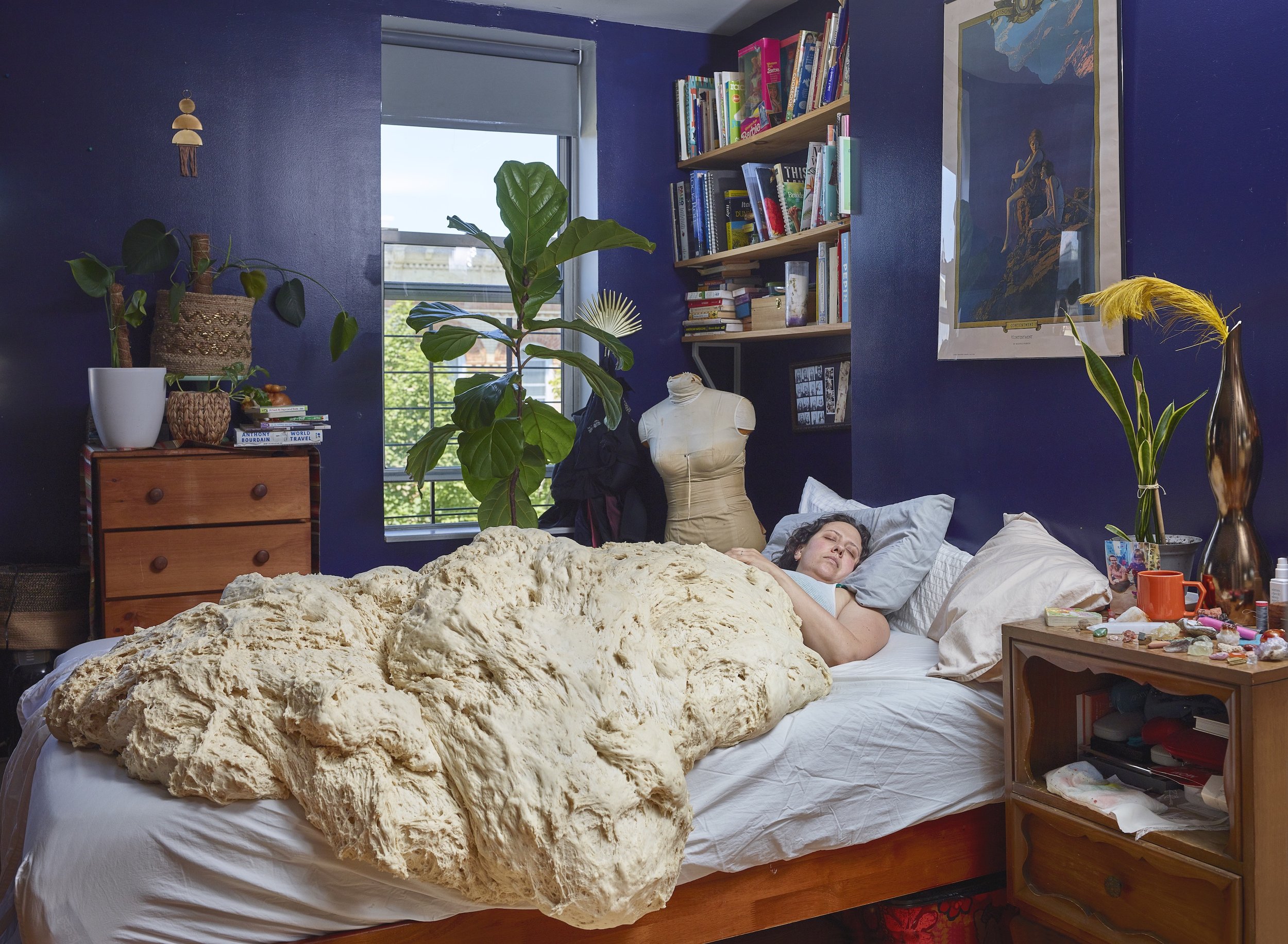
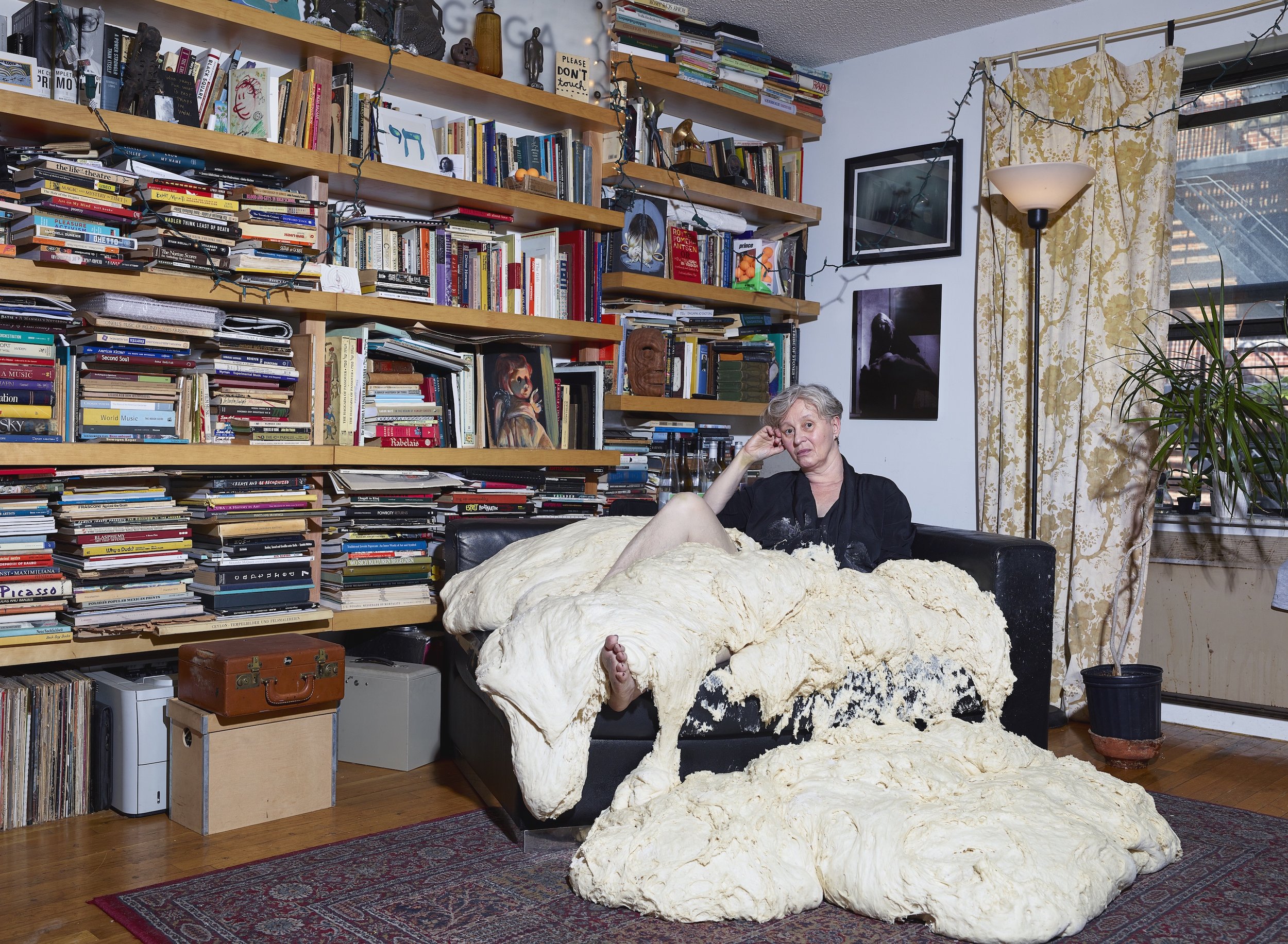
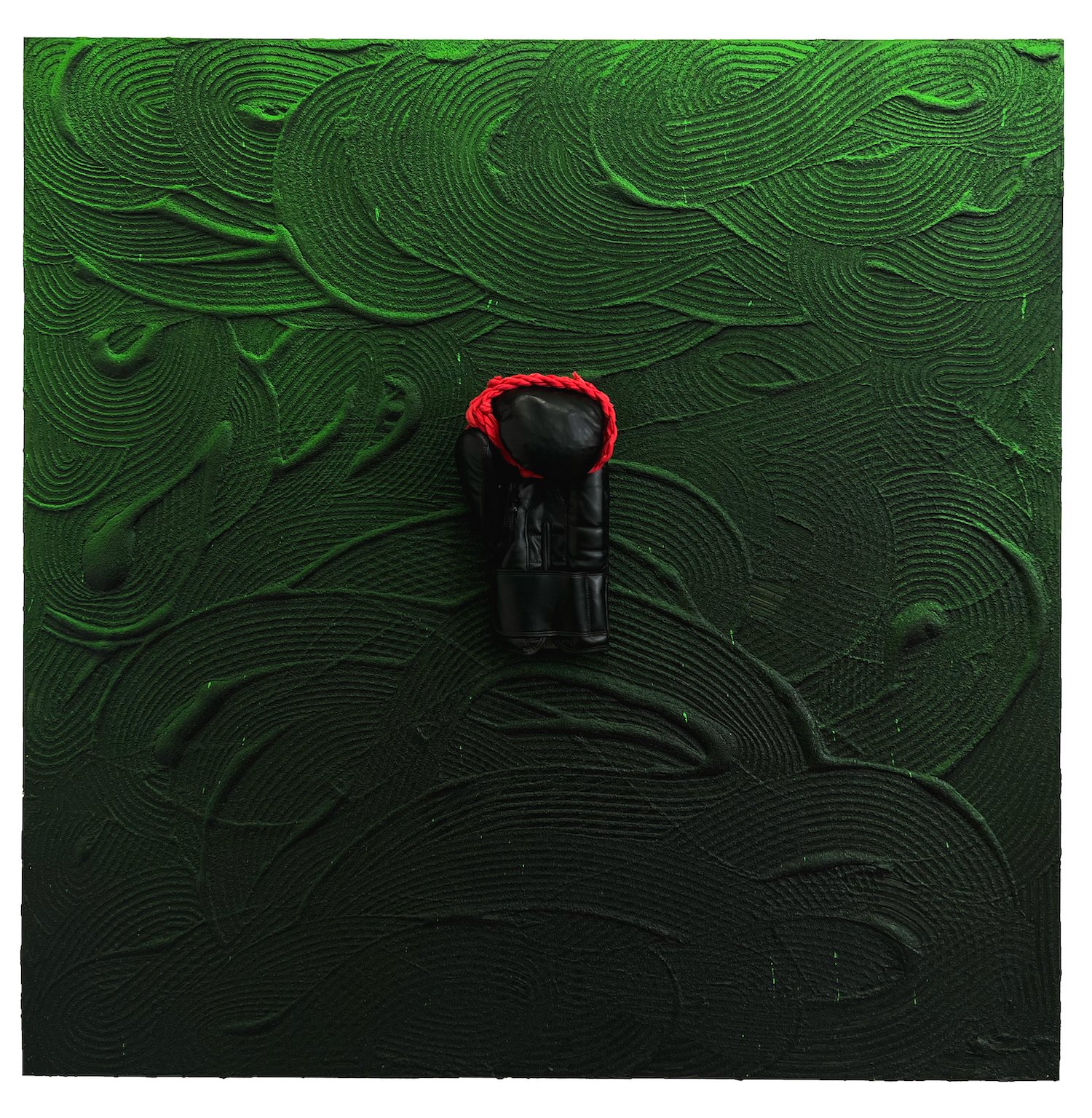
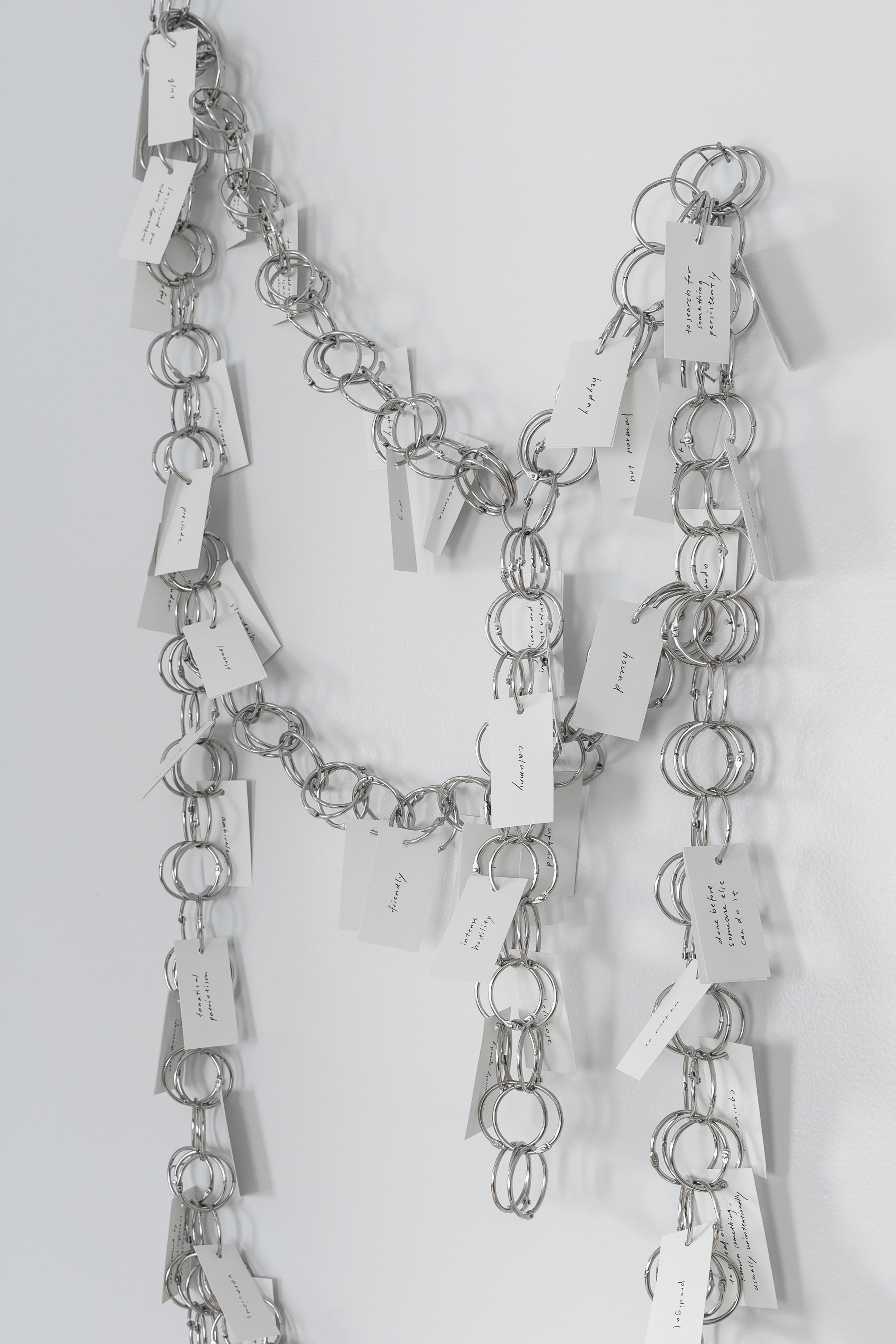

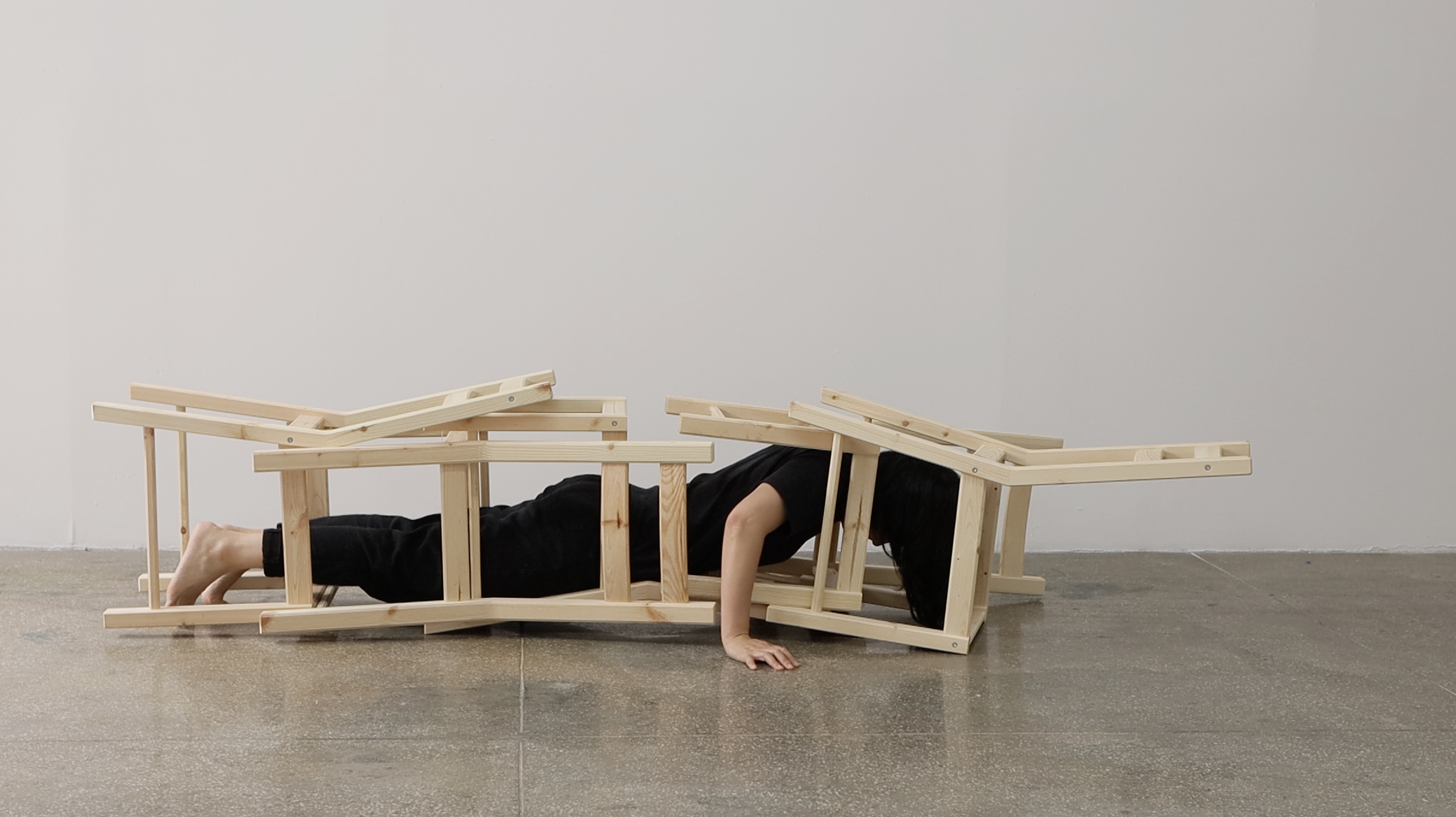
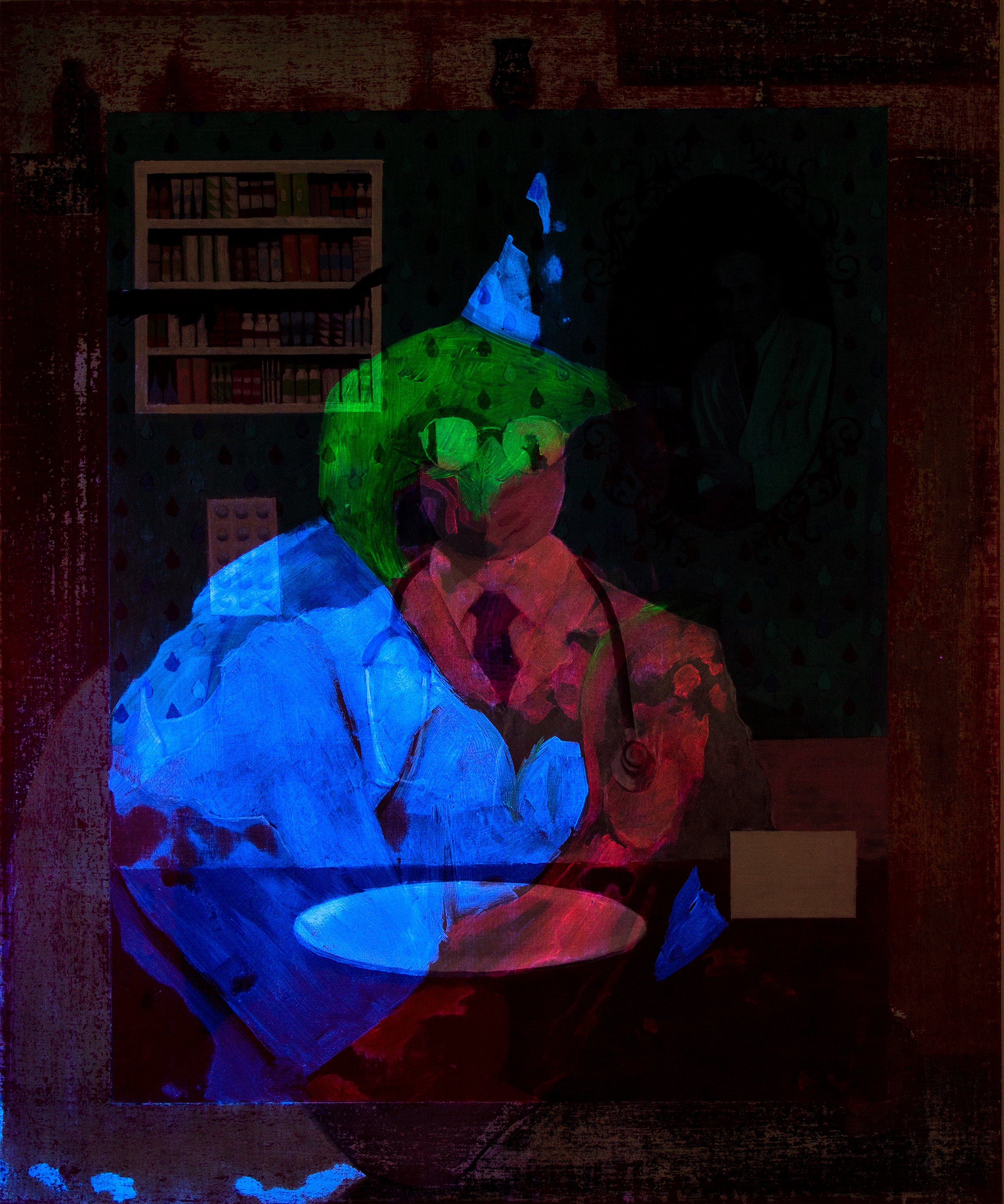
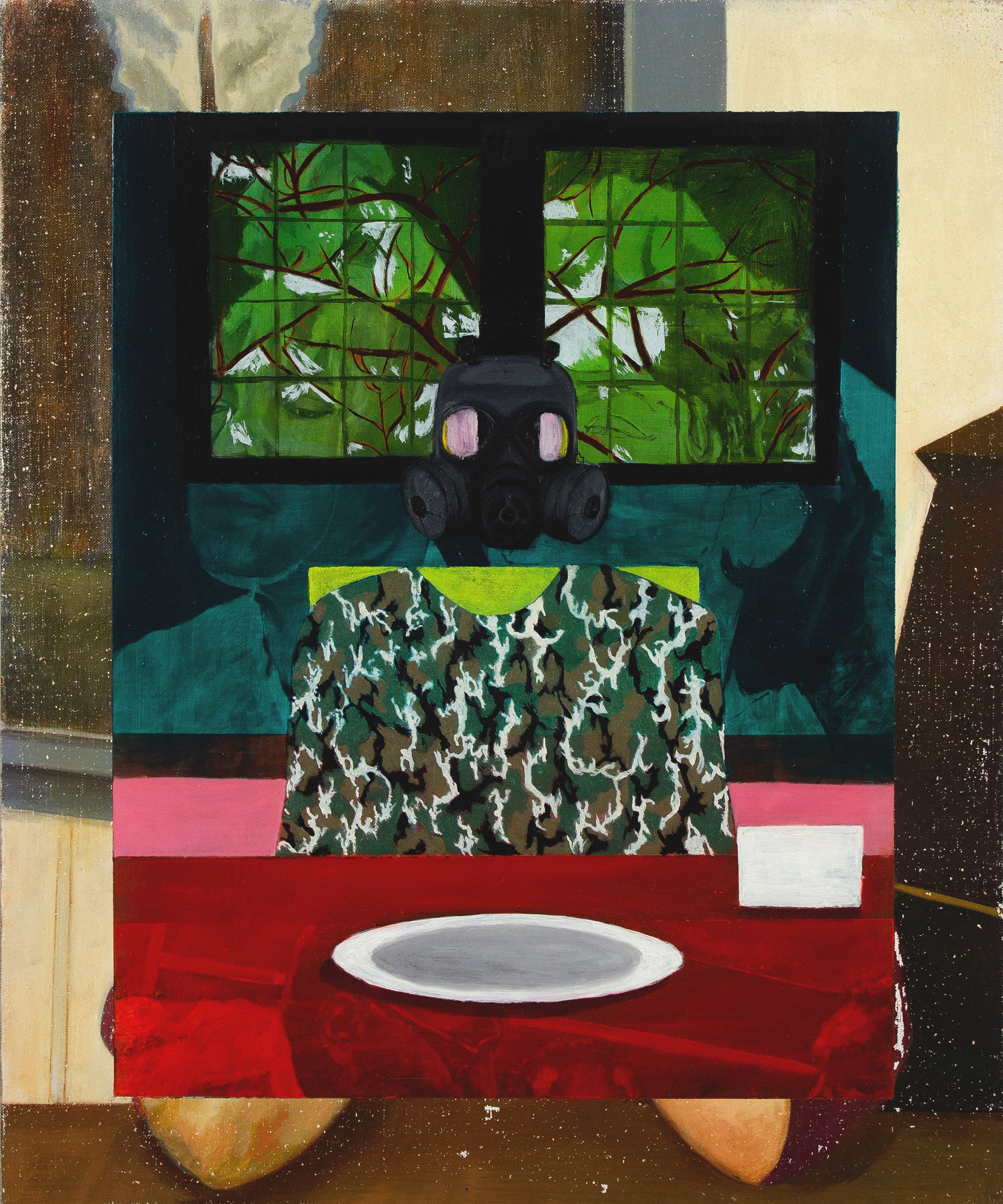
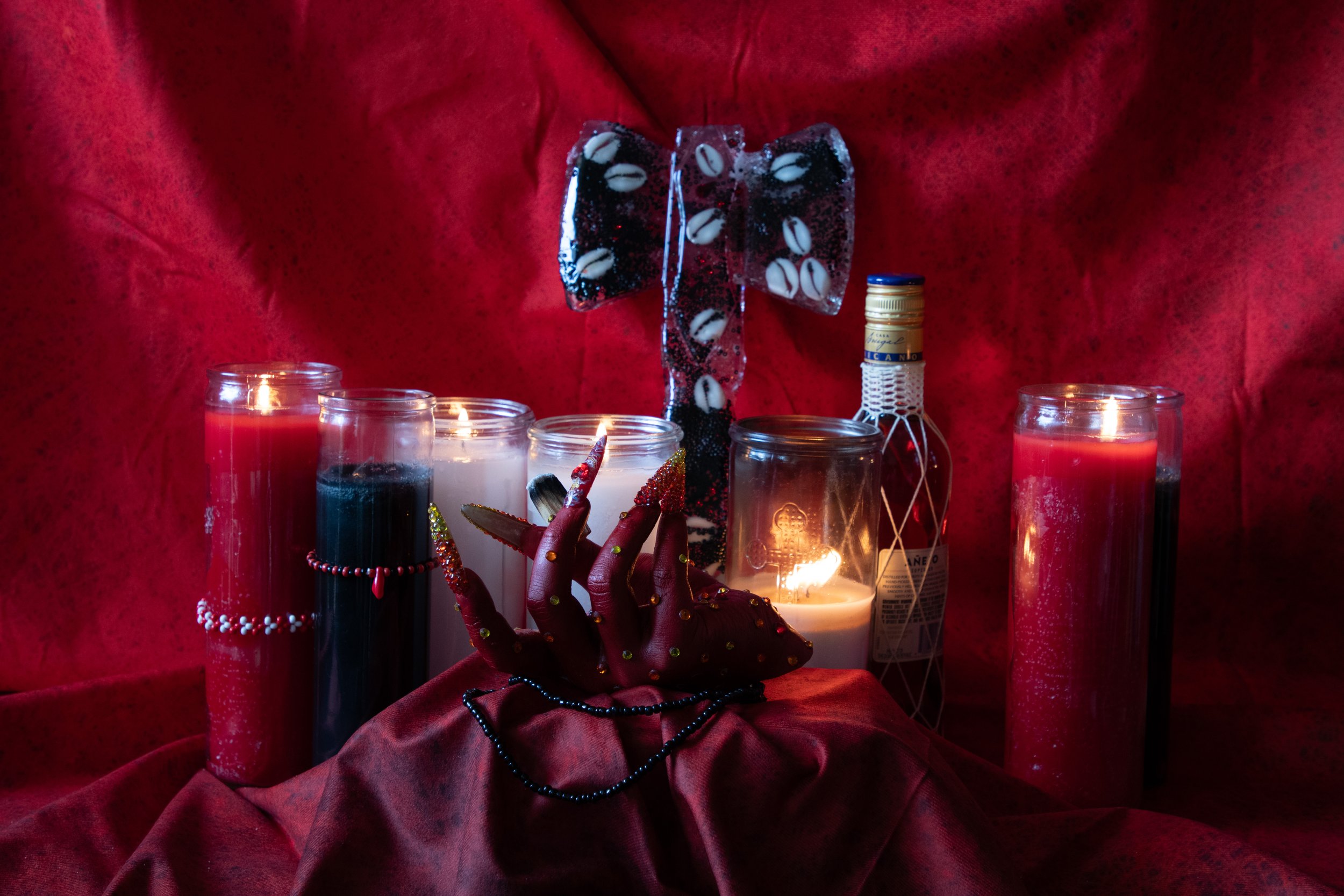
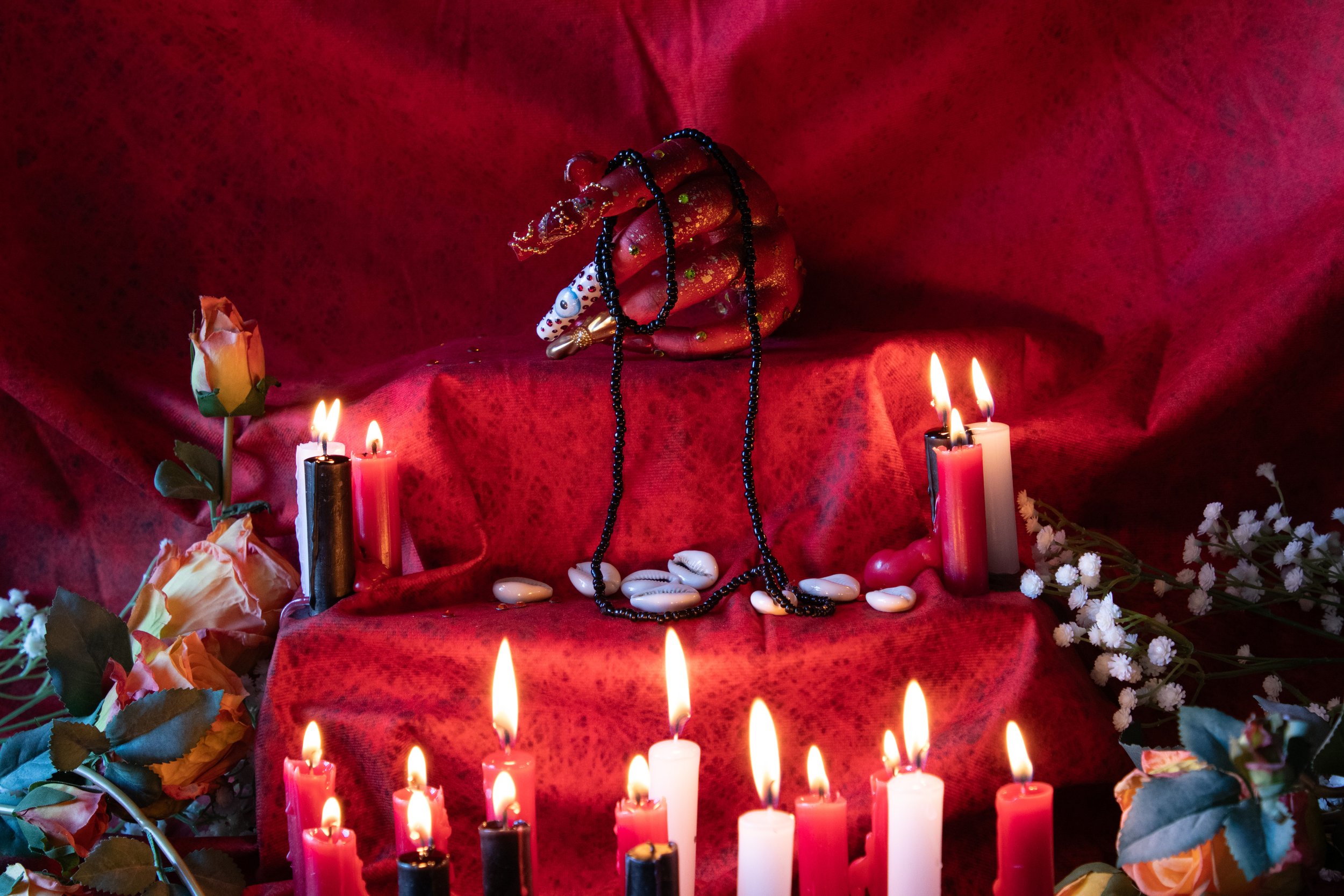
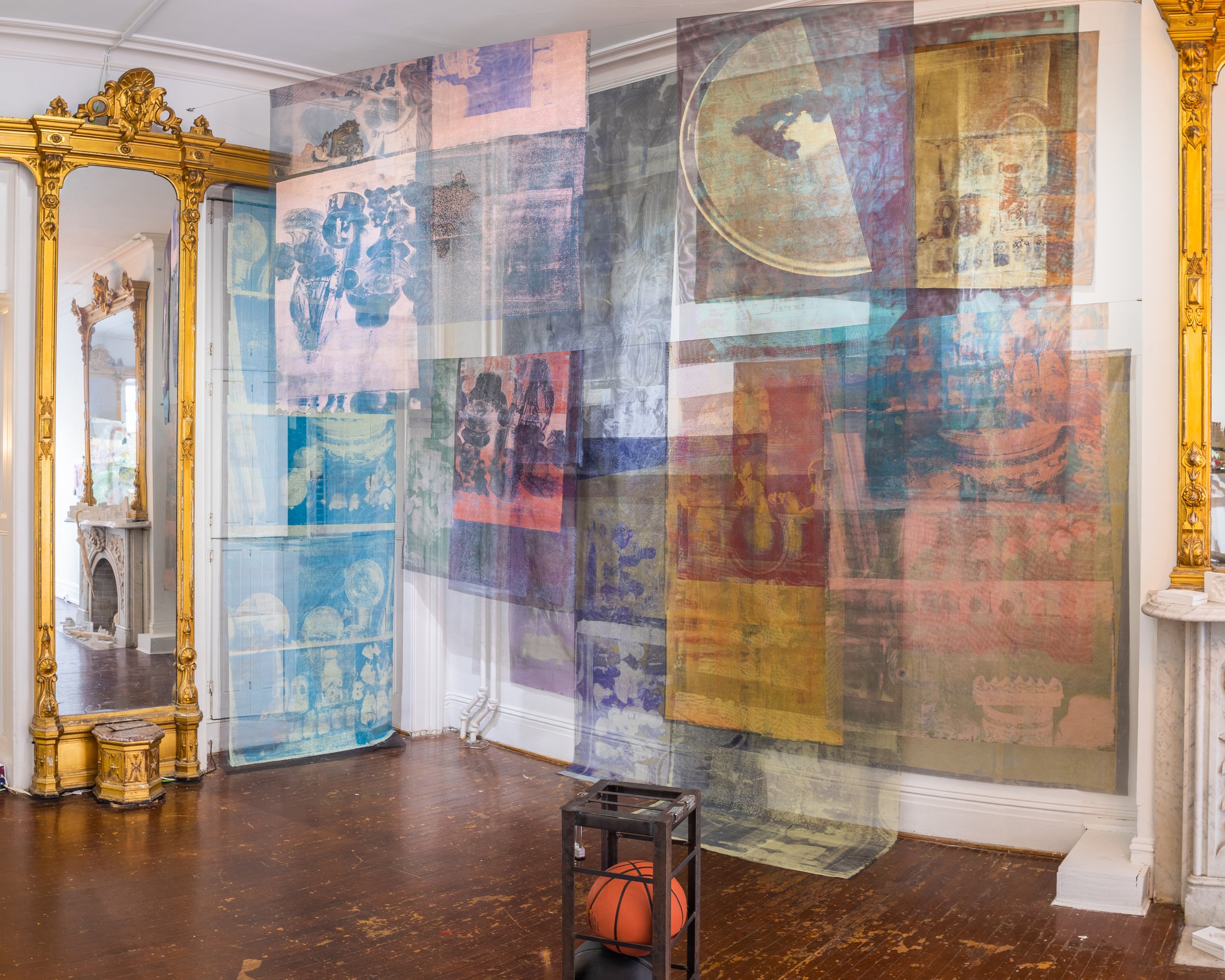
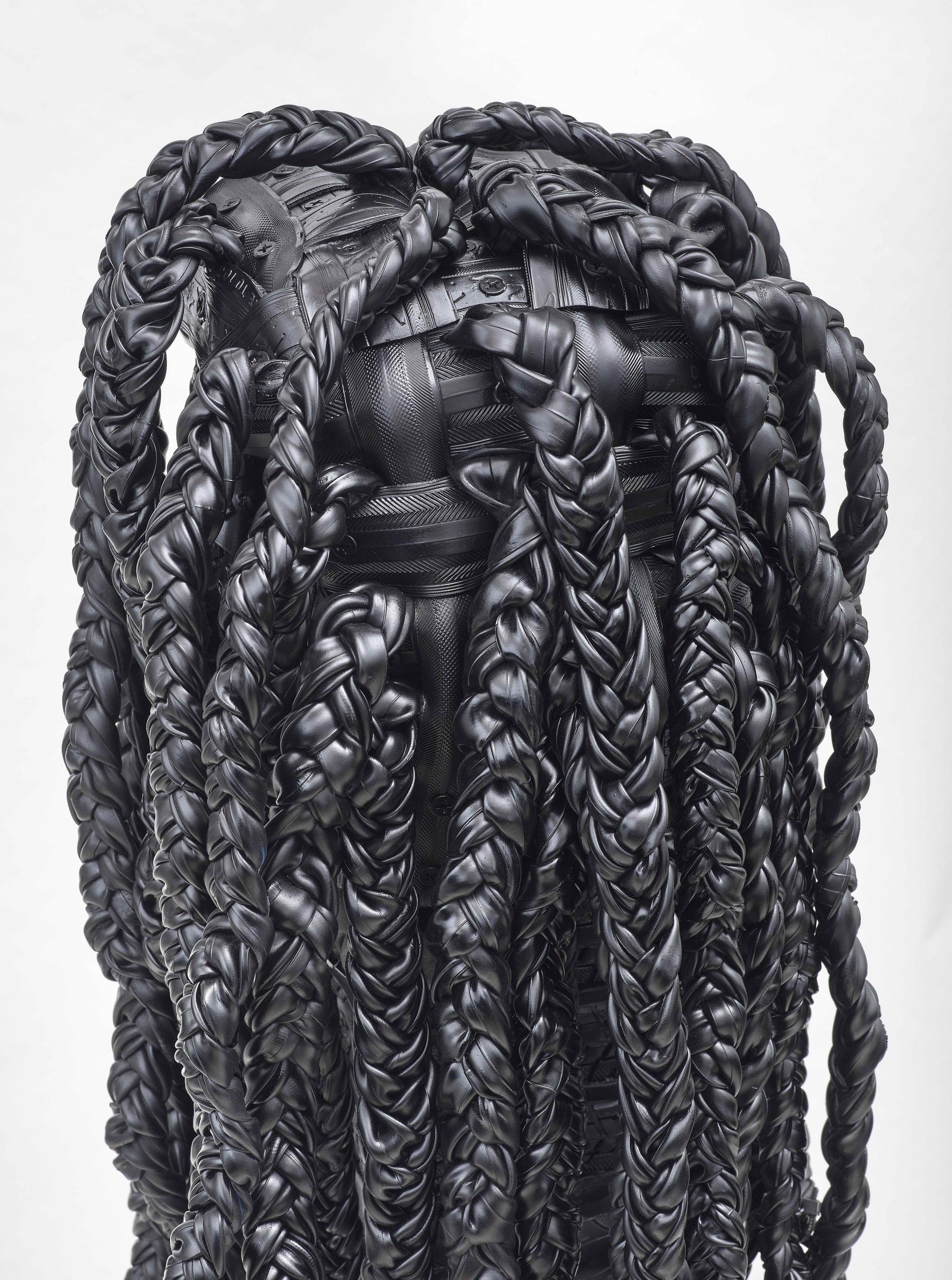
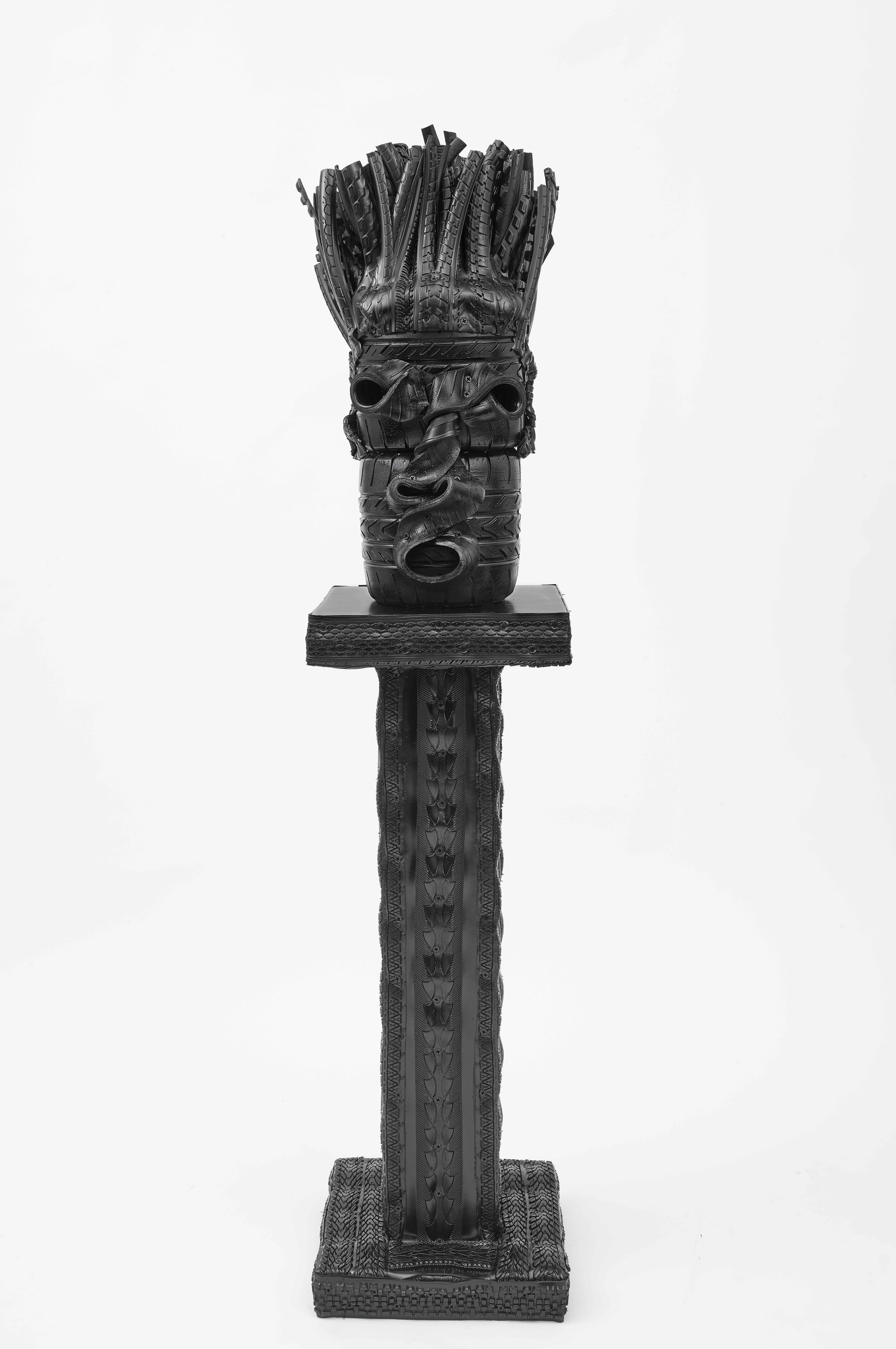
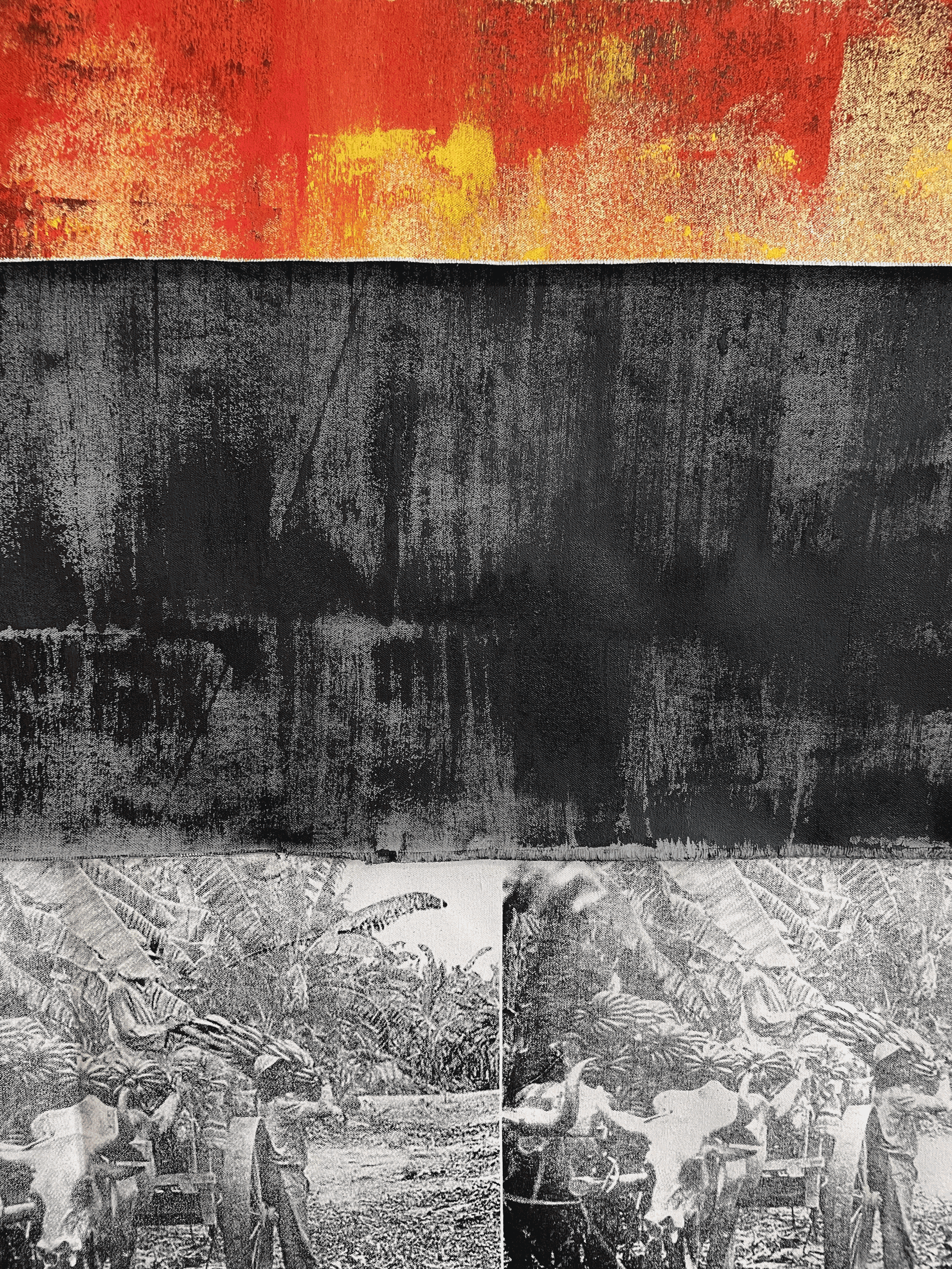
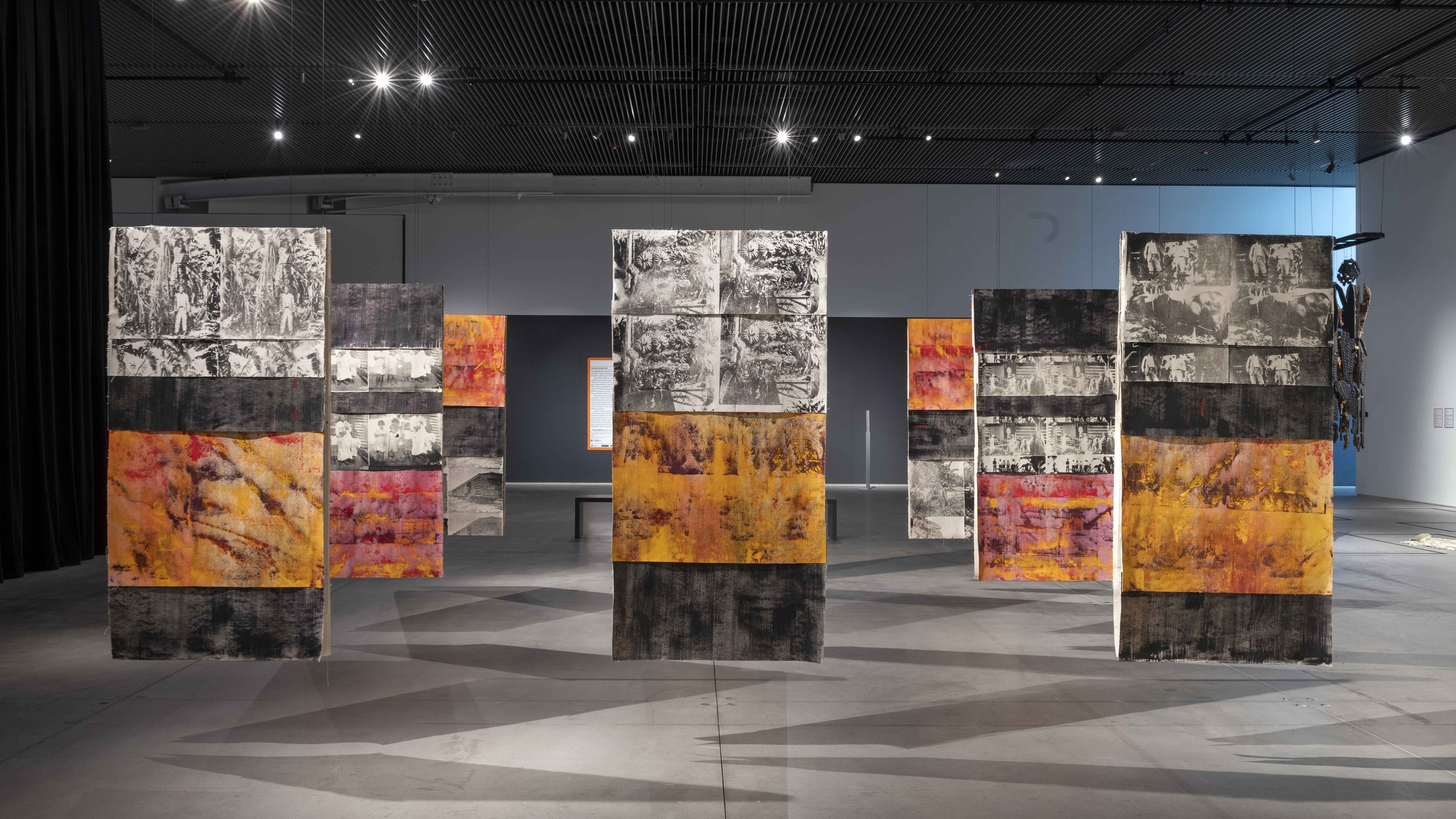
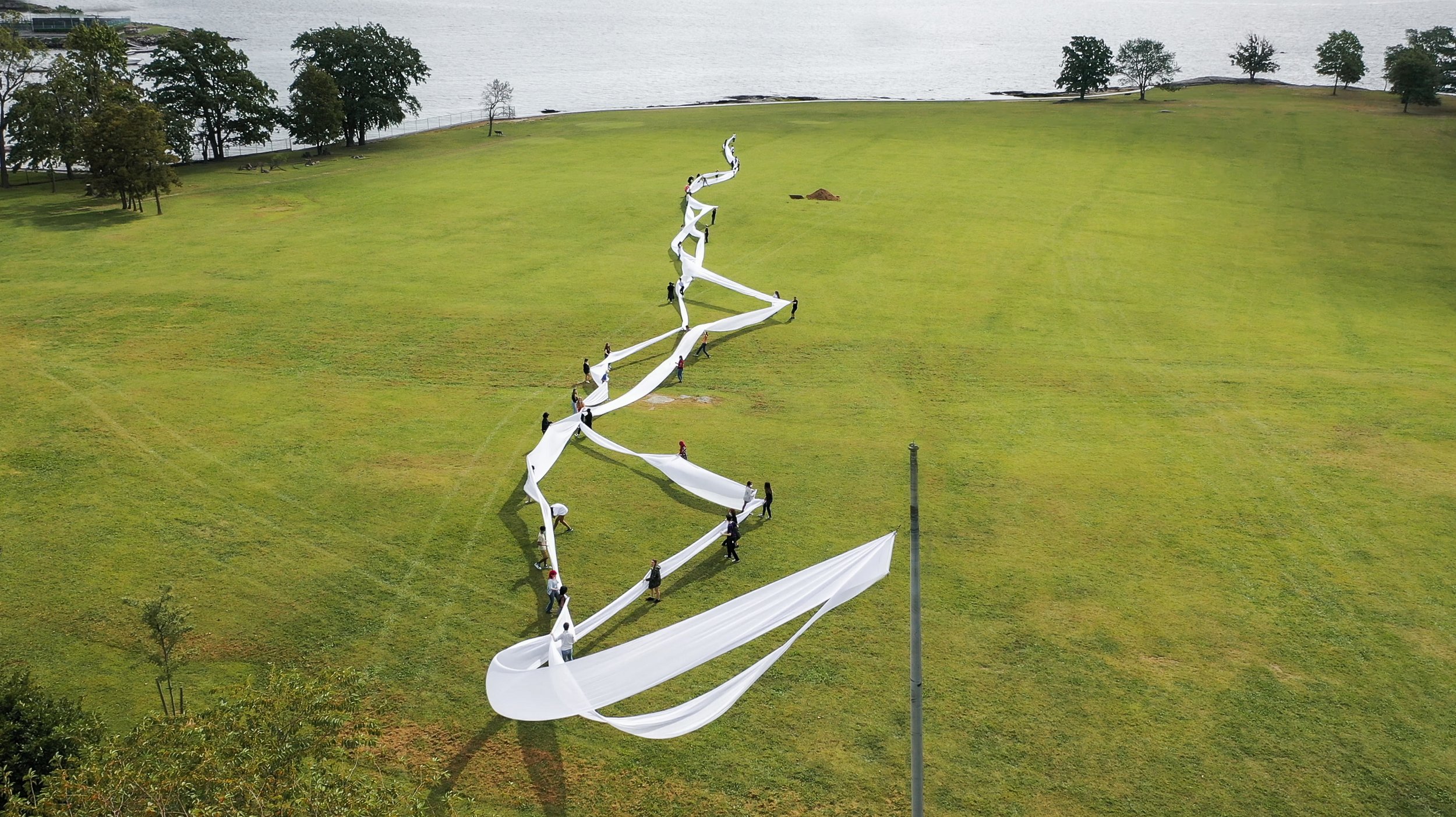
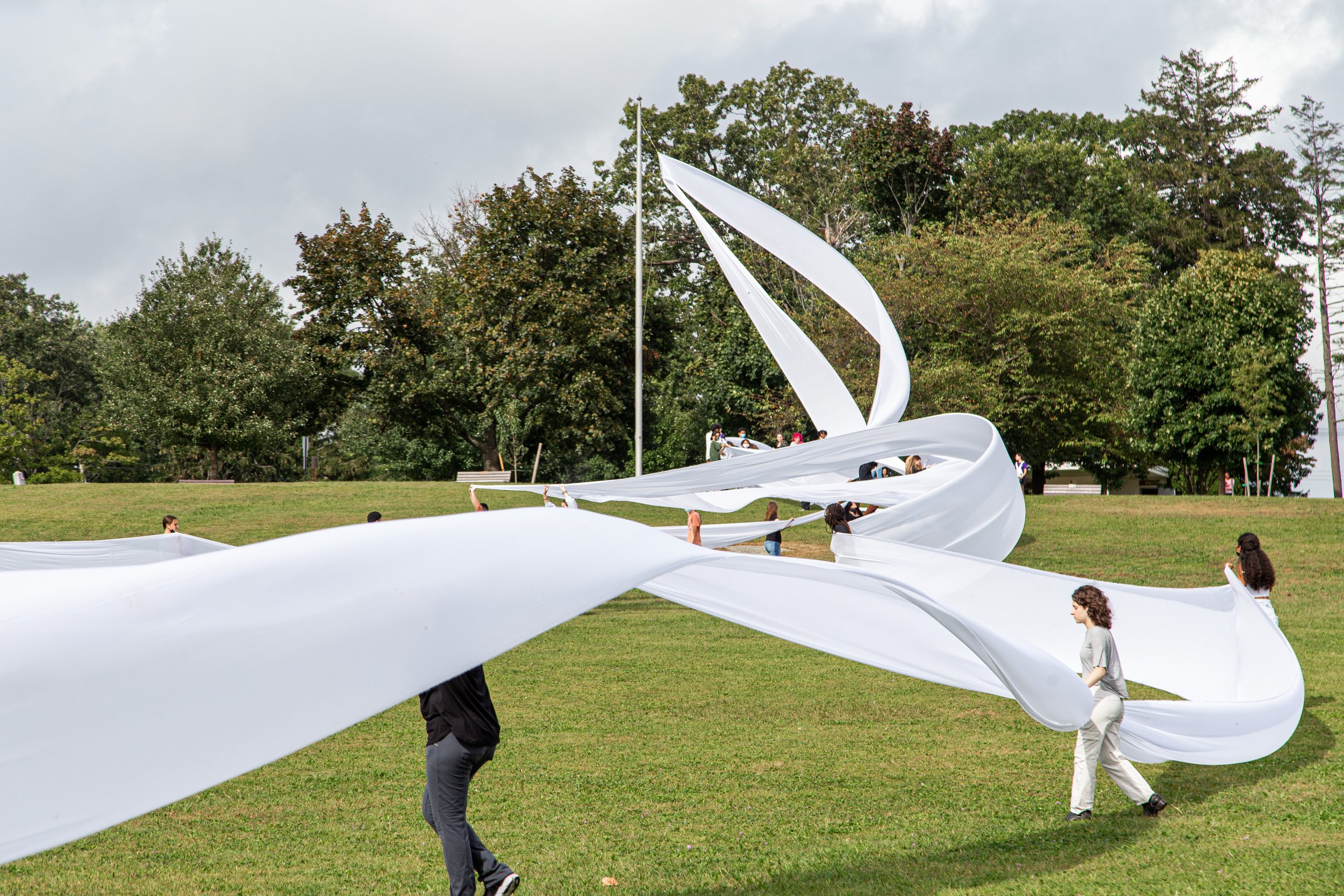
photo © The Bronx Museum of the Arts
PART ONE: Centering contemporary and critical issues drawn from the artists’ lived and embodied experiences, the 26 artists explore cultural heritage, examine labor issues, and highlight the impact of colonial histories on personal and collective identities through varied means and media. Featured artists are: Syd Abady, Aika Akhmetova, Santina Amato, Miguel Braceli, Chris Cook, Walter Cruz, Kim Dacres, Saba Farhoudnia, Ronen Gamil, Judy Giera, Luis Gutierrez, Jennifer Chia-ling Ho, Peter Hoffmeister, Maya Jeffereis, E. Lombardo, Dario Mohr, Joshua Nierodzinski, Jiwon Rhie, Ruth Rodriguez, Yelaine Rodriguez, Ami Park, Fred Schmidt-Arenales, Yesuk Seo, Kyle Utter, Misra Walker, and Junlin Zhu.
New York-based artist and filmmaker Maya Jeffereis, for example, fuses past and present by drawing upon her ancestral histories and focusing on maternal lineage in a new video. This single-channel video comprises cyanotypes on 16mm film. Jefferies creates the piece to abstract time and space and convey emotional, psychological, and physical memories and stories surrounding labor and migration. Questions of labor and colonial histories are similarly addressed by mixed media artist Luis Gutierrez in Lo Invisible, Una Fruta Tropical (2024), an installation of 72 paintings influenced by historical archives pertaining to the stories of banana plantation workers for United Fruit Company in Colombia in 1928, particularly their strike for fair wages and human labor conditions, which led to their mass killing by the Colombian Army.
Much like Bronx-based artist Kim Dacres, who combines found tires and rubber from automobiles and bicycles with braiding techniques to create sculptures that represent everyday people of color, Walter Cruz highlights connections between art, design, and architecture to understand how Black and Brown people activate and command space. Afro-Dominican and Bronx-based artist Yelaine Rodriguez unites the two worlds that have shaped her identity: the Caribbean and the U.S. Drawing upon vernacular culture of the late 1980s and ‘90s—which are exemplified by acrylic nails, beadwork, and cowry shells in La Hija De Shango (2022)—to articulate the stereotypes and judgments she faced growing up, Rodriguez creates sculptures that reference deities of the African diaspora in shrine-like compositions that not only contend with these stereotypes, but serve to embrace and uplift them. A shared focus on the exploration of gender identity and the challenges faced by women emerges amongst the work of Judy Giera, Santina Amato, E. Lombardo, and others in this first iteration of the Biennial. Through various mediums and approaches, these artists contend with societal issues, and highlight the emotional and psychological dimensions of womanhood. For example, Brooklyn-based Giera imbues her work in painting, video, and performance with a sense of humor to emphasize her non-cisgendered experience of womanhood. The abstract paintings that result thus highlight transgender joy while examining the psychological stakes and misogyny faced by transgender women in the United States today. Australian-born Amato similarly investigates the physical, psychological, and social manifestations of the female body through the use of domestic materials. In Portraits Of Women With Their Weight in Dough (2023), the artist invites women from diverse backgrounds to pose for portraits with their weight in dough, as a part of her ongoing photographic and video series that addresses the emotional labor associated with womanhood. And finally, via a collaging of queer and feminine imagery taken from both art historical and pop cultural sources alike, Lombardo turns to the media to examine how the narratives we consume inform conceptions of identity.

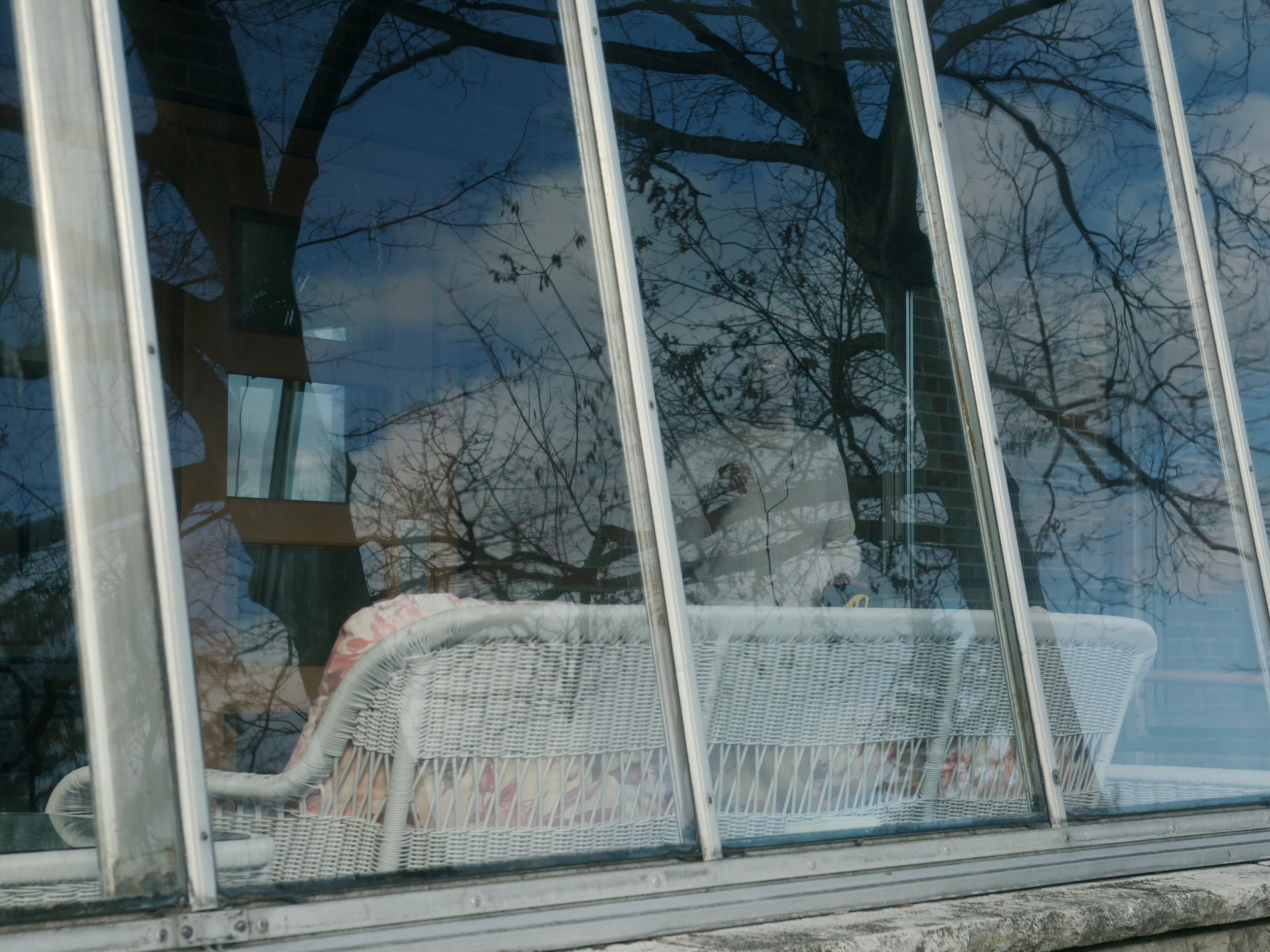

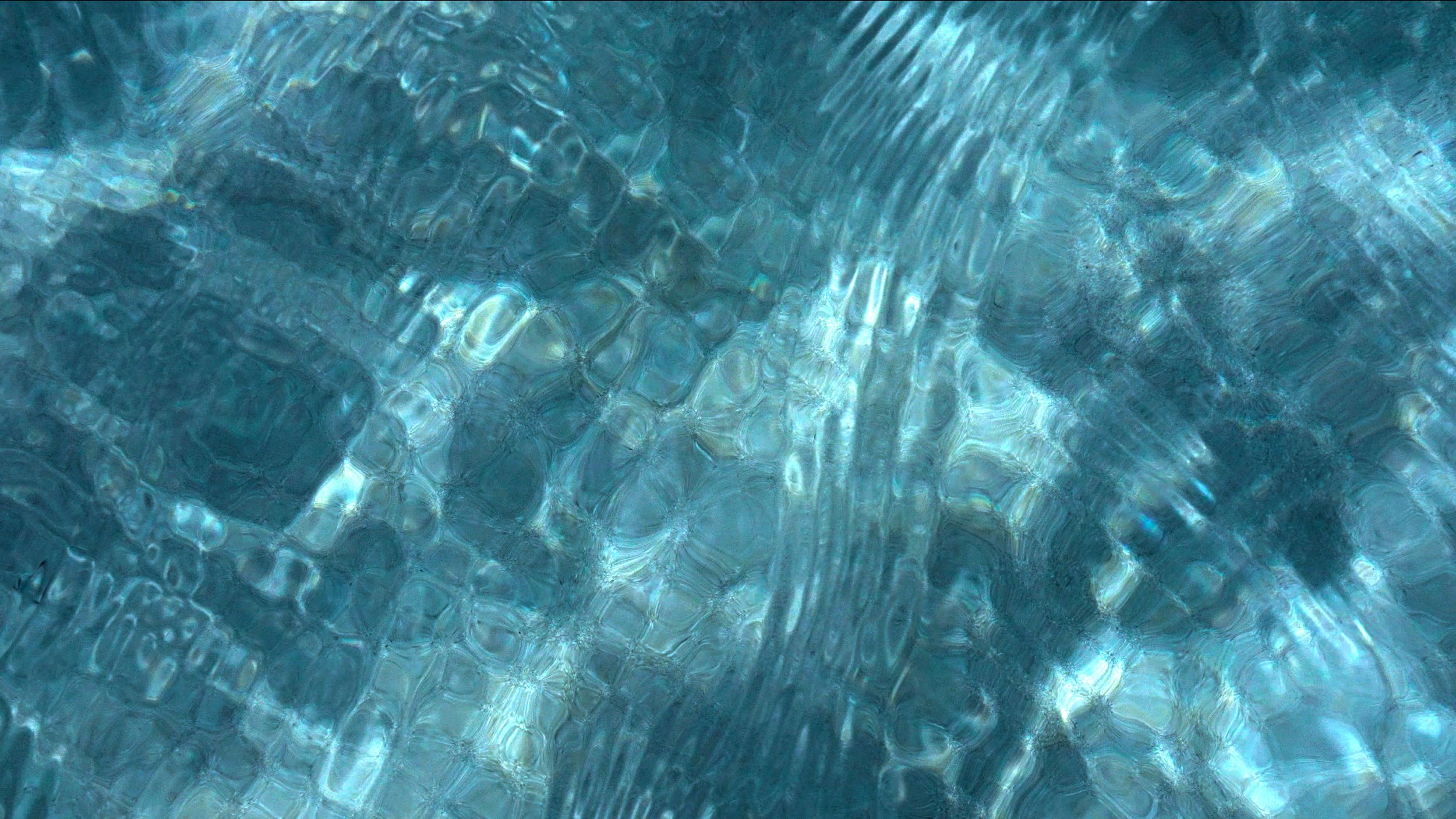
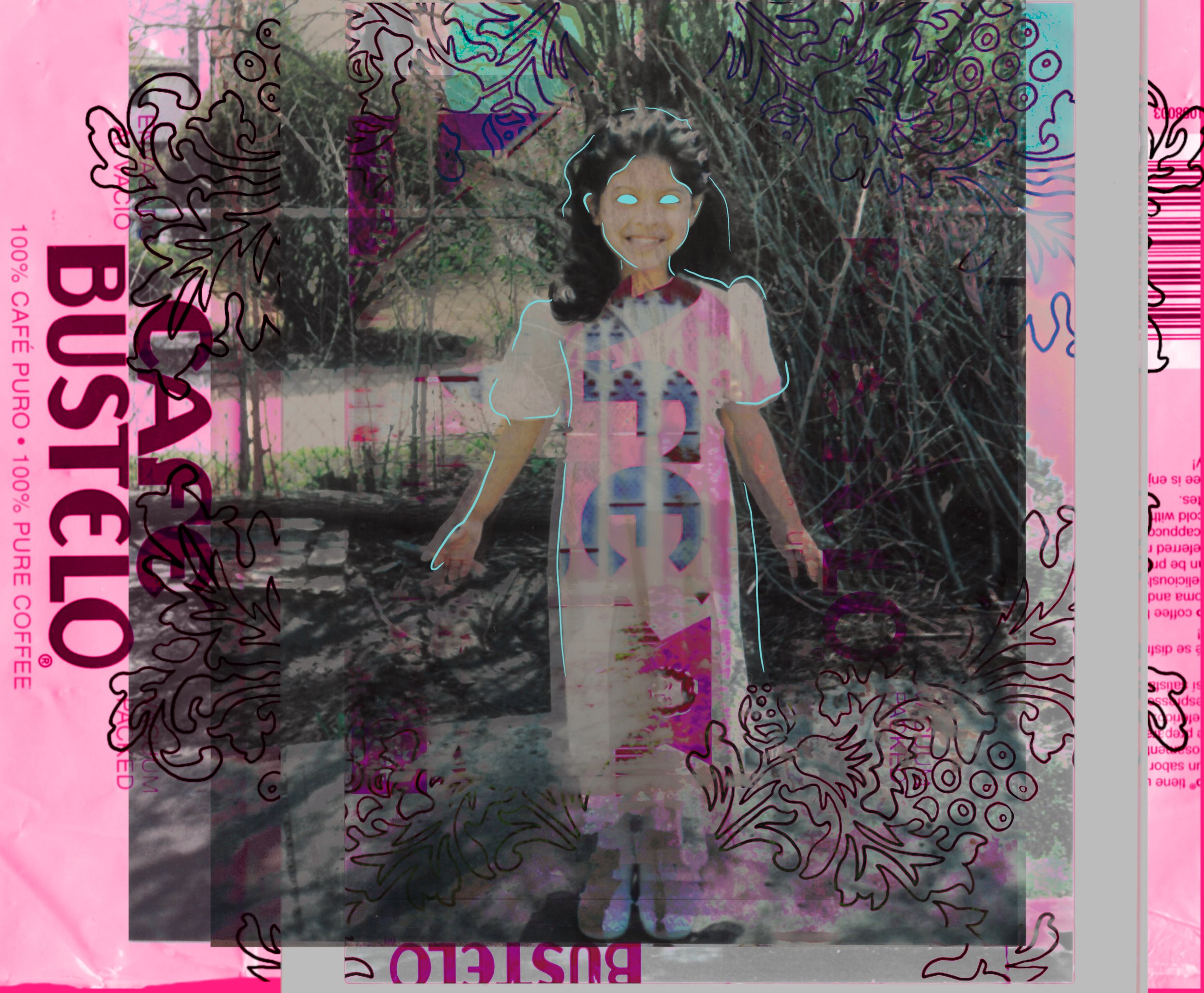
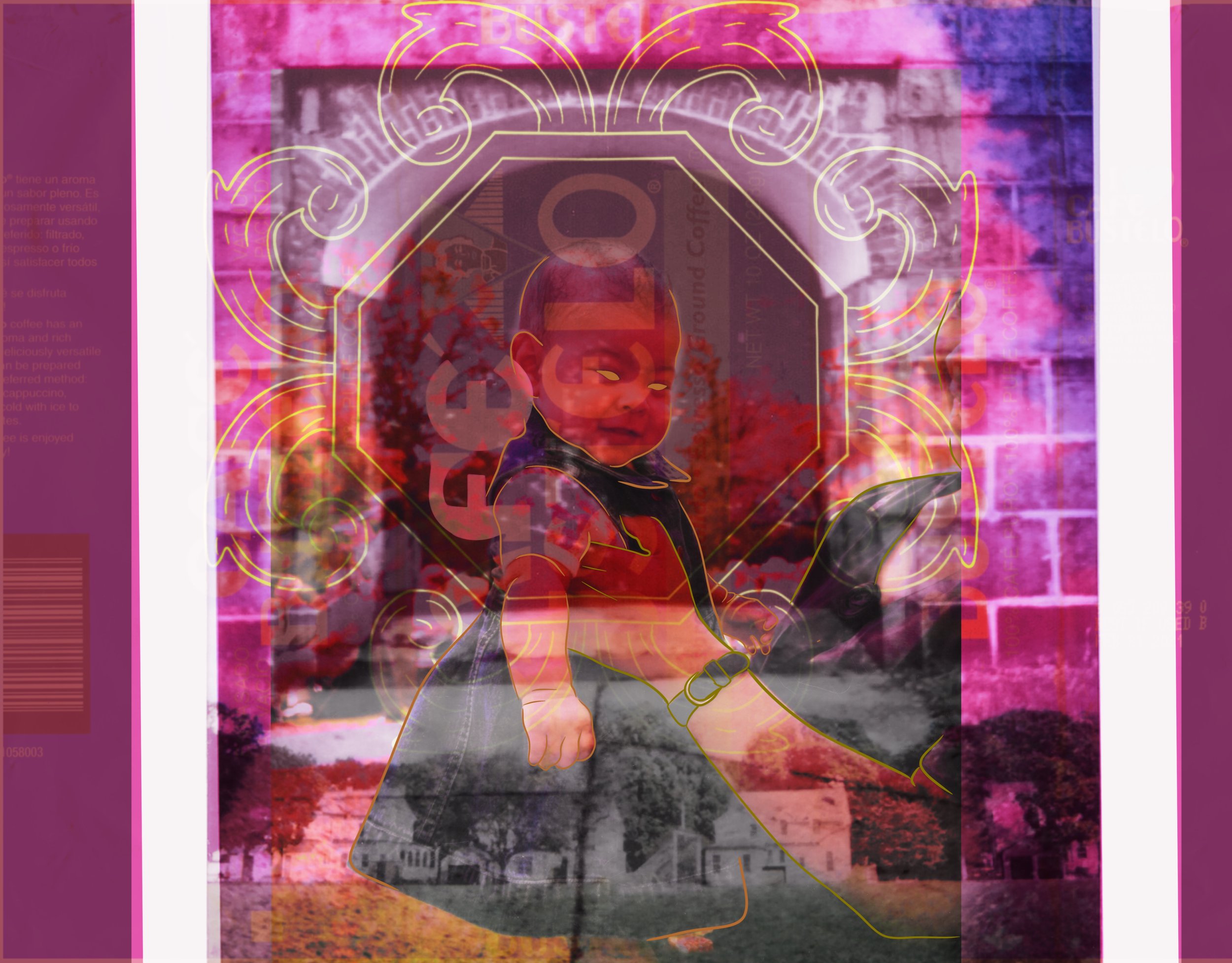
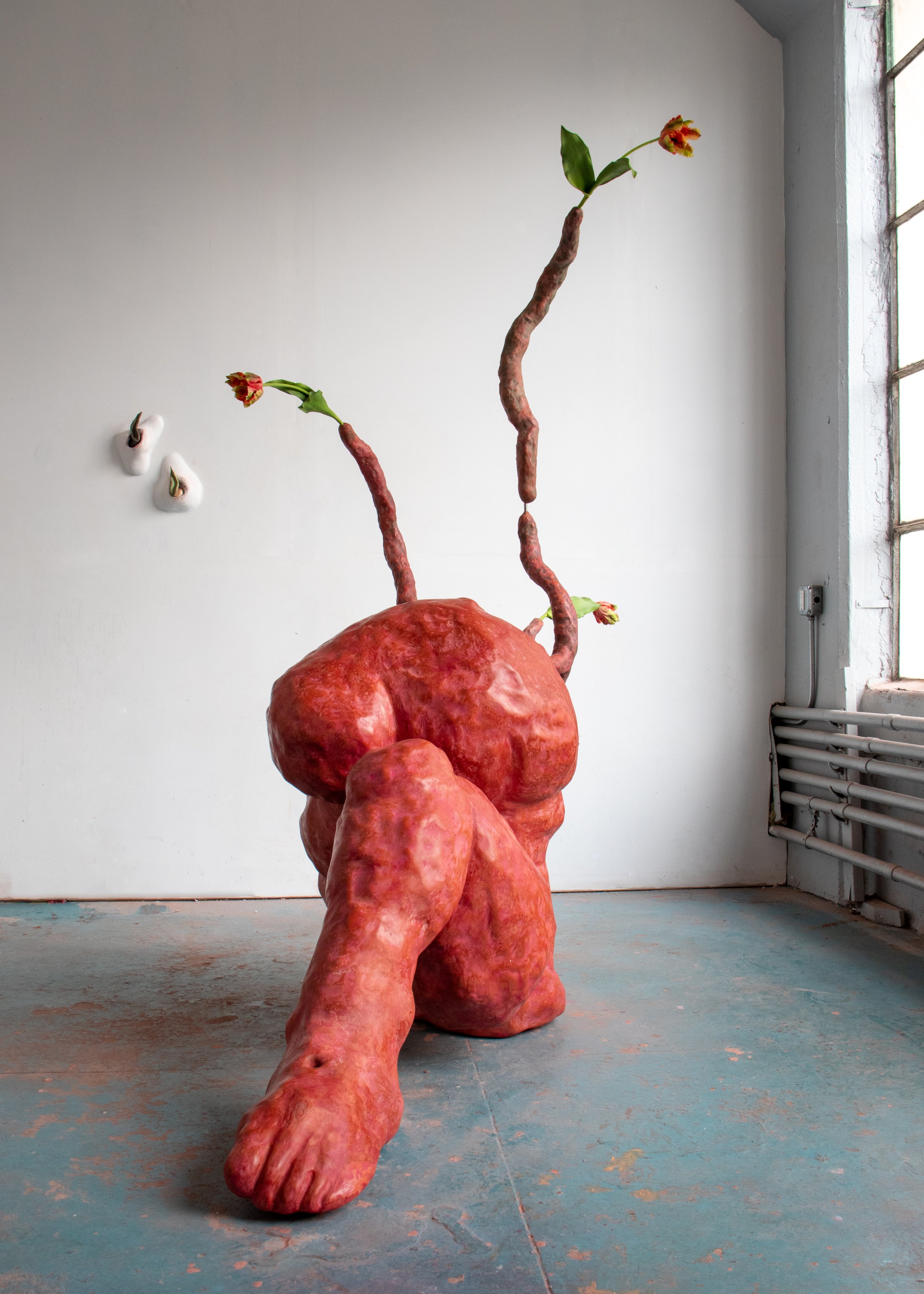
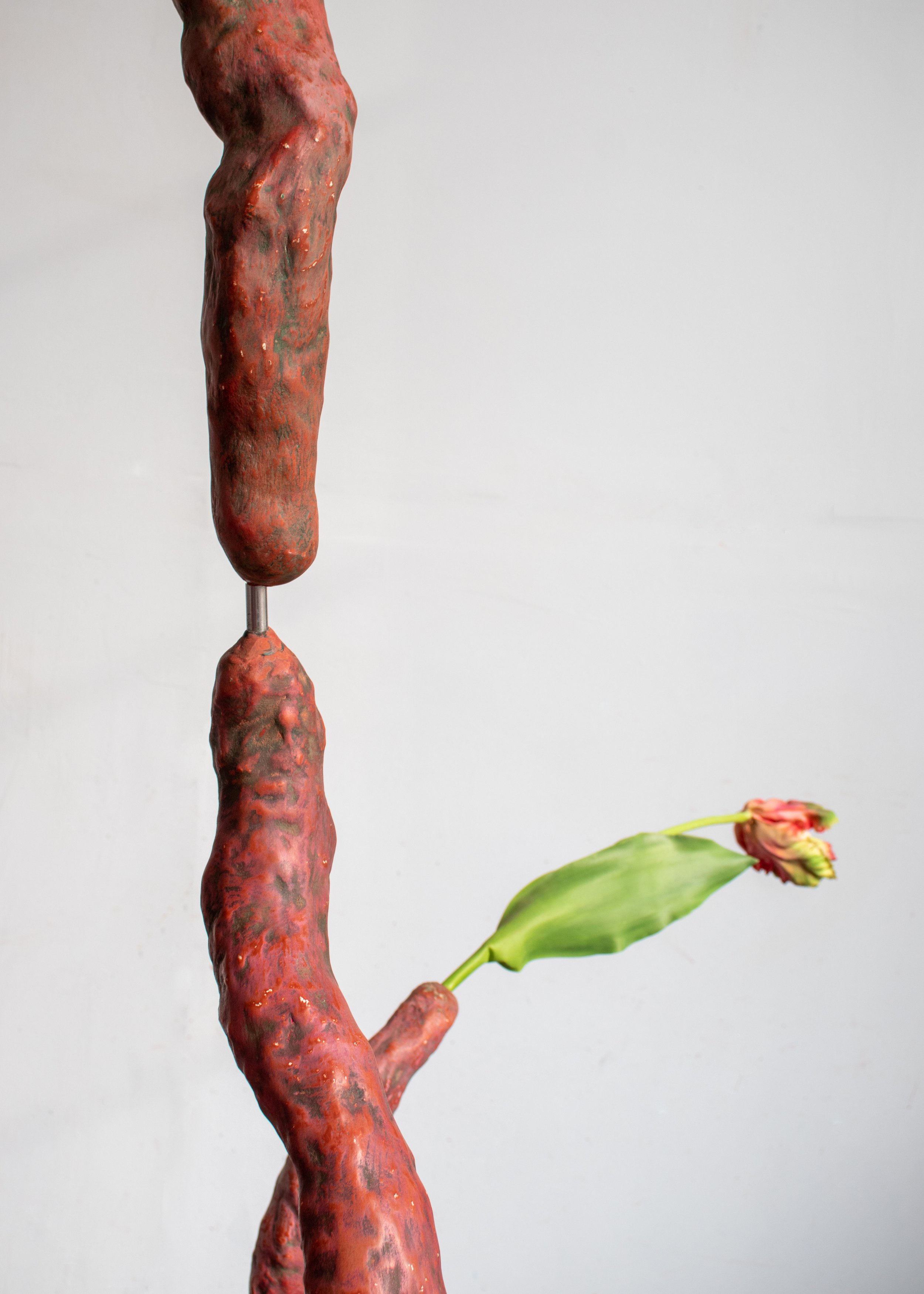
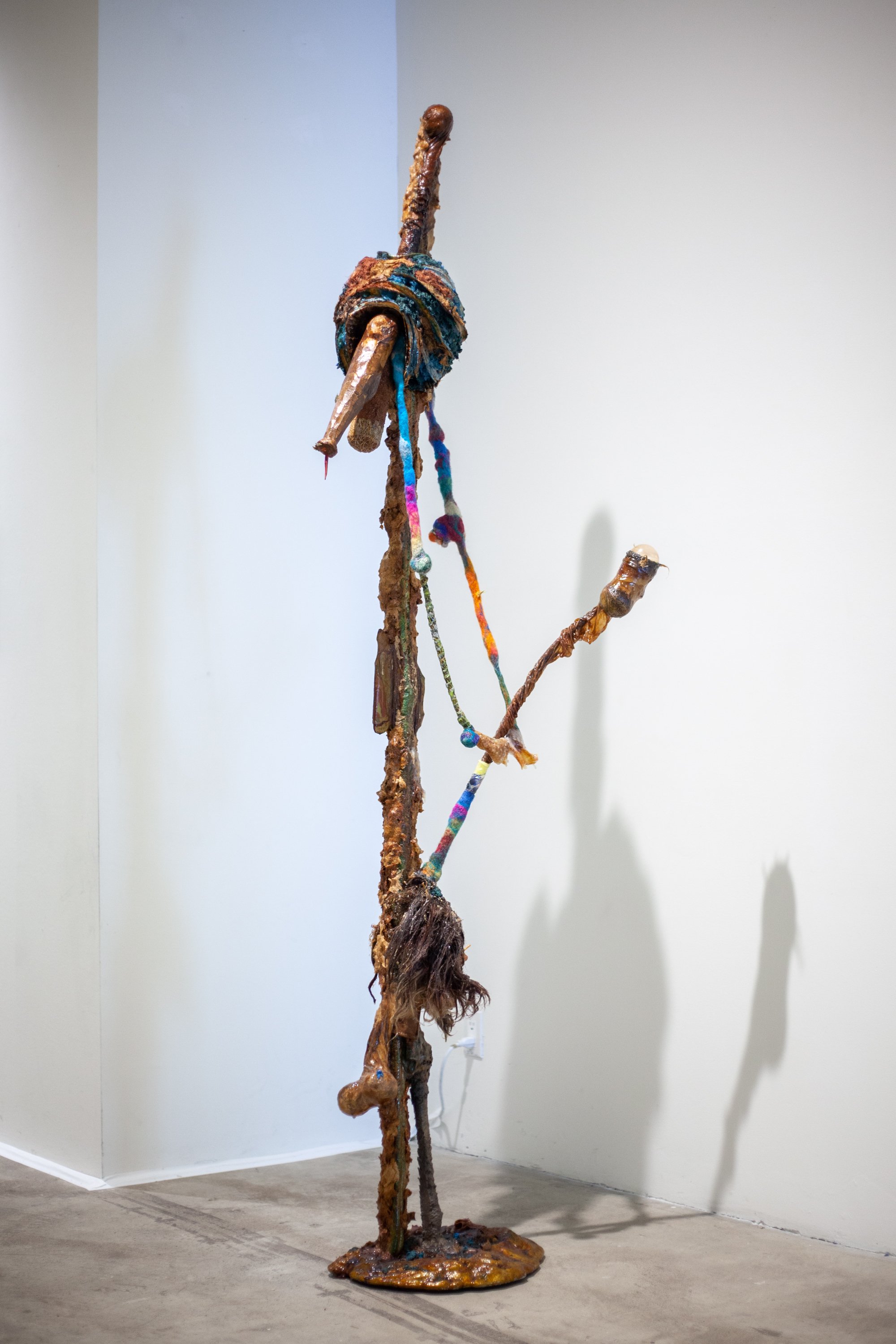
photo © The Bronx Museum of the Arts
PART TWO: By embracing possibilities and imagining speculative futures, the 27 artists featured in the second part of this year’s AIM Biennial expand upon those critical issues examined in part one as they create works and worlds which engage the complexities of the human condition: from our inseparability from nature to the dictates of our cultural identities and norms. Featured artists are Priscilla Aleman, Mickey Aloiso, Roni Aviv, Samantha Box, Ivana Brenner, Nicki Cherry, Christina Freeman, Sarah Friedland, Kat Geng, Daniel Giordano, Woomin Kim, Christopher Lin, Katherine Miranda, Carla Maldonado, Jonathan Sanchez Noa, Qinza Najm, Kark Orozco, María Elena Pombo, Xavier Robles Armas, Coral Saucedo, Daniel Shieh, Rachel Stern, Sagarika Sundaram, Lorenzo Triburgo, Derick Whitson, Huidi Xiang, and A Young Yu.
Connections between nature and the body are examined by multidisciplinary artist Jonathan Sanchez Noa, as he interrogates how histories of colonial extraction have impacted notions of race, identity, and climate. Incorporating Cuban tobacco leaf in handmade paper, Noa creates large abstract landscapes, exemplified by Untitled (OLÙFINA mi carne, Isleños) (2023), that reconstruct narratives of displacement and their cultural and religious significance. Sagarika Sundaram also uses natural materials such as fibers and dyes in her sculptures and installations that explore the interconnectedness of humanity and the environment with a particular focus on themes of migration, memory, and notions of home and domesticity. Subverting processes of mass production, Daniel Giordano’s provocative sculptures serve as eclectic assemblages—comprising industrial artifacts, foodstuffs such as prosciutto and Italian nougat, as well as all manner of organic material, from ticks to bald eagle excrement—that reflect the artist's family, his Italian-American heritage, and the postindustrial realities of Newburgh, New York, his hometown.
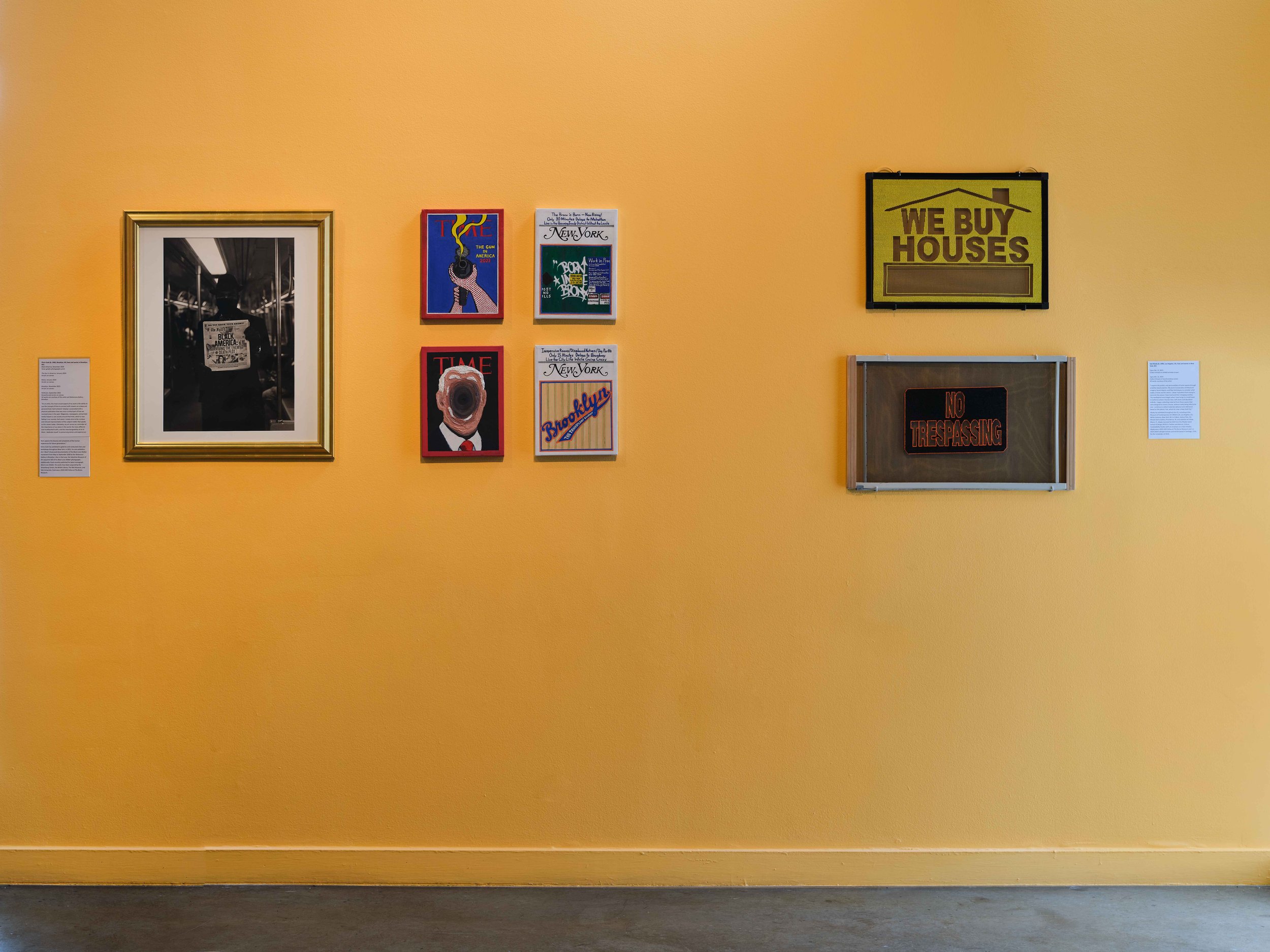
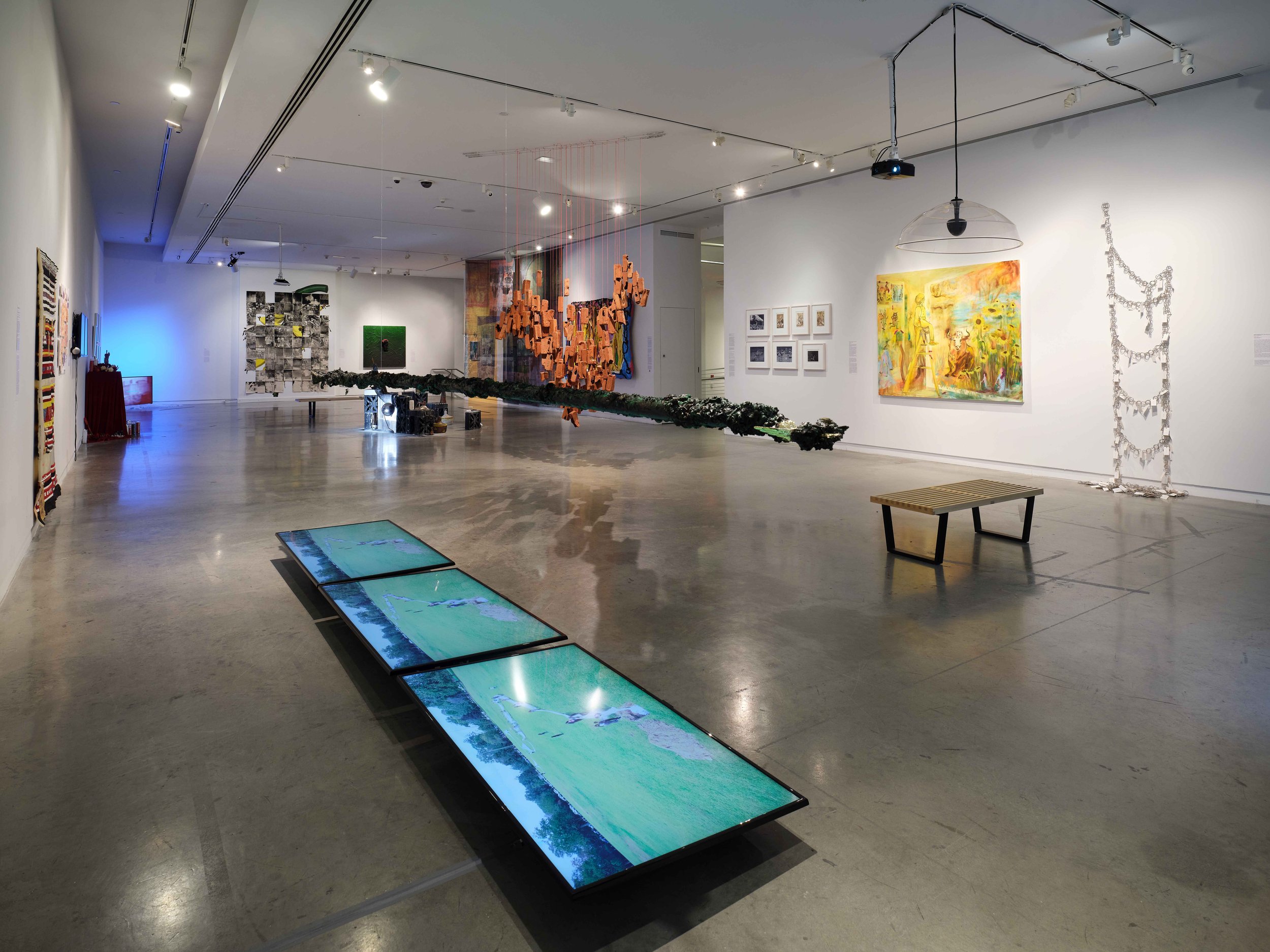
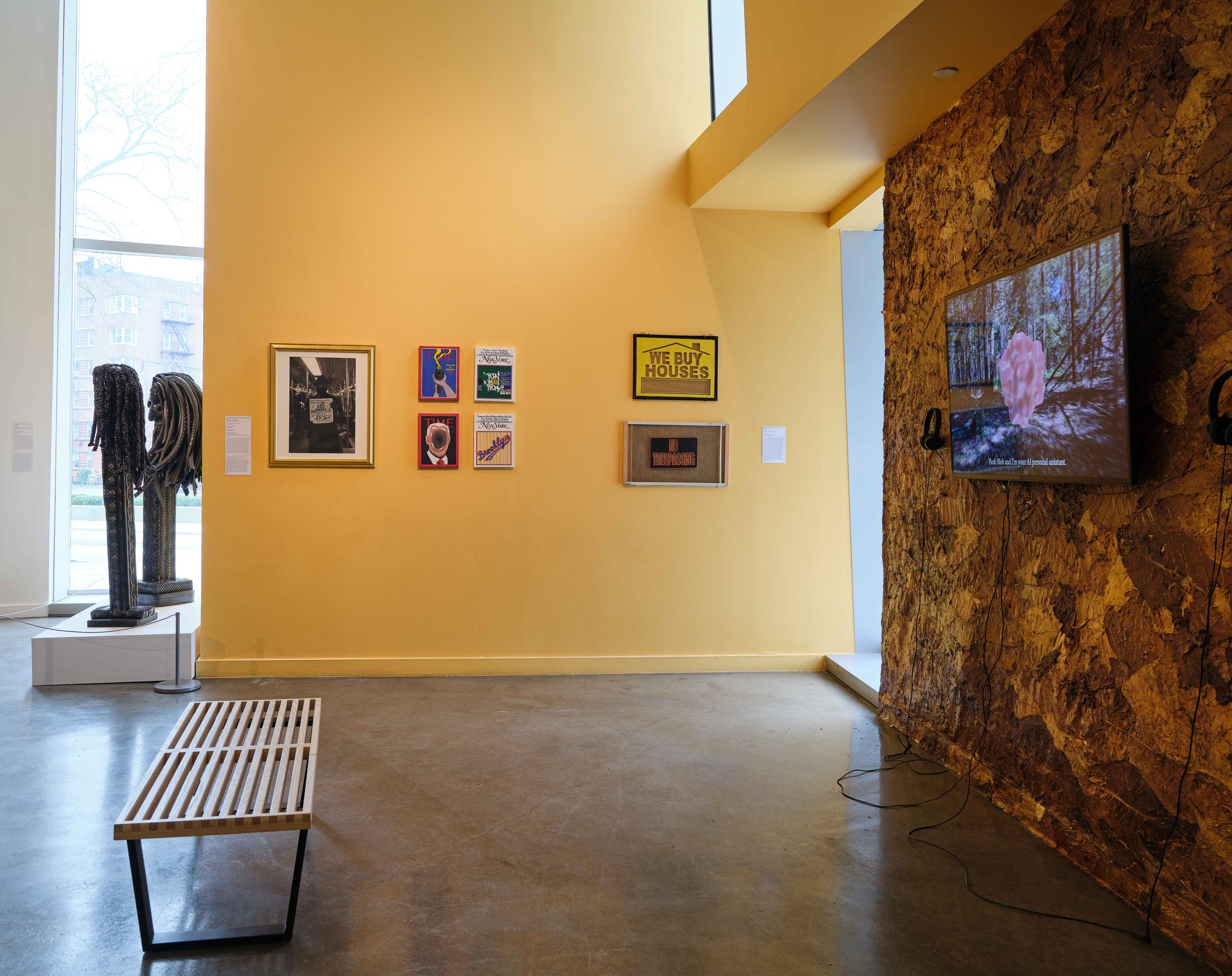
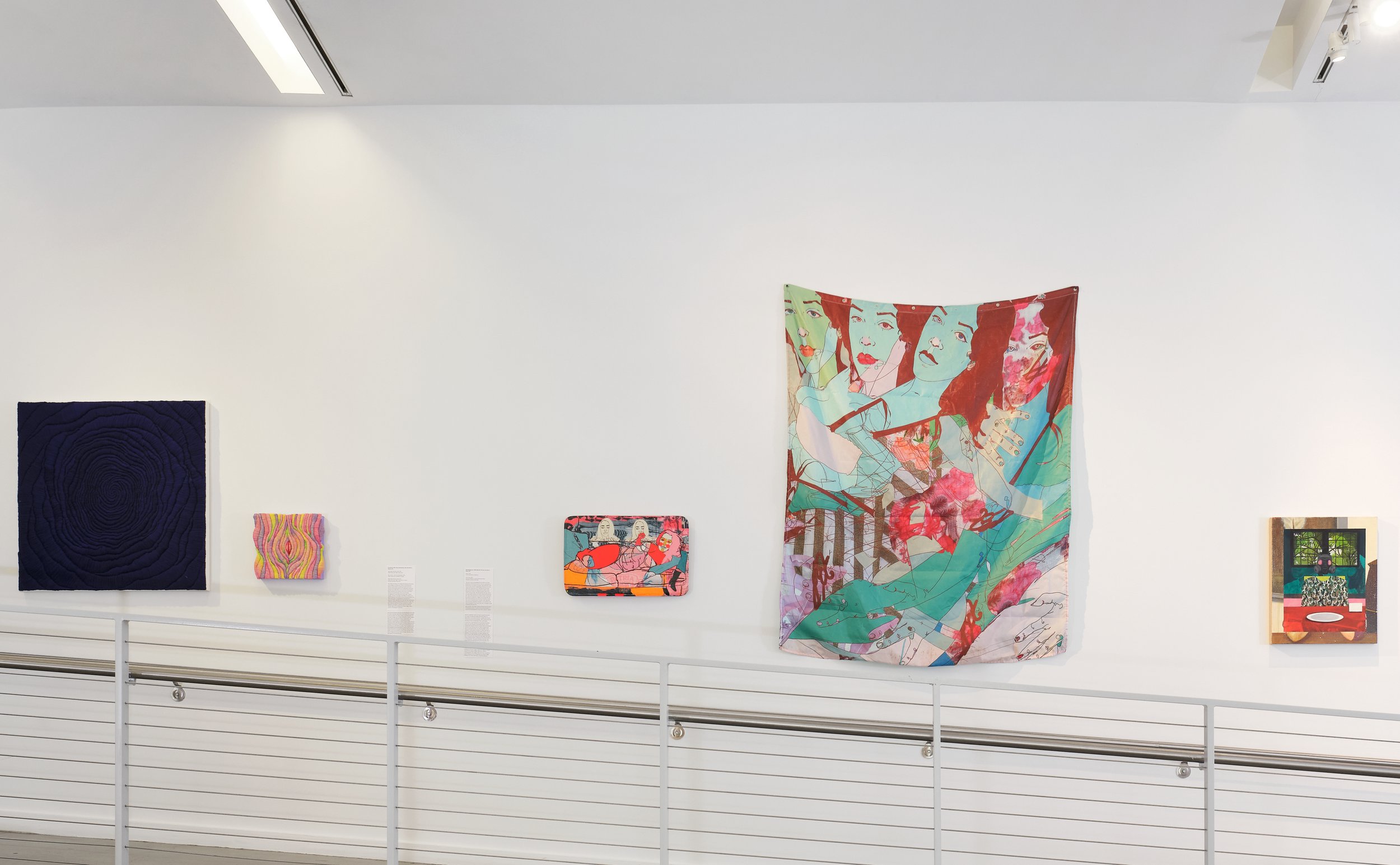
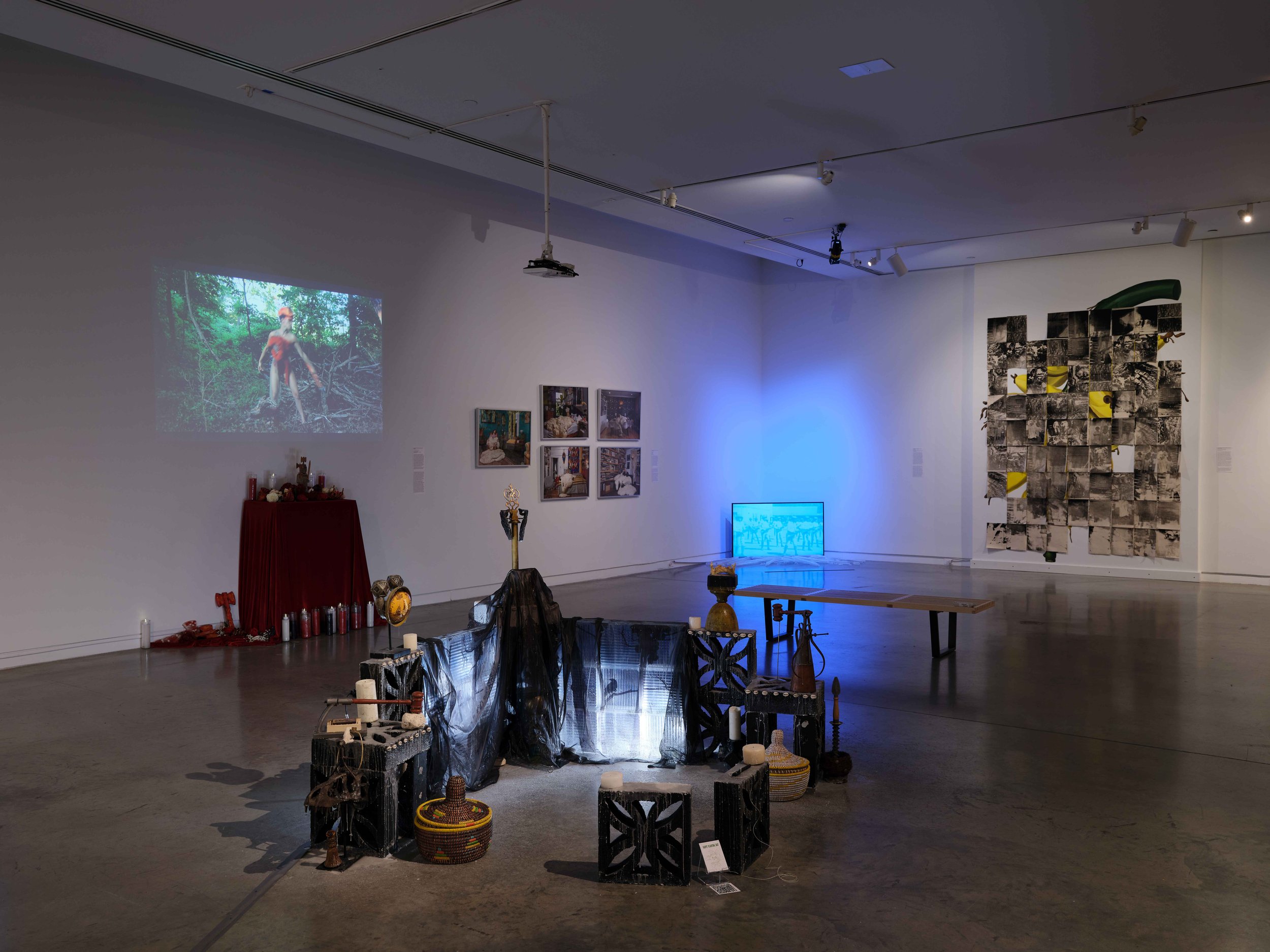
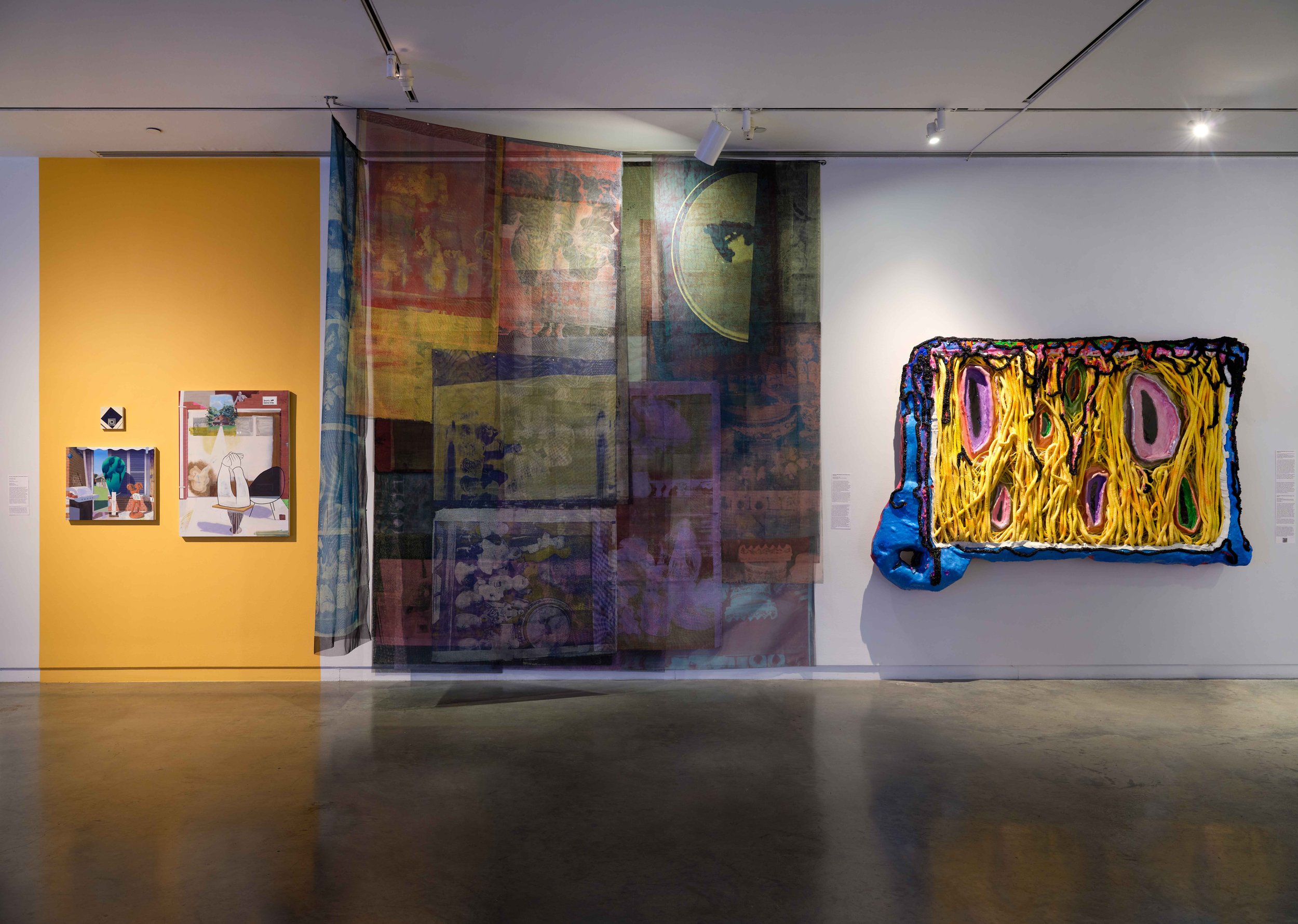

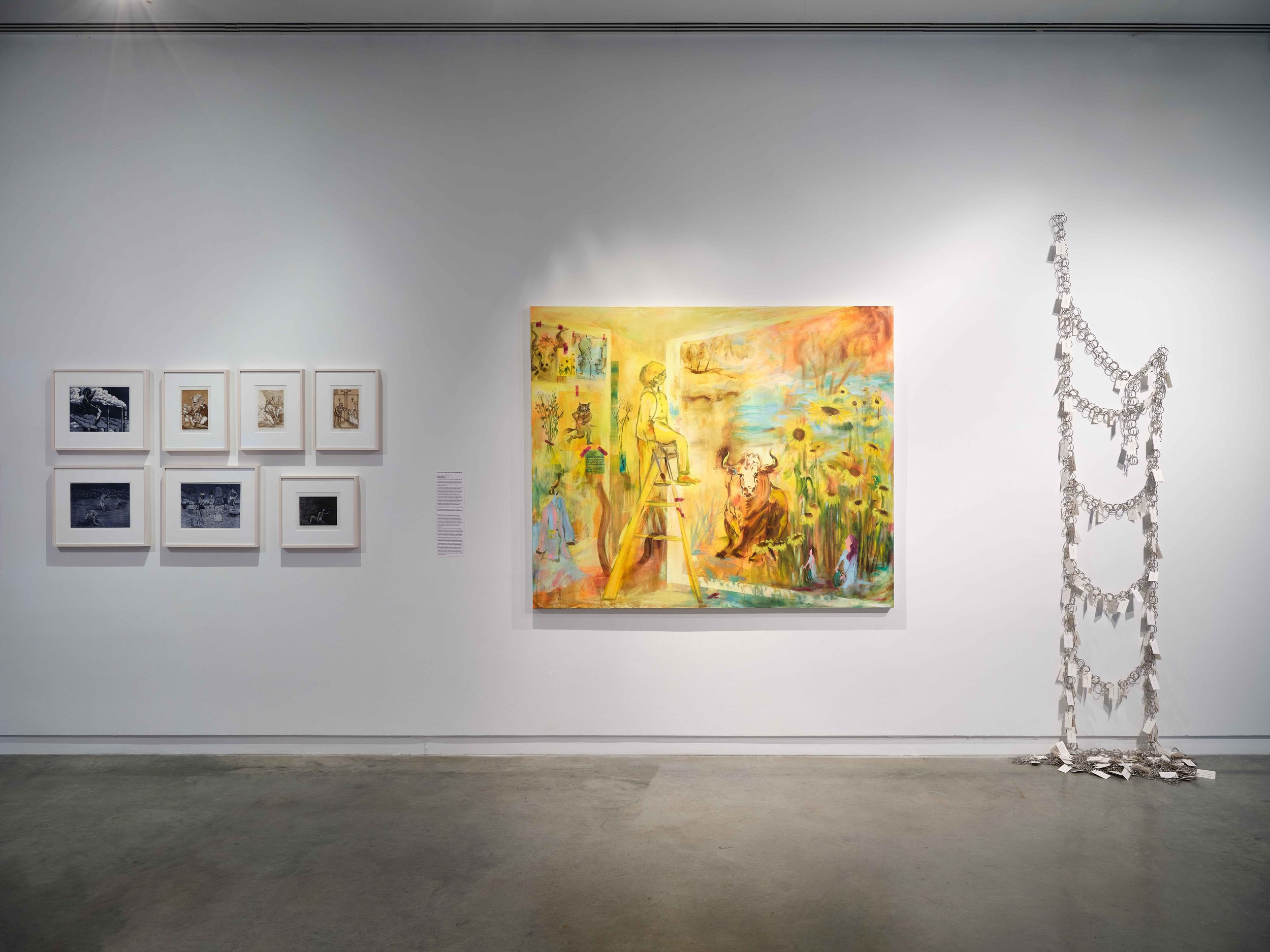
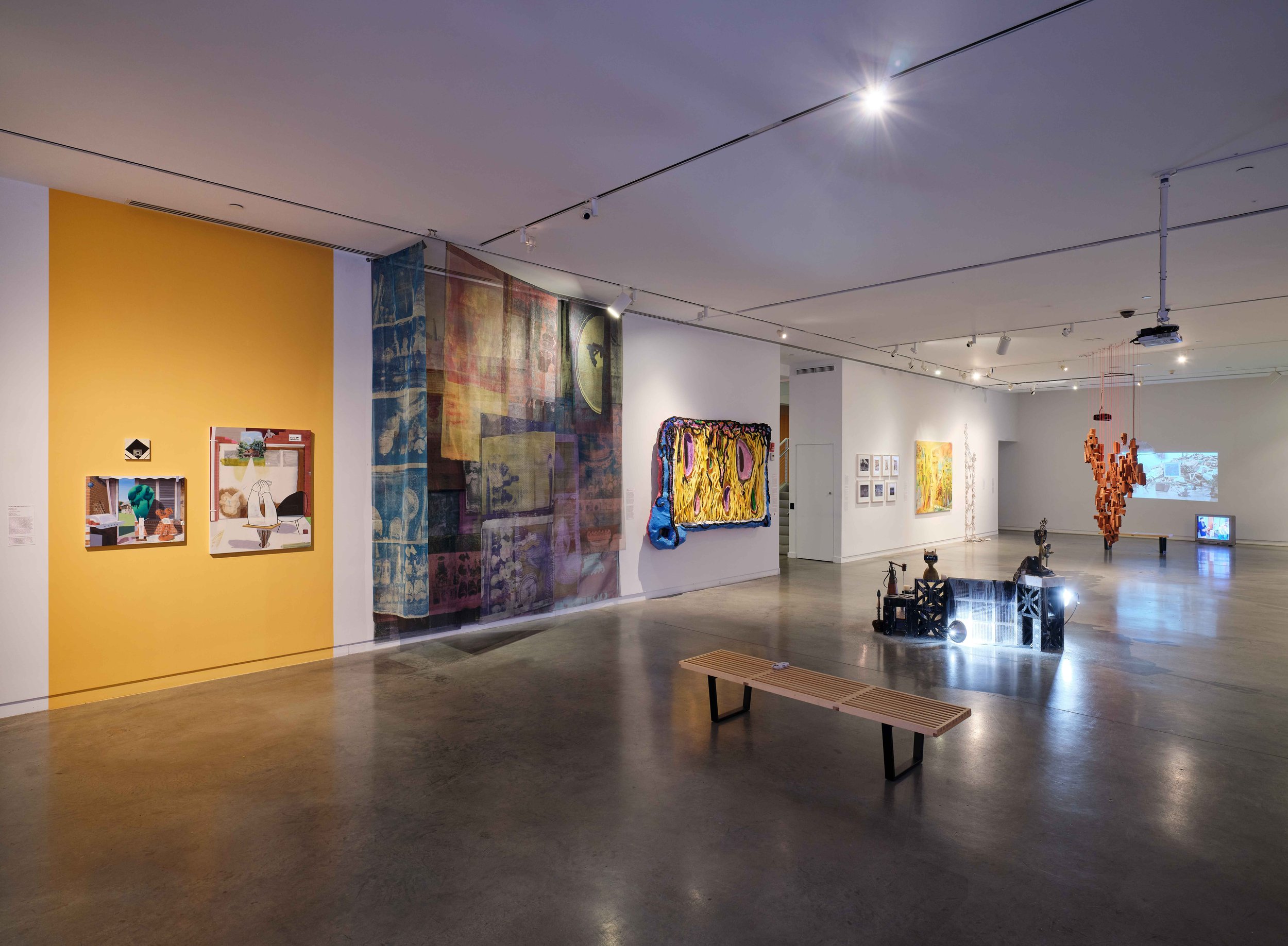
Installation photograph, Bronx Calling: The Sixth AIM Biennial, The Bronx Museum of the Arts, Jan 26 - Mar 31, 2024, photo © The Bronx Museum of the Arts
A tension that arises between the conflicting instincts of both embracing and controlling natural phenomena, including one’s own emotions and experiences, is examined on a psychological register by sculptor Nicki Cherry who delves into what it means to inhabit a body in her sci-fi-esque work that references mental illness, specifically anxiety, and the challenges of contending with it. Sarah Friedland addresses similar tensions in a more physical capacity as she brings attention to the power of movement in everyday life through highlighting home and trust exercises. In Movement Exercises Trilogy (2023), she reframes activities often considered banal, like walking a dog, to instead cast them in an empowering light, encouraging viewers to find beauty in ordinary actions.
The norms of bodily expression in various cultures are further explored by textile-based artist Woomin Kim, who draws upon her Korean identity to examine differing perspectives on sexuality within a patriarchal world. In Mokyoktang (bath house) (2023), for example, Kim highlights the lack of self-consciousness among individuals of different ages who gather in Korean bathhouses, and contrasts this with the far more private dispositions of individuals in the U.S., thus illustrating the dichotomy between private and public spheres and shedding light on distinct societal attitudes towards personal space and community.
CREDITS: Bronx Calling: The Sixth AIM Biennial is organized by Eileen Jeng Lynch, the Director of Curatorial Programs at The Bronx Museum.
ABOUT AIM:
Since 1980, The Bronx Museum has supported New York’s artist community through the AIM Fellowship, the Museum’s flagship artist development program offering career management resources to guide emerging artists through the opaque professional practices of the art world. Mentored by a distinguished faculty of industry experts, AIM Fellows engage in an intensive series of seminars and activities covering a wide range of topics including finance, law, media management, and writing, among others, that aid artists in building sustainable studio practices while expanding peer and professional networks. Since its founding, the AIM Fellowship has provided pivotal career support to a diverse roster of over 1,200 of New York's most promising artists, including Diana Al-Hadid, Firelei Báez, Njideka Akunili Crosby, Abigail DeVille,, LaToya Ruby Frazier, Lucia Hierro, Glenn Ligon, Sarah Oppenheimer, Michael Richards, Jacolby Satterwhite, and Saya Woolfalk.
ABOUT THE BRONX MUSEUM:
The Bronx Museum is the only major contemporary art museum in NYC with free admission year-round, making it a vital resource not just for residents in The Bronx, but thousands of residents from all five boroughs and tourists visiting annually. Now an internationally-recognized cultural destination, for the past five decades, The Bronx Museum has presented hundreds of exhibitions featuring works by culturally diverse and under-represented artists. The Museum’s permanent collection of 2,000+ works preserves and documents artists who are not typically represented within traditional museum collections by showcasing work by artists of African, Asian, and Latin American ancestry, as well as artists for whom the Bronx has been critical to their development. After over 50 years, The Bronx Museum continues to promote its mission of making the arts accessible to all audiences.
Please visit the museum's website here for more information about this exhibition and others. Also, you can find the Bronx Museum on Instagram, YouTube, and Facebook.
VISIT THE MUSEUM: 1040 Grand Concourse Bronx, New York 10456 T: 718-681-6000.
Painting in the River of Angels: Judy Baca and The Great Wall
Installation photograph, Painting in the River of Angels: Judy Baca and The Great Wall, Los Angeles County Museum of Art, Oct 26 2023 – Jun 2 2024, photo © Museum Associates/LACMA
(Los Angeles, CA)The Los Angeles County Museum of Art (LACMA) presented the Painting in the River of Angels: Judy Baca and The Great Wall on October 26 of last year at the Resnick Pavilion. This is the artist’s first solo exhibition at the museum. Los Angeles artist Judy Baca (b. 1946) conceived The Great Wall of Los Angeles (1975) as a monument to the people of California. Over five summers (1976-83), Baca collaborated with 400 youth, artists, and community members on a mural that told the erased histories of local communities. The artist, alongside members of the Social and Public Art Resource Center (SPARC), an organization Baca co-founded, designed the mural and painted it on the walls of the Tujunga Wash, a tributary of the L.A. River in North Hollywood, California. In 2021, SPARC received a grant from the Mellon Foundation to expand the landmark’s chronology into the 21st century.
Installation photograph, Painting in the River of Angels: Judy Baca and The Great Wall, Los Angeles County Museum of Art, Oct 26 2023 – Jun 2 2024, photo © Museum Associates/LACMA
At LACMA, Baca and SPARC artists will paint new sections of The Great Wall during the museum’s public hours. These new paintings span the 1960s with the first panel depicting moments of the Chicano Movement including the Farmworkers’ Movement and the East L.A. Student Walkouts, and the second panel featuring vignettes of the Watts Rebellion, Watts Renaissance, and community organizing by the Black Panthers. After the artists complete the paintings at LACMA, these panels will be added to The Great Wall, as part of the expansion that creates a mile of visual history. LACMA’s exhibition will also debut Generation on Fire, a new section of the wall memorializing activists known as the Freedom Riders. In 1961, they boarded buses traveling from Washington, D.C. to Southern states to challenge segregation on public transit. Baca centers the activists forming a circle in solidarity.

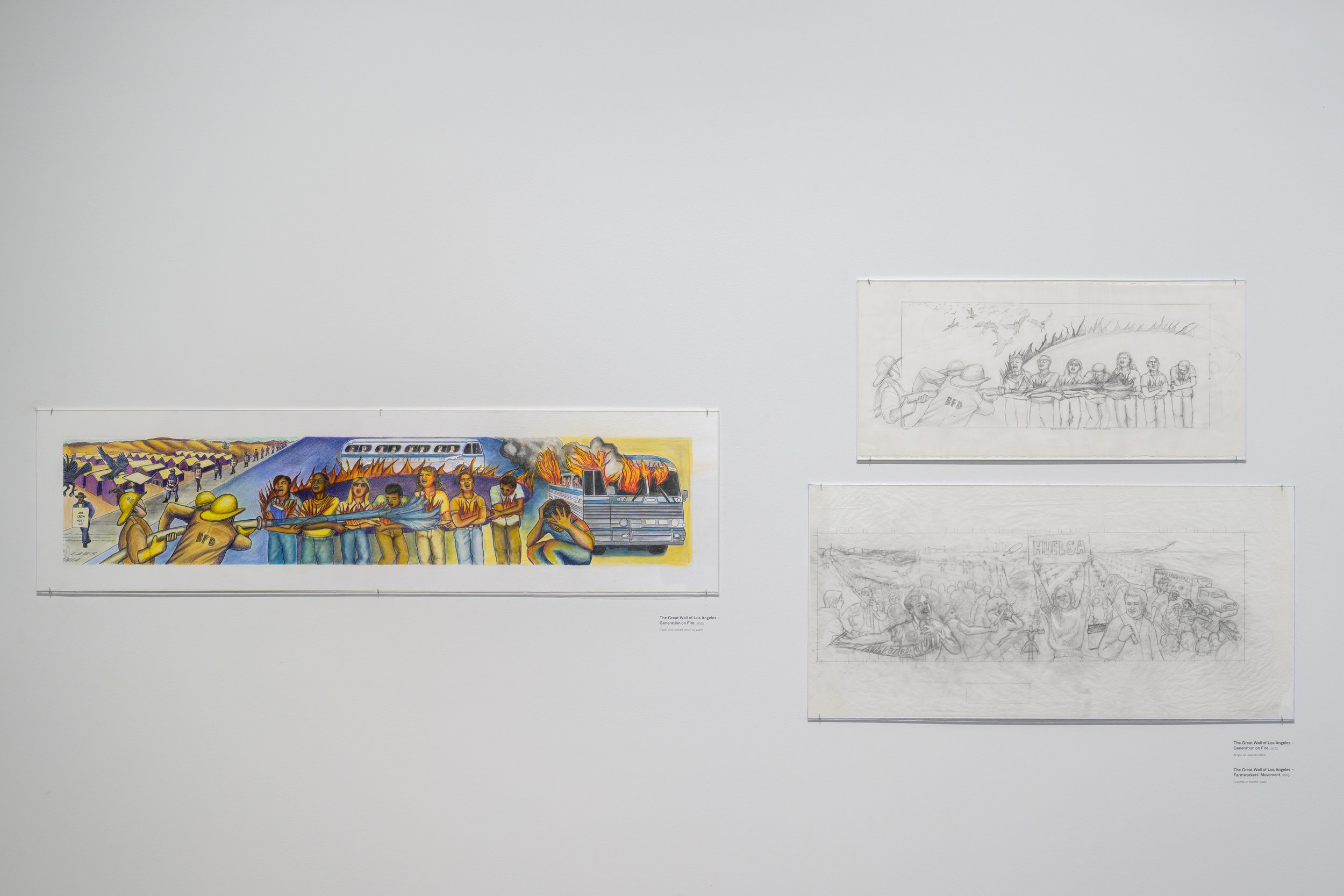
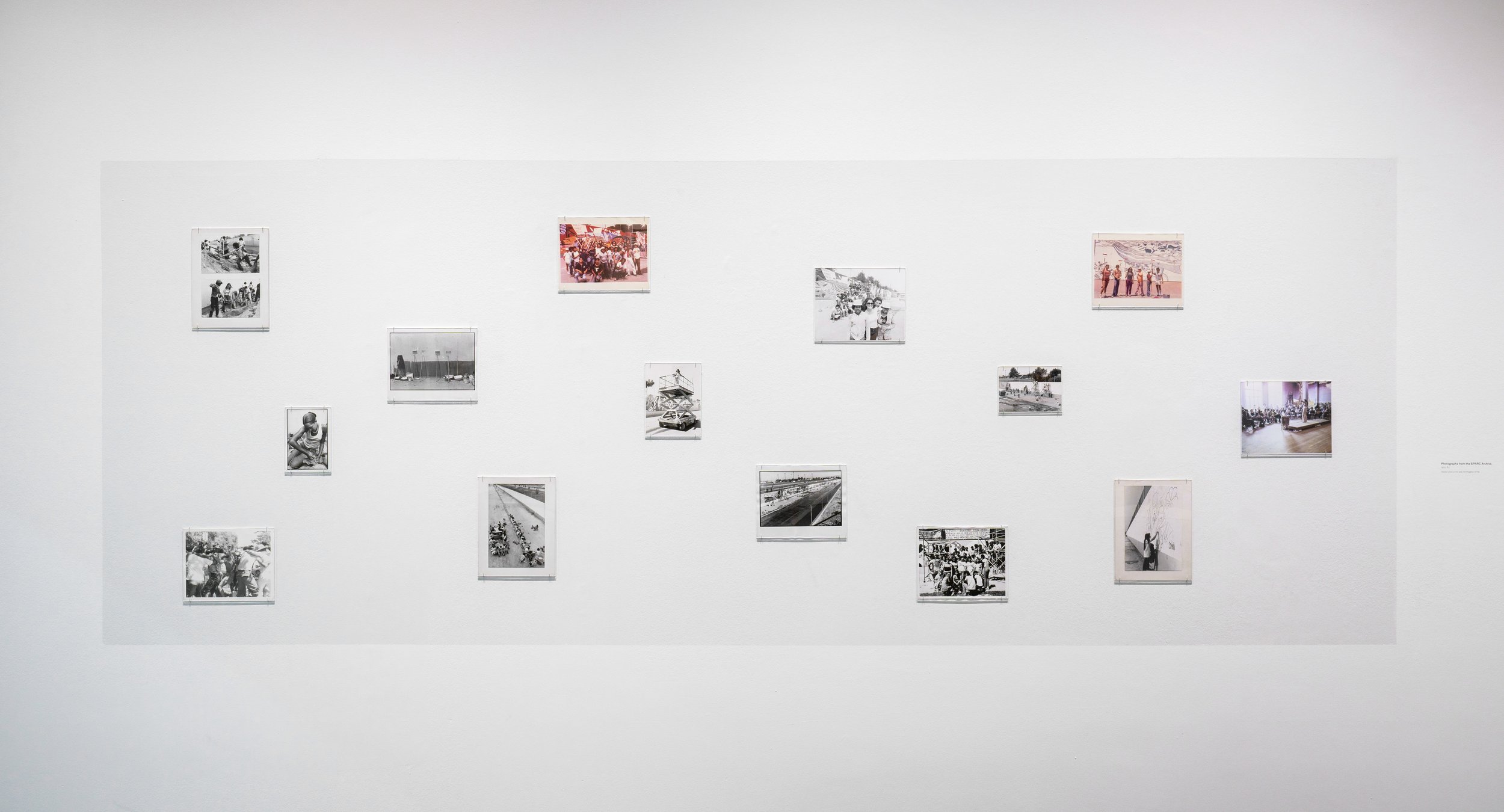
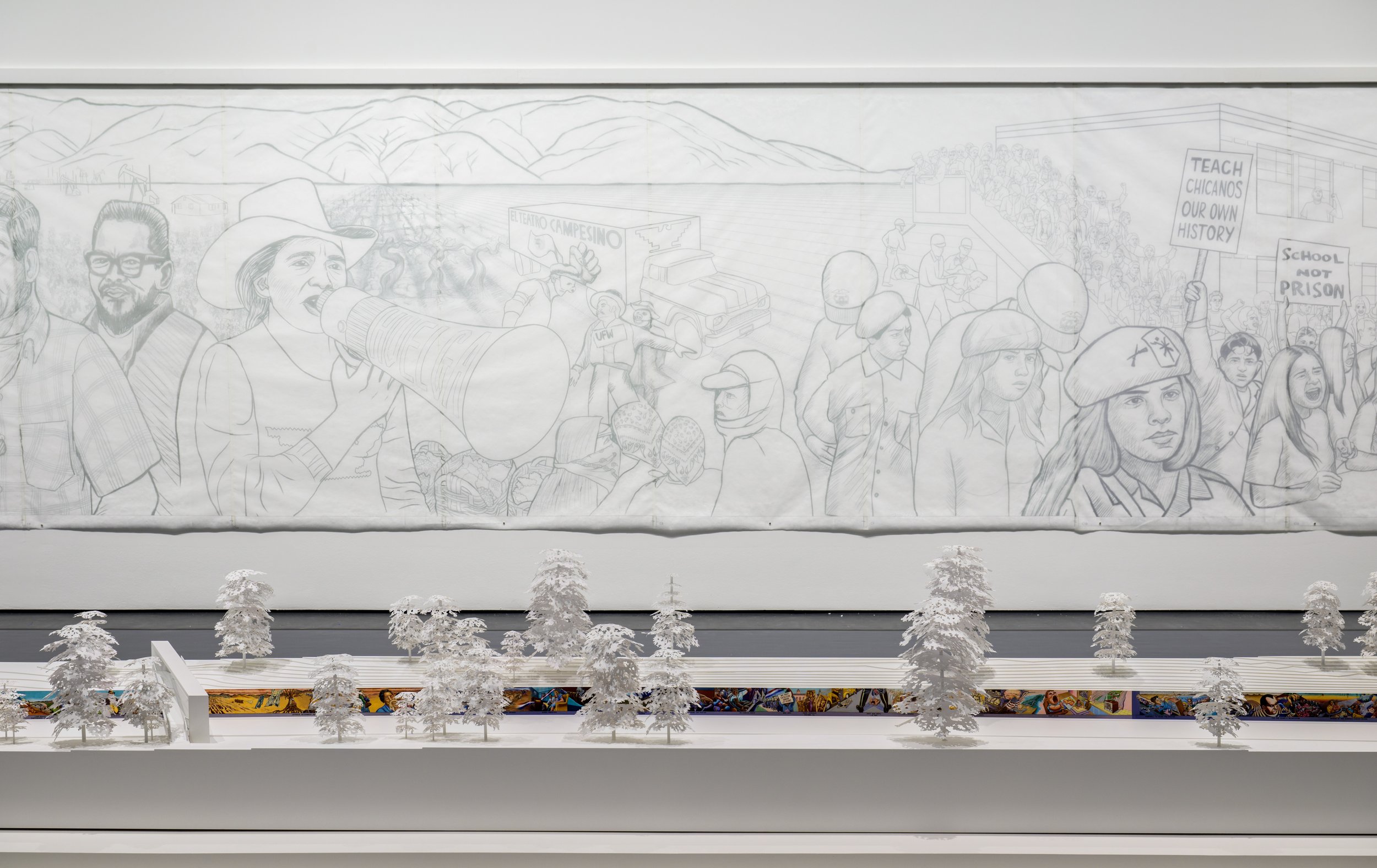
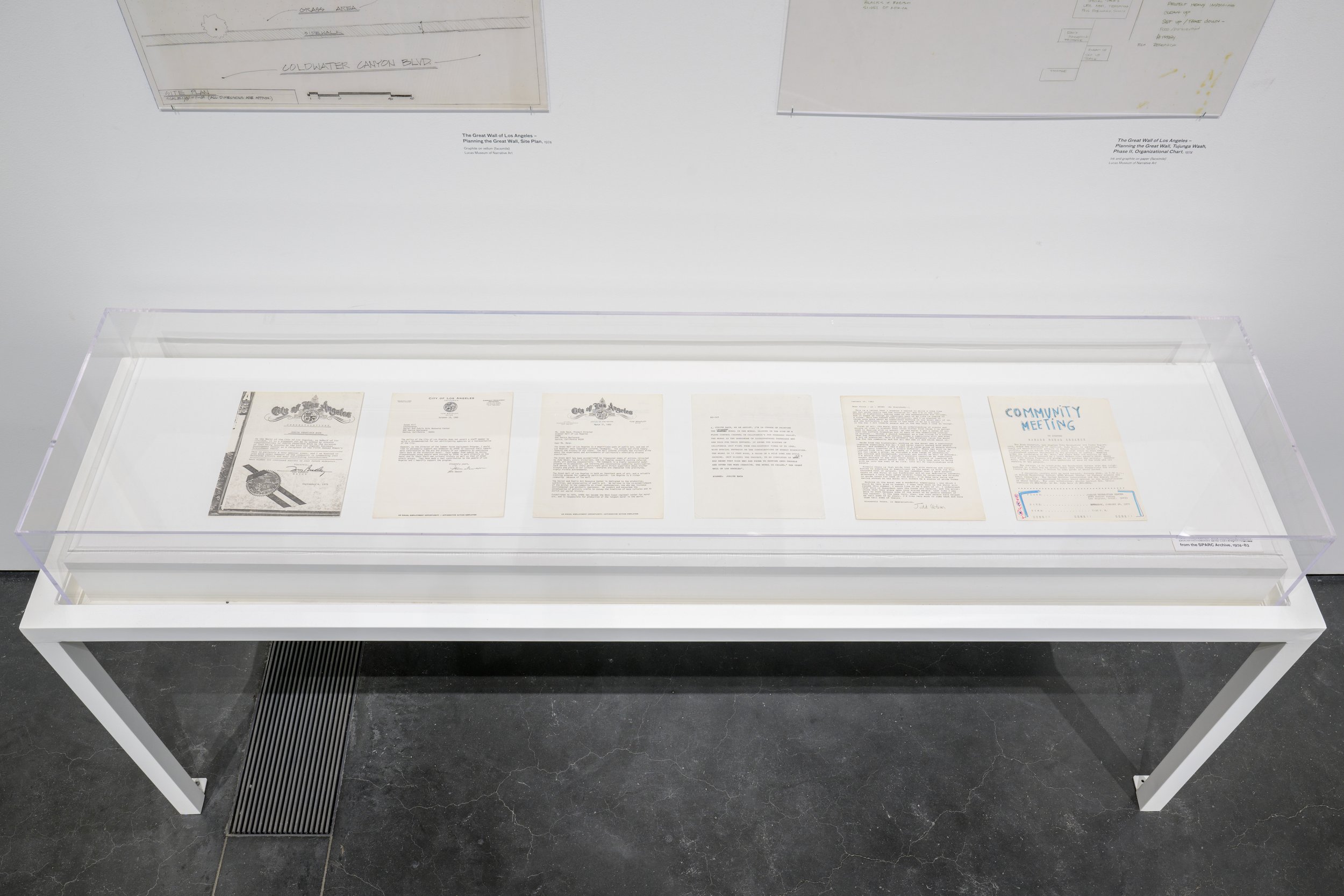
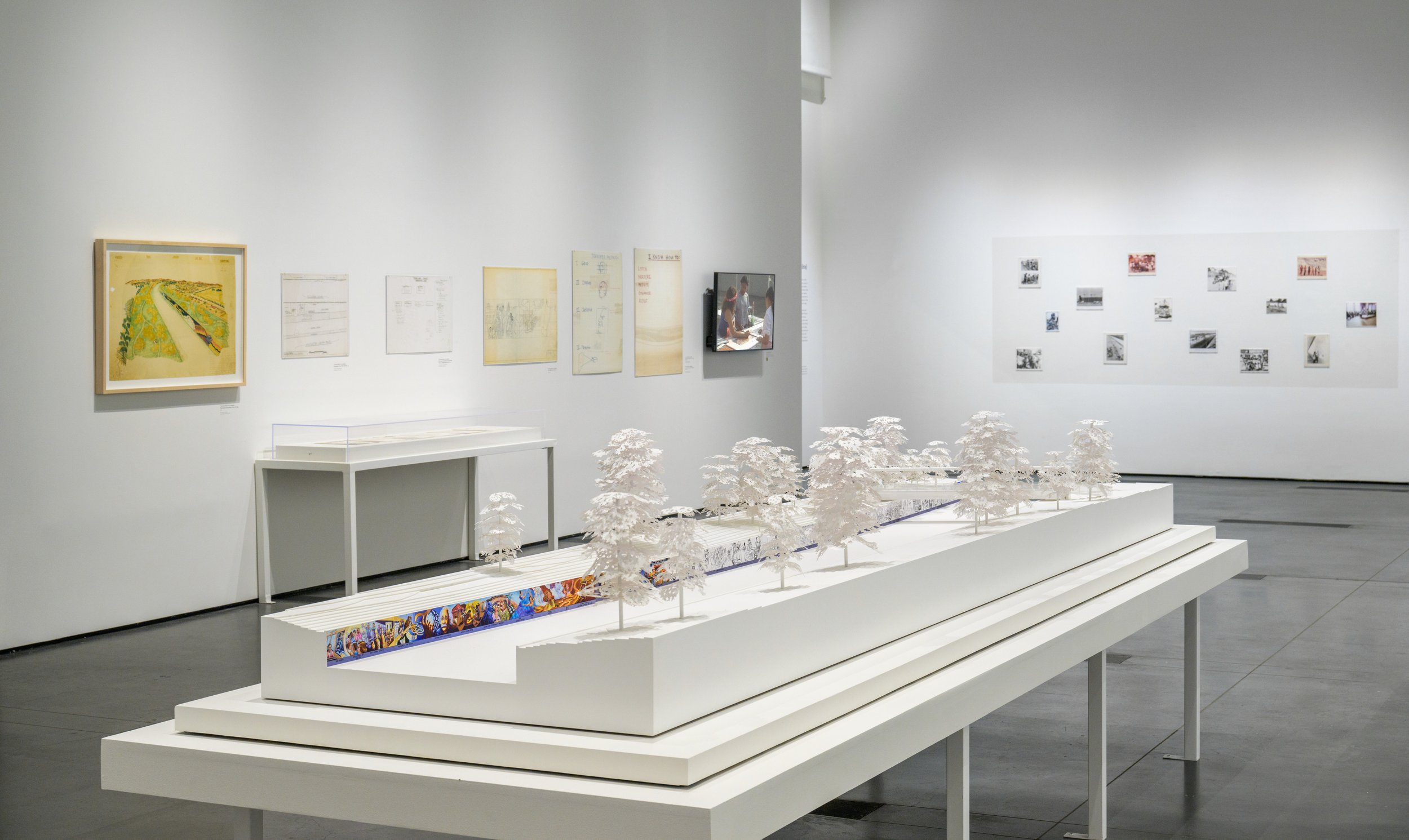
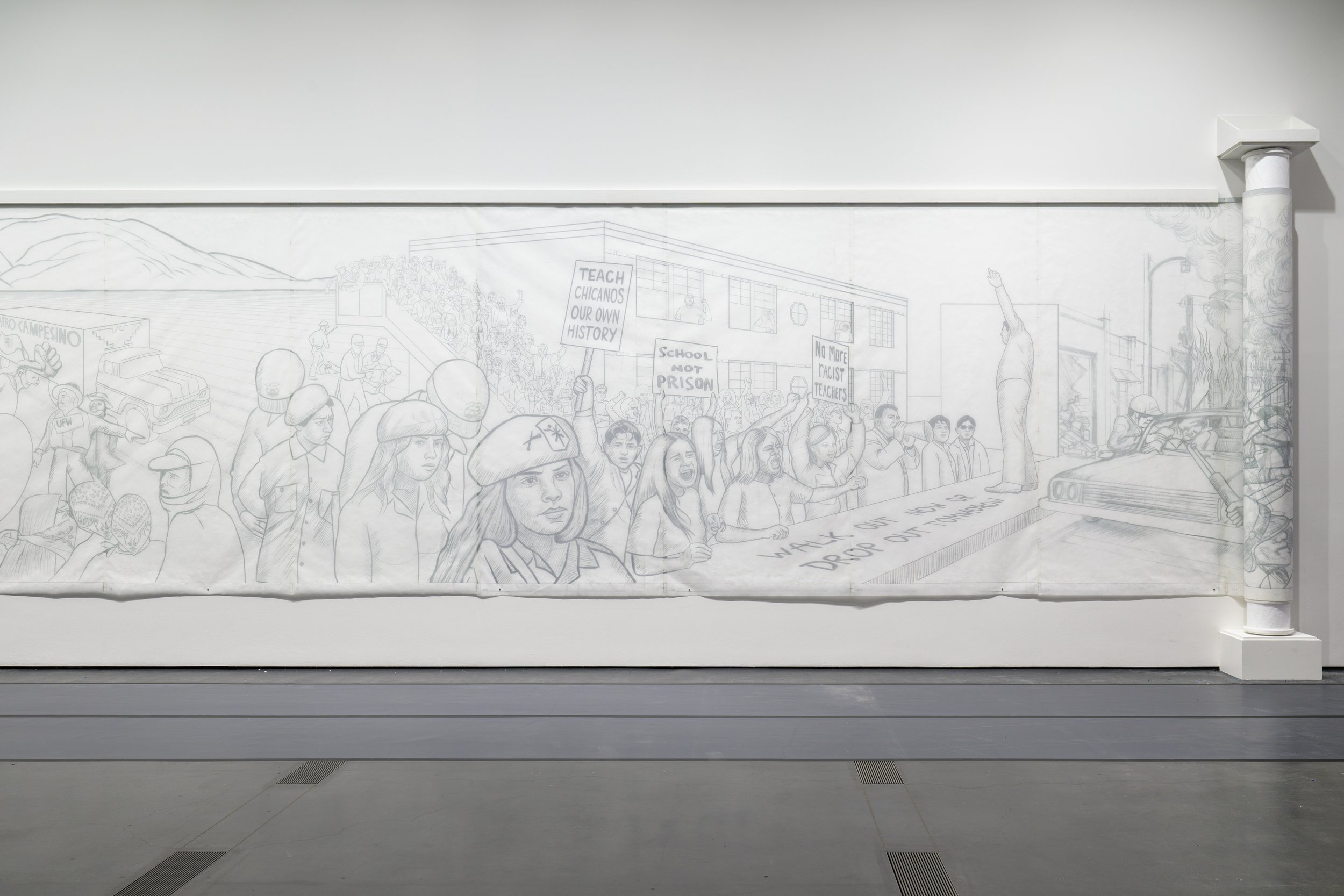
Installation photograph, Painting in the River of Angels: Judy Baca and The Great Wall, Los Angeles County Museum of Art, Oct 26 2023 – Jun 2 2024, © Judith F. Baca, photo © Museum Associates/LACMA
In addition to the paintings, LACMA’s exhibition features materials from the artist’s archive that have never been exhibited, revealing Baca’s process and innovations to muralism. Additionally, the exhibition includes Baca’s Augmented Reality Lens, The River Once Ran (2022), part of Collection II of LACMA × Snapchat: Monumental Perspectives. Painting in the River of Angels is co-curated by Dhyandra Lawson, Andy Song Assistant Curator of Contemporary Art, and Deliasofia Zacarias, Executive Assistant and Fellow, Director’s Office, LACMA.
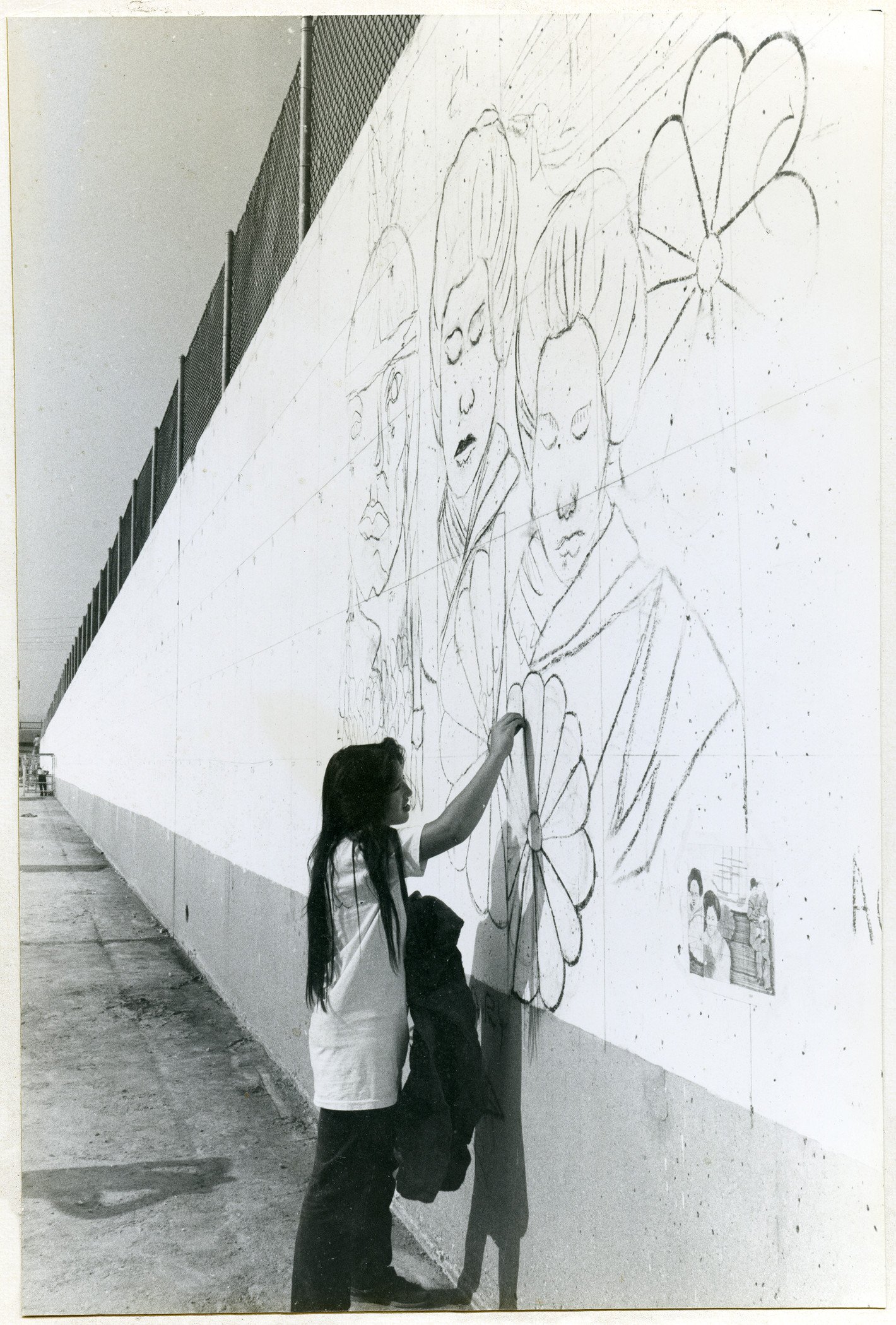
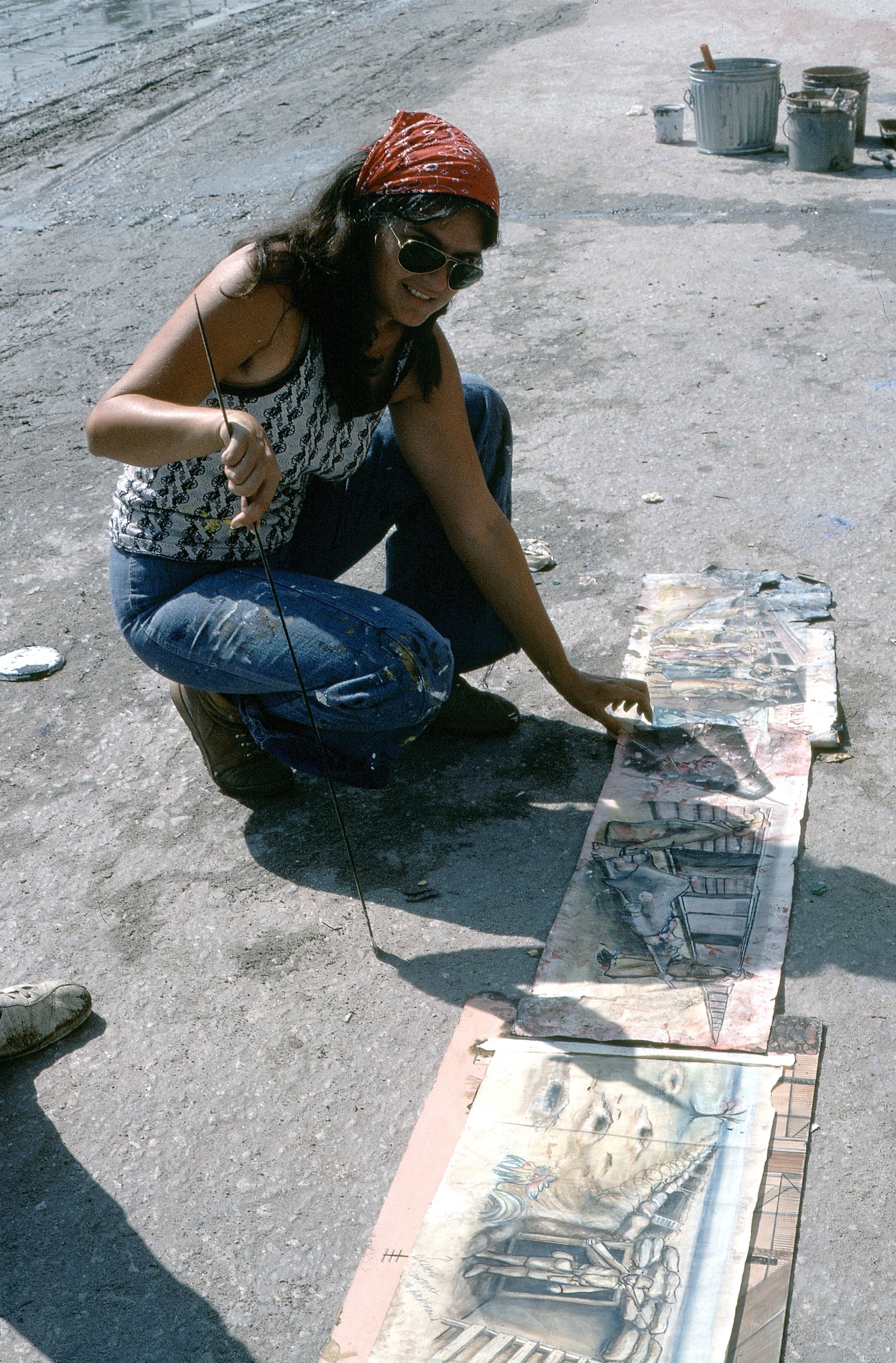
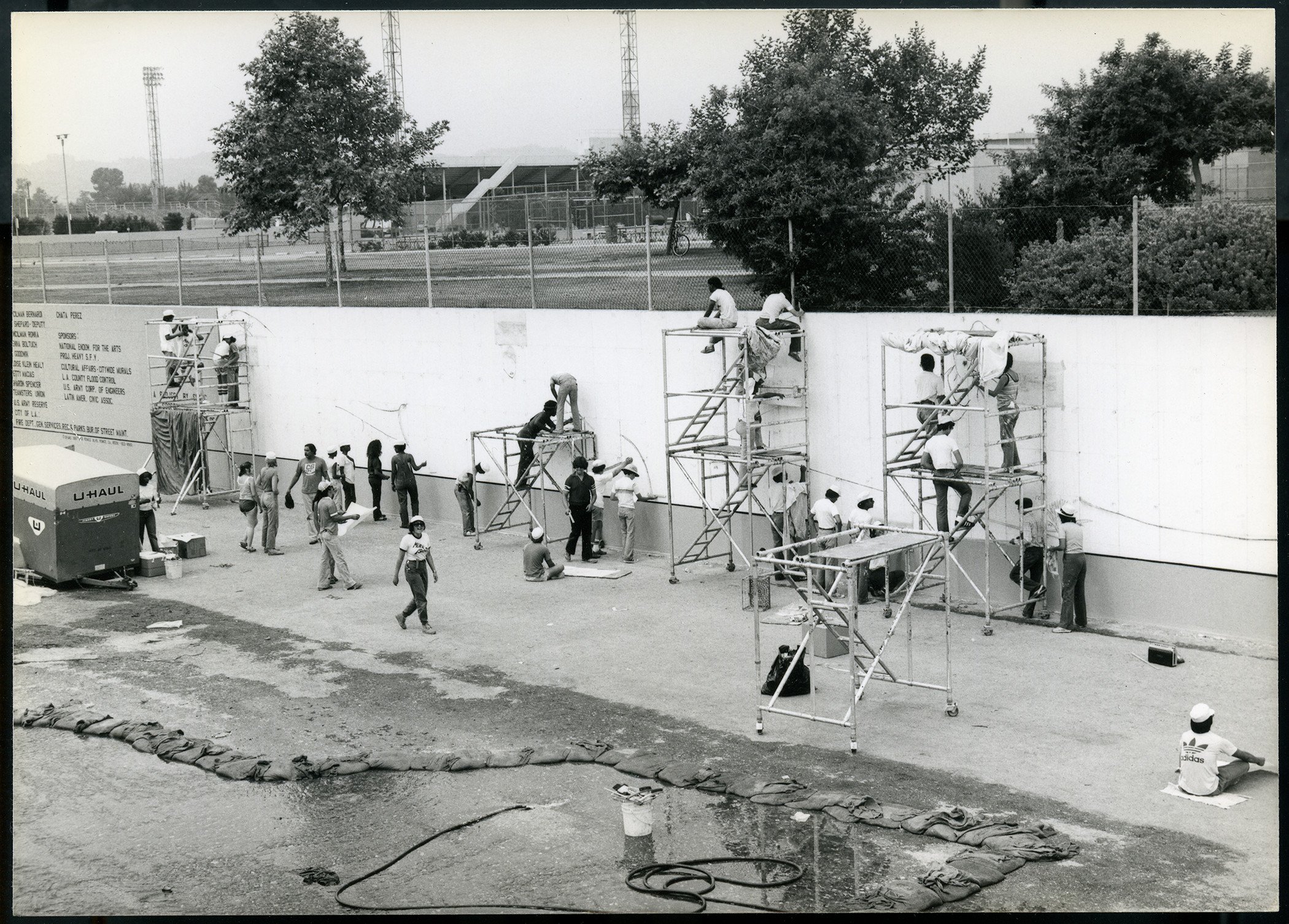
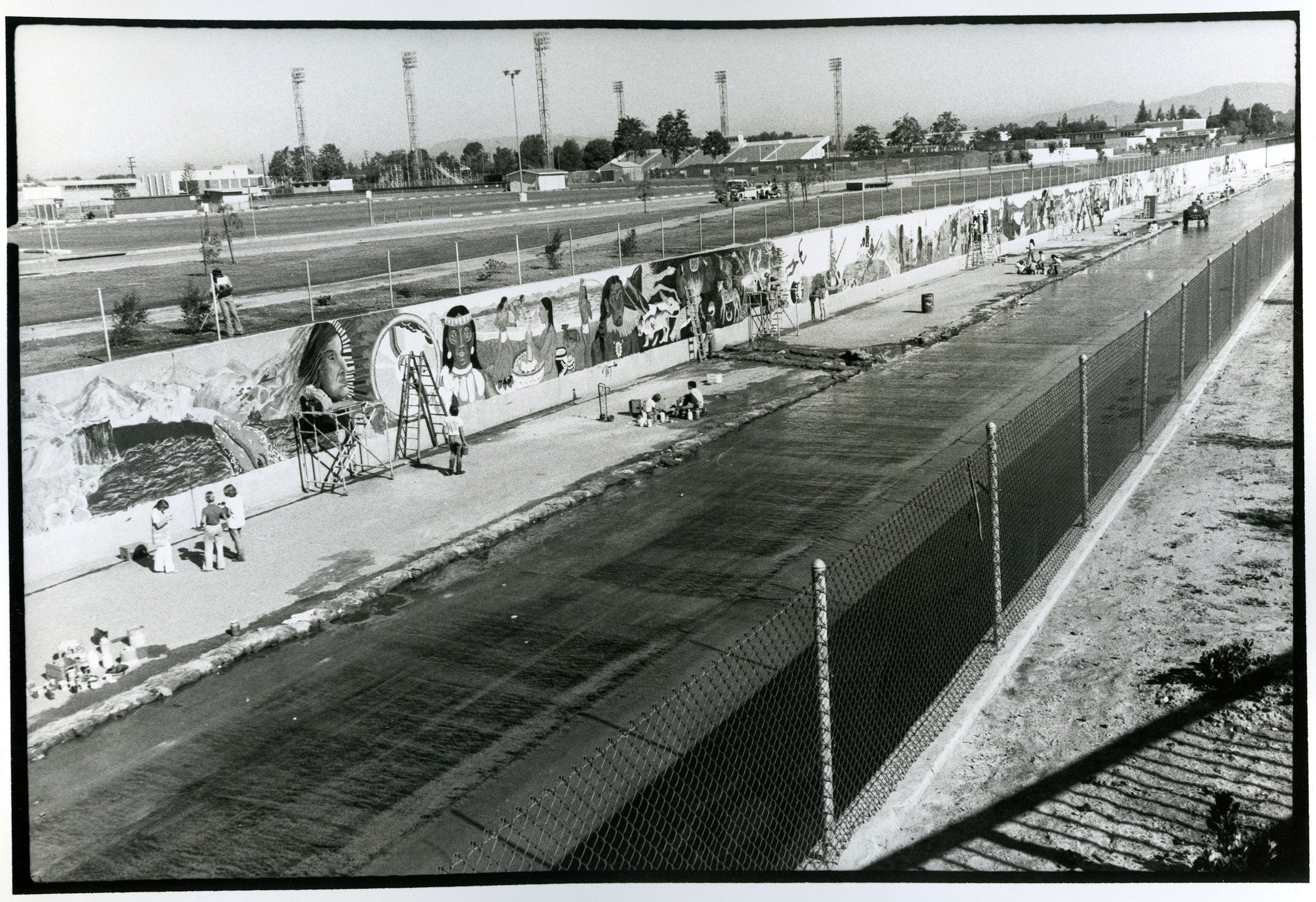
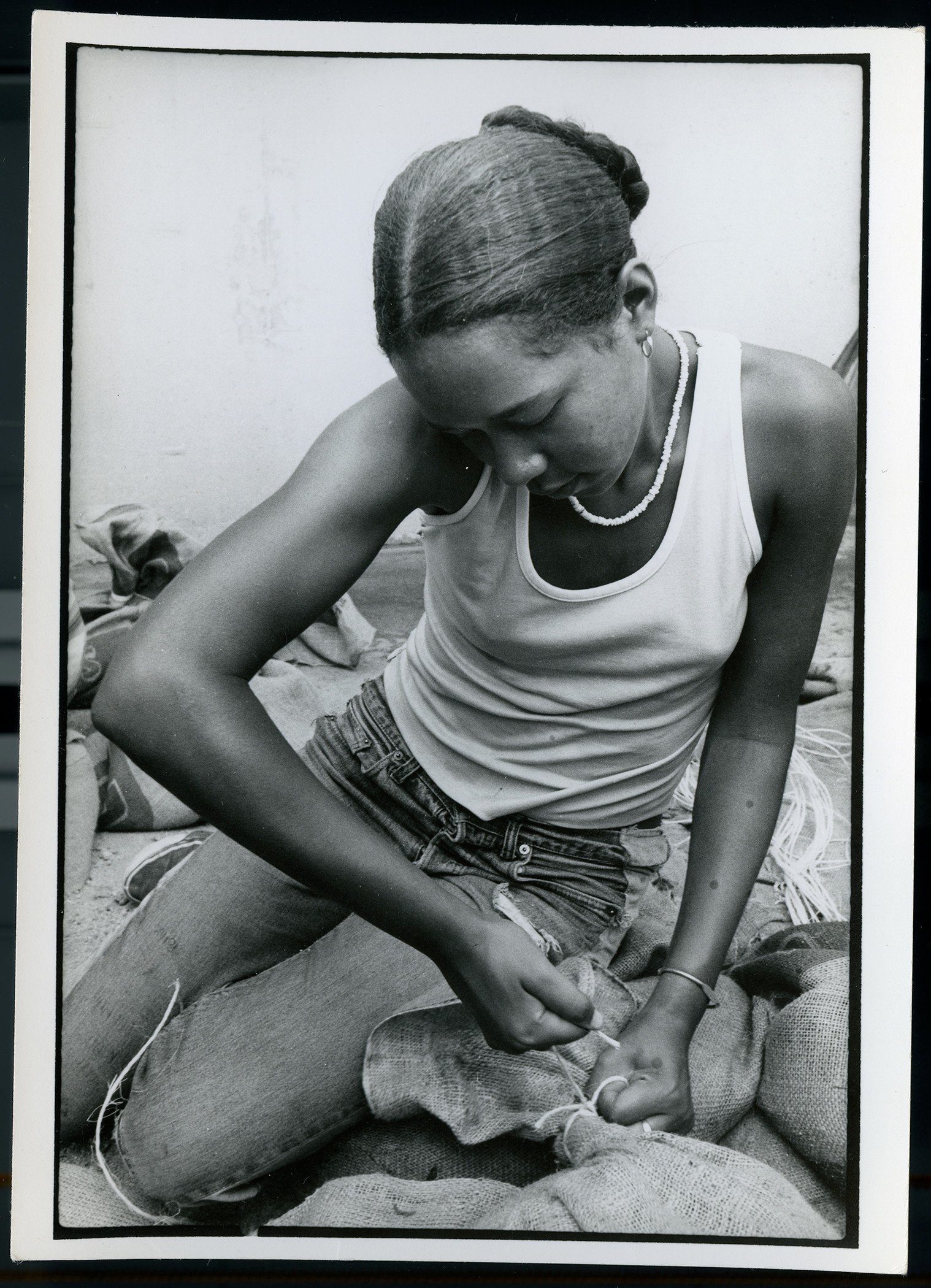
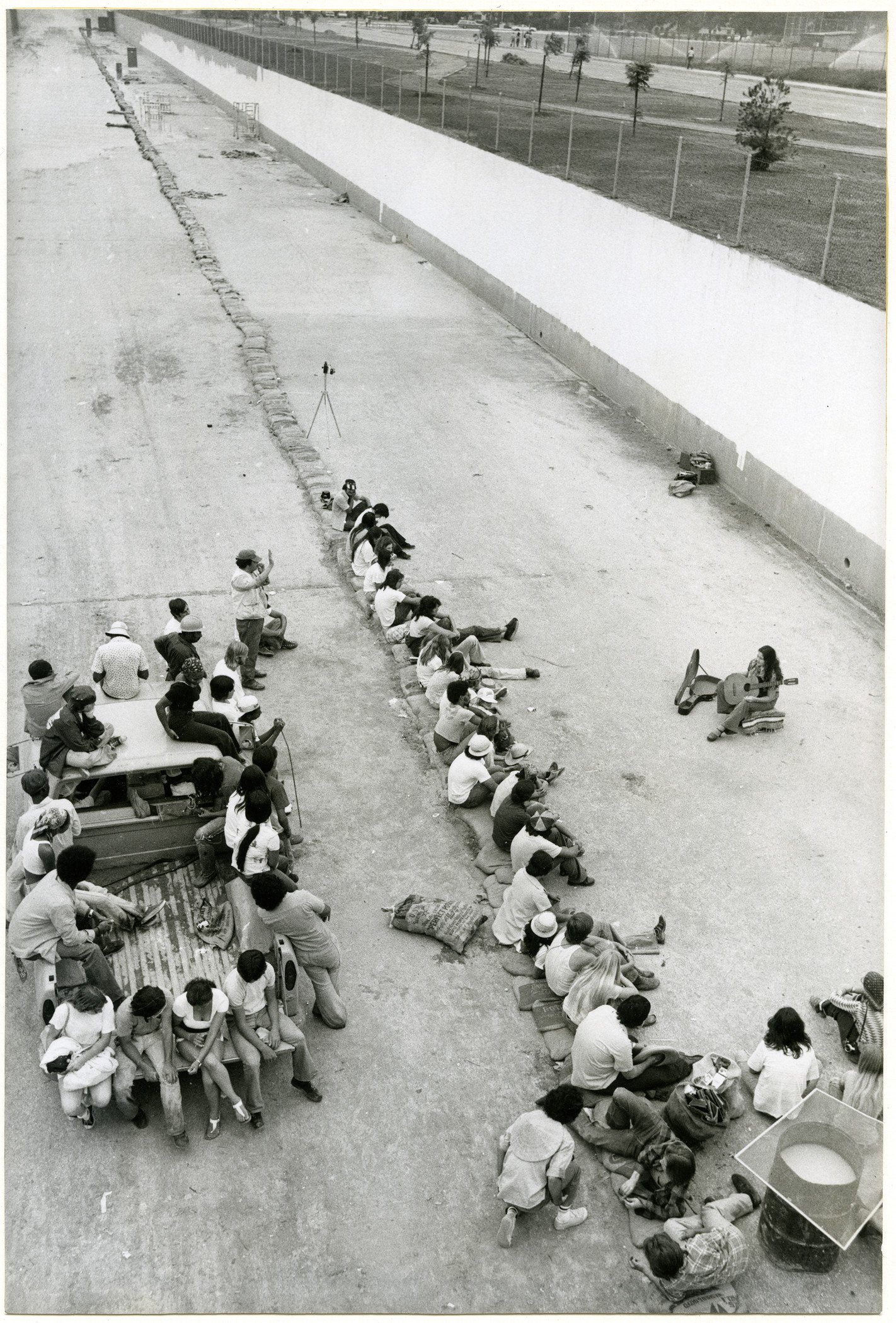
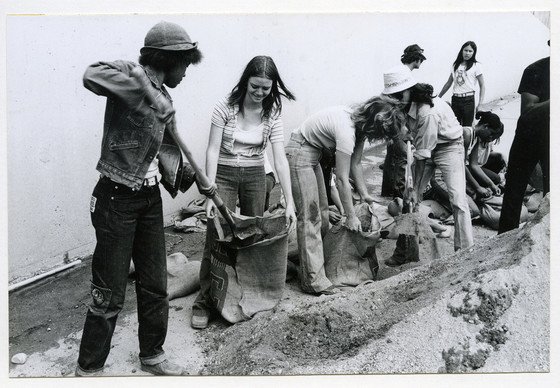
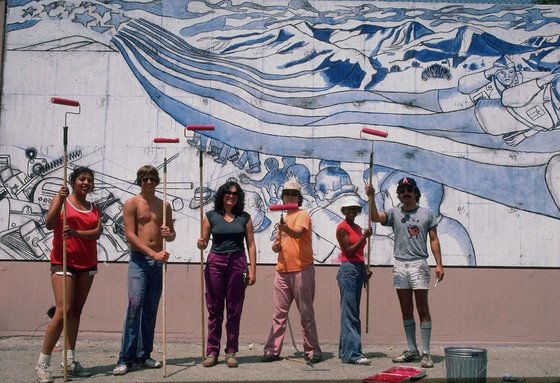
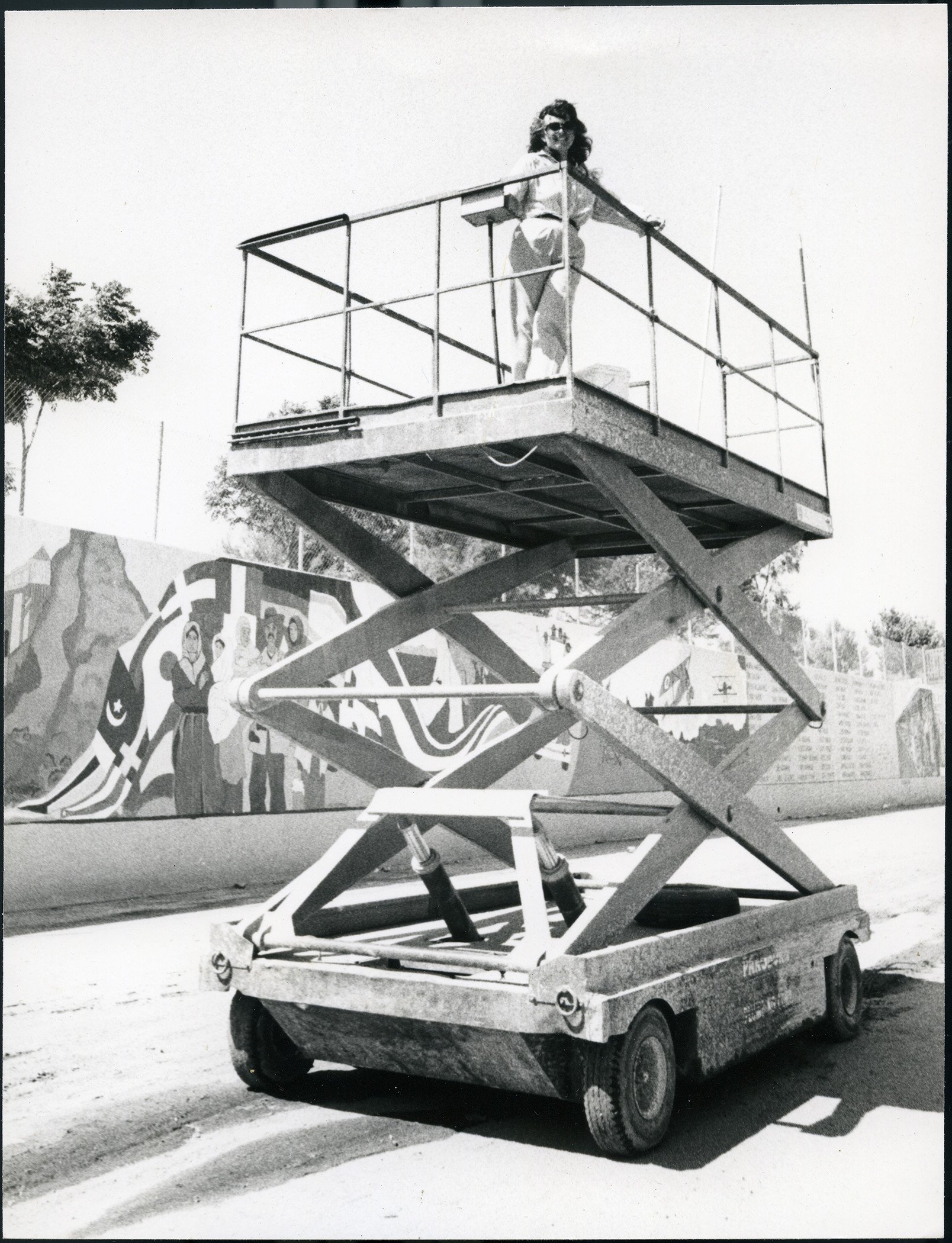
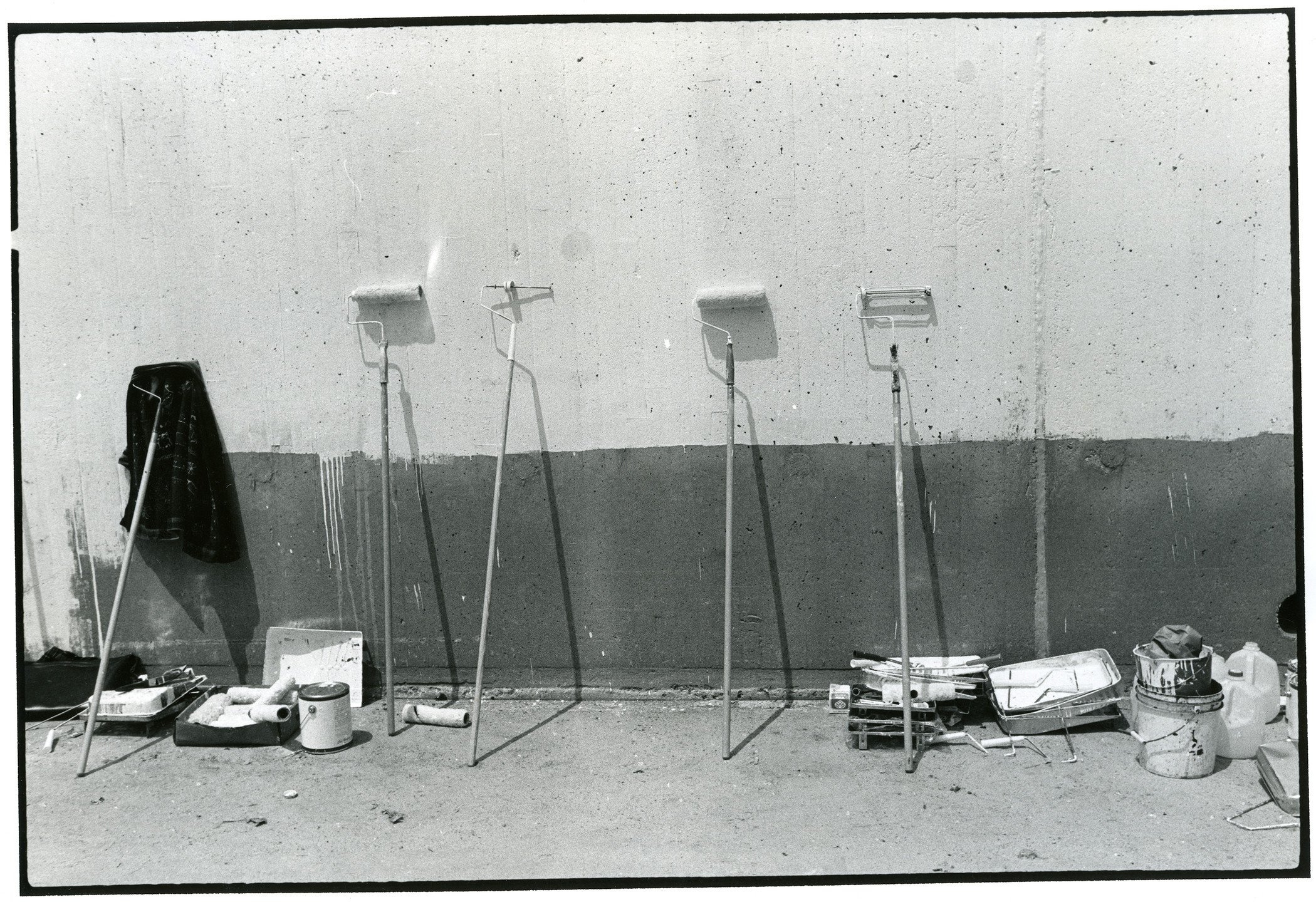
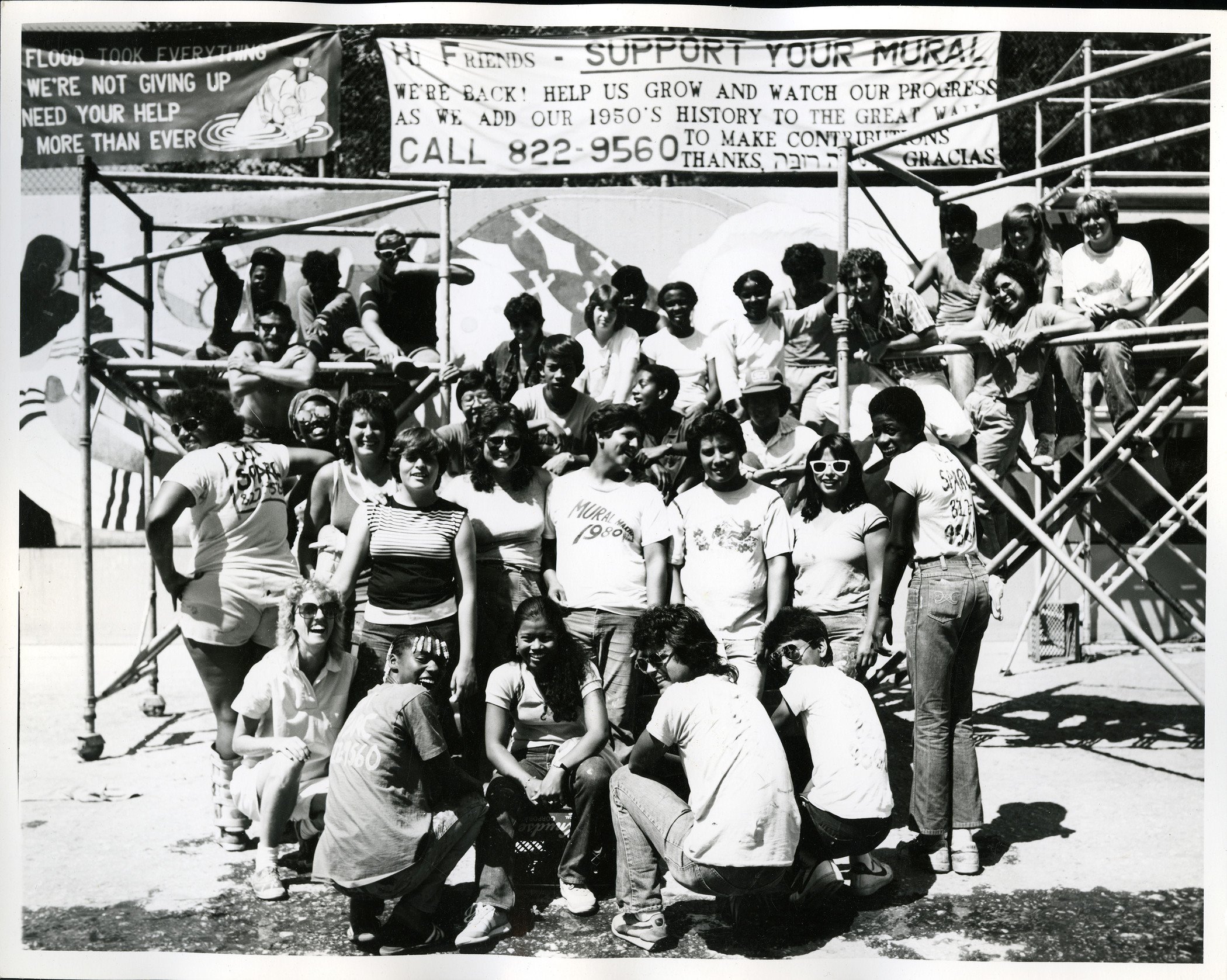
“Fifty years ago, Judy Baca began painting in the L.A. River to share communities' unreported perspectives, effectively shouting from the gutter of history,” said Dhyandra Lawson. “Her impact in L.A. and on the history of art and muralism are immeasurable. We are honored to work with Judy and SPARC artists on this unprecedented project, illuminating her vision for a people’s monument she now expands into the present.”
Deliasofia Zacarias added, “Baca is revered for many career-long achievements that have expanded public access to art and art education. At LACMA, she continues this commitment by allowing museum audiences to witness her work in real time, thereby challenging traditional distinctions between public and private space, as well as public and private practice.”
“LACMA’s galleries will transform into an active art studio, where audiences will be able to witness Judy Baca and her team paint new murals of The Great Wall of Los Angeles before they are permanently installed on the banks of the L.A. River,” said Michael Govan, LACMA CEO and Wallis Annenberg Director. “Baca’s work reexamines history, monumental painting, and representation of Los Angeles and its communities.
Judy Baca painting The Great Wall of Los Angeles, summer of 1983, photo courtesy of the SPARC Archives (SPARCinLA.org)
Painting in the River of Angels is a testament to artistic legacy and the power of visual storytelling in amplifying diverse voices.” About Judy Baca As one of America’s leading visual artists, Dr. Judy Baca has created public art for four decades. In 1974, Baca founded the City of Los Angeles’s first mural program, which produced over 400 murals, employed thousands of local participants, and evolved into an arts organization—the Social and Public Art Resource Center (SPARC). She continues to serve as SPARC’s artistic director while promoting social justice and participatory public art projects. Her best-known work is The Great Wall of Los Angeles. Located in the San Fernando Valley, the mural spans half a mile and is still a work in progress that is engaging another generation of youth. The mural making process has exemplified community involvement, employing more than 400 youth and their families from diverse social and economic backgrounds, artists, oral historians, and scholars. In 2017 The Great Wall of Los Angeles received national recognition on the National Registry of Historic Places by the U.S. Department of the Interior. Baca is a recipient of the Guggenheim Fellowship, the United States Artist Rockefeller Fellowship, and the Mellon Foundation Grant for the expansion of The Great Wall. Most recently, she was honored with the 2021 National Medal of Arts. Baca makes art shaped by an interactive relationship of history, people, and place. Her public artworks focus on revealing and reconciling peoples’ struggles for their rights and affirming the community’s connections to place. Together, she co-creates “sites of public memory.”
On November 4, 2023, Baca was honored alongside filmmaker David Fincher at the 2023 Art+Film Gala, presented by Gucci.
Background
LACMA has a history of presenting exhibitions highlighting local Latine and Chicane artists dating to the 1970s, when the museum organized Los Four: Almaraz, de la Rocha, Lujan, Romero (February 26–April 7, 1974), a history-making exhibition that established LACMA as the first mainstream museum to recognize the importance of Chicano Art as a unique school of American art. In the following decades, LACMA presented exhibitions including Hispanic Art in the United States: Thirty Contemporary Painters and Sculptors (February 5–April 16, 1989), considered the first major museum exhibition to survey in depth the work of contemporary American artists of Hispanic origin. Over the past 15 years, LACMA has continued its commitment to collecting, exhibiting, and interpreting work by Latine, Chicanx, and Latin American artists across generations, mediums, and subjects to better reflect the diverse community it serves. Notable exhibitions include Phantom Sightings: Art after the Chicano Movement (2008); Asco: Elite of the Obscure, A Retrospective, 1972– 1987 (2011); Under the Mexican Sky: Gabriel Figueroa – Art and Film (2013); Picasso and Rivera: Conversations Across Time (2016-2017); Playing with Fire: Paintings by Carlos Almaraz (2017); Alejandro G. Iñárritu: CARNE y ARENA (Virtually present, Physically invisible) (2017–18); Rufino Tamayo: Innovation and Experimentation (2019-2020); Luchita Hurtado: I Live I Die I Will Be Reborn (2020); Carmen Herrera: Estructura Verde (2021–22); Mixpantli: Contemporary Echoes (2021–22), among others. On view November 12, 2023–August 11, 2024, Vincent Valdez and Ry Cooder: El Chavez Ravine will explore Valdez’s oil painting on a 1953 Chevrolet ice cream truck portraying the forced removal of a predominantly Mexican American community in preparation for the construction of Dodger Stadium in the late 1950s. Recently acquired by LACMA, the work draws from the style and history of Mexican muralism and Chicano car culture, and serves as a mobile monument to a living chapter in the history of Los Angeles. Credit This exhibition is organized by the Los Angeles County Museum of Art. Major support provided by The Claire Falkenstein Foundation and the Mellon Foundation. Generous support provided by Fabian Newton Family, Carmela and Miguel Koenig, Cheryl Gora, and an anonymous donor Premier sponsorship provided by Snapchat All exhibitions at LACMA are underwritten by the LACMA Exhibition Fund. Major annual support is provided by The David & Meredith Kaplan Foundation, with generous annual funding from Louise and Brad Edgerton, Edgerton Foundation, Mary and Daniel James, Justin Lubliner, Alfred E. Mann Charities, Kelsey Lee Offield, Koni and Geoff Rich, Lenore and Richard Wayne, and Marietta Wu and Thomas Yamamoto. Painting in the River of Angels: Judy Baca and The Great Wall was organized by the Los Angeles County Museum of Art.
About LACMA
Located on the Pacific Rim, LACMA is the largest art museum in the western United States, with a collection of nearly 152,000 objects that illuminate 6,000 years of artistic expression across the globe. Committed to showcasing a multitude of art histories, LACMA exhibits and interprets works of art from new and unexpected points of view that are informed by the region’s rich cultural heritage and diverse population. LACMA’s spirit of experimentation is reflected in its work with artists, technologists, and thought leaders, as well as in its regional, national, and global partnerships to share collections and programs, create pioneering initiatives, and engage new audiences. Location: 5905 Wilshire Boulevard, Los Angeles, CA 900036.
The exhibition opened on October 26, 2023 and will closed on June 2, 2024, it is located at the Resnick Pavilion.
For more information about this exhibit, along with other exhibits and the LACMA, please visit their site. The museum can also be found on Instagram, Facebook, You Tube.
Boren Banner Series: Rafael Soldi
Photo: Jueqian Fang
Presented in conjunction with the exhibition Rafael Soldi: Soft Boy, this iteration of the Boren Banner Series features an image from the artist’s new body of work, Mientras el cielo gire (As long as the sky whirls). The project is based on Soldi’s research into the Peruvian Havana Embassy Crisis of 1980 and the ensuing Mariel Boatlift, a massive flotilla of private vessels that brought 125,000 Cuban refugees to the United States and a thousand to the artist’s native Peru. At the time, homosexuality was criminalized in Cuba, punishable by imprisonment and hard labor. An estimated 20,000 of those who fled the country in 1980 were gay.
Installation view of Rafael Soldi: Soft Boy, Frye Art Museum, Seattle, October 7, 2023–January 7, 2024. Photo: Jueqian Fang
Soldi’s interest in the historic event developed out of the inadvertent role his homeland played, he says,“as a gateway to queer liberation, despite its long history with homophobia.” The banner image is drawn from one of many photographs taken by the artist at newspaper archives in Lima.
By abstracting his subject through cropping and enlargement, Soldi aims to “transform an ostensibly neutral journalistic account into one laden with suggestion and desire, with a gaze toward a queer body veiled in the chaos of mass exile.”
Installation view of Rafael Soldi: Soft Boy, Frye Art Museum, Seattle, October 7, 2023–January 7, 2024. Photo: Jueqian Fang
The series title comes from a poem Reinaldo Arenas (1943–1990) wrote to his lover in New York City, after he escaped Cuba and shortly before he contracted HIV.
CARGAMONTÓN, 2022. Aquatint photogravure. 27 1/2 x 34 in. Courtesy of the artist
For Soldi, the project centers on personal queer narratives like Areanas’s that stream below the surface of public accounts: the real people for whom, as Areanas writes in his memoir, "there’s just one place to live—the impossible."

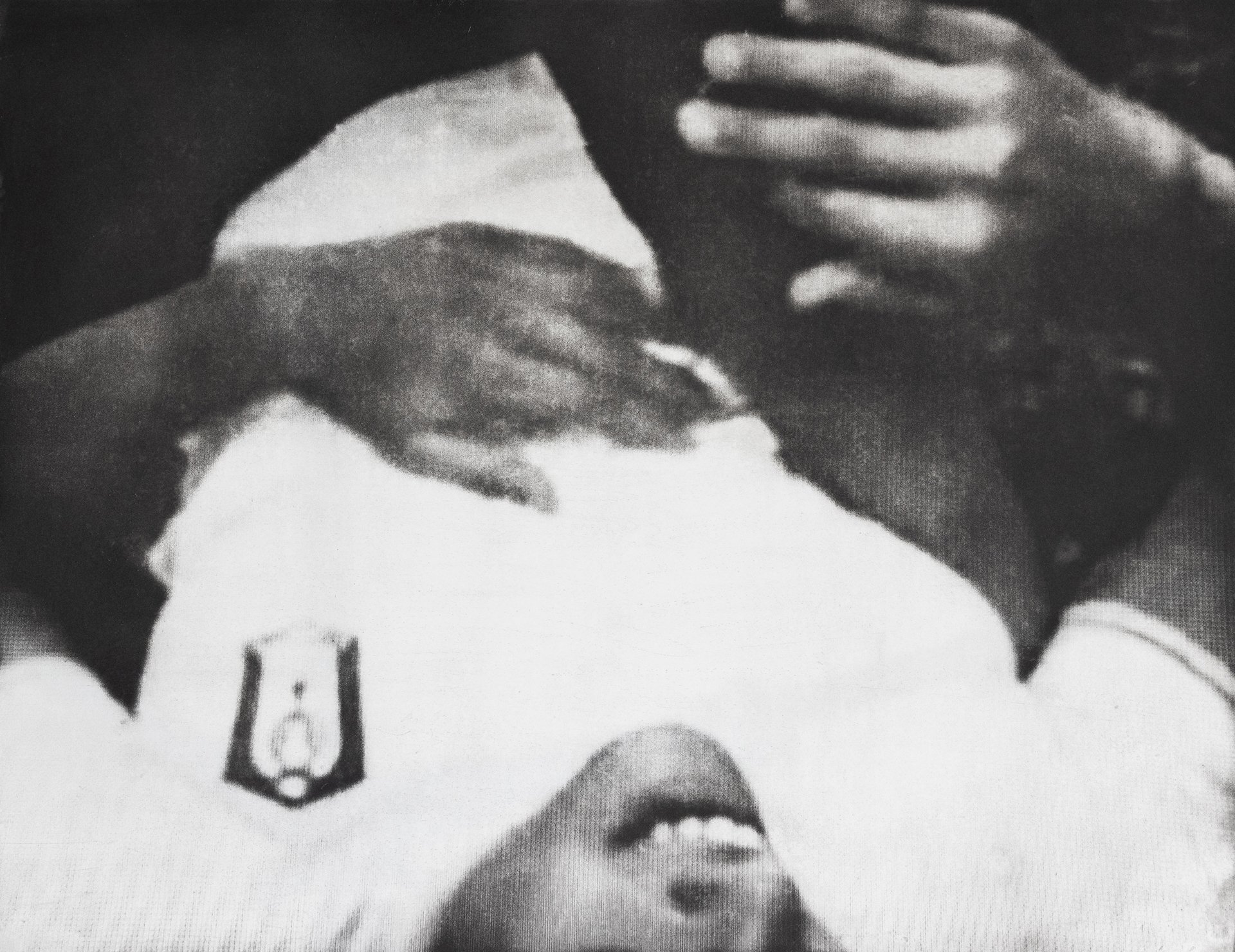
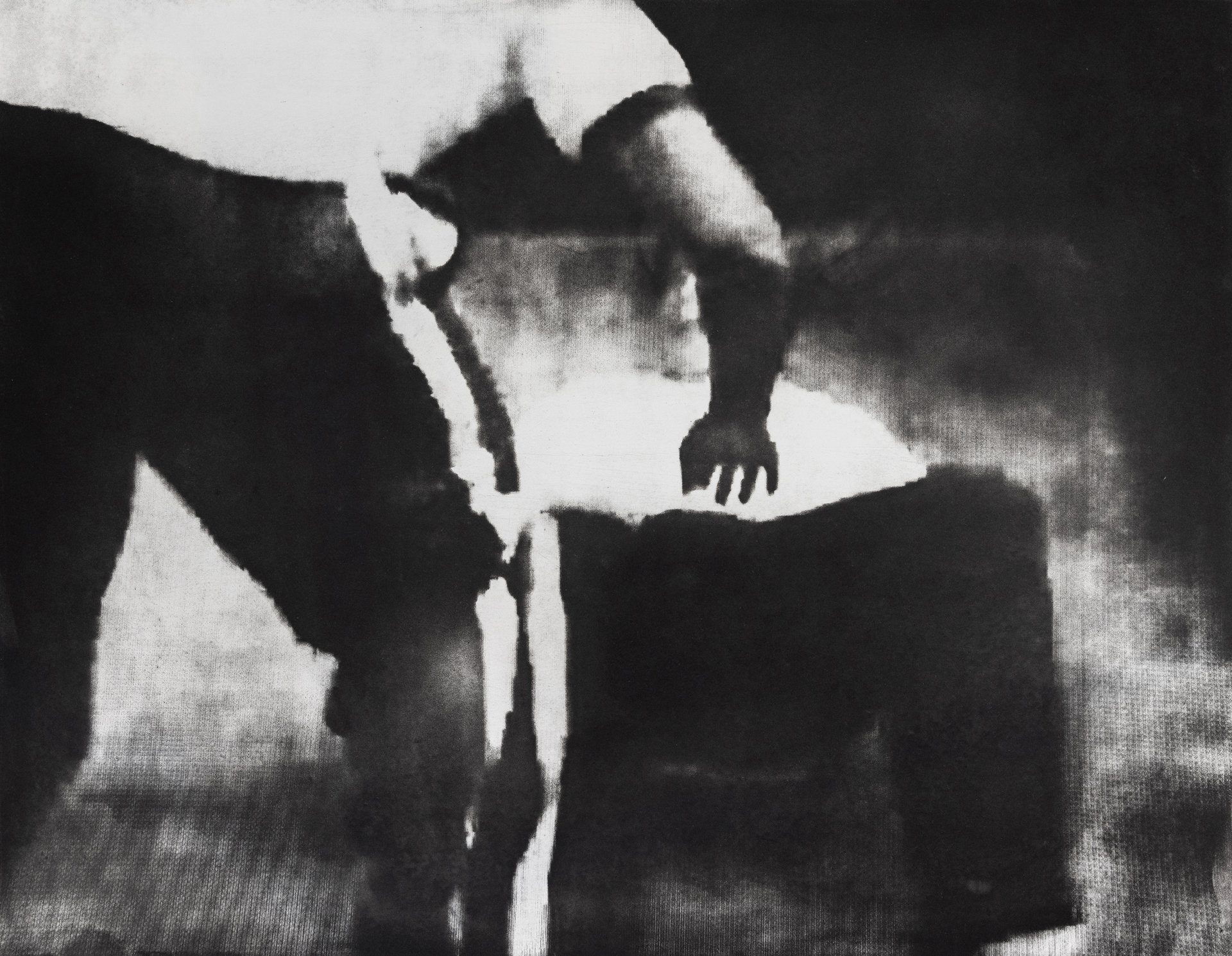
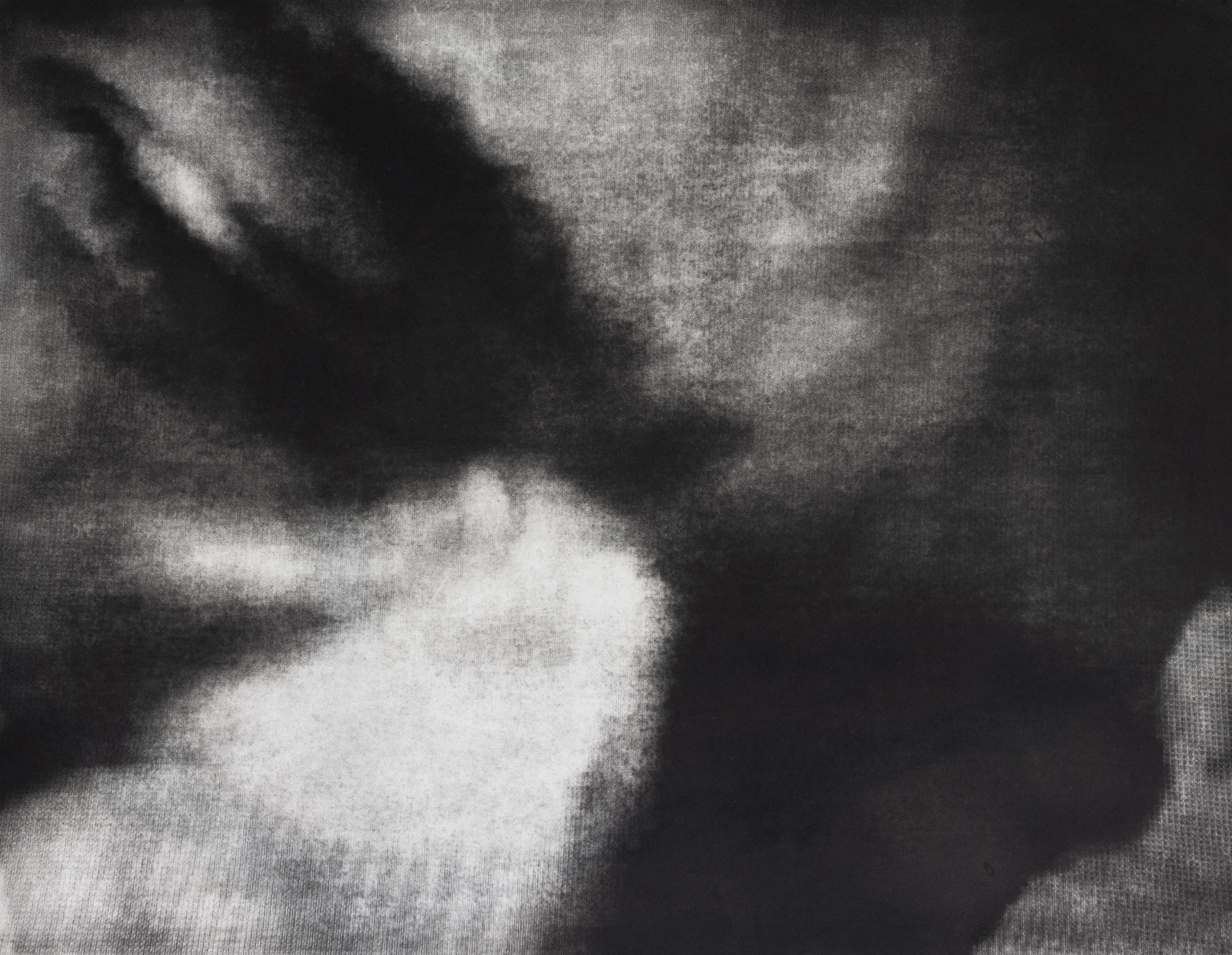
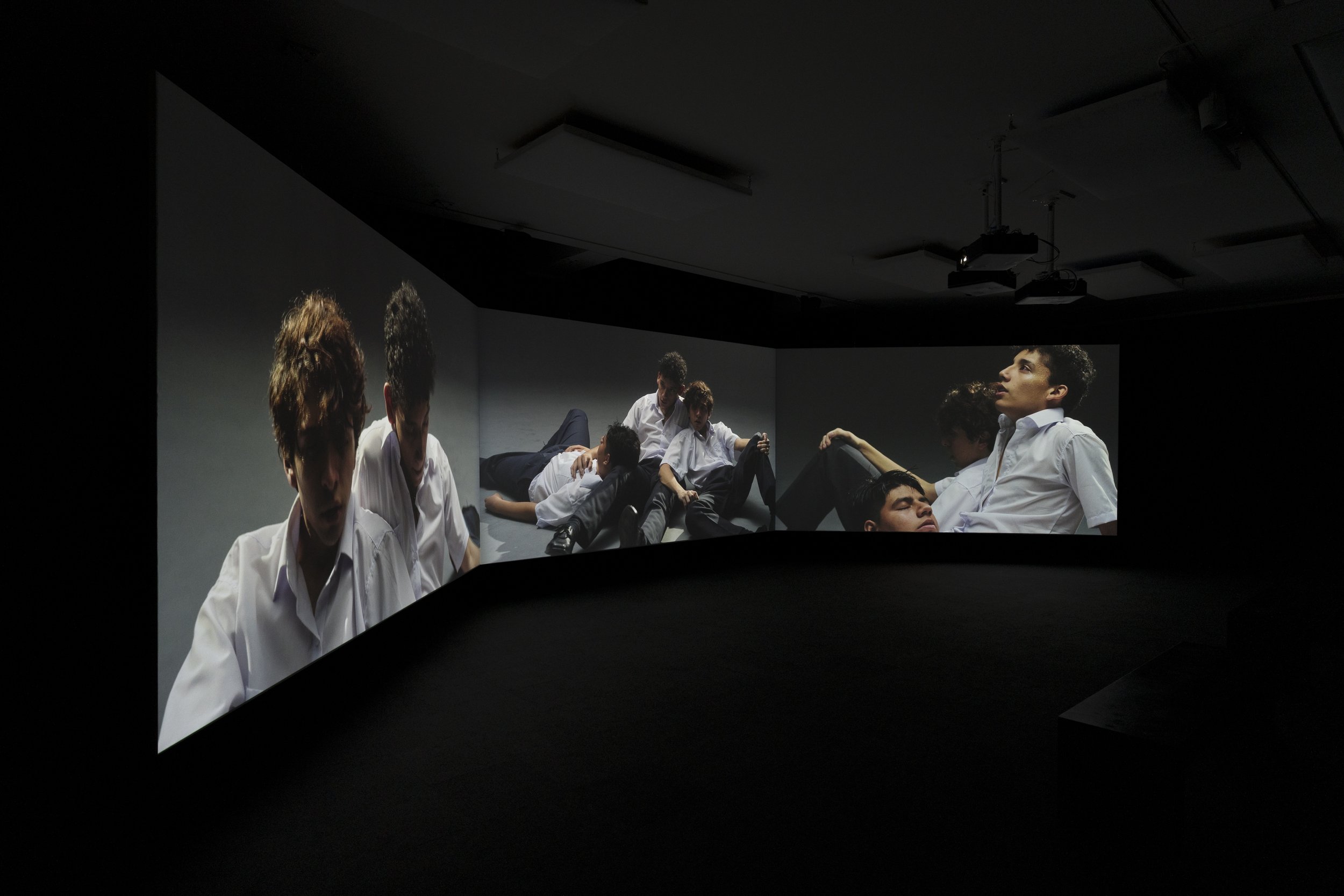
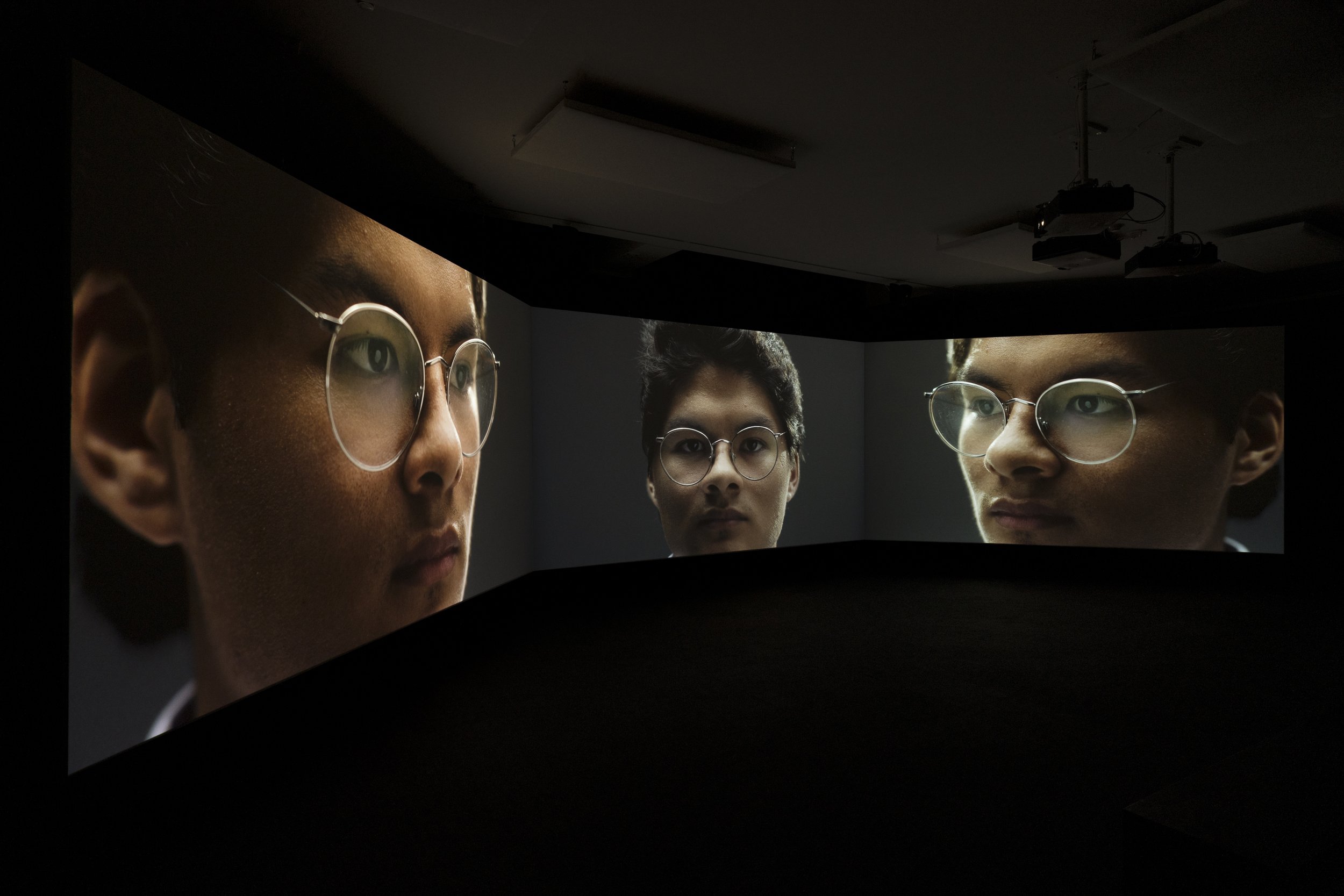
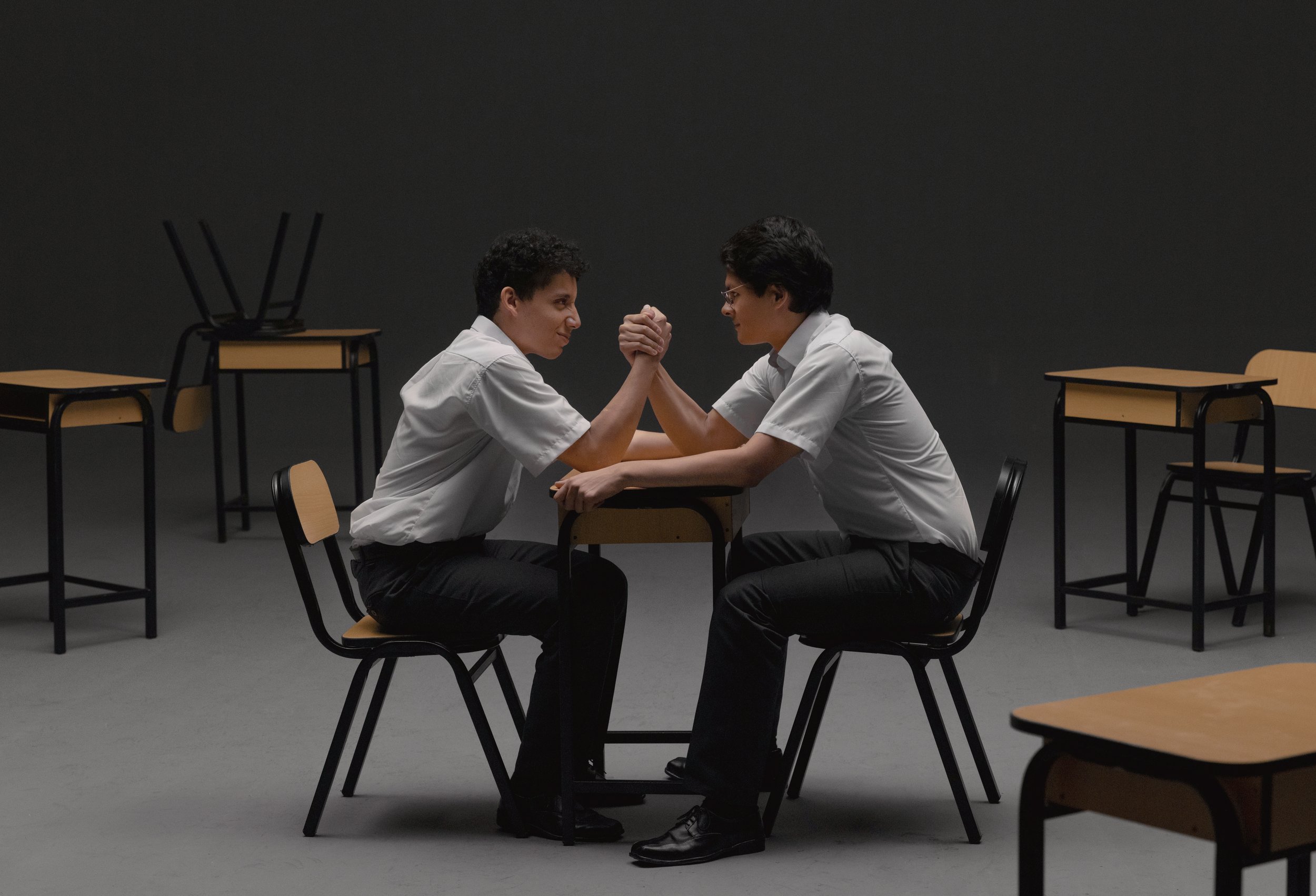

Installation view of Rafael Soldi: Soft Boy, Frye Art Museum, Seattle, October 7, 2023–January 7, 2024. Photo: Jueqian Fang
ABOUT THE BOREN BANNER SERIES
The Boren Banner Series is a public art initiative by the Frye Art Museum that reflects the museum’s commitment to showcasing work by Pacific Northwest artists. Presented biannually, the series gives regional artists the opportunity to create new site-specific work or show a previously unexhibited piece as a monumental, 16 x 20 ft. vinyl banner. The billboard-size work is prominently sited facing Boren Avenue, the Frye’s most visible and accessible physical interface.
Boren Banner Series: Rafael Soldi is organized by Amanda Donnan, Chief Curator and Director of Exhibitions.
Generous support provided by 4Culture/King County Lodging Tax, the Frye Foundation, and Frye Members.
This exhibition opened on October 7, 2023, and will conclude on April 7, 2024. Please visit their website here for more information about this exhibition and others at the Frye Museum. The museum can also be found on Facebook, Youtube, and Instagram.
THE END OF FOSSIL FUEL
Installation View, THE END OF FOSSIL FUEL, the Climate Museum NYC., Photo Credit: Sari Goodfriend
New York, NY The Climate Museum, the first museum in the nation dedicated to climate change, has opened its latest exhibition in SoHo, THE END OF FOSSIL FUEL. Located at 105 Wooster Street in Manhattan, the show features exhibits that educate visitors about the fossil fuel industry and the intertwined histories of inequality and the climate crisis, and that invite visitors to connect and take action.
Installation View, THE END OF FOSSIL FUEL, the Climate Museum NYC., Photo Credit: Sari Goodfriend
The exhibition’s lead artist is R. Gregory Christie, a celebrated illustrator who is an NAACP Image Award winner, a six-time Coretta Scott King Honor recipient, and a Caldecott Honor winner. The show features Christie’s 45-foot mural Making Tomorrow, which envisions the struggle for, and transition to, climate justice.
In addition to the artwork by Christie, the exhibition includes:
A series of exhibits that dive into the origins of the fossil fuel industry and its creation and exploitation of racially defined sacrifice zones and aggressive use of deception, on one hand, and inspiring subjects like the remarkable history of the environmental and climate justice movement and the existence of a (currently silent) supermajority for climate justice in the US, on the other;
Interactive maps of New York City, the U.S., and the world visualizing the connections between the climate crisis and social inequality;
A sticker wall where visitors commit to specific climate actions—creating a vibrant community-built installation that builds collective momentum for addressing both the climate crisis and the inequalities with which it is bound up;
A station where visitors can write postcards that the Museum mails and reflections they share on a large visitor reflection wall;
A children’s activity station with books about climate justice and materials to draw an imagined future; and
A reading corner for adults with a selection of books and articles on the climate crisis, the fossil fuel industry, and the climate justice movement.
“This exhibition explores how the fossil fuel industry manages to keep making a killing off of killing us, and what we can do about it,” said Miranda Massie, Founder and Director of the Climate Museum. “We can’t address the crisis of climate change without also addressing the deep-seated social and racial inequities that underpin it. This exhibition encompasses both the hard truths that we must confront, as well as the astonishing victories won by climate justice communities and leaders fighting for social equality and clean energy together.”
“I hope that my work for this exhibition can help visitors see the connections between our society’s social justice crisis and the ecological and climate crisis, get involved in ongoing work to move us forward, and envision the bright future we can all share,” said muralist R. Gregory Christie “It was inspiring to collaborate with the Museum team on this commission.”
“Climate art like Greg’s remarkable mural inspires powerful emotional reactions in visitors. We’ve repeatedly seen the power of the arts as a pathway into climate engagement. Making Tomorrow opens visitors up to reflect, connect, and take action on climate, satisfying an intense, mostly unmet public appetite,” Massie added.
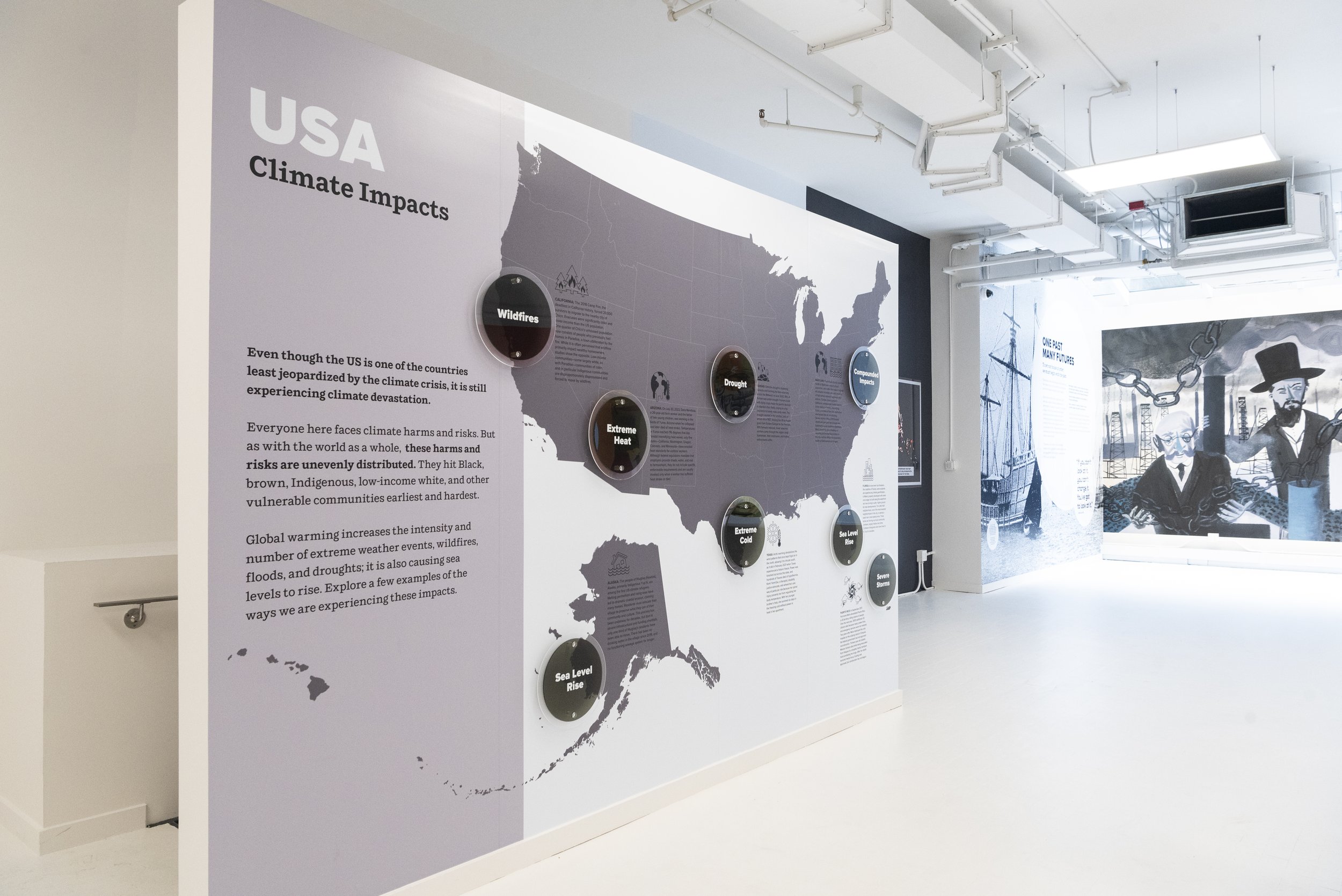
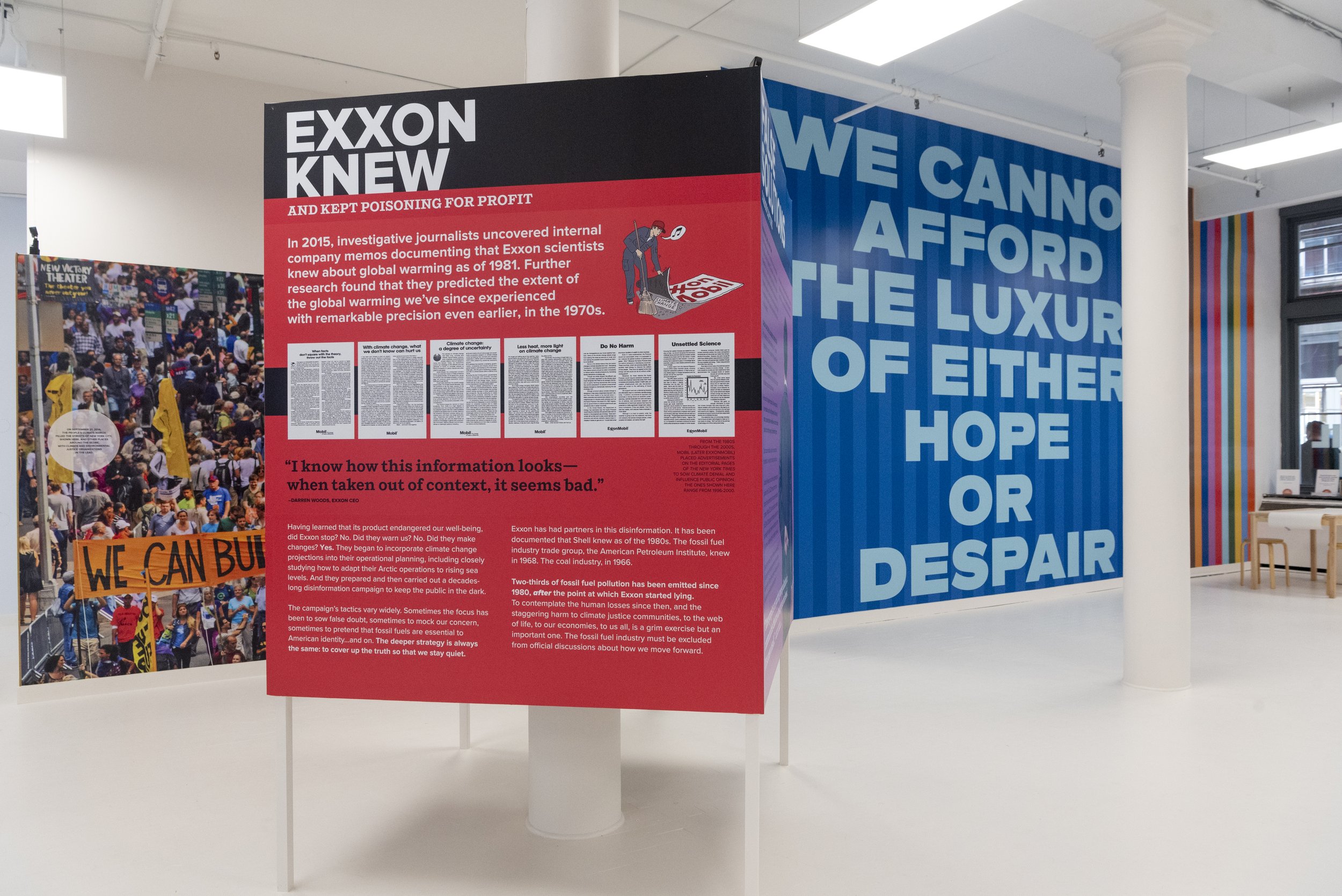
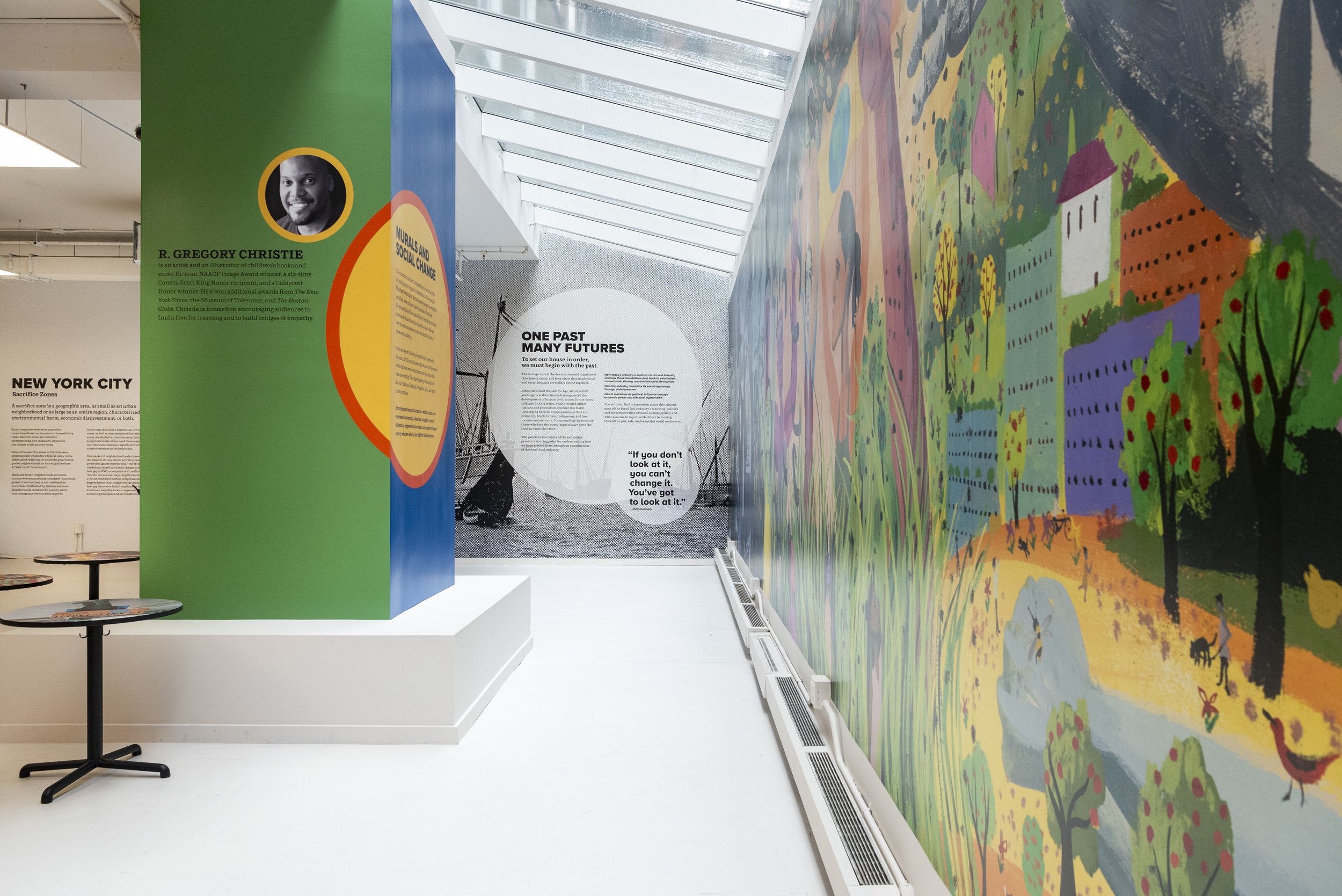
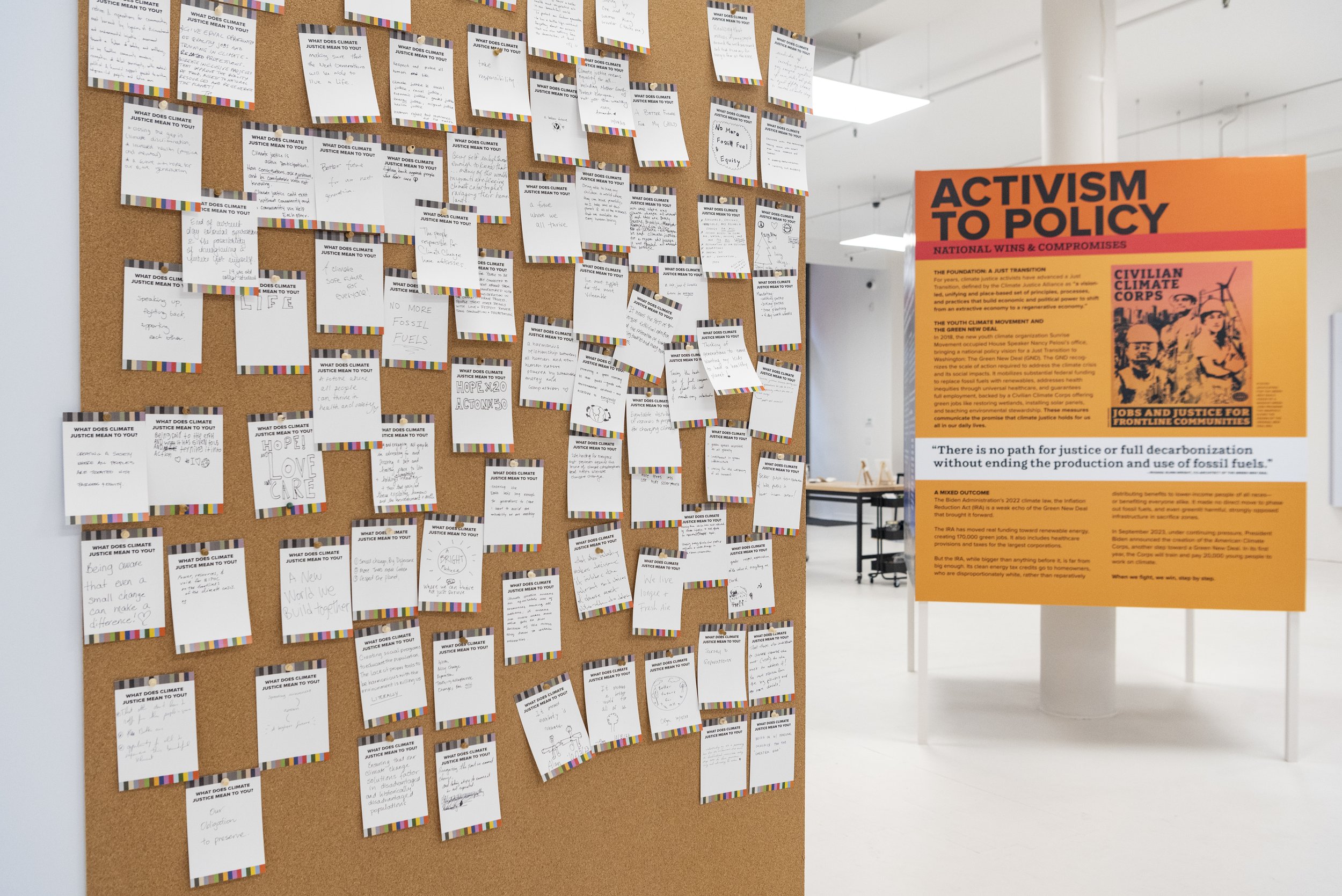
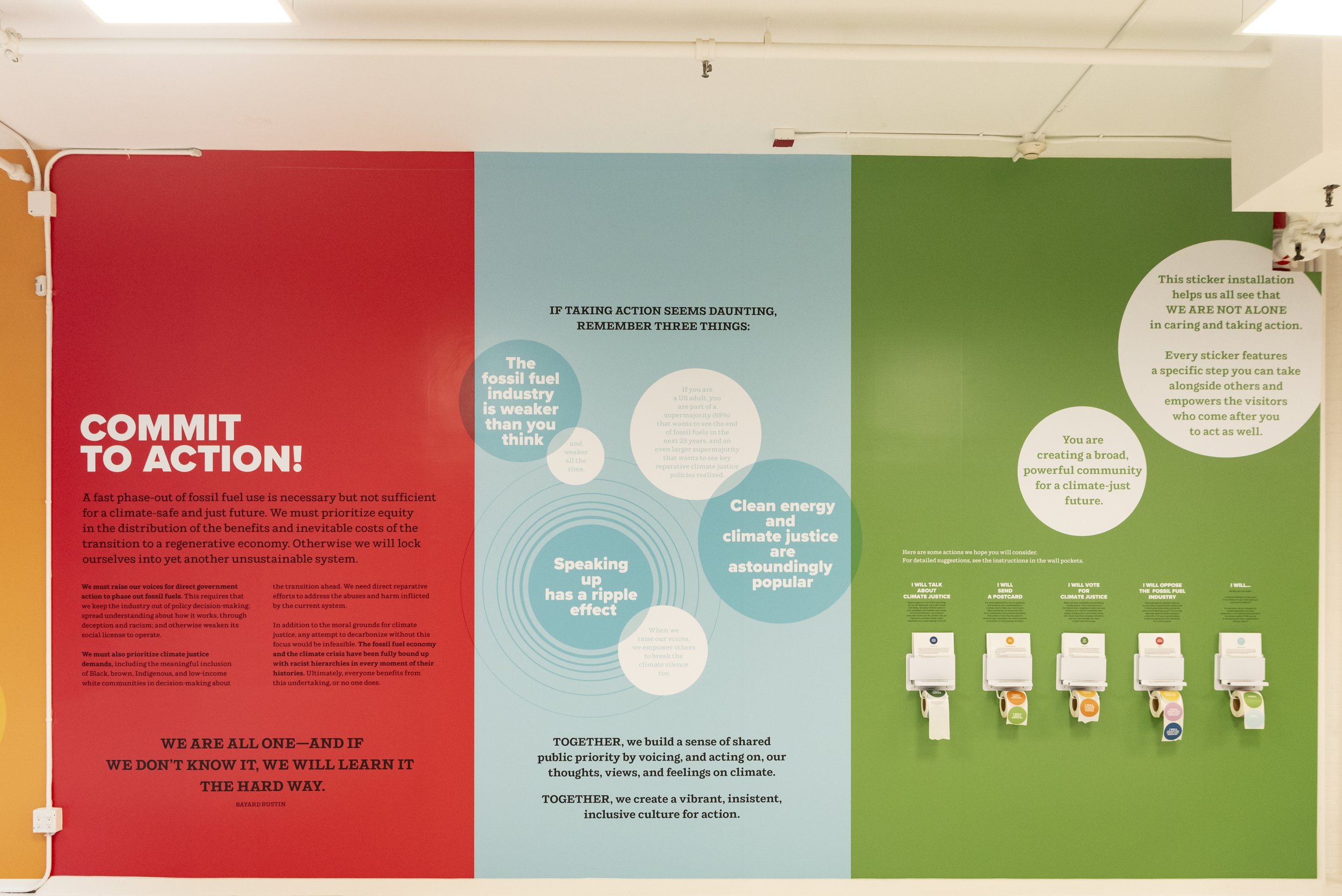
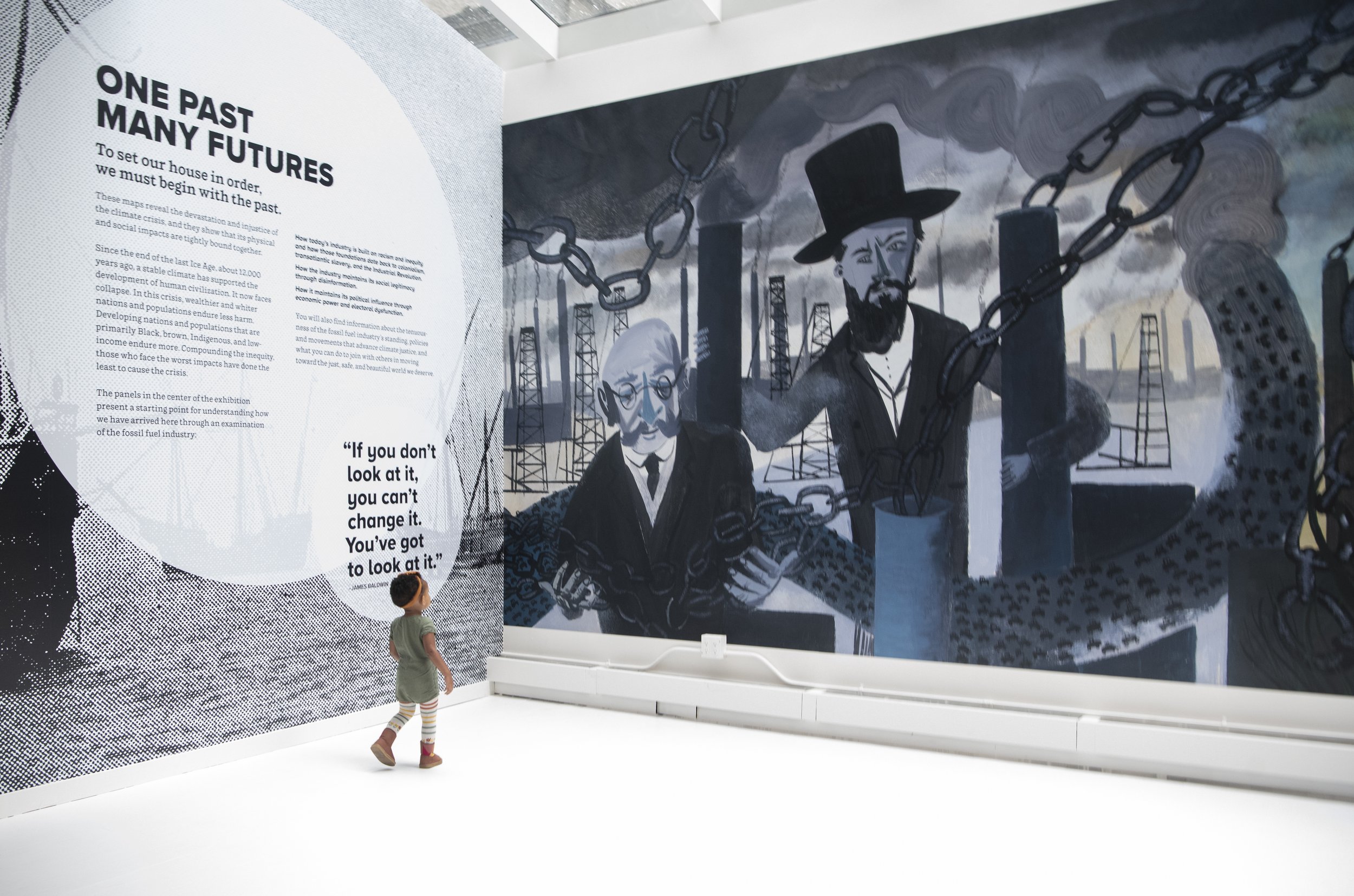
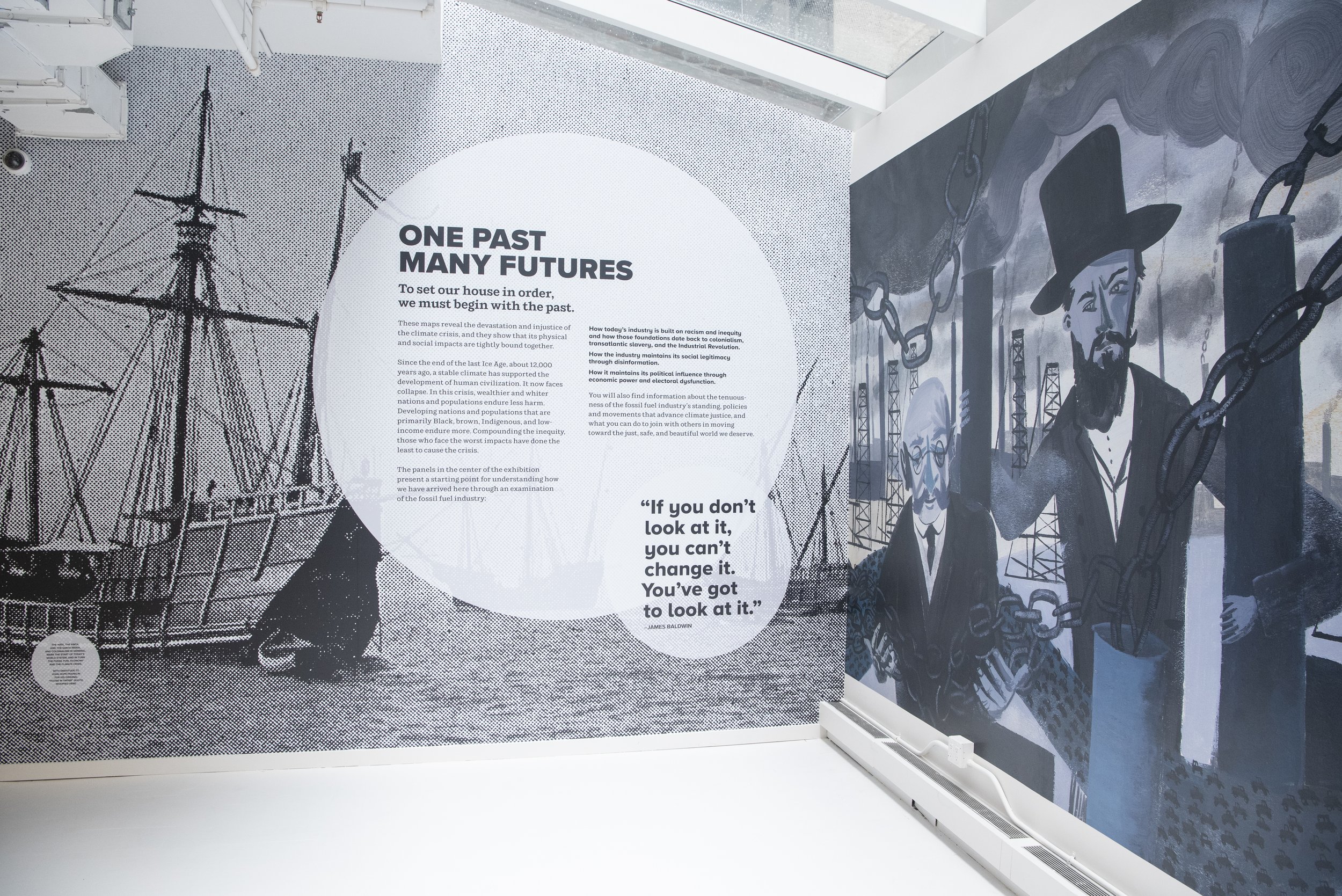

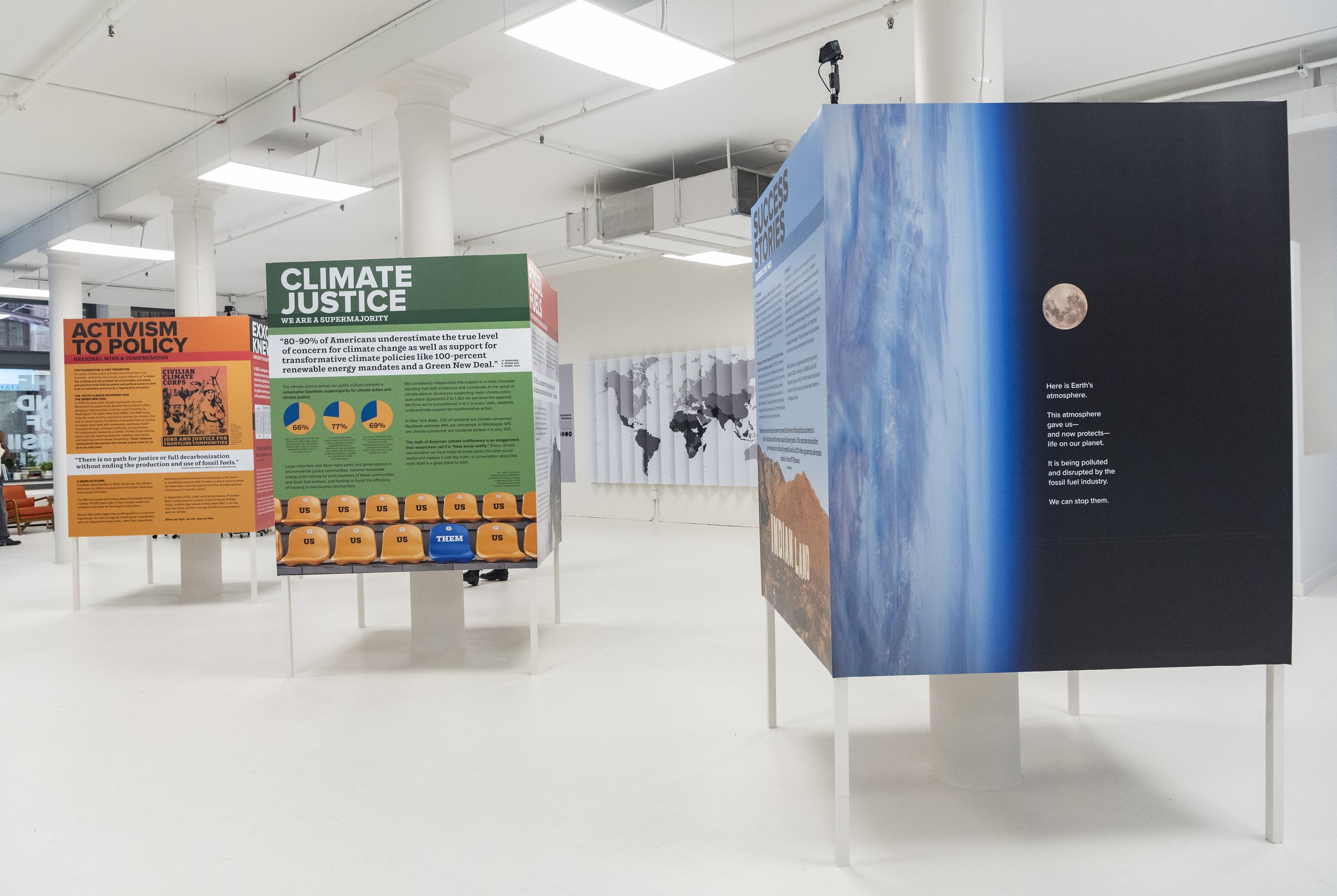
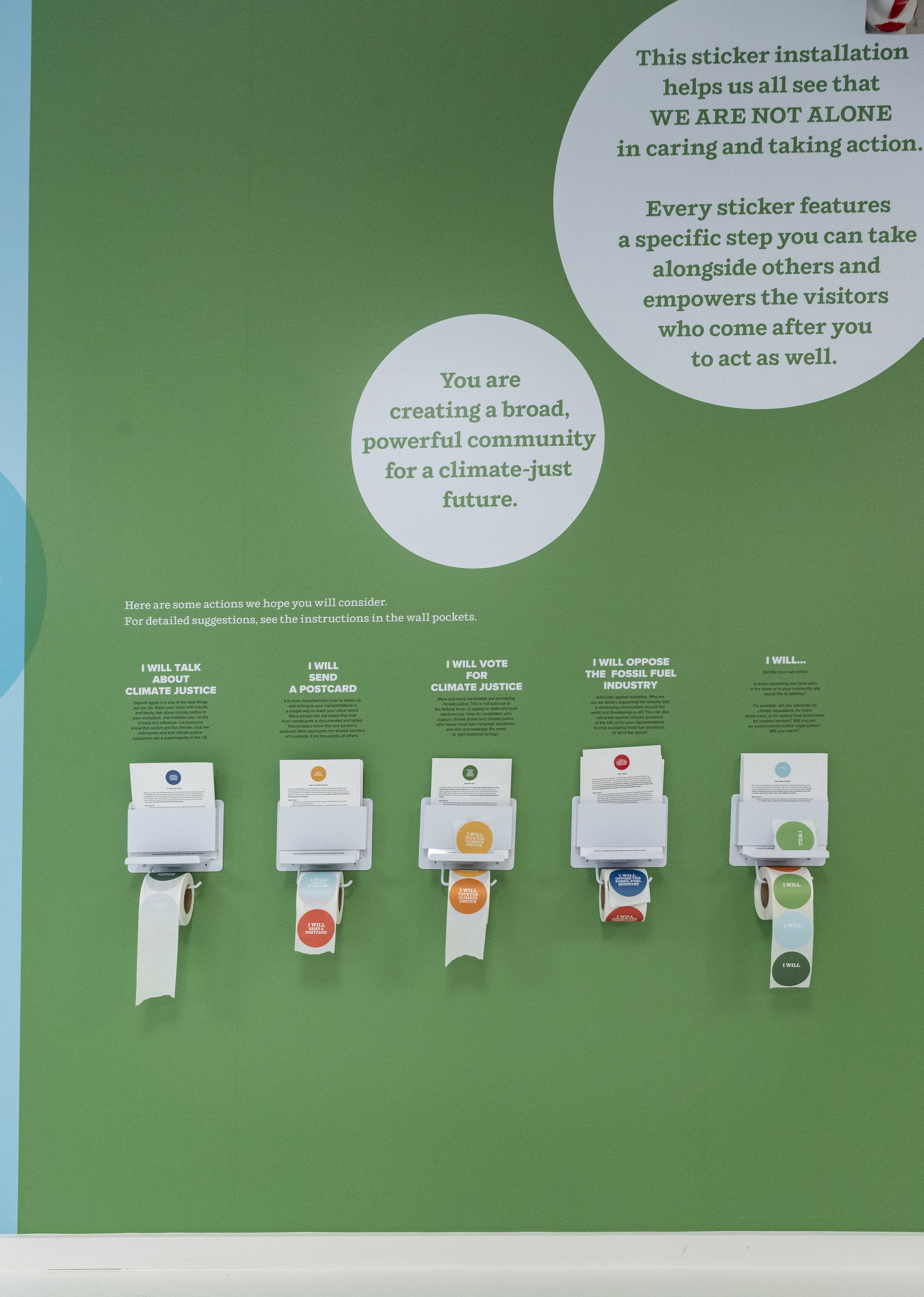
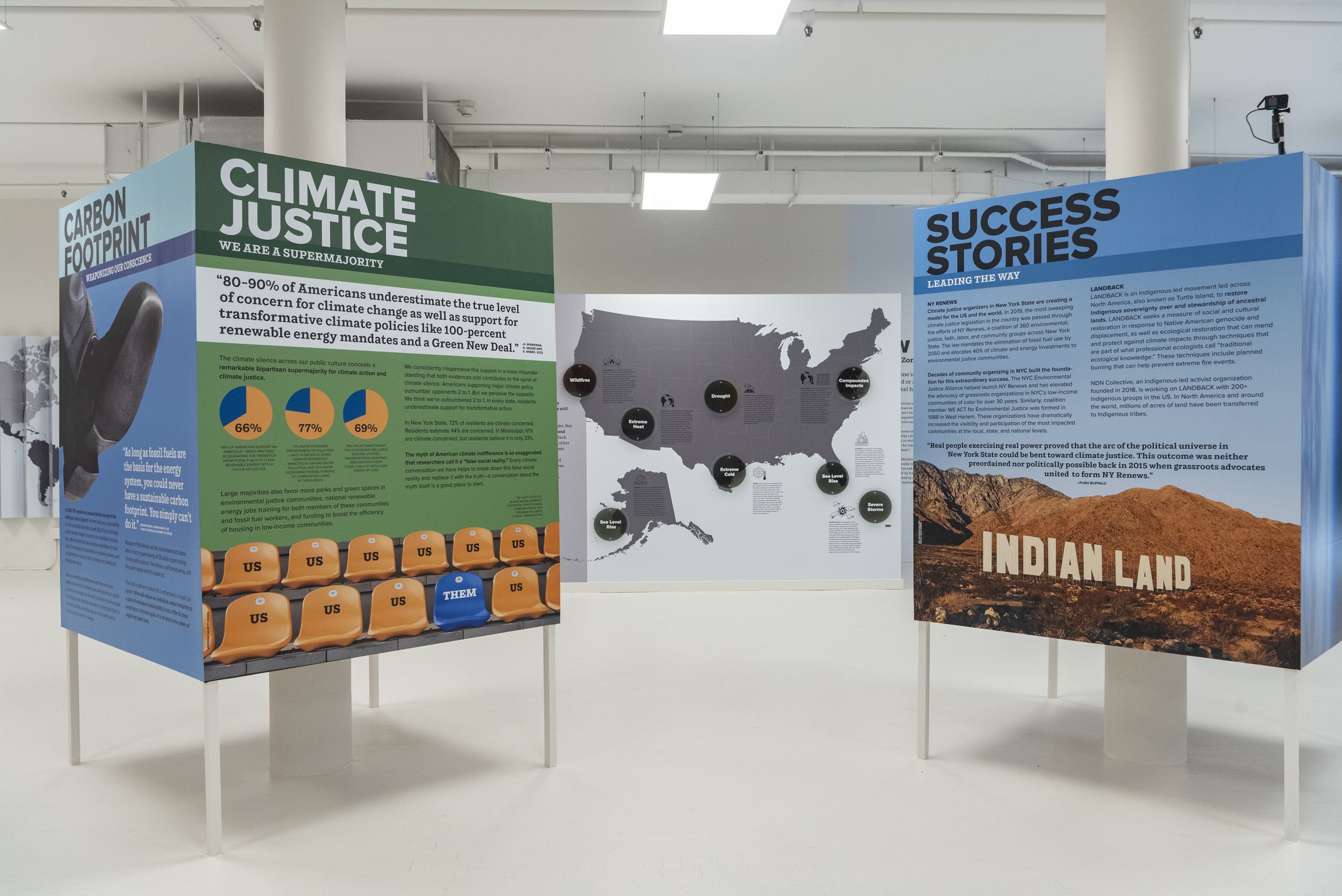
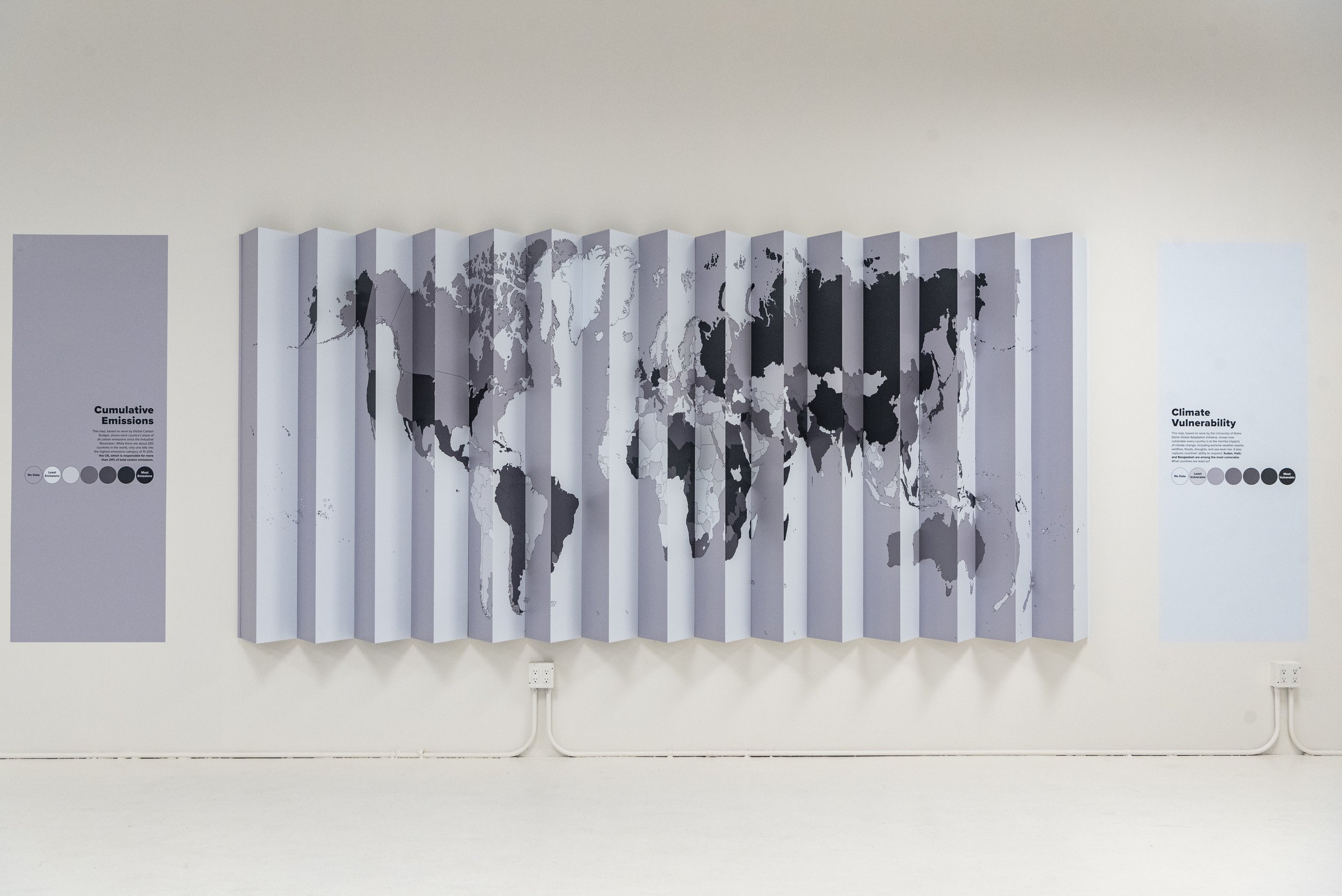
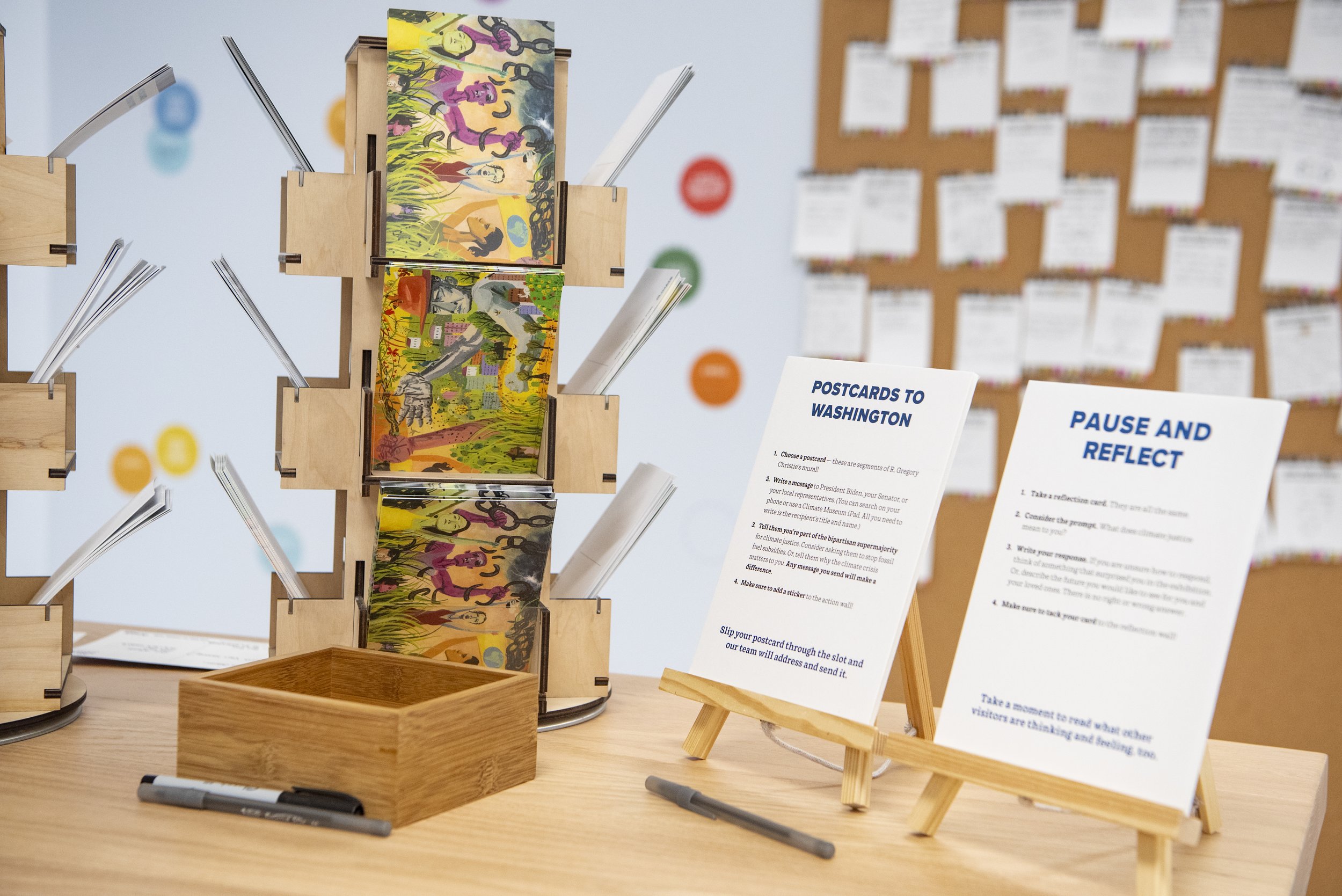
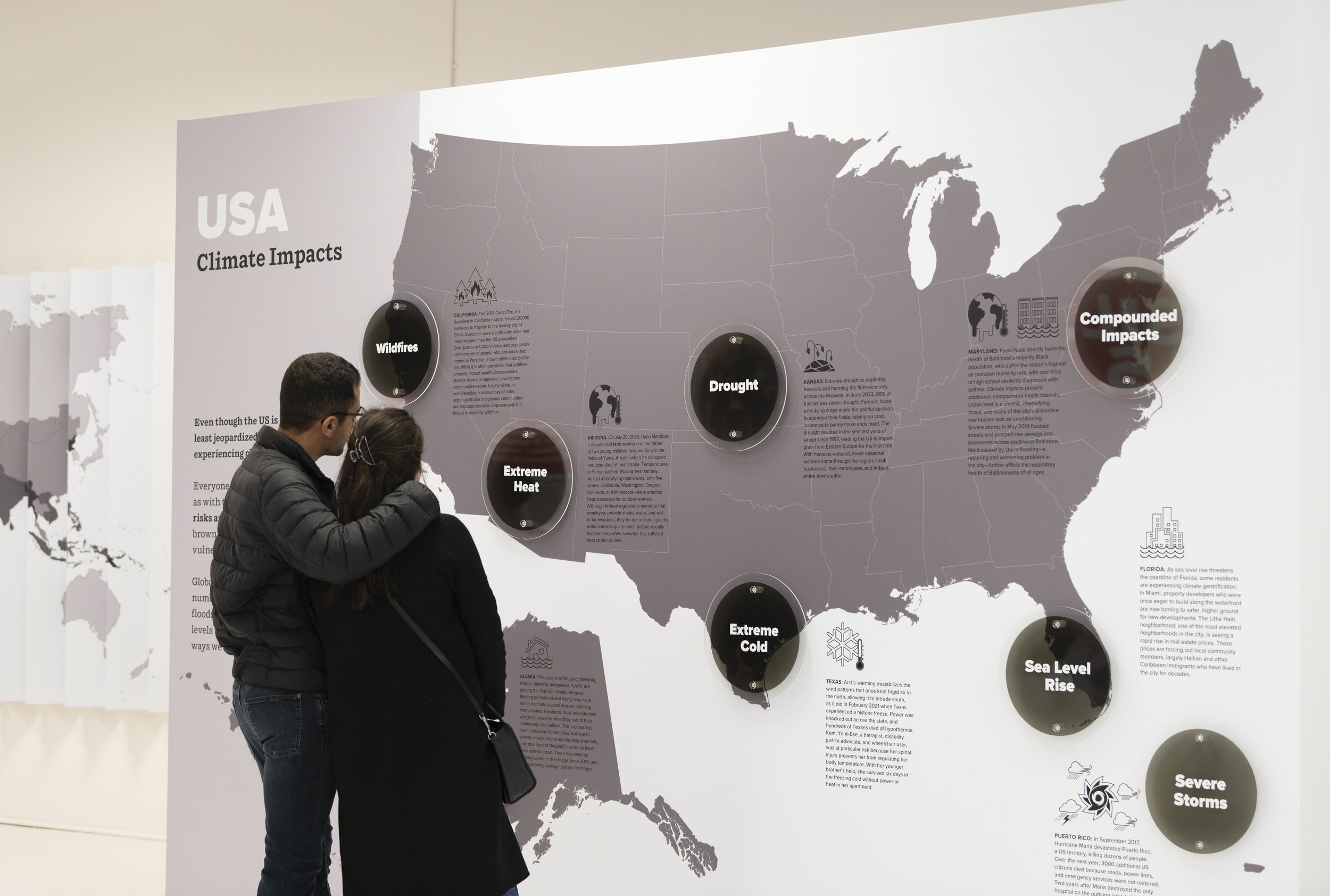
Installation View, THE END OF FOSSIL FUEL, the Climate Museum NYC., Photo Credit: Sari Goodfriend
The Climate Museum has presented public programs and exhibitions since 2018 and recently launched an initiative to scale up to a year-round, transit-accessible location. Its last exhibition in SoHo, which concluded in April 2023, examined and debunked the myth of our society’s indifference toward the climate crisis, debuting David Opdyke’s postcard mural Someday, all this, which offered a bracing commentary on the impact of the climate crisis on the American landscape, both real and imagined. It also included a climate action incubator where visitors could share their reflections on research about the myth of American climate indifference, a sticker wall, and a station to send postcards to public officials to encourage them to take action on the climate crisis.
Courtesy of the Climate Museum NYC
About The Climate Museum
The Climate Museum is the first museum in the United States dedicated to climate change. The Museum mobilizes the power of arts and cultural programming to invite visitors into climate engagement and agency and to transform our public culture for action at scale. The Museum offers free, interdisciplinary, participatory programs that connect constituents to a culture for climate action with a focus on justice, including exhibitions and installations, pop-ups, youth programs, interactive dialogue events, performances, workshops, and more.
The exhibition opened on October 7, 2023, and will welcome visitors through April 28, 2024. Admission is free and open to the public, between the hours of 1 pm to 6 pm, Wednesday through Sunday. During the run of the show, the Museum will also present free public programs, youth programs, community events, and more.
The show examines the fossil fuel industry’s racism and deception and how we can move together toward climate justice.
Follow the Climate Museum on Instagram, X, LinkedIn, and Facebook, and visit its website.
HOPE
AbuQadim Haqq, Museion Wormhole, 2023. Courtesy / © the artist
On September 30, 2023, Museion in Bolzano, Italy, presented HOPE, an international group exhibition exploring spaces of hope between science and fiction, curated by Bart van der Heide and Leonie Radine in collaboration with musician, theorist, and writer DeForrest Brown, Jr. As the final installment of the TECHNO HUMANITIES trilogy, HOPE probes the close alliance between museums and the humanities as sites of active world-building. The exhibition, which occupies the entirety of the museum, includes works from an intergenerational cohort of artists. It is further supported by an anthology of newly commissioned critical texts as well as a rich mediation and event program. The exhibit will close on the 25th of February of this year.
Ever since opening its doors exactly 15 years ago, the Museion building has been repeatedly described as alien, a UFO that landed in the center of Bolzano. HOPE endorses the view of the museum as a spaceship, a time capsule, a portal to another dimension. The exhibition will transform Museion into a production site of wonder, merging science and fiction to evoke hope through individual and collective imaginations of futures and pasts. As Philosopher Ernst Bloch wrote in the introduction of his Principle of Hope (1954): “We need the most powerful telescope, that of polished utopian consciousness,” to penetrate the darkness.
AbuQuadim Haqq, Orbital Satellite Workers, 2023. Courtesy / © the artist
Ever since opening its doors exactly 15 years ago, the Museion building has been repeatedly described as alien, a UFO that landed in the center of Bolzano. HOPE endorses the view of the museum as a spaceship, a time capsule, a portal to another dimension. The exhibition will transform Museion into a production site of wonder, merging science and fiction to evoke hope through individual and collective imaginations of futures and pasts. As Philosopher Ernst Bloch wrote in the introduction of his Principle of Hope (1954): “We need the most powerful telescope, that of polished utopian consciousness,” to penetrate the darkness.
AbuQadim Haqq, Leo Rodrigues, and Hector Rubilar, Timeline of the Black Technology, 2021. Courtesy the artists.
HOPE invites visitors to move between real and imagined spaces and times to try on alternative viewpoints. The exhibition architecture suggests an upside-down, non-linear path through the building, leading first to the fourth floor, which showcases various artistic time capsules in an observatory-like setting. By proceeding through individual and collective artistic cosmologies, the self and the other are open for exploration beyond a humancentric worldview. Here, the selection of artworks creates a sci-fi atmosphere between apocalyptic scenarios and new beginnings at the intersection of the humanities, technology, ecology, and economy.
Artists exhibiting on the third floor interrogate new tools and challenges in the era of artificial intelligence and other forms of digital worldbuilding. Their arcade-like installations create immersive spaces of imagination between the virtual and the real, memory and forgetting.
The second floor houses an archive dedicated to the Afrofuturist myth of Drexciya. The archive draws on DeForrest Brown, Jr.’s thorough research on the history of techno for his book Assembling a Black Counter Culture (2022), which is partly translated into space. At Museion, he arranges numerous Detroit techno album covers and paintings by AbuQadim Haqq alongside maps and timelines while a story in sound unfolds with his album Techxodus (2023) as well as his mixes The Myth of Drexciya (2023) and Stereomodernism (2020). Thanks to the longstanding dialogue between Brown and Haqq and the record collection of DJ Veloziped / Walter Garber in Bolzano, HOPE marks the first time this previously overlooked artistic form of historiography and world-building is experienced in a museum to this extent.
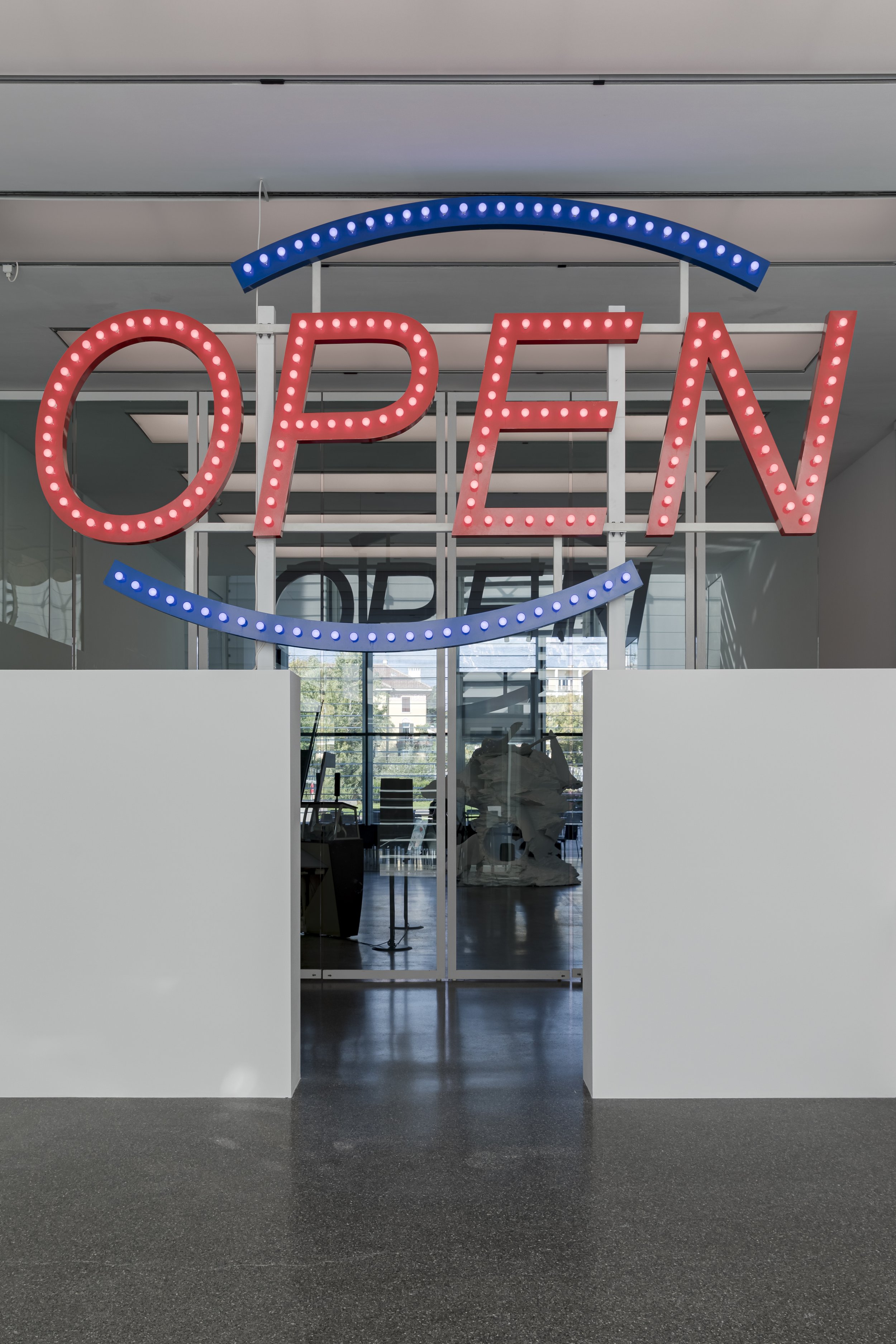
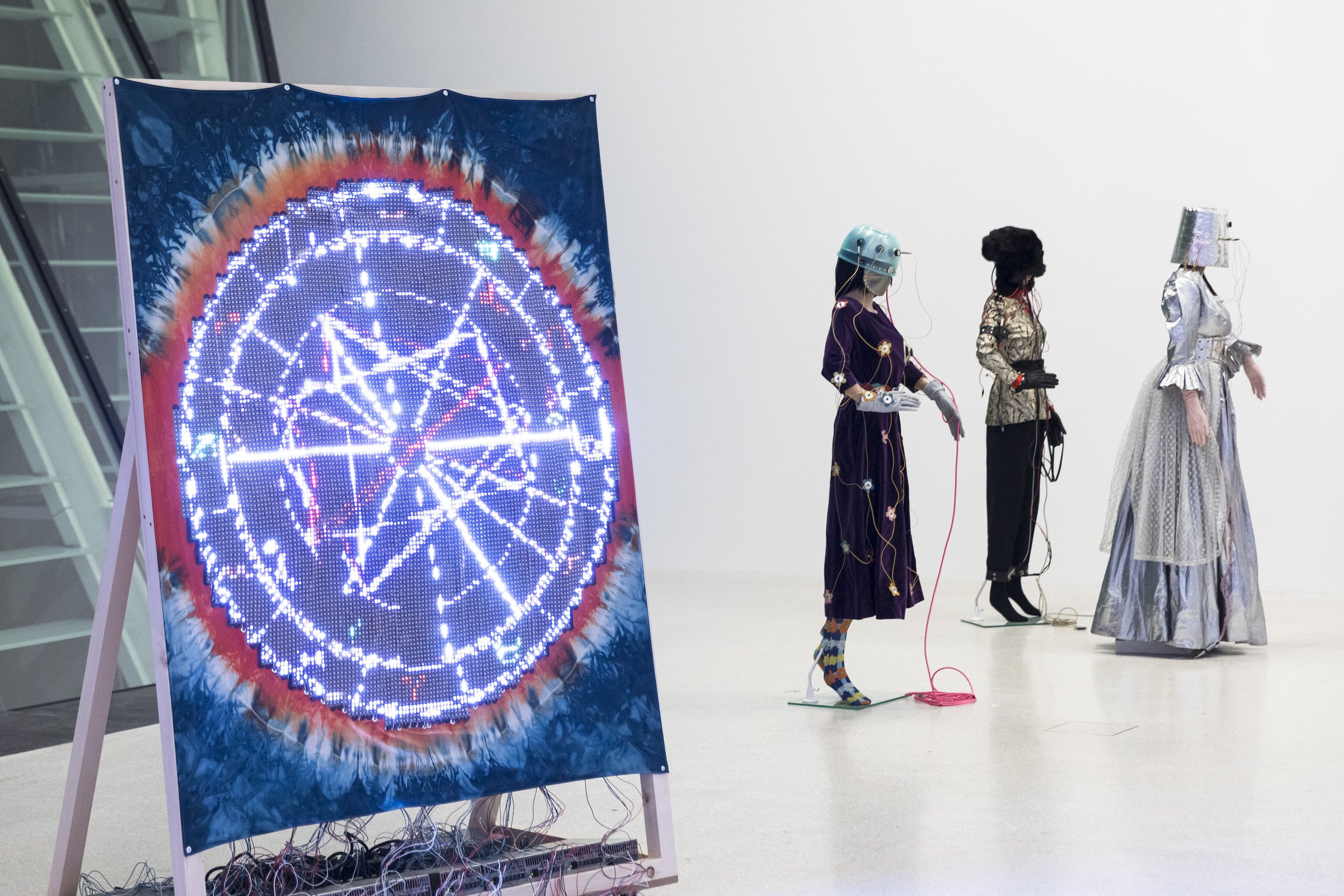

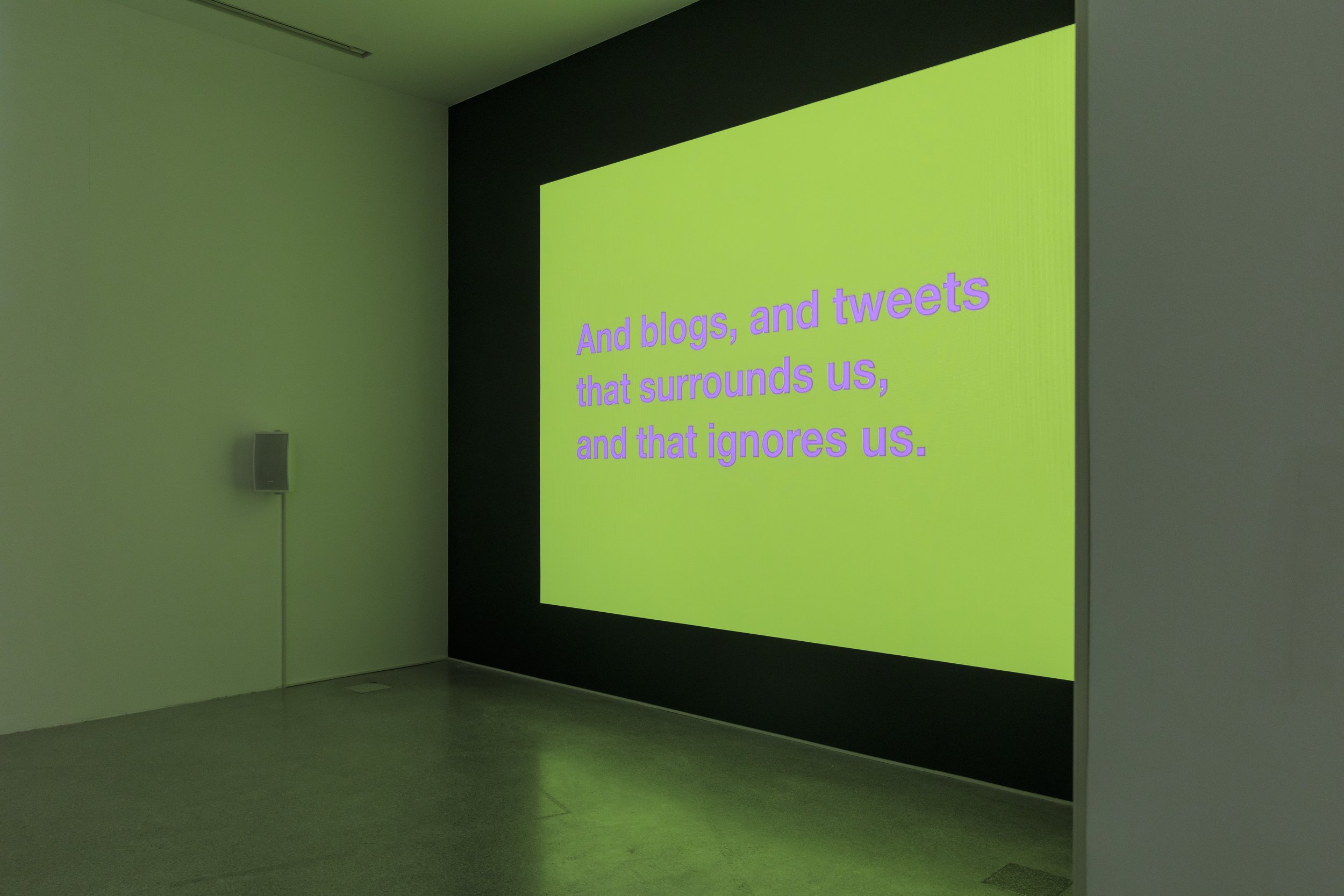
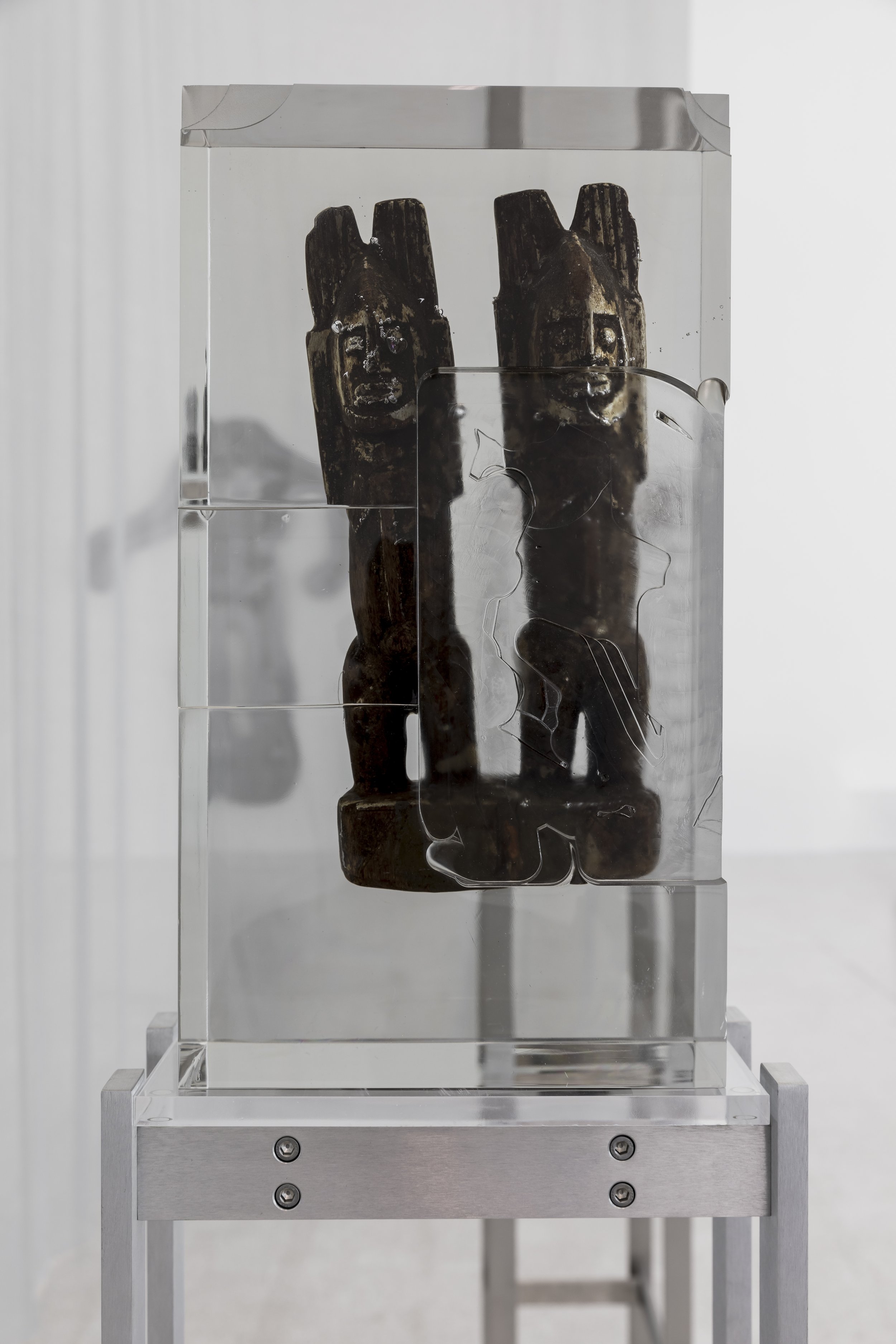
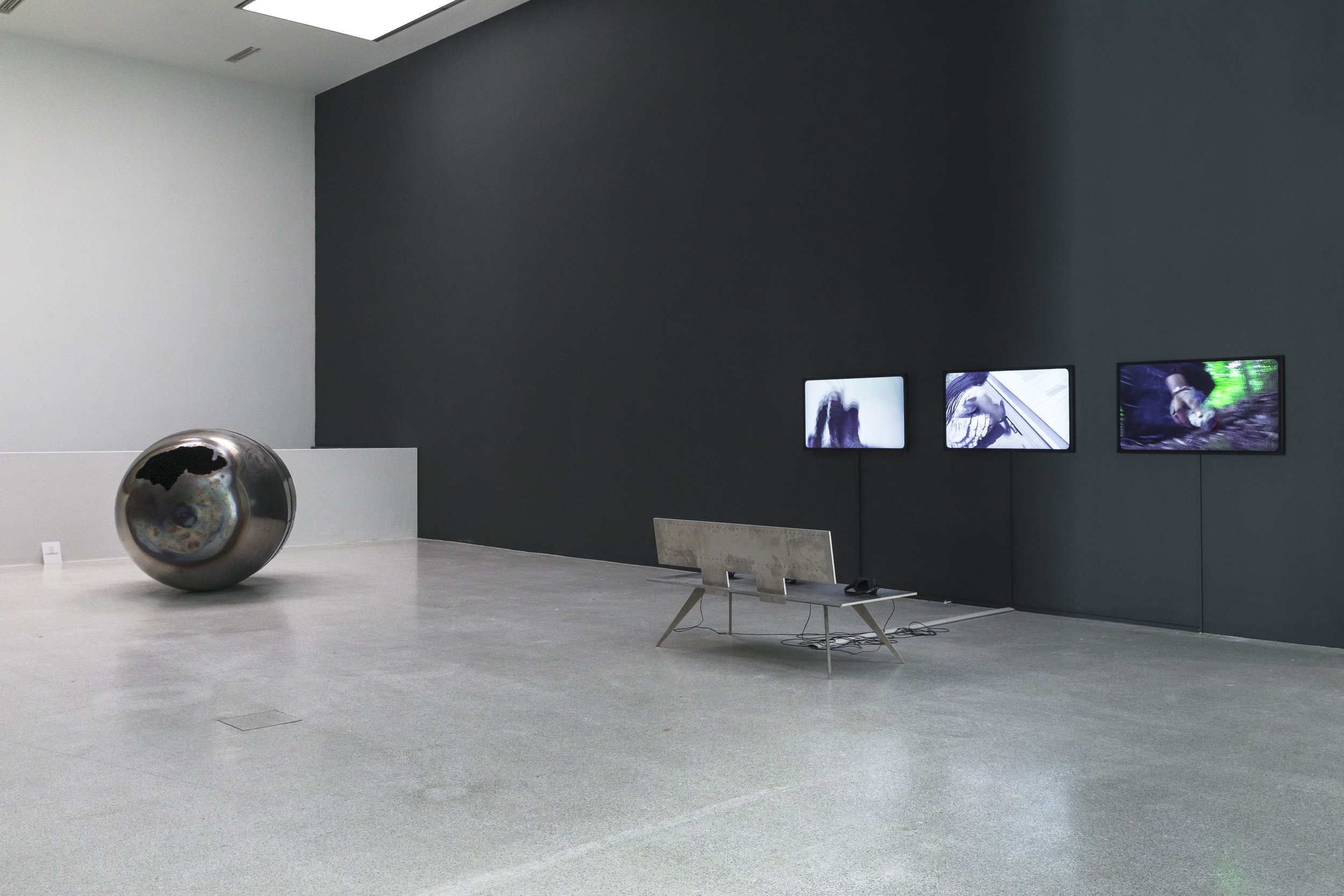
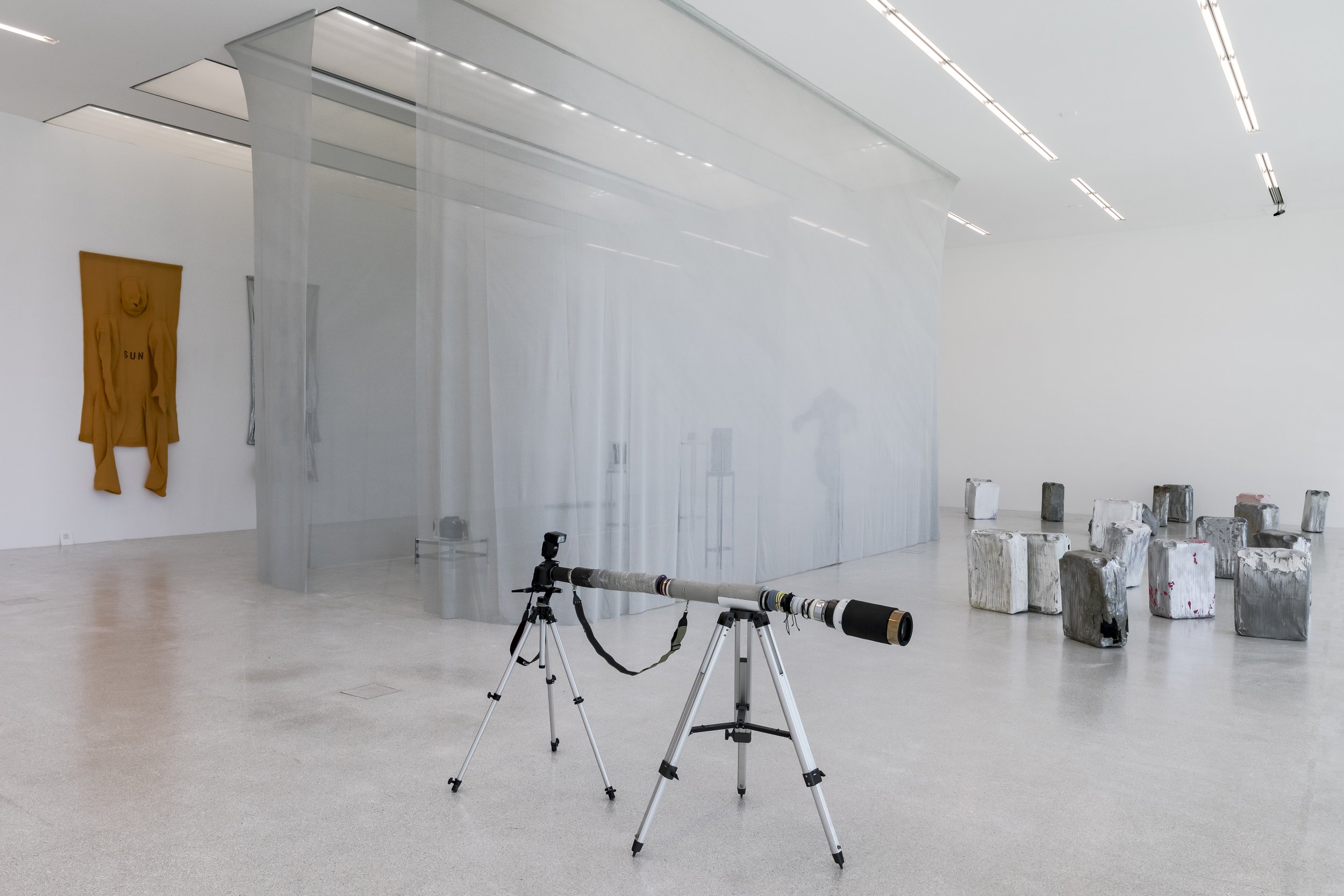
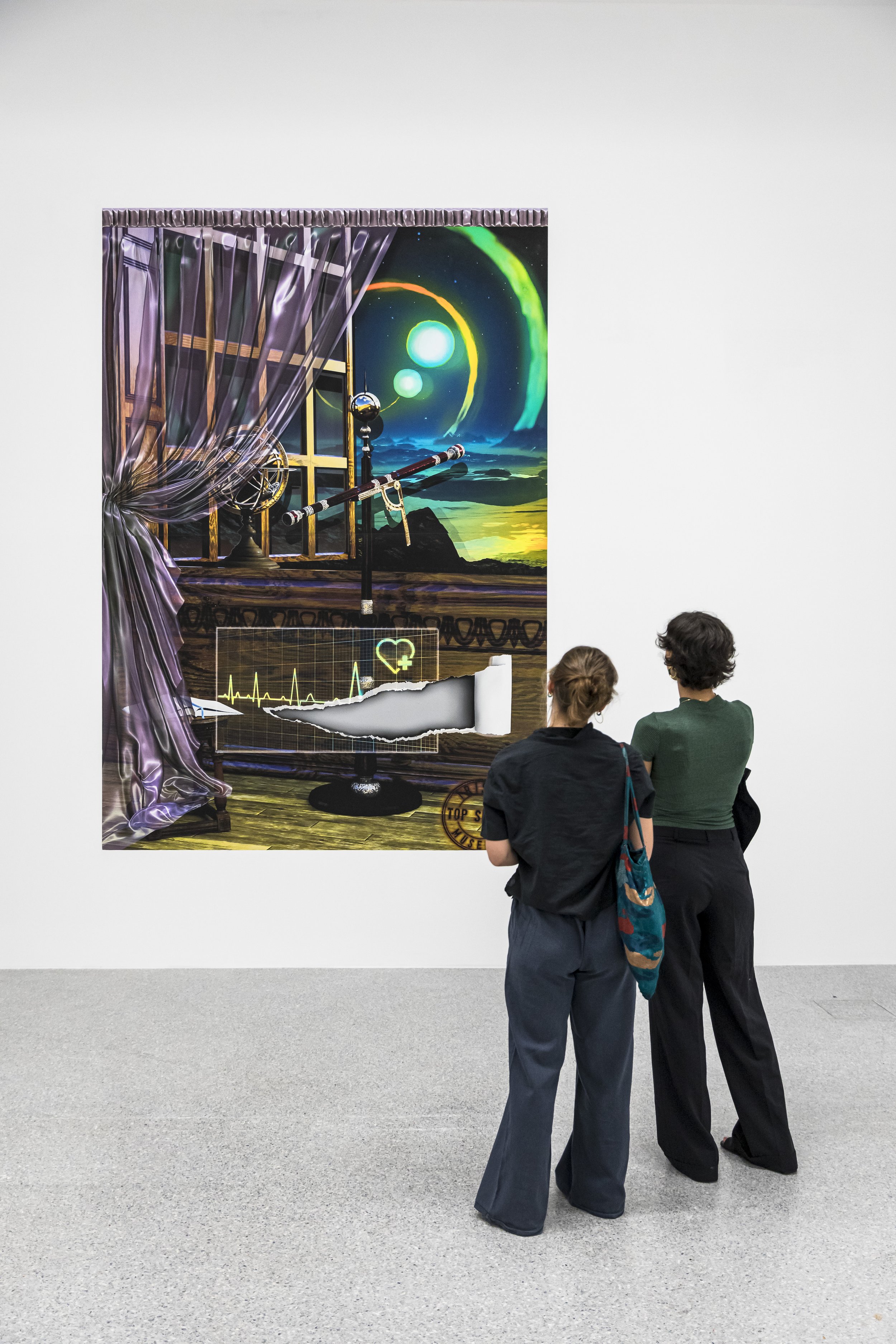
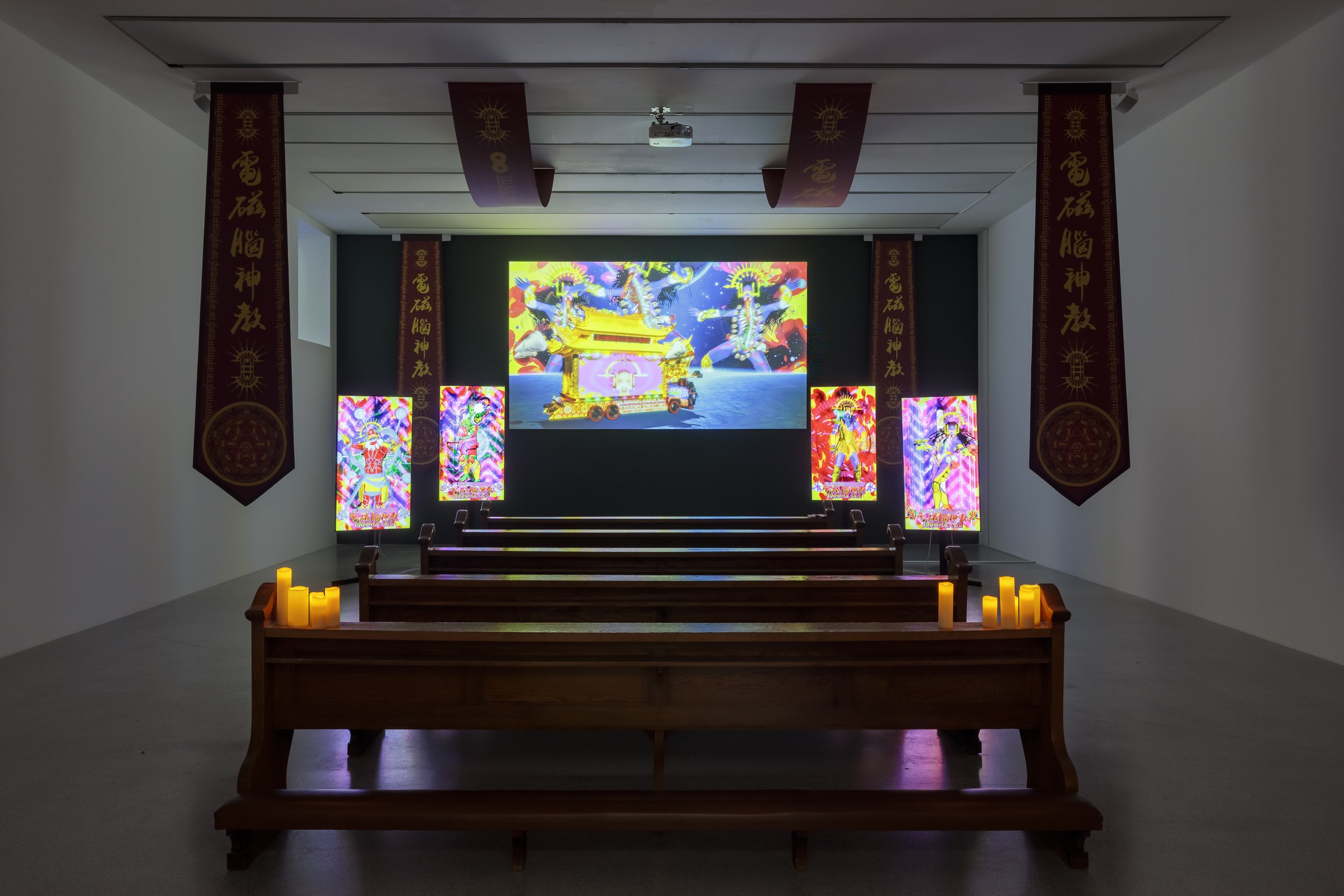
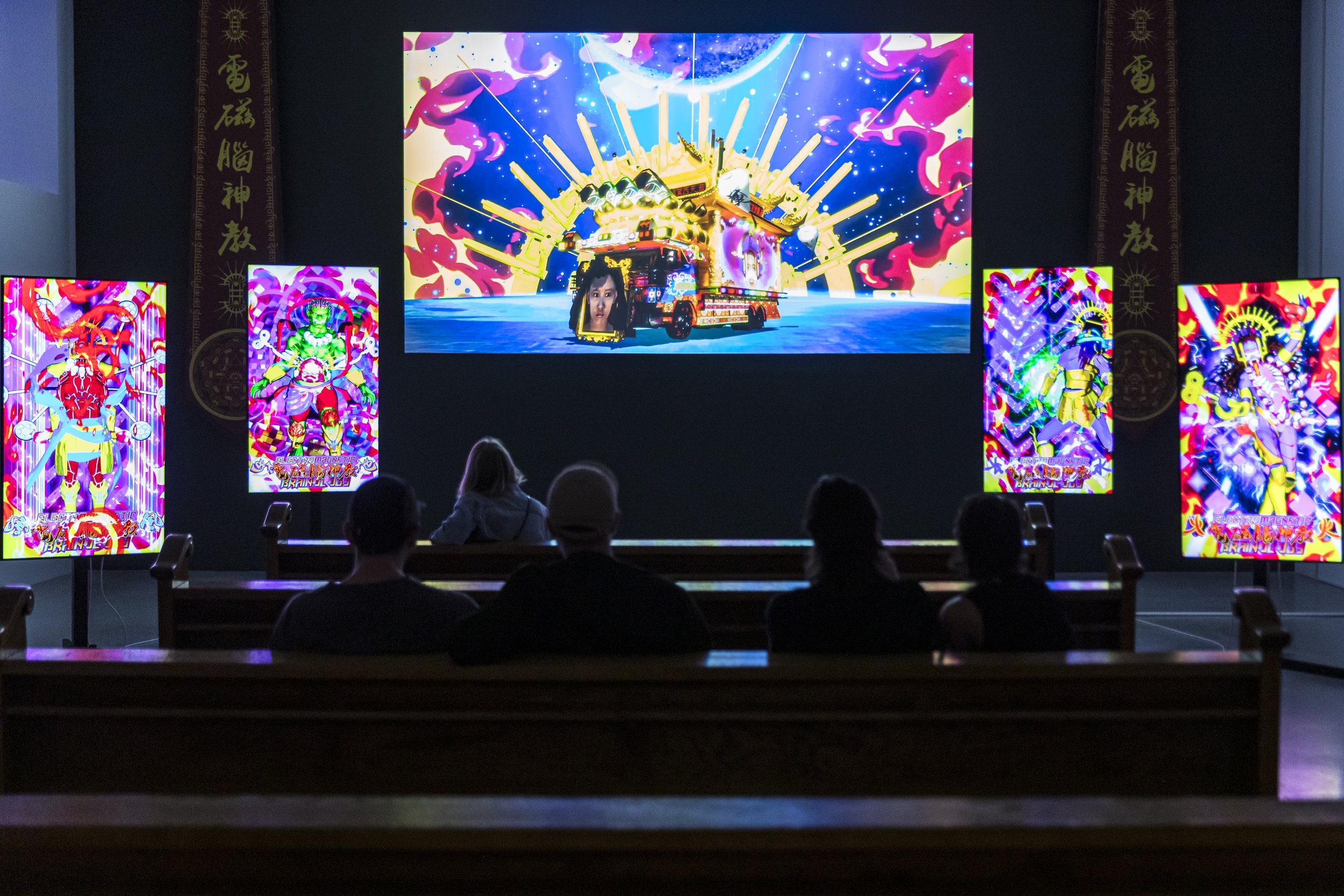
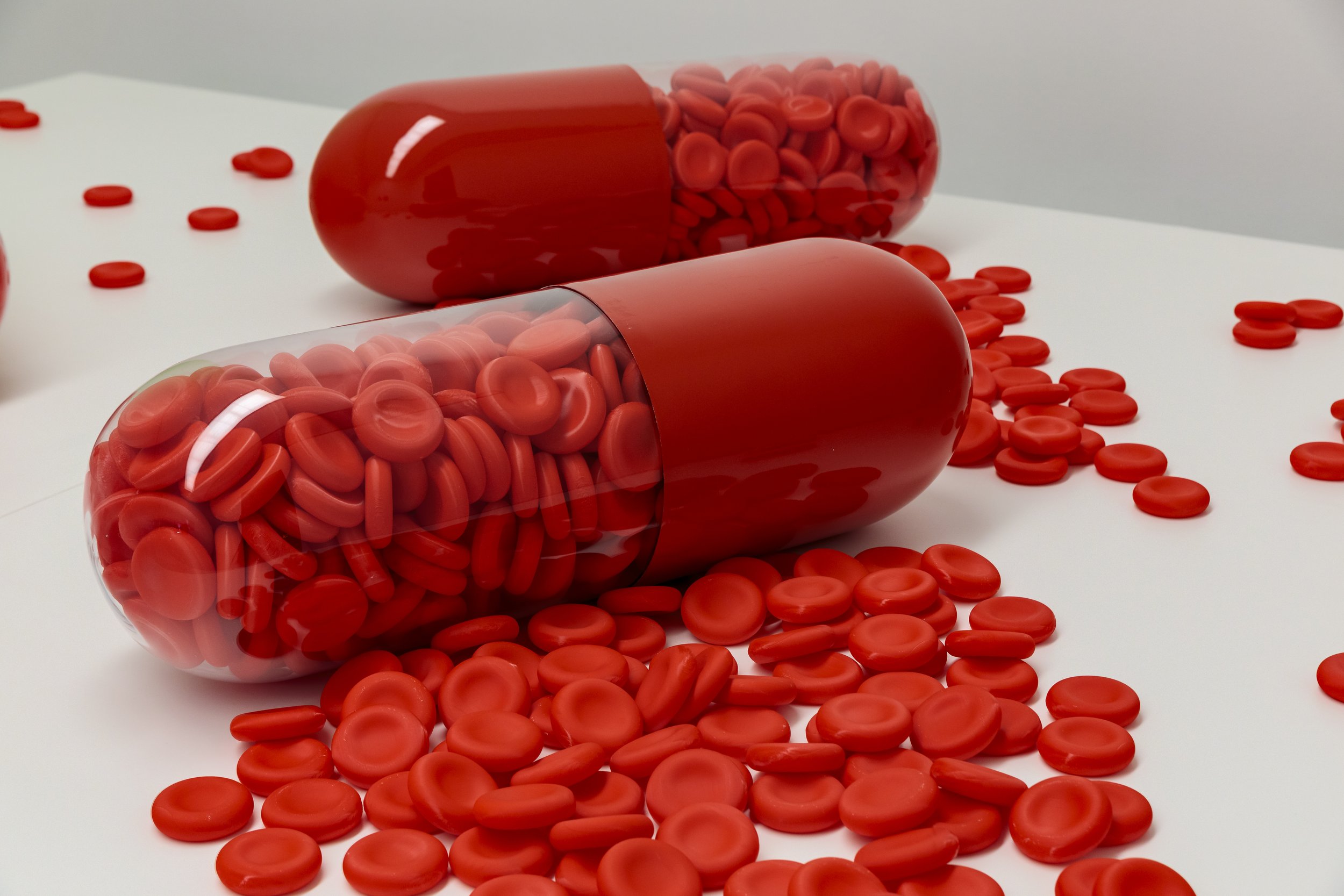

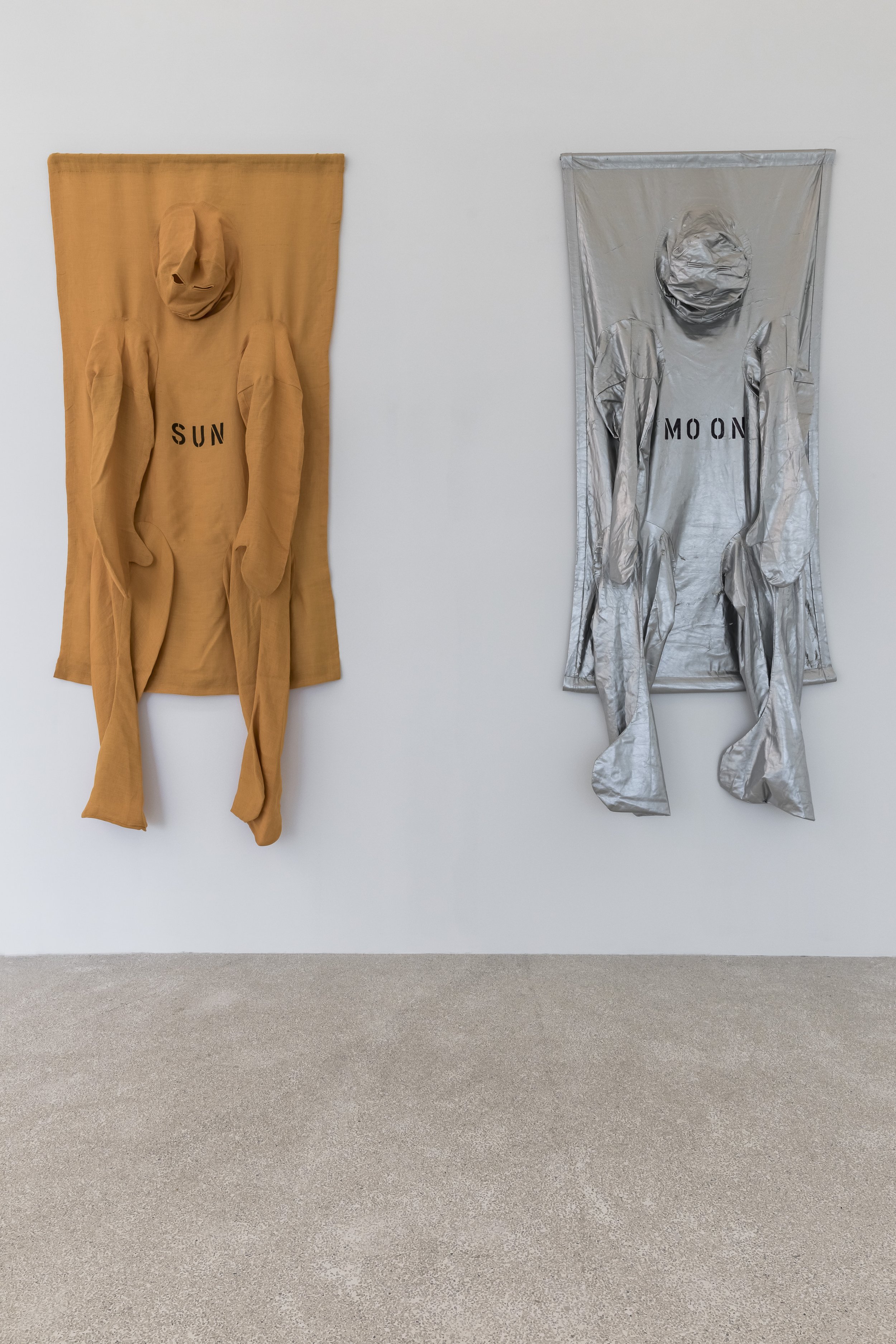
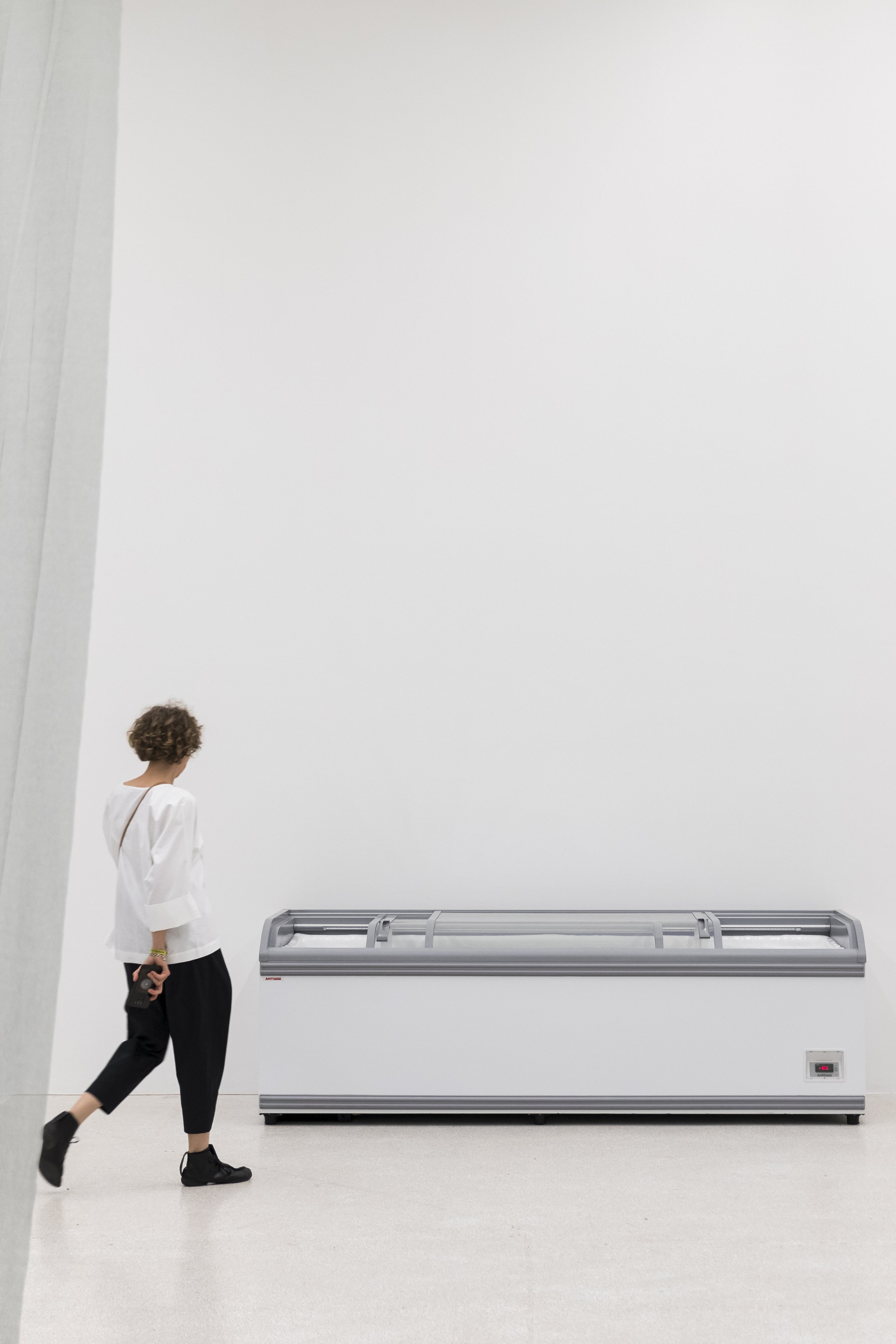
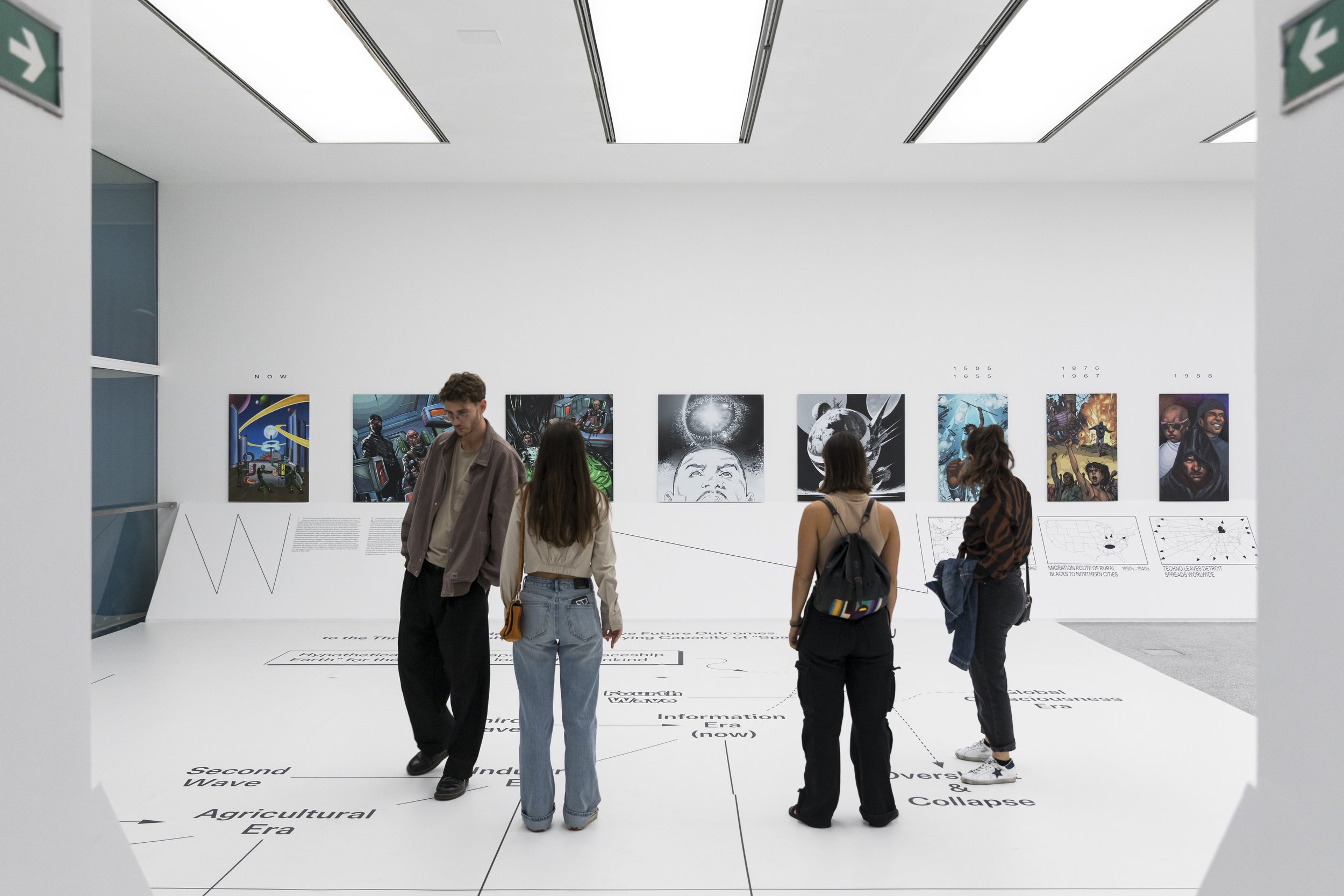
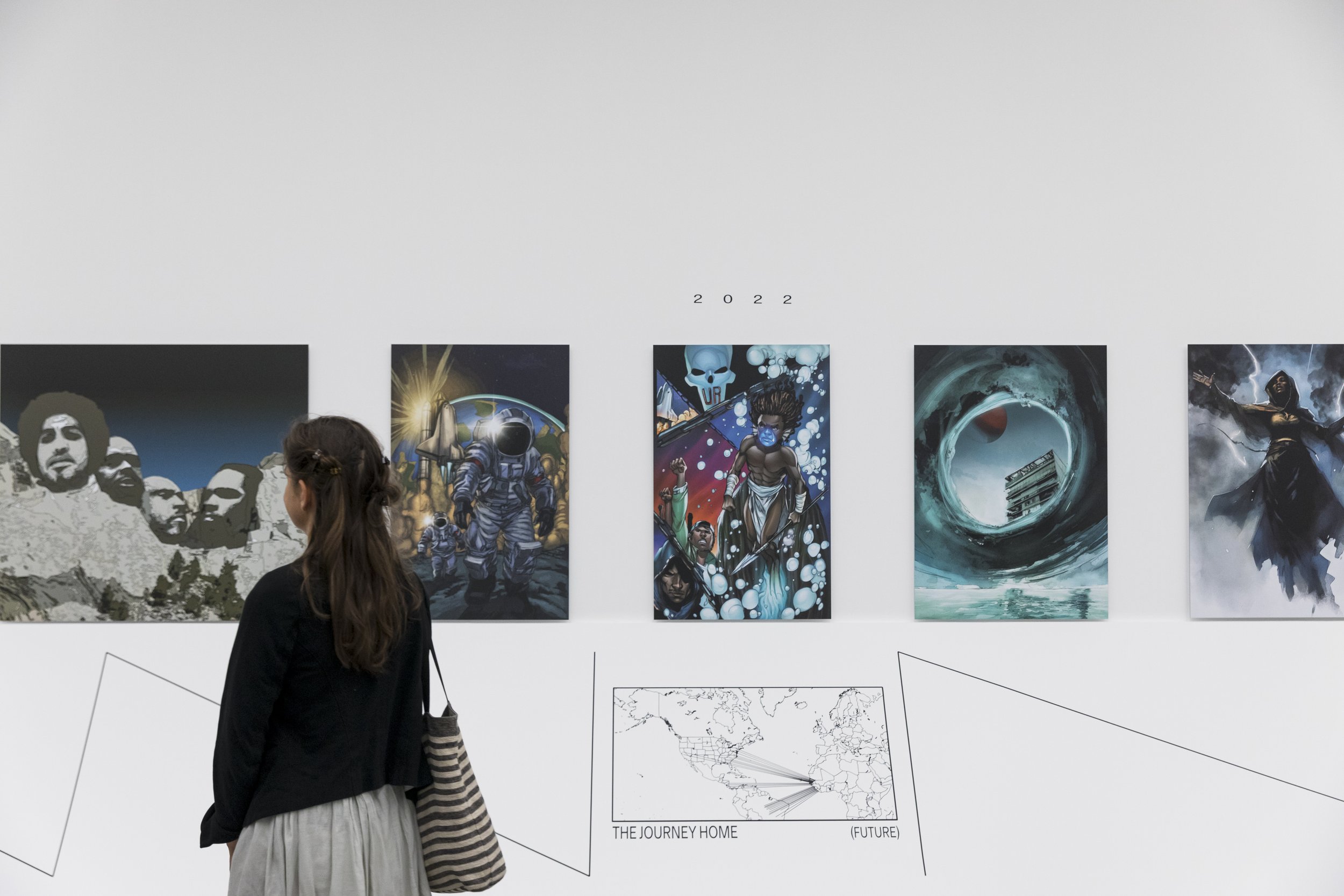
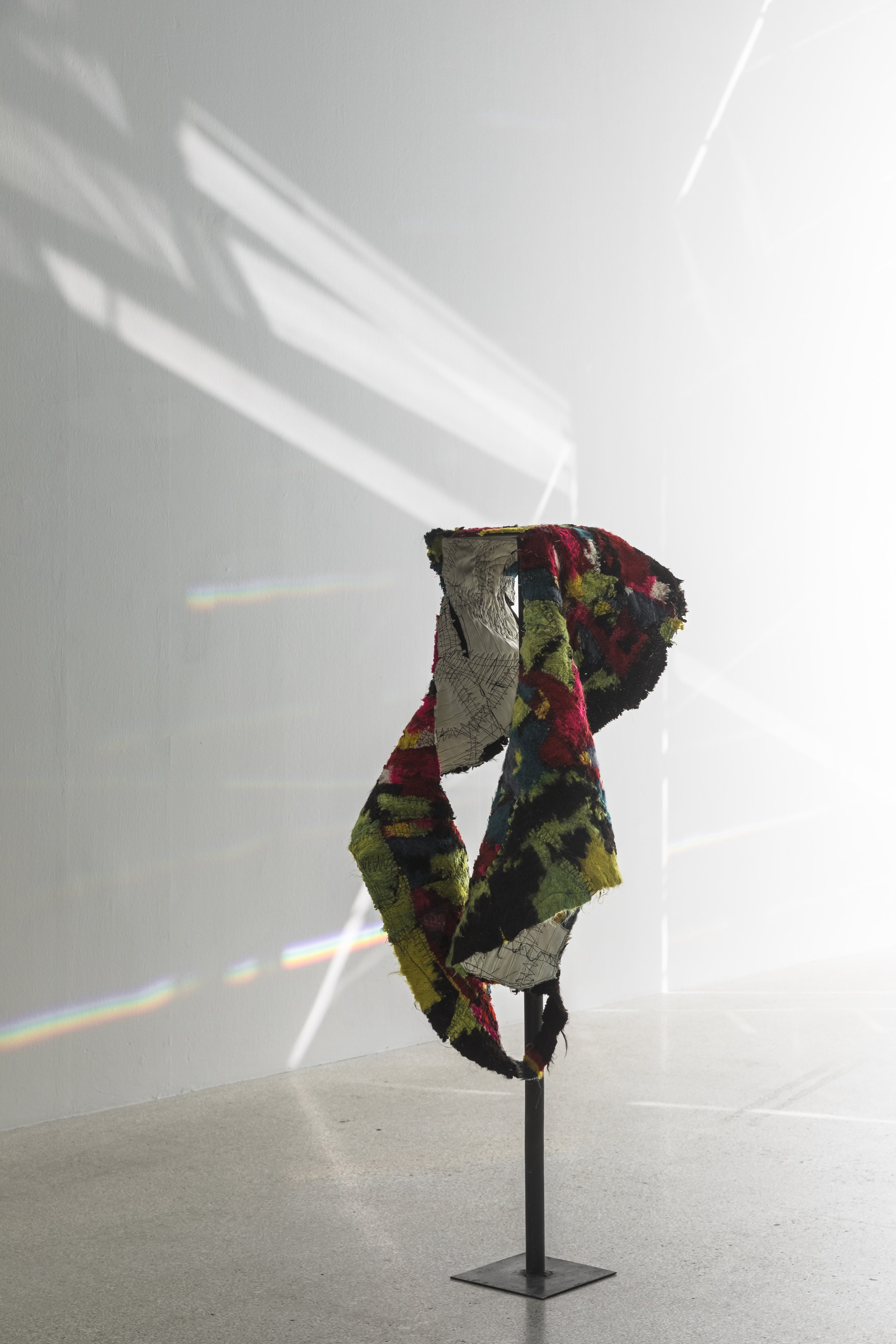
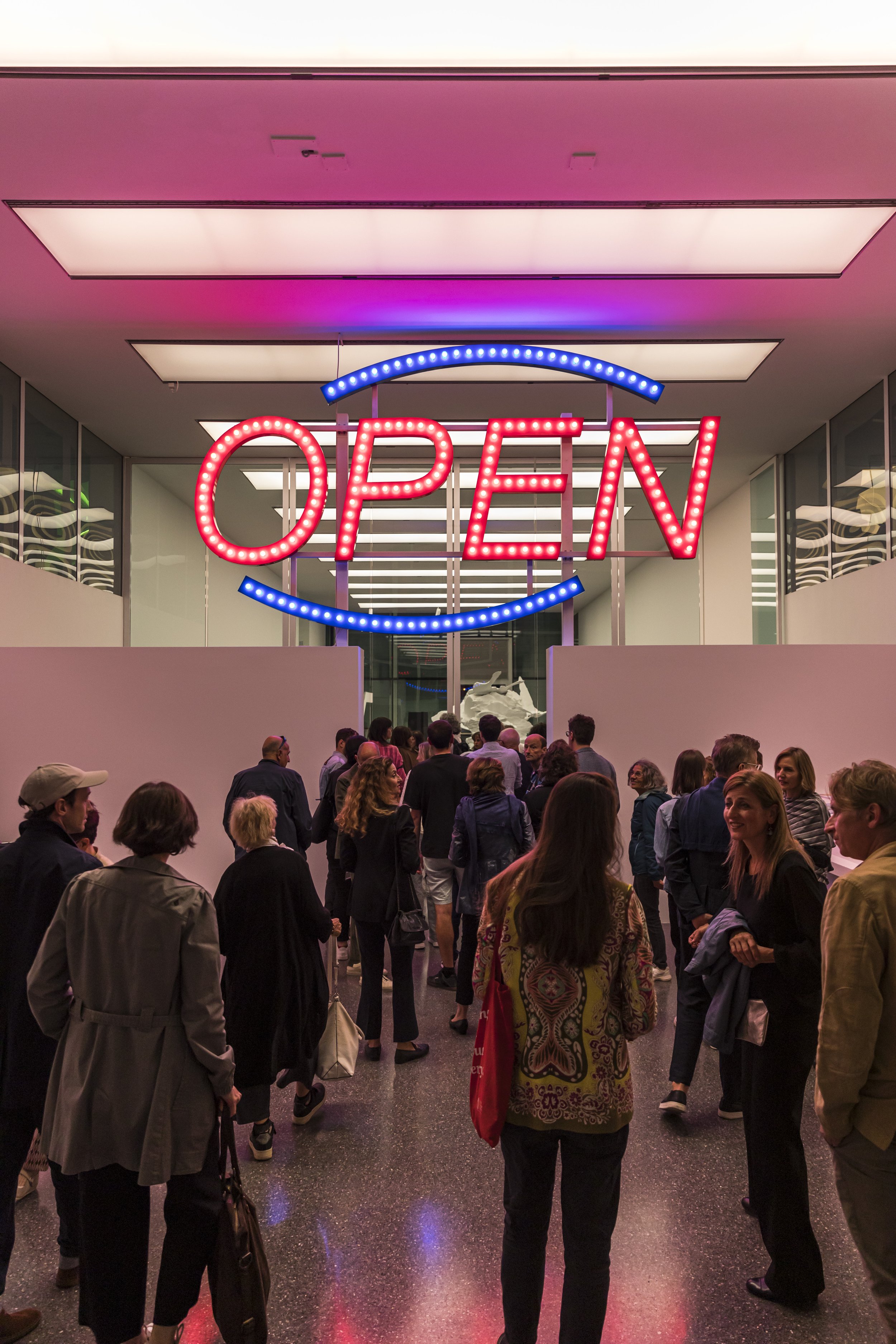
Installation view, HOPE, Museion in Bolzano, Italy, 2024. Courtesy Museion
Finally, following the guiding logic of the wormhole depicted in Haqq's key visual artwork for the exhibition, the ground floor creates a passage for lightning-fast travel between distant points in space-time. The combination of unearthed and just emerging works bridges the histories and futures of Museion as a collecting institution and opens a space of listening, speech, and discussion of HOPE's key questions: Where do we come from, and where do we want to go?
The exhibition includes pieces by Almare, Sophia Al-Maria, Ei Arakawa, Trisha Baga, Neïl Beloufa, Black Quantum Futurism, Tony Cokes, Irene Fenara, Michael Fliri, Petrit Halilaj, Matthew Angelo Harrison, AbuQadim Haqq, Andrei Koschmieder, Maggie Lee, Lawrence Lek, Nicola L., Linda Jasmin Mayer, Beatrice Marchi, Bojan Šarčević, Marina Sula, Suzanne Treister, Ilaria Vinci, LuYang, and works from the Museion collection by Allora & Calzadilla, Shūsaku Arakawa, Ulrike Bernard & Caroline Profanter, Shu Lea Cheang, Tacita Dean, Sonia Leimer, Ana Lupaş, and Riccardo Previdi.
The HOPE program further includes the Italian premiere of a major performance by choreographer and dancer Trajal Harrell and the Schauspielhaus Zürich ensemble in collaboration with Transart, an off-site exhibition by artist Thomas Feuerstein hosted and supported by NOI Techpark, several Museion Art Club events, and a rich mediation program that actively engages the audience in negotiating "spaces of hope.”
HOPE marks the third chapter of TECHNO HUMANITIES with an international research group consisting of Bart van der Heide, Leonie Radine, DeForrest Brown, Jr., and Museion Passage Group with the exhibition design by Diogo Passarinho Studio
Publication
HOPE is complemented by an anthology of newly commissioned critical texts by Bart van der Heide, Leonie Radine, DeForrest Brown, Jr., Mahan Moalemi, and Ytasha L. Womack, published by Hatje Cantz, which concludes the trilogy of volumes dedicated to TECHNO HUMANITIES. The key visual artwork in the communication of the exhibition is created by AbuQadim Haqq, who also contributes to the anthology with a set of digital paintings that relate to his illustrations of historic Detroit techno album covers and his renowned Afrofuturist graphic novels.
TECHNO HUMANITIES
TECHNO HUMANITIES is a three-year multidisciplinary research project of exhibitions, publications, and public programs. It is Museion’s most extensive experiment to date, involving all staff members and regional stakeholder communities. TECHNO HUMANITIES explores the urgent, existential questions of what it is to be a global citizen in the present-day dependency between ecology, technology, and economy.
In partnership with
Transart Festival of contemporary culture
NOI Techpark
Institutional partners
Autonome Provinz Bozen Südtirol – Provincia Autonoma di Bolzano Alto Adige
Stiftung Fondazione Sparkasse
Museion Private Founders
For more information about this exhibition or others at the museum, please visit their site here. The museum can also be found on Instagram, YouTube, and Facebook.
Lhola Amira: Facing The Future
IRMANDADE: The Shape of Water in Pindorama (2018–2020). iNyembezi zomKhathilibe - lágrimas do universo, 2019 (film still). Courtesy of SMAC Gallery. © Lhola Amira.
Lhola Amira: Facing the Future launches a new program of special exhibitions that will interpret the African art collection as a living and evolving practice through the lens of contemporary art.
This solo exhibition, the artist’s first in the United States, features the newly created, site-specific spiritual portal Philisa: Zinza Mphefumlo Wami (2022). Philisa are unique portals, sacred spaces for the cleansing of wounds, honoring ancestors, and fostering connection. Visitors are invited to enter this sacred grove with support for whatever may unfold. Also included is the single-channel video projection IRMANDADE: The Shape of Water in Pindorama (2018–2020), produced by the artist in Bahia, Brazil. The film documents the artist’s journey through the city, contemplating the wounds of the ocean, the land, and the descendants of enslaved Africans while offering gestures toward healing.
Ancestral Screen (1890–1920) Pokia Family, Nigeria. Iroko Wood, Bamboo, Rattan, Pigment, Vegetable Fibers, Metal, 90.2 x 86.4 cm (35 1/2 x 34 in.) The image was provided courtesy of the Fine Arts Museums of San Francisco.
Artist Lhola Amira travels the world asking, “Where does it hurt, why does it hurt, how does it hurt, and what do WE do with our wounded-ness? How can WE move through the wound and gesture for healing?”*This exhibition explores these questions in the context of the journey of artworks and people from Africa across space and time as it acknowledges the wounds of descendants of Africans. Amira’s art practice evolved from the spirituality of the Nguni of South Africa, which combines Christianity with traditional values. THEY adapted this living tradition for today’s world, inspiring visitors to remember ancestors and descendants as a healing practice. The exhibition features a new site-specific commission, Philisa: Zinza MphefumloWami(2022), which translates to “Let It Be Healed: Be Steady My Breath, MySpirit.”Philisais a sacred gateway to support individual and collective health through listening and relaxation. Lhola AmiraFacing the FutureArtist Lhola Amira travels the world asking, “Where does it hurt, why does it hurt, how does it hurt, and what do WE do with our wounded-ness? How can WE move through the wound and gesture for healing?”*This exhibition explores these questions in the context of the journey of artworks and people from Africa across space and time as it acknowledges the wounds of descendants of Africans. Amira’s art practice evolved from the spirituality of the Nguni of South Africa, which combines Christianity with traditional values. THEY adapted this living tradition for today’s world, inspiring visitors to remember ancestors and descendants as a healing practice.
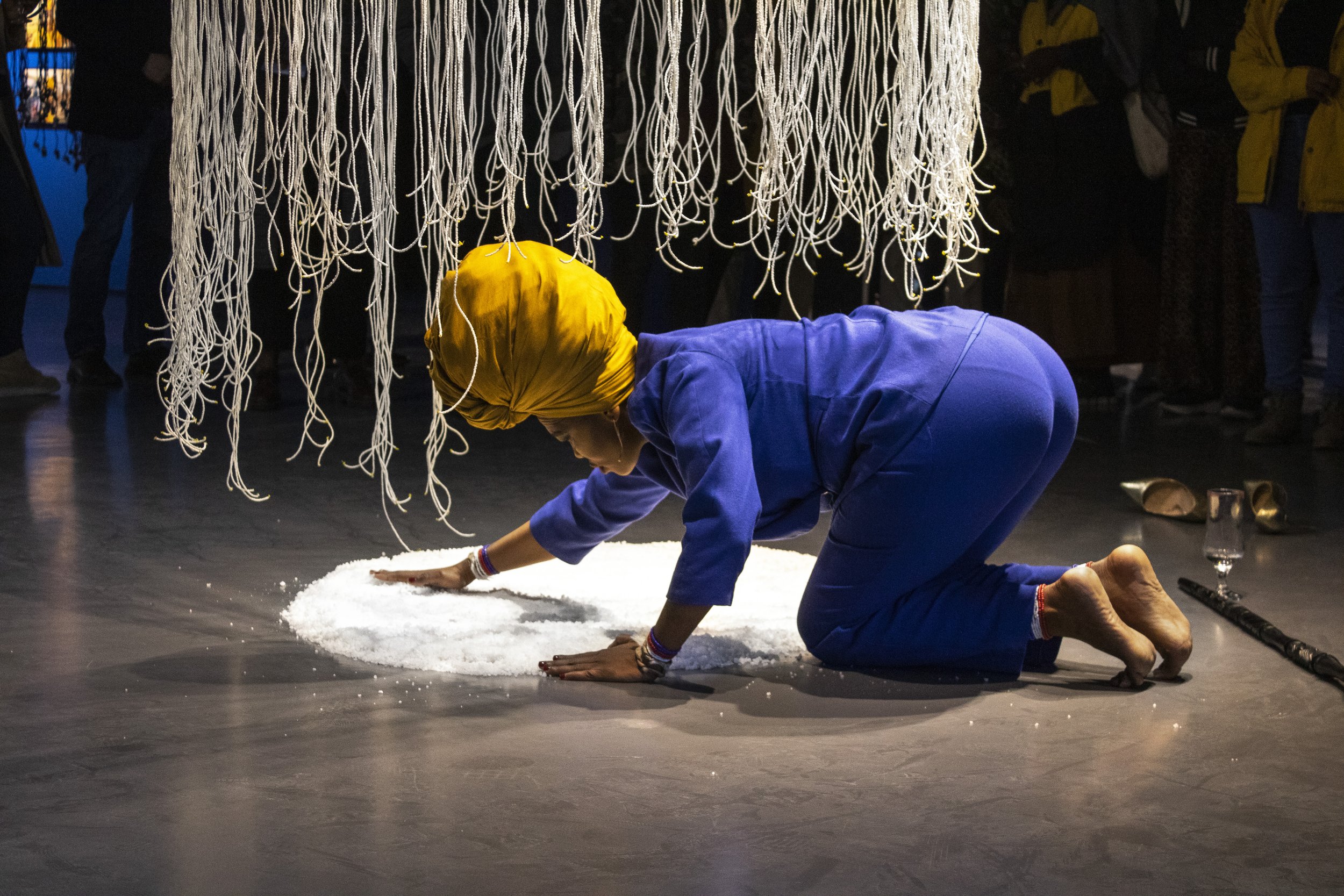
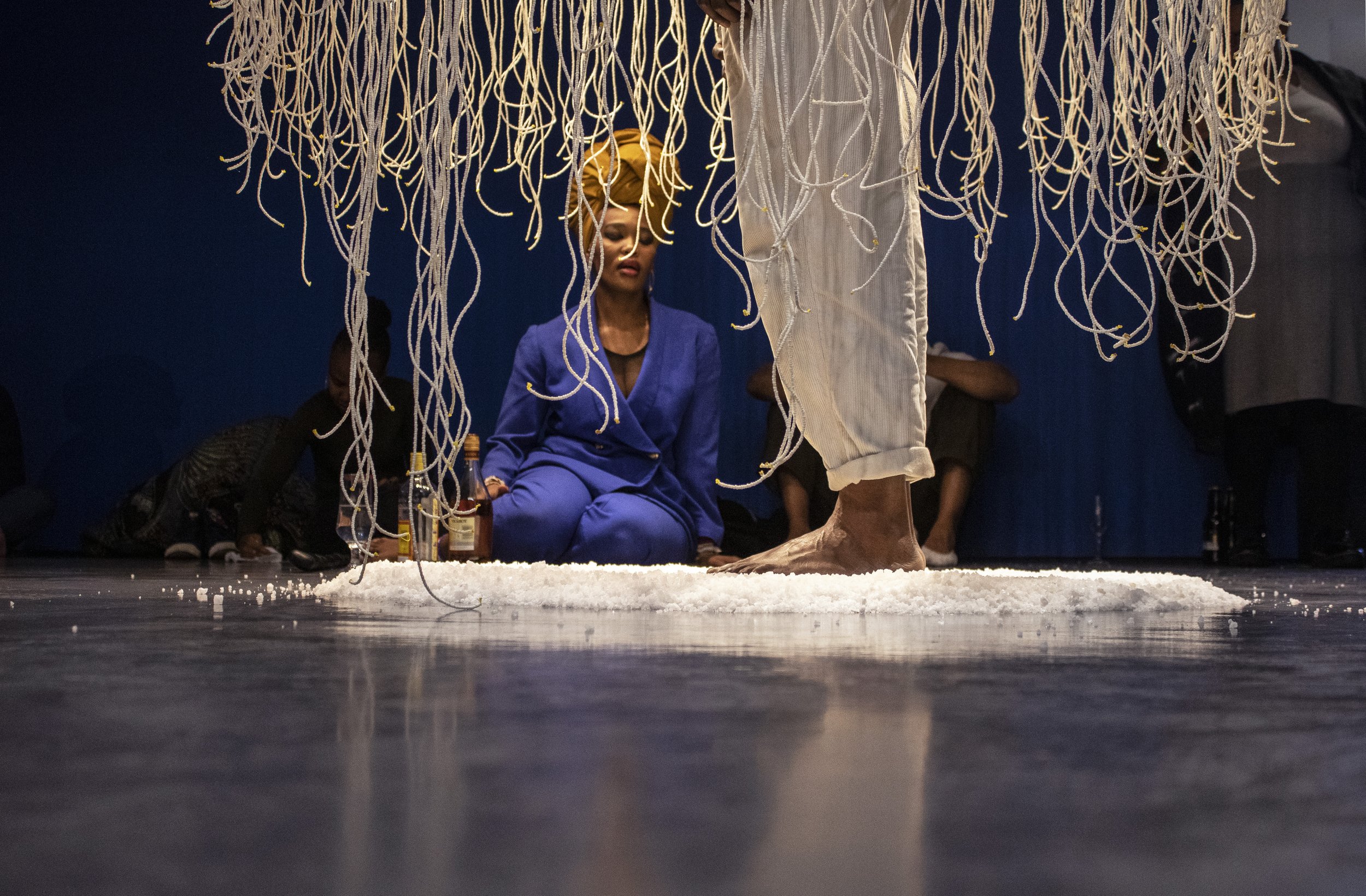

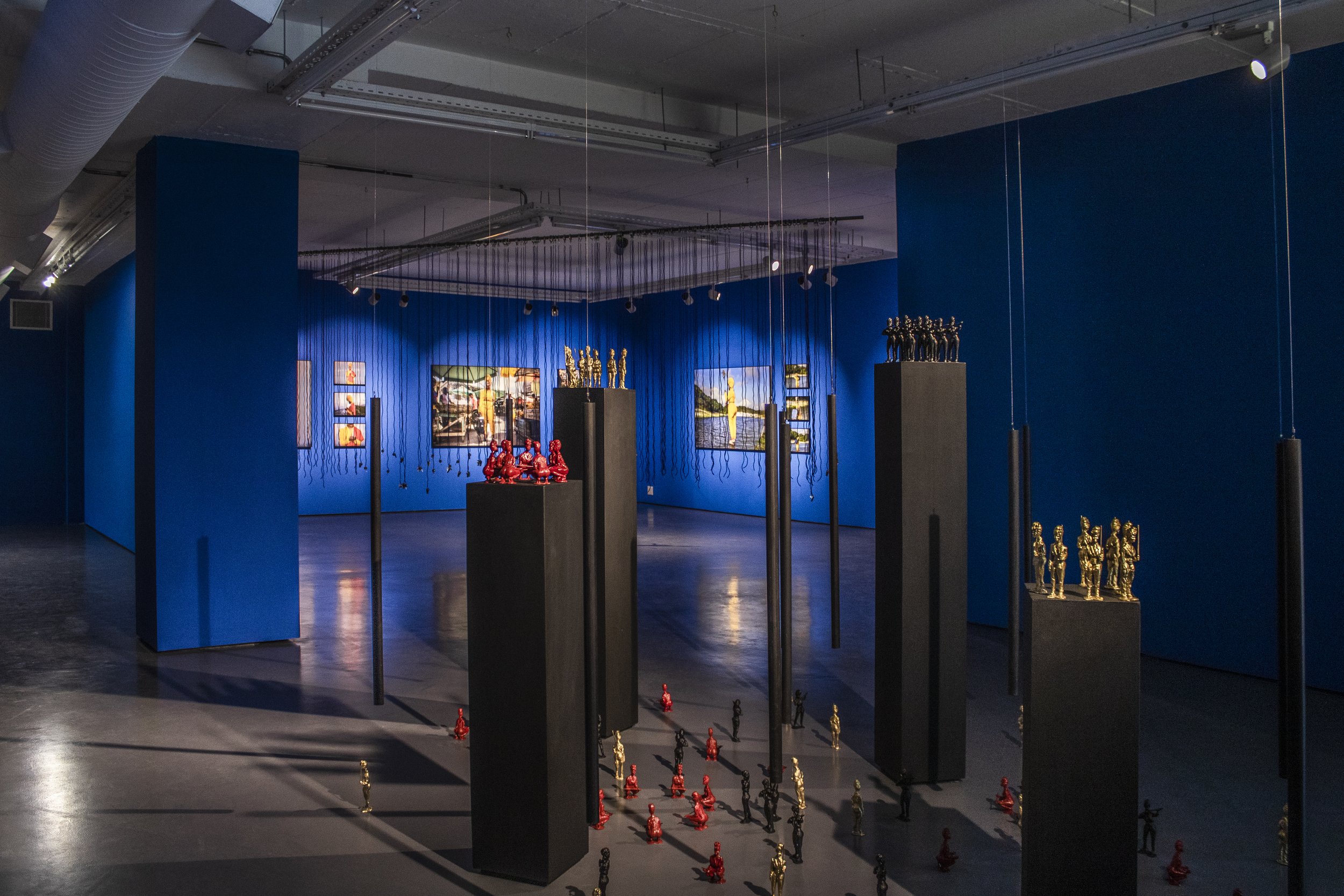
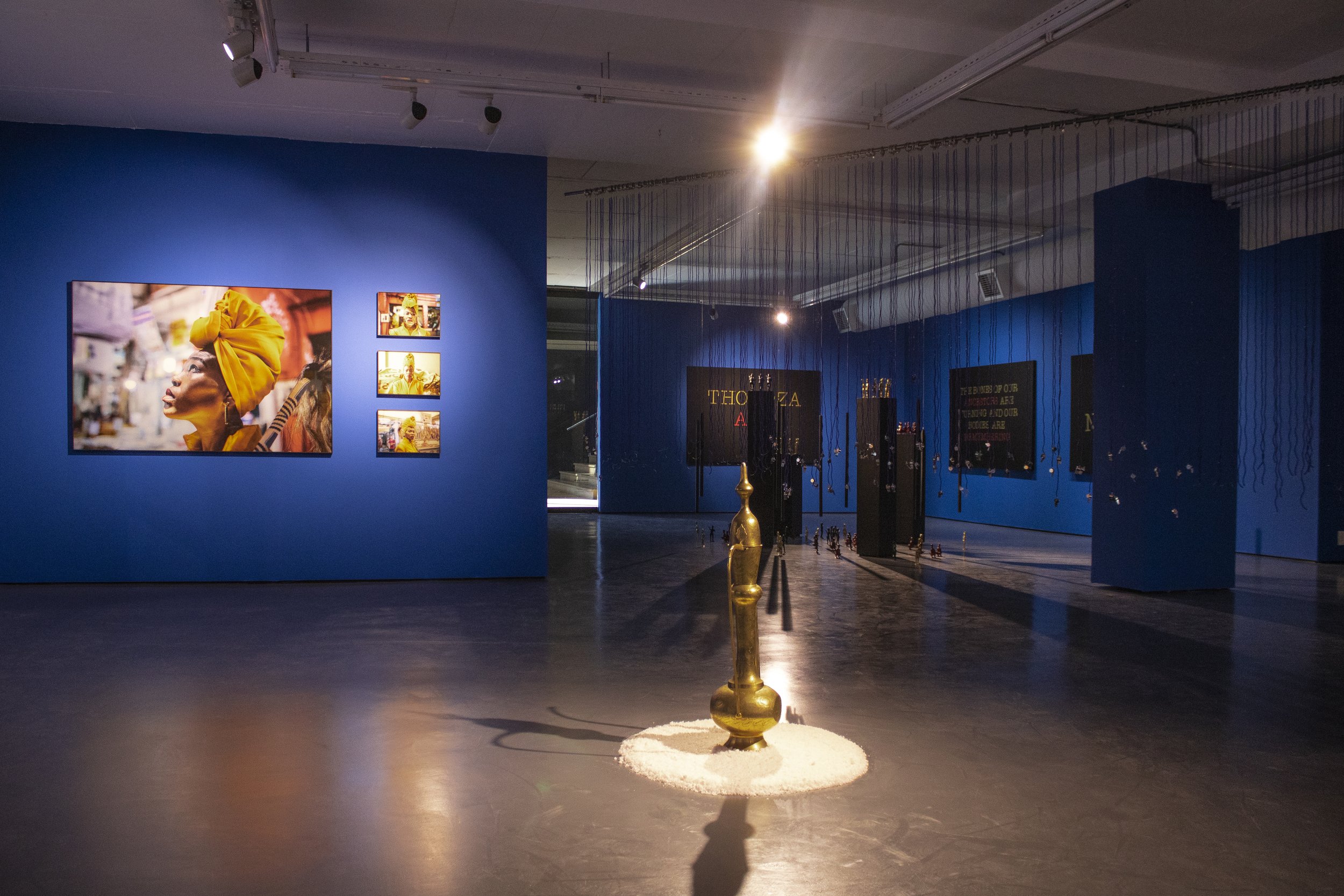


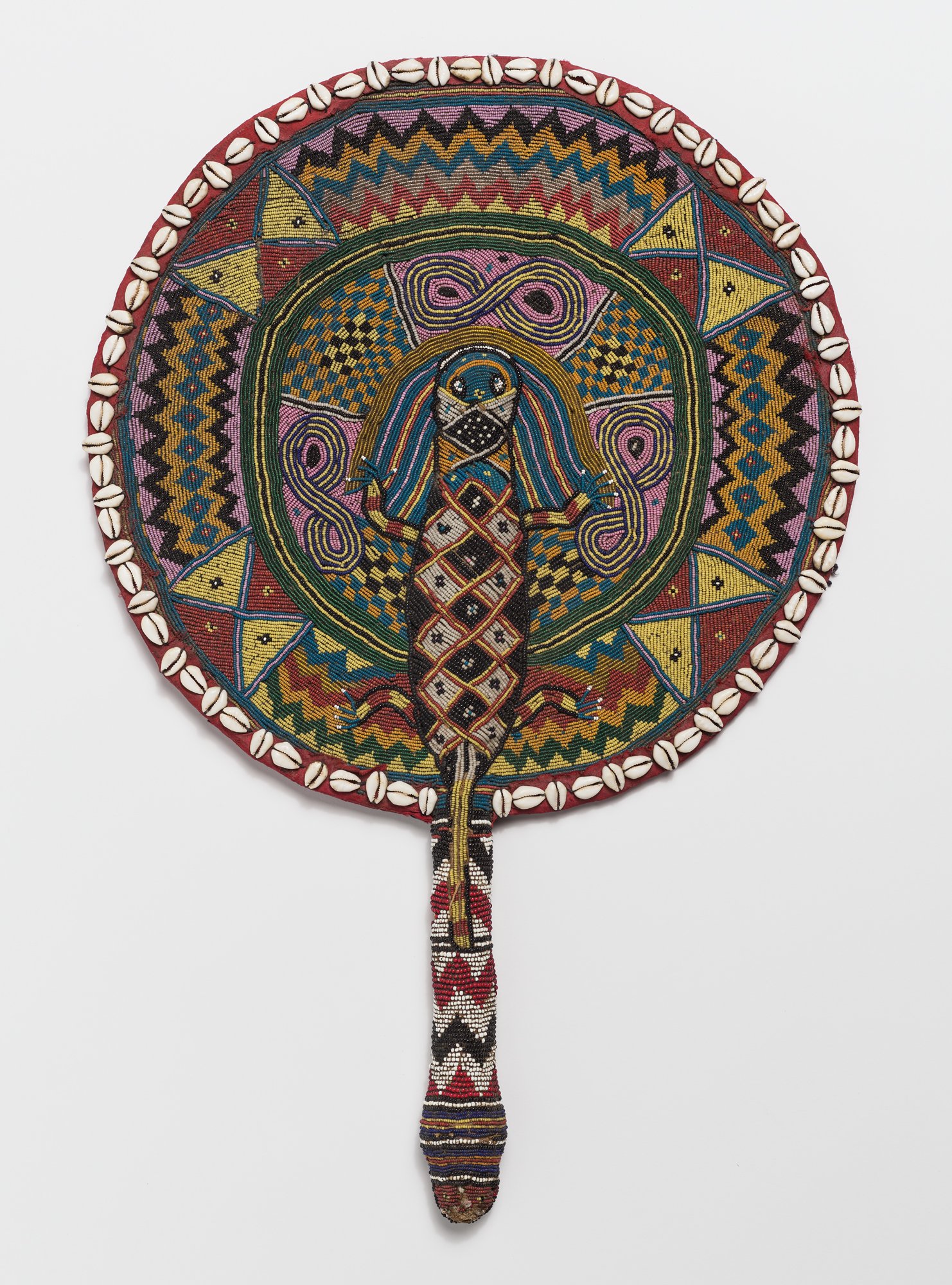
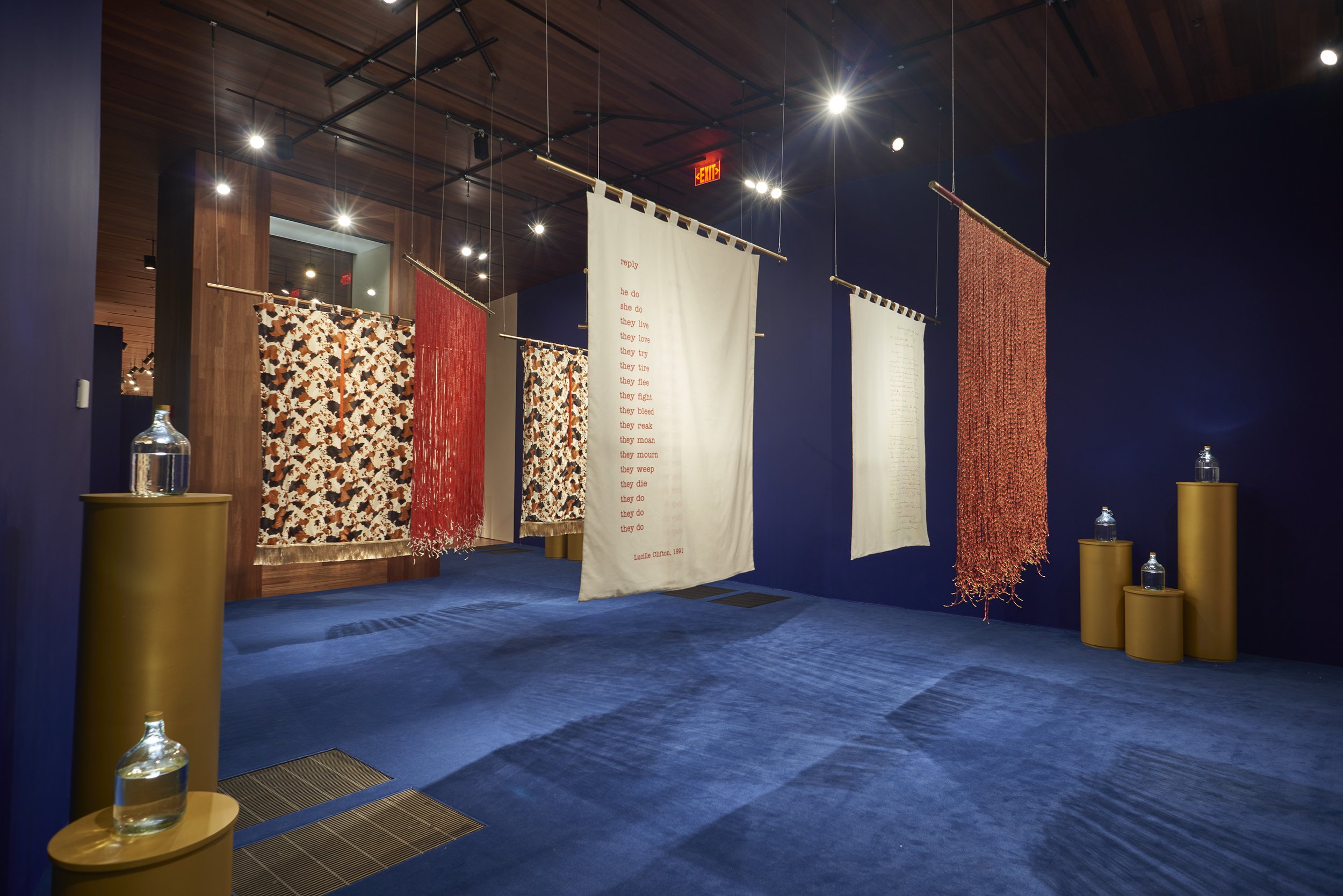



The exhibition features a new site-specific commission, Philisa: Zinza MphefumloWami(2022), which translates to “Let It Be Healed: Be Steady My Breath, MySpirit.”Philisais is a sacred gateway to support individual and collective health through listening and relaxation.
Included is the single-channel video projection IRMANDADE: The Shape of Water inPindorama(2018–2020), in which the artist journeys through an Afro-Brazilian city to bear witness to the wounds of the ocean and land, the dead and living. Artworks from the Fine Arts Museums’ permanent collection serve as conduits between the spirit and human worlds and assume a new cultural vitality within Amira’s healing arc. Vibrating with relevance are representations of ancestors, expressions of spiritual values, and objects that serve sacred and ceremonial purposes.
Lhola Amira: Facing the Future calls for all, including ancestors, to be involved in the work of caring and repairing our shared world. This exhibition is organized by the Fine Arts Museums of San Francisco with the generous support of Denise Littlefield Sobel.
*Lhola Amira capitalizes THEIR pronouns (THEY/THEM/THEIR) because THEY are the spiritual counterpart to the physical body of Khanyisile Mbongwe. They are the manifestation of the Nguni belief in duality: each person has a spiritual counterpart in addition to their physical body.
Seth Kane Kwei, Coffin in the shape of a cocoa pod, ca. 1970. Wood, paint, and cloth, 34 x 102 x 29 in. (86.4 x 259.1 x 73.7 cm). Fine Arts Museums of San Francisco, Gift of Vivian Burns, Inc. Courtesy of Kane Kwei carpentry workshop. Photograph © Fine Arts Museums of San Francisco, photograph by Randy Dodson
Beaders: Busela Mbongwa, Yvonne Motlhare, Veronica Mke, Thandeka Grace Maranyathi, Nomvuyo Mke, Nomonde Mahote, Pieta Magengenene, Nokhaya Wowo, Linda Kanye, Kwanele Mayeki. Studio assistants: Lungile Mbongwa and Luca Evans. Sound conversations: Sisonke P.
The Healing Power of Art:
Lhola Amira: Facing the Future brings together historical and contemporary art practices that respond to the care of individuals and communities. The calls of ancestors and descendants are filtered through the shared experiences of Black people. Their voices are entwined, as they are all involved in healing our world by dismantling the forces of colonialism, imperialism, and systemic racism. This selection highlights sculptures and ceremonial pieces from Africa made for rituals supporting healthy human and ecological relationships. They reflect different worldviews about the interconnectedness of individuals and communities, past and future, earth and ocean, and physical and spiritual worlds. Many religious beliefs proliferate in Africa today—the most common are Christianity and Islam—yet these objects transcend their respective eras to communicate across time and cultures. This convergence of the Fine Arts Museums’ collection of African art and Lola Amira’s contemporary practices invites visitors to be inspired by simple acts of care and devotion that can heal and transform the past and present.
Facing the Future is a resource for today’s troubling times, reminding us of our deep and profound connection to the earth and to each other.
For more information about this exhibition and others at de Young/Legion of Honor and the fine arts museums of San Francisco please visit here. The museum can also be found on Instagram, on Facebook, and YouTube
Antonio M. Gómez: LINEAJES
Installation view of Antonio M. Gómez: LINEAJES, Frye Art Museum, Seattle, November 11, 2023–March 10, 2024. Photo: Jueqian Fang
LINEAJES interrupts the gilded display of paintings in Frye Salon with sights and sounds that foreground an intercultural artistic heritage long obscured by the Western canon. The exhibition presents the research of the Tacoma percussionist, producer, and educator Antonio M. Gómez (born 1971, Brownsville, Texas), who pursues the interwoven histories of world music. Relating his practice to the experience of mixed identity formed from the convergence of cultures—such as his own Chicano-Italian background—Gómez explores musical ties between the Americas, the Mediterranean, West Africa, and beyond.
Zafona and quijada de burro played by Gómez. Photo: Gary Lappier
The exhibition features a global array of instruments drawn from Gómez’s extensive collection, arranged in groupings that highlight transformations in form, style, and usage across time and geography. Live performances by the artist’s Trío Guadalevín and other invited ensembles supplement recorded soundscapes within the exhibition space.
Bird calls, rattles, and finger cymbals played by Gómez. Photo: Gary Lappier
At Gómez’s invitation, the street artist Angelina Villalobos Soto, aka 179, created a mural of vines twisting around the paintings in Frye Salon, evoking intertwined cultural lineages and the continual metamorphosis of artistic expression.
Tony Gómez with a Requena drum. Photo: Gabriela Davidson-Gómez
Antonio M. Gómez received the 2018 James W. Ray Distinguished Artist Award, funded by the Raynier Institute & Foundation through the Frye Art Museum | Artist Trust Consortium. The award supports and advances the creative work of outstanding artists living and working in Washington State and is accompanied by a presentation at the Frye Art Museum.














Installation view of Antonio M. Gómez: LINEAJES, Frye Art Museum, Seattle, November 11, 2023–March 10, 2024. Photo: Jueqian Fang
This exhibit opened on Nov. 11, 2023 and will conclude on March 10, 2024. Please visit their website here for more information about this exhibition and others at the Frye Museum. The museum can also be found on Facebook, Youtube, and Instagram.
Charles Gaines: 1992–2023
Photo Credit : Fredrik Nilsen
A new survey of acclaimed artist Charles Gaines opened at the Institute of Contemporary Art, Miami (ICA Miami) on November 16, 2023, tracing the evolution of the second half of his influential practice. Charles Gaines: 1992–2023 brings together for the first time more than 65 works from 1992 to the present day, including two monumental works, one of which the artist is recreating for the first time in nearly two decades. Curated by Gean Moreno, ICA Miami’s Director of the Knight Foundation Art + Research Center, the exhibition is on view at ICA Miami until Mar 17, 2024.
Night/Crimes: Canis Major 1995 Photographs, silkscreened text on acrylic Unique 179.7 x 95.9 cm / 70 3/4 x 37 3/4 inches GAINE118354 © Charles Gaines Courtesy the artist and Hauser & Wirth
Recognized as a pioneer of conceptual art, Gaines has been at the forefront of introducing language and systems into artistic production for decades. He is widely known for his use of translating mechanisms to convert images and documents into numerical structures, musical notation, and other sign systems. The ICA Miami exhibition highlights a pivotal shift in Gaines’s practice during the second half of his career, in which his work takes on even greater political and social dimension, incorporating materials abundant with preexisting cultural meaning. Among these are the Black Panthers’ manifesto as well as texts by Franz Kafka and Frantz Fanon, which have been channeled by the artist into complex formal and conceptual works. This radical approach has allowed Gaines to address the issues of race and identity politics in innovative ways that extend beyond representation. Simultaneously, Gaines began to combine different media, including video and sound, into his works.











Installation view, Charles Gaines: 1992–2023, ICA Miami, Miami, 2024. Courtesy ICA Miami
The ICA Miami exhibition brings together for the first time a number of monumental works and series that demonstrate the evolution of Gaines’s approach to combining an array of materials–electronics, wood, acrylic, photographs–and transforming them into a distinct visual language. Among these is a monumental piece that is being recreated by Gaines for the first time in nearly twenty years: Greenhouse (2003–2023) is a massive 12 by 16-foot sculptural enclosure wherein simulated atmospheric conditions identified with climate change are conflated with data visualizations of recorded temperature changes across the globe from the 15th century to the present. Another large-scale work, Falling Rock (2000–2023) is a sculpture in which a 65-lb chunk of granite drops in a randomized and sudden fashion, creating unexpected outcomes for the viewer each time. The artist is recreating these major works specifically for the ICA Miami exhibition.
Airplane crash clock 1997-2007 Mixed media, Duration: 10:00 min (loop) Unique Overall: 274.3 x 396.2 x 152.4 cm / 108 x 156 x 60 inches GAINE91965 © Charles Gaines Courtesy the artist and Hauser & Wirth
These pieces are presented alongside several standalone works, including Airplane Crash Clock (1997– 2007), Manifestos (2008), Sky Box I (2011), Manifestos 2 (2013), Manifestos 3 (2018), and Manifestos 5 (2023). Several series are also highlighted in the exhibition: Night/Crimes (1994–1997); Submerged Text (1991–2004); Randomized Text: History of Stars (2006–2007); Explosion (2006–2020); String Theory: Rewriting Fanon (2010); Notes on Social Justice (2013–2021); Librettos: Manuel de Falla/Stokley Carmichael (2015–2020); Identity Politics (2018); Numbers and Faces: Multi-Racial/Ethnic Combinations (2019–2020); and Numbers and Trees (1975–2023).
“Charles Gaines is a pivotal figure in conceptual art, and this exhibition demonstrates his central role in global conversations about contemporary art,” said Alex Gartenfeld, ICA Miami Artistic Director. “This survey also builds upon our ongoing engagement with the artist, who inaugurated our new building in 2017 with a site-specific installation and has since presented a performance at the museum. We are thrilled to share his work once again with the Miami community in an even more expansive presentation.” “This exhibition not only signifies the individual transformation of Gaines’s practice over the past several decades, but it also provides a throughline from the conceptual artists of the 1960s and 1970s to the conceptual artists of today,” said Moreno. “This rare examination of a three-decade-long evolution offers a new perspective on an established artist and allows audiences a view into the complex relationship between innovation, social justice, and conceptualism that has characterized the second half of Gaines’s career.”
Charles Gaines, Numbers and Trees: Charleston Series 1, Tree #3, Boone Hall Drive (2022). Acrylic sheet, acrylic paint, lacquer, wood. Unique.
152.4 x 210.5 x 14.6 cm / 60 x 82 7/8 x 5 3/4 inches. © Charles Gaines. Courtesy the artist and Hauser & Wirth. Photo: Fredrik Nilsen.
Exhibition Support
Exhibitions at ICA Miami are supported by the Knight Foundation. Major support is provided by the Nicoll Family Fund and Kathy and Steven Guttman.
About the Institute of Contemporary Art
Miami The Institute of Contemporary Art, Miami (ICA Miami) is dedicated to promoting continuous experimentation in contemporary art, advancing new scholarship, and fostering the exchange of art and ideas throughout the Miami region and internationally. Through an energetic calendar of exhibitions and programs, and its collection, ICA Miami provides an important international platform for the work of local, emerging, and under-recognized artists, and advances the public appreciation and understanding of the most innovative art of our time. Launched in 2014, ICA Miami opened its new permanent home in Miami’s Design District on December 1, 2017. The museum’s central location positions it as a cultural anchor within the community and enhances its role in developing cultural literacy throughout the Miami region. The museum offers free admission, providing audiences with open, public access to artistic excellence year-round.
The Institute of Contemporary Art, Miami is located at 61 NE 41st Street, Miami, Florida 33137. For more information, visit here or follow the museum on Instagram, YouTube, and Facebook. Explore the ICA Channel for inside looks at ICA Miami exhibitions and the practices of the most exciting artists working today.









